Intuitive Surgical CHB01 RFID TRANSCEIVER 3D-HD CAMERA HEAD User Manual da Vinci Si
Intuitive Surgical, Inc. RFID TRANSCEIVER 3D-HD CAMERA HEAD da Vinci Si
Contents
- 1. User Manual Part 1
- 2. User Manual Part 2
- 3. User Manual Part 3
- 4. User Manual Part 4
User Manual Part 2
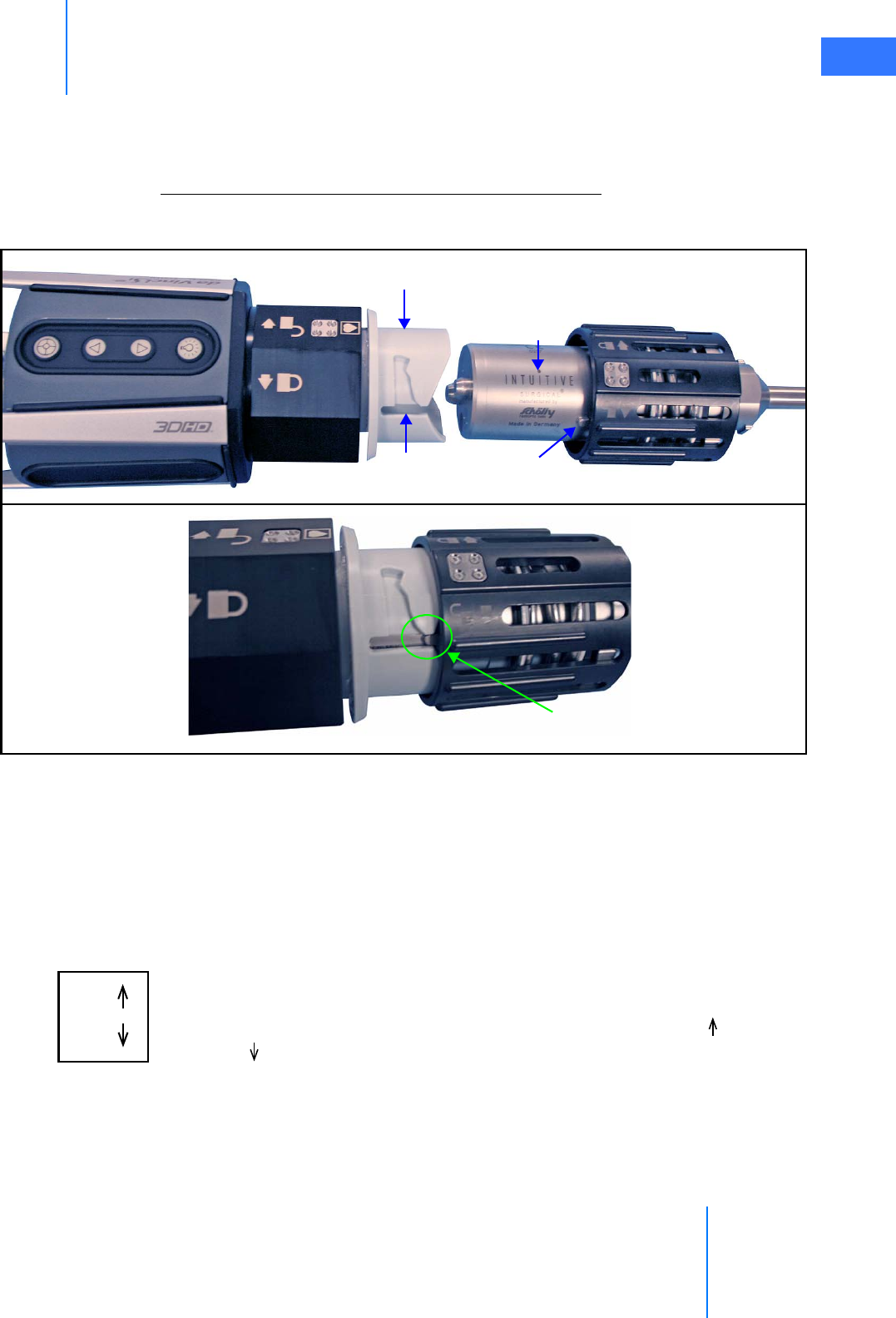
da Vinci® Si™
Vision System Use 7-6
DRAFT/PRE-RELEASE/CONFIDENTIAL
10/9/14
Install Endoscope on Camera Head
Before you can install the endoscope on the camera head, you must install the camera head
sterile adapter, as described in 6.5 Camera Head Draping Procedure on page 6-15.
Endoscope Orientation on the Camera Head and Calibration
The endoscope has pins in its base that help you to align it easily with the corresponding
channels on the camera head sterile adapter.
Figure 7.5 Installing endoscope in camera head
The pins support installing the endoscope on the camera head in two orientations 180
degrees opposite. The calibration process is sensitive to the orientation of the endoscope with
respect to the camera head. You must successfully calibrate the endoscope in each orientation
in which you will use it. For an angled endoscope, you must calibrate the scope in both
orientations to make sure it is ready for use as a 30 degrees up scope and as a 30 degrees
down scope.
•For angled endoscopes, the orientation with which you install it determines whether the
scope is 30 degrees up or down. (The system automatically detects and displays it,
whichever way it is installed.) For 30 degrees up, orient the scope so that the angled tip is
on the same side as the camera head buttons; do the opposite for 30 degrees down. The
scope base also indicates which side is which with marking that says 30º on one side
and 30º on the other.
• For flat endoscopes (0 degrees), we recommend you install the endoscope on the camera
head consistently in the same orientation: with the “Intuitive Surgical” logo on the base
of endoscope on the same side as the camera head buttons, as shown above in Figure
7.5.
Sterile adapter
(drape removed for clarity)
Camera head
Endoscope
Guide pin
Channel to
accept guide pin
Intuitive
logo
Installation: Detail of pin
entering channel
30º
30º
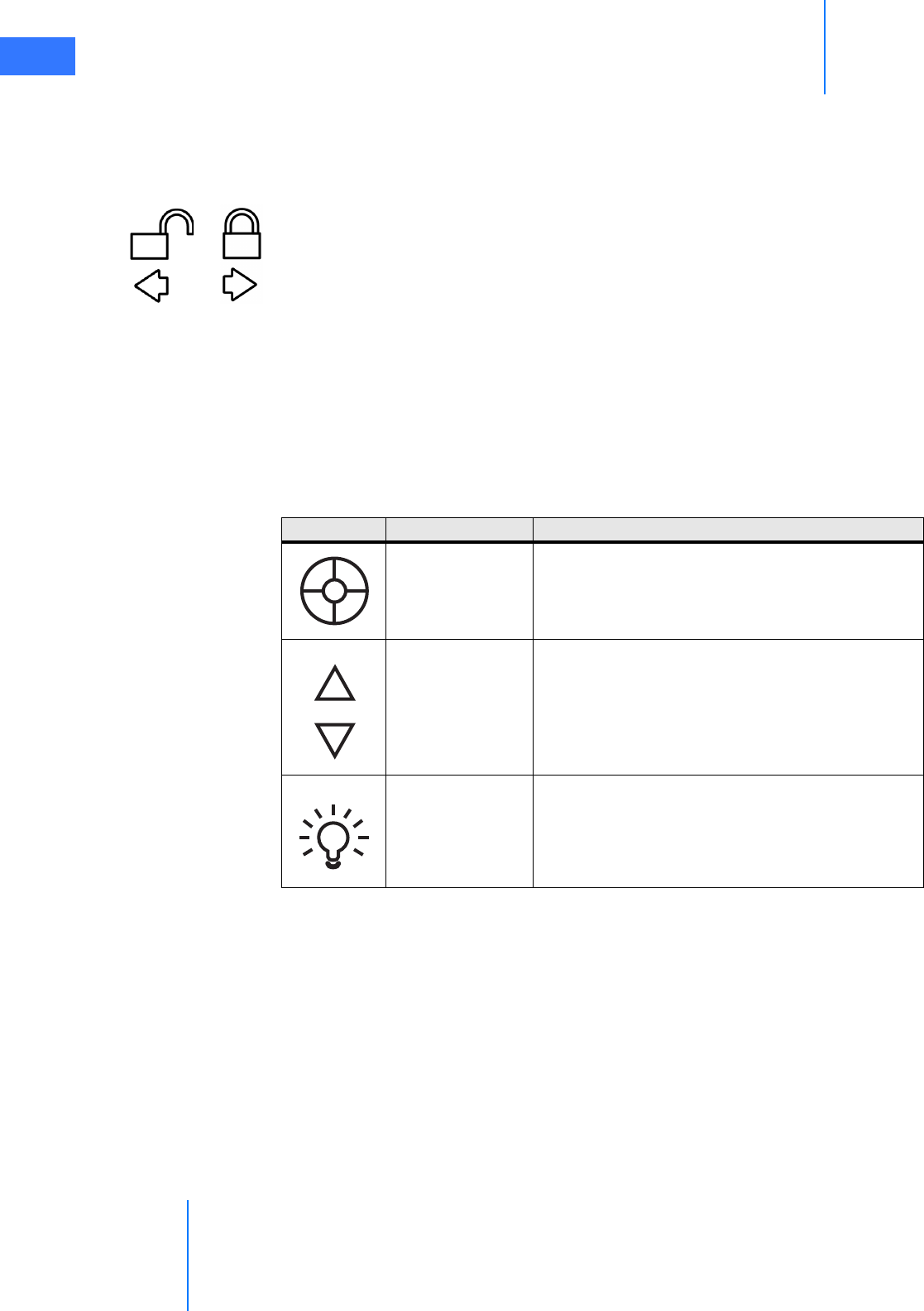
Vision System Use
da Vinci® Si™
7-7
DRAFT/PRE-RELEASE/CONFIDENTIAL
10/9/14
Follow these steps to install the scope:
1. Hold the endoscope and camera head with attached sterile adapter firmly in each hand –
avoid dropping either part.
2. Place the endoscope base over the sterile adapter, turning the scope as necessary until
the scope slides down over the camera head sterile adapter.
3. Push down the scope until it bottoms and turn until it locks into place. You will hear a
click when the endoscope is locked into the sterile adapter. Icons on the endoscope base
(shown at left) indicate the direction you must turn to lock or unlock the scope over the
sterile adapter.
Camera / Scope Setup from the Camera Head
The da Vinci Si System supports camera / scope setup, including white balance and automatic
3D calibration, completely via the camera head buttons. Using only the camera head buttons
as explained below, a single sterile person can select options presented on the touchscreen.
There is no need to touch the touchscreen, although it is still possible to perform manual
calibration at the touchscreen, as described under Manual 3D Calibration, page 7-13.
Three buttons are provided on the camera head for quick vision system setup.
Control Adjustment Description
Vision Setup Use the Vision Setup button to open and make
selections within the Camera/Scope Setup menu.
Focus In & Out /
Navigate menu
Press the Focus In or Out buttons to adjust the
focus of the surgical image, and to navigate the
Camera/Scope Setup menu.
Lamp On/Off Press and hold Lamp On/Off for 1 second to turn
the lamp on or off.
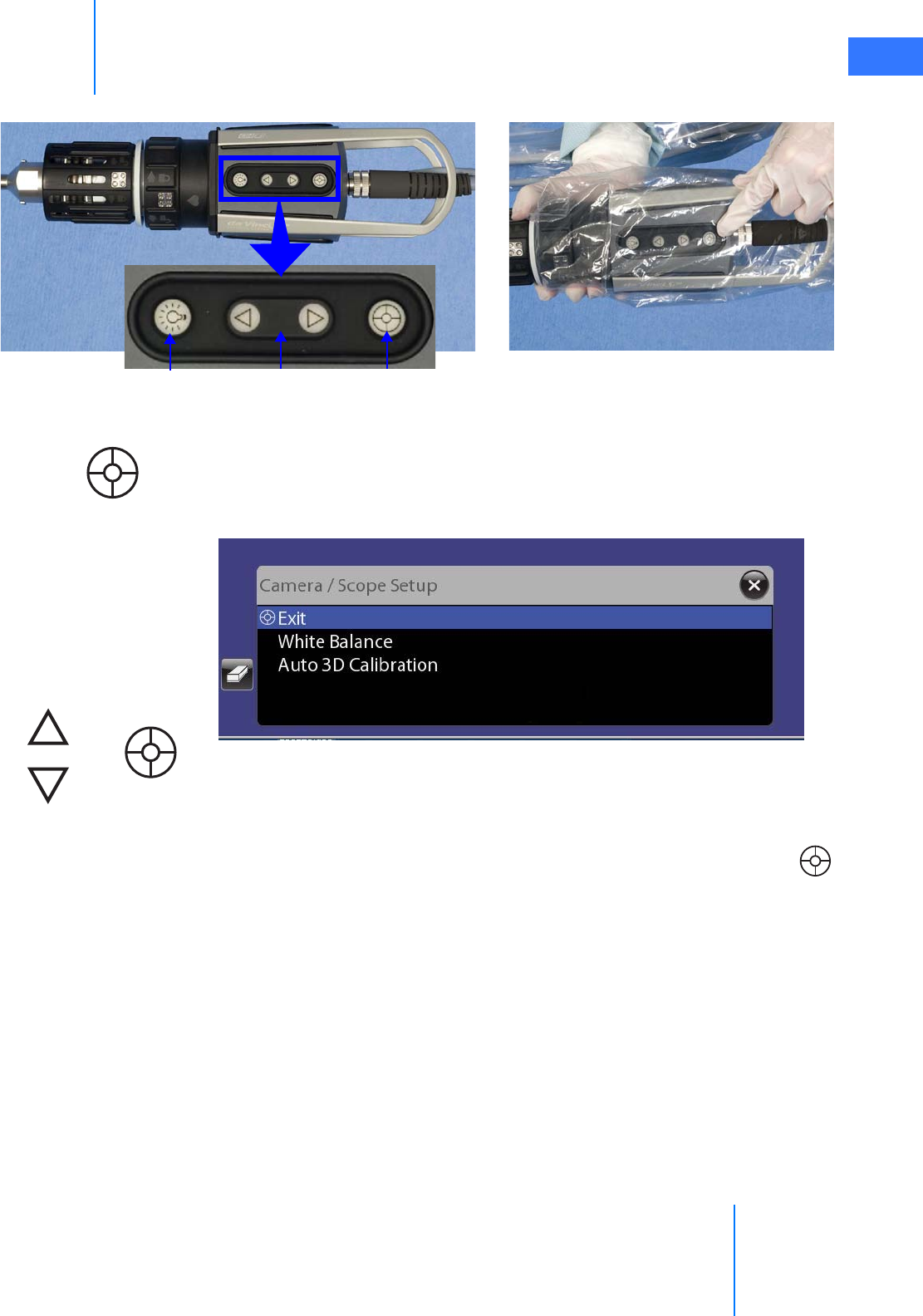
da Vinci® Si™
Vision System Use 7-8
DRAFT/PRE-RELEASE/CONFIDENTIAL
10/9/14
Figure 7.6 shows the camera head buttons.
Figure 7.6 Camera head buttons, shown draped on right
Invoke Camera / Scope Setup and Navigate
As long as no instruments are in following mode, you can open the Camera / Scope Setup
menu on the touchscreen by pressing and holding for 1 second the Vision Setup button on
the camera head. When you do, the following menu appears.
Figure 7.7 Camera / Scope Setup on touchscreen via camera head
This menu is navigable only by means of the Focus In and Out arrow buttons on the camera
head. You cannot select these options by touching them directly on the touchscreen (except
for the X button to close the menu). For orientation, the up arrow is the one nearer the Lamp
On/Off button. Press up or down to move up or down the list. Press the Vision Setup
button to “click” your selection like a mouse button.
Vision SetupFocus In & OutLamp On/Off
Press and hold 1 s
to open menu
Navigate
Select
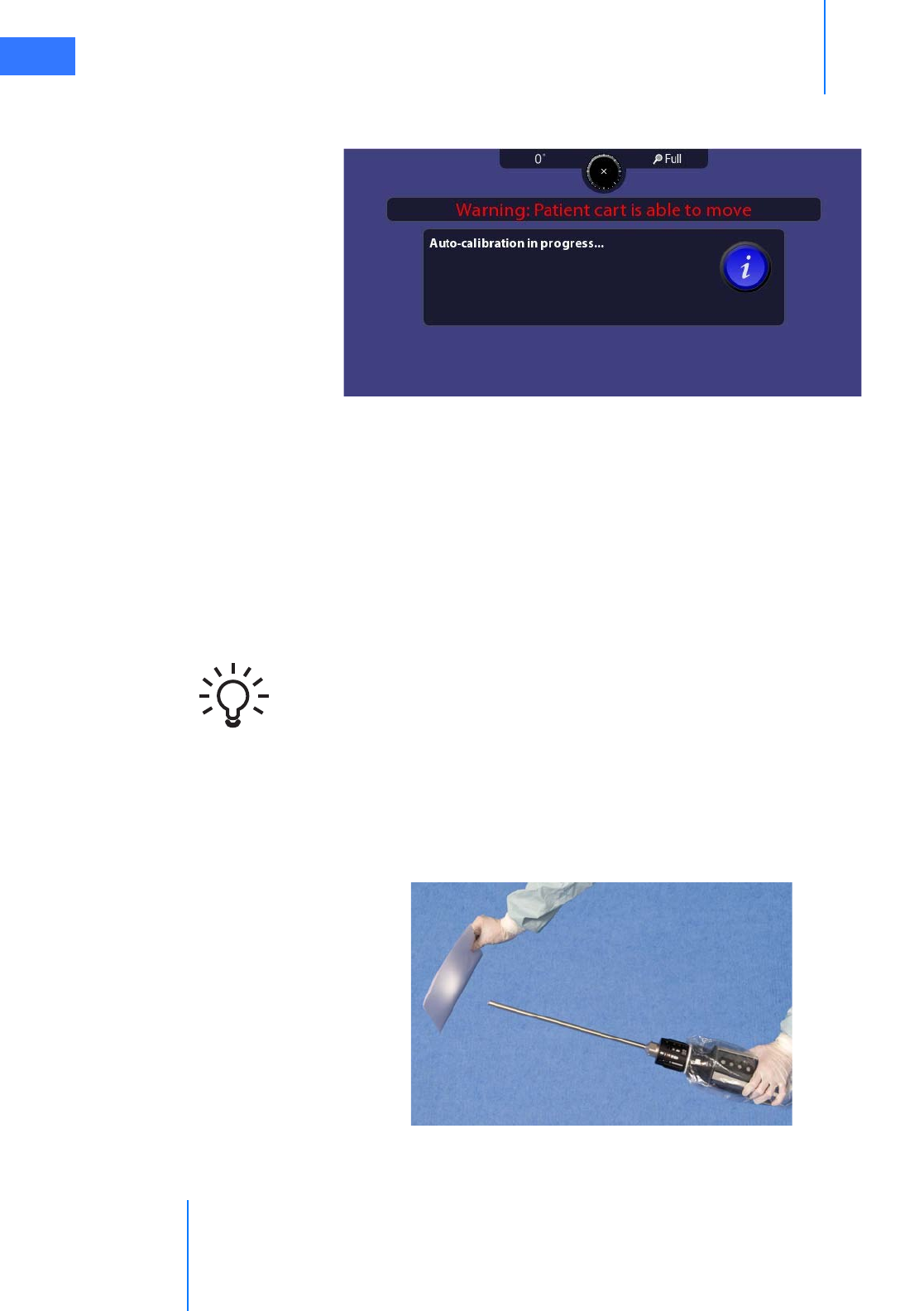
Vision System Use
da Vinci® Si™
7-9
DRAFT/PRE-RELEASE/CONFIDENTIAL
10/9/14
The message “Auto-calibration in progress...” appears continually in the stereo viewer until
you exit the menu.
Figure 7.8 Auto-calibration in progress (appears in stereo viewer only)
To exit the Camera / Scope Setup menu completely, select Exit in the menu (see Figure 7.7
above) or touch the X button on the touchscreen. The surgeon cannot enter following mode
until calibration is complete and you exit this menu.
Setting the White Balance
You must white balance the camera at the start of each procedure and any time a camera
head, endoscope, lamp module, or Illuminator is changed. White balance sets a white color
benchmark for the vision system.
To set the white balance, follow these steps:
1. Turn on the lamp by pressing the Lamp On/Off button on the camera head or Illuminator
front panel. (The Illuminator must be powered on. When Illuminator power is on but
lamp is off, the display reads “OFF” and the LED on the front panel is lit amber.)
The display flashes “OFF” while the lamp ignites. When the lamp is on, the LED on the
front panel turns blue, and the display indicates intensity as a percentage of maximum.
Use the – and + buttons to adjust intensity in 10% increments. Make sure the intensity is
set to 100% before proceeding.
2. Point the endoscope at a white object so the object covers the entire field of view. The
white object should be 4 in. (10 cm) from the endoscope tip.
Figure 7.9 Using paper to set the white balance
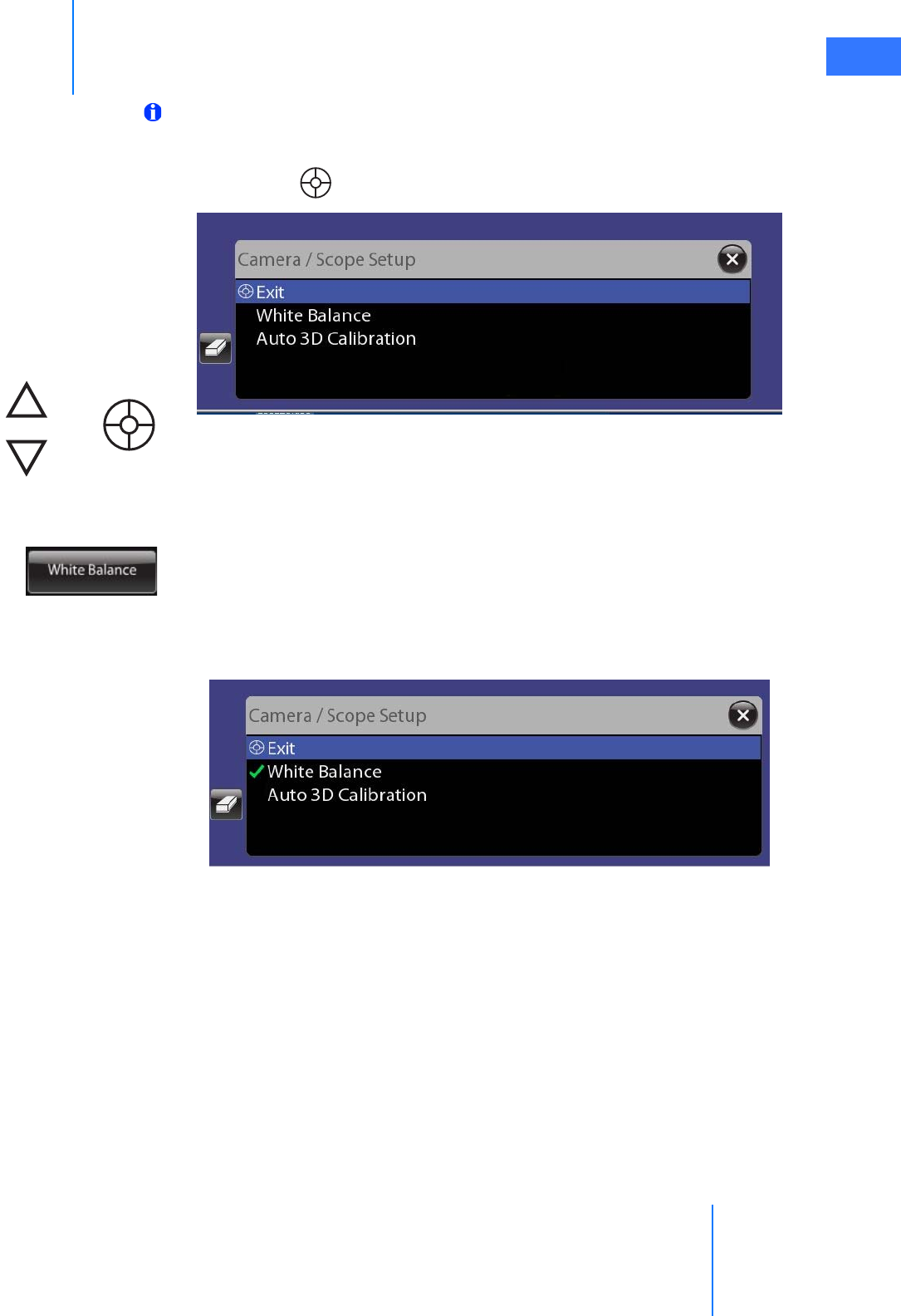
da Vinci® Si™
Vision System Use 7-10
DRAFT/PRE-RELEASE/CONFIDENTIAL
10/9/14
Note: Do not use gauze. Gauze does not provide an appropriate background for white
balancing.
3. If the Camera / Scope Setup menu is not already open, press and hold for 1 second the
Vision Setup button on the camera head to open it.
Figure 7.10 Camera / Scope Setup on touchscreen via camera head
4. Select White Balance. (Navigate with the Focus In and Out buttons, and press the
Vision Setup button to make a selection.) It runs to completion automatically.
• Alternatively, you can start white balance by touching the White Balance button on
the Camera / Scope Setup screen on the touchscreen or touchpad. To access the
White Balance button from the touchscreen, select Camera / Scope Setup from the
Video Settings tab; from the touchpad, select Camera / Scope Setup from the Video
tab.
A message appears briefly on the screen indicating when white balance is complete, and
then you return to the menu and a check mark appears next to White Balance.
Figure 7.11 White Balance marked complete
3D Calibration of the Endoscope Assembly
3D Calibration adjusts the 3D image for mechanical variances in the assembly comprised of
the endoscope, sterile adapter and camera head.
•The da Vinci Si System automatically detects the scope angle, which is necessary to
perform calibration. If the system does not detect the scope angle, the touchscreen
enables you to manually select the scope angle.
• We recommend you perform calibration at the start of each procedure for all endoscopes
and angles you expect to use with the current camera head and its sterile adapter. The
system saves the last calibration for every combination of endoscope, angle and camera
Navigate
Select
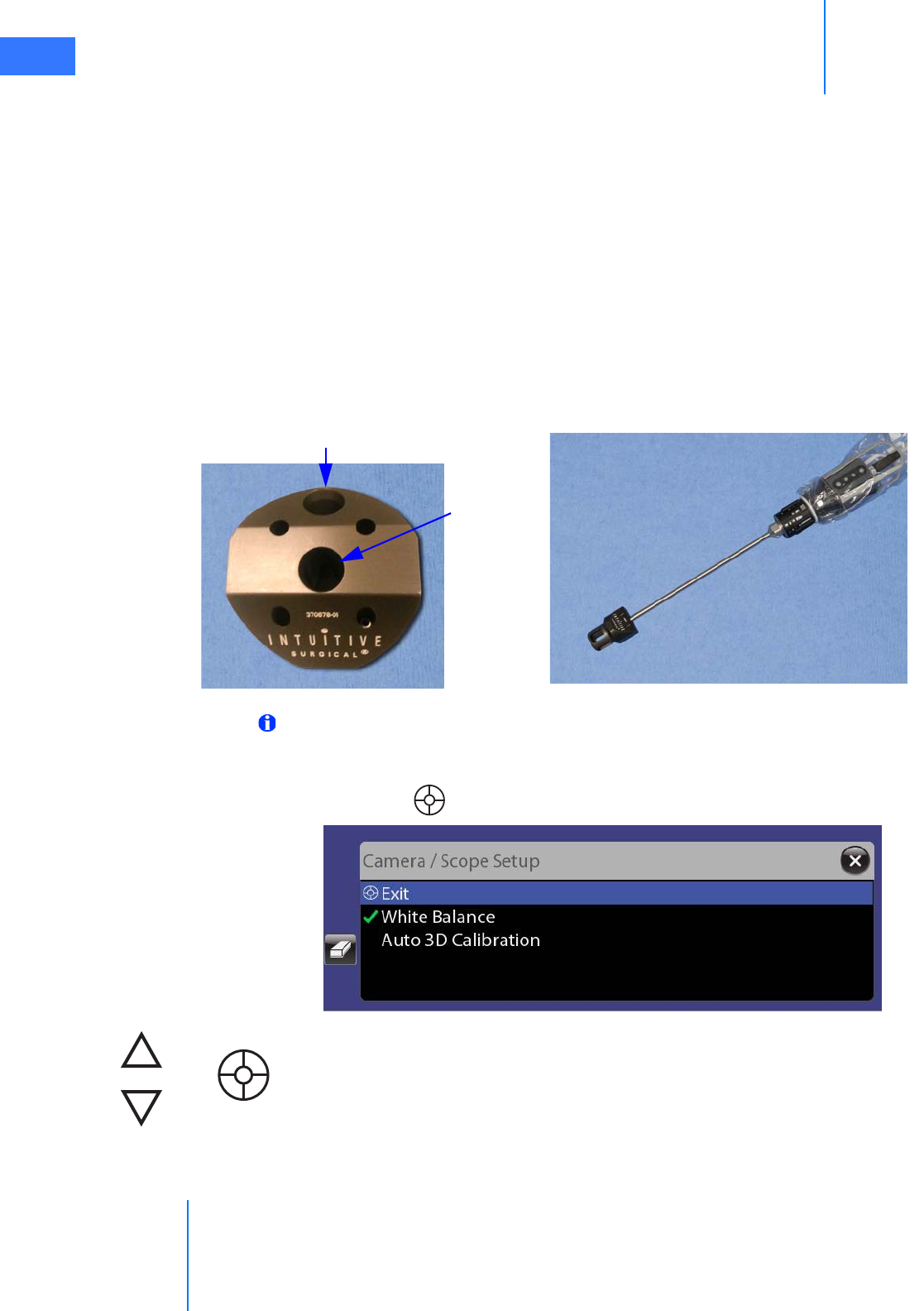
Vision System Use
da Vinci® Si™
7-11
DRAFT/PRE-RELEASE/CONFIDENTIAL
10/9/14
head, so if you follow this recommendation, it enables you to change angles (and scopes
when using both a 0 degree and 30 degree up/down scope) during a procedure without
having to recalibrate.
• If during surgery you change to use a camera head, sterile adapter or endoscope you did
not use for calibration before surgery, recalibrate all the endoscope angles you plan to
use with the new equipment.
Auto 3D Calibration
Auto 3D Calibration is driven exclusively by the camera head buttons. Follow these steps to
perform Auto 3D Calibration:
1. Insert the endoscope tip fully inside the endoscope alignment target, using the proper
hole and orientation, which depends on the tip angle, so that the target crosshairs are
visible on the center of the touchscreen.
Figure 7.12 Using the alignment target
Note: For 3D calibration to be successful, the crosshairs must be well centered on screen
and the target must be kept as still as possible on the endoscope.
2. If the Camera / Scope Setup menu is not already open, press and hold for 1 second the
Vision Setup button on the camera head to open it.
Figure 7.13 Camera / Scope Setup on touchscreen via camera head
3. Select Auto 3D Calibration. (Navigate with the Focus In and Out buttons, and press the
Vision Setup button to make a selection.) The process starts, the touchscreen shows
calibration in progress, and the process runs to completion in a few seconds. (You cannot
stop or cancel it once started.)
Insert 30 degree scope
Insert 0 degree
scope
Navigate
Select
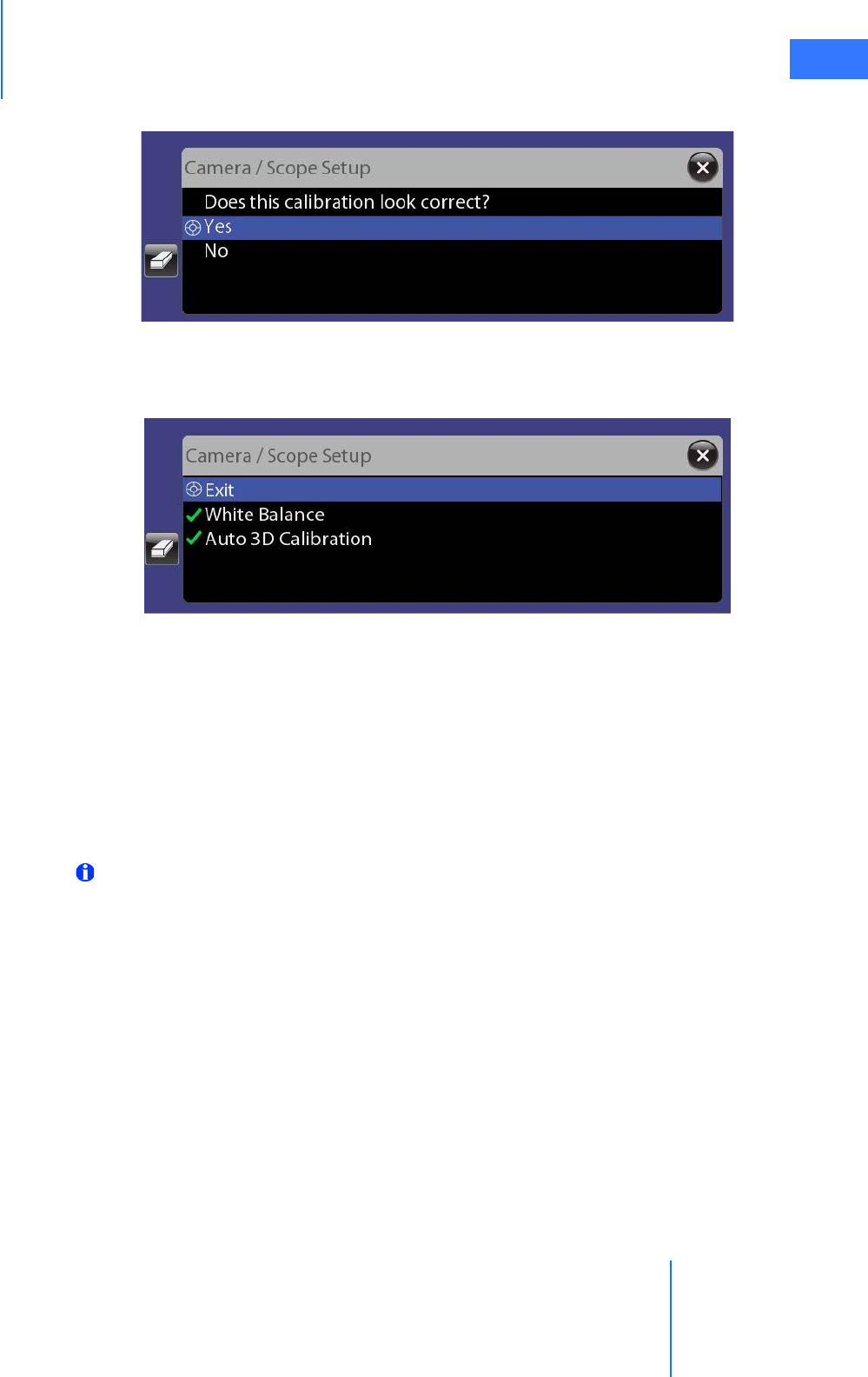
da Vinci® Si™
Vision System Use 7-12
DRAFT/PRE-RELEASE/CONFIDENTIAL
10/9/14
When complete, the system asks you, “Does this calibration look correct?”
Figure 7.14 Verify calibration (appears on touchscreen only)
If you select Yes, you return to the previous menu and a check mark appears next to Auto
3D Calibration.
Figure 7.15 Check mark indicates action complete (appears on touchscreen only)
No check mark will appear if you select No, but the calibration setting will be kept, since it is
the system’s best estimate of calibration. If you are not satisfied, you have the option to run
Auto 3D Calibration again, or to run it manually via the touchscreen or touchpad menus. You
always can access Camera / Scope Setup, including manual 3D Calibration, via the
touchscreen Video Settings tab or touchpad Video tab.
To exit the Camera / Scope Setup menu completely, select Exit in the menu (see Figure 7.15
above) or touch the X button on the touchscreen. The surgeon cannot enter following mode
until calibration is complete and you exit this menu.
Note: To avoid having to calibrate endoscopes during a procedure, repeat calibration for
all endoscopes and angles you expect to use with the current camera head and its sterile
adapter.
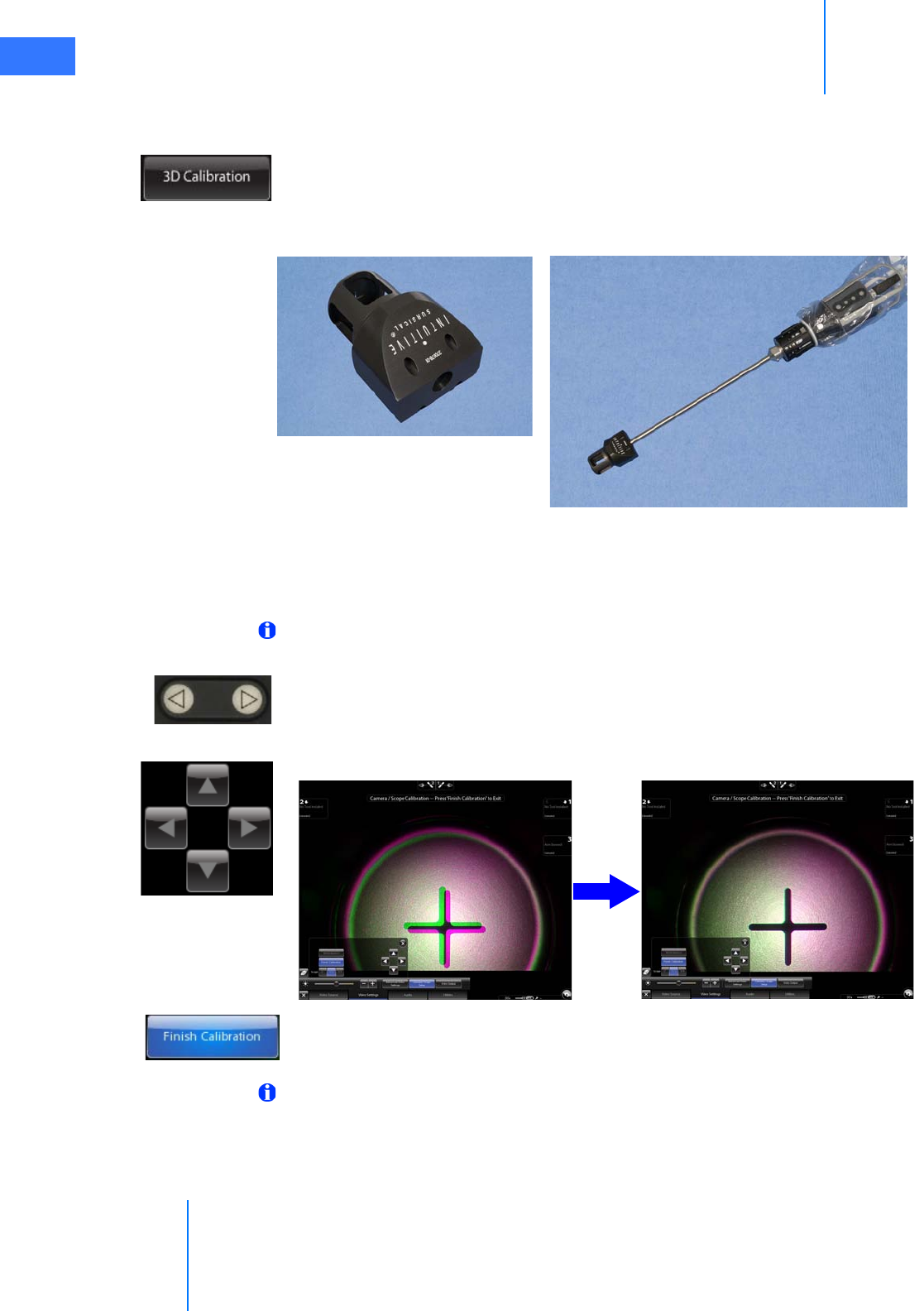
Vision System Use
da Vinci® Si™
7-13
DRAFT/PRE-RELEASE/CONFIDENTIAL
10/9/14
Manual 3D Calibration
Follow these steps to perform manual3D calibration:
1. Touch 3D Calibration on the touchscreen or touchpad. (If you are not there already, go to
Camera / Scope Setup on the Video or Video Settings tab.) The system shifts into
calibration mode: both the touchscreen and the Surgeon Console viewer present the left
and right eye images in distinct colors, using green and magenta.
Figure 7.16 Alignment target and scope tip inserted, target centered on screen
2. Insert the endoscope tip fully inside the endoscope alignment target, using the proper
hole and orientation, which depends on the tip angle, so that the target crosshairs are
visible on the center of the touchscreen.
Note: For 3D calibration to be successful, the crosshairs must be well centered on screen
and the target must be kept as still as possible on the endoscope.
3. Use the Focus In and Out buttons on the camera head to focus the image.
4. Touch the arrows on the touchscreen or touchpad to move the green crosshairs until
aligned with the magenta crosshairs.
Figure 7.17 Aligning crosshairs
Touch Finish Calibration on the touchscreen or touchpad to save the calibration setting and
exit calibration mode.
Note: To avoid having to calibrate endoscopes during a procedure, repeat calibration for
all endoscopes and angles you expect to use with the current camera head and its sterile
adapter.
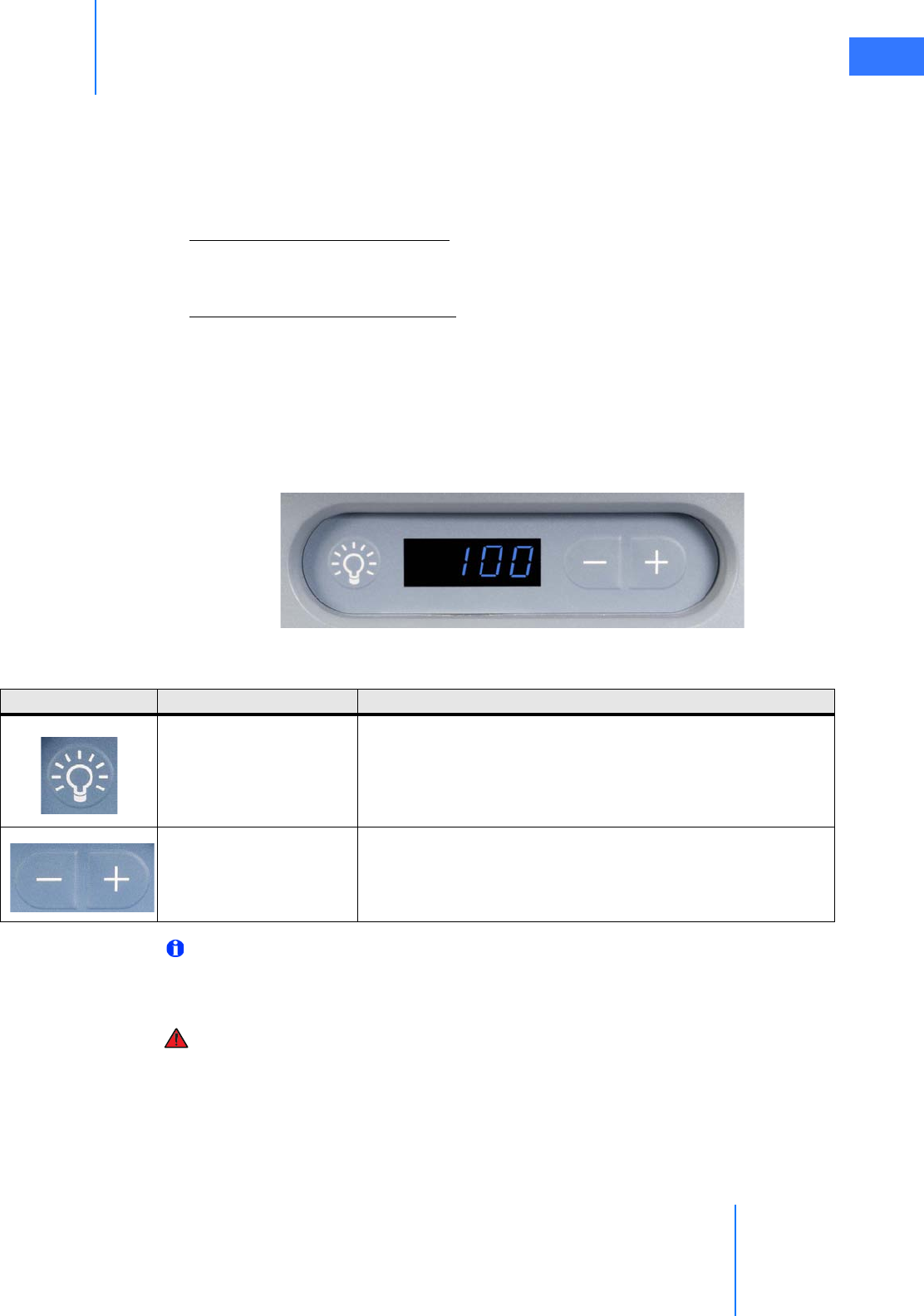
da Vinci® Si™
Vision System Use 7-14
DRAFT/PRE-RELEASE/CONFIDENTIAL
10/9/14
Preoperative and Intraoperative Endoscope Care
Before use, ensure the endoscope tip is adequately heated to minimize fogging when
entering the surgical site. To heat the endoscope tip, dip it in a canister of heated sterile water.
Place a piece of sterile gauze at the bottom of the canister to prevent damage to the delicate
endoscope tip.
Intraoperative Endoscope Cleaning
As necessary due to fogging or smudging of the tip, remove the endoscope and wipe the tip
with moistened sterile gauze.
Confirm Live Image in Stereo Viewer
Each time you install an endoscope, and after changing view modes or settings during a
procedure, look in the stereo viewer to confirm a live image is present and has the desired
orientation. Adjust endoscope orientation as necessary. If no image is present, confirm the
lamp is on and at 100% intensity, as shown below. See section C.3 Basic Troubleshooting, page
C-5, for further troubleshooting if no image is present.
7.3 Working with the Illuminator Controls
Figure 7.18 Illuminator controls and intensity display
Note: To minimize fogging, maintain heating of the endoscope tip by setting the
Illuminator brightness to 100% and use the brightness controls through the
touchscreen or touchpad to adjust the brightness of the surgical image.
WARNING: The temperature of the distal tip of the endoscope may exceed 41°C during
use. Avoid contact with skin, tissue and clothing when the Illuminators are turned on
and the endoscope is outside the camera cannula, as damage may occur to skin,
clothing and equipment. Do not attempt to clean the tip of the endoscope by dipping it
in tissue. The tissue can be damaged because of the heat, and the tip of the endoscope
may develop baked-on deposits which can decrease light throughput.
Table 7-1 Illuminator Controls and Adjustments
Control Adjustment Description
Lamp On/Off Press Lamp On/Off to turn the lamp on and off. Use Lamp
On/Off when the Illuminator is temporarily not in use. Press
and hold Lamp On/Off when the lamp is on to turn off the
lamp at the Illuminator.
Intensity Control
Decrease (–) Increase
(+)
Press Intensity Control decrease (–) and increase (+) buttons
to adjust Illuminator output in 10% increments. Press and hold
both (–) and (+) at the same time to display the current lamp
hour usage.
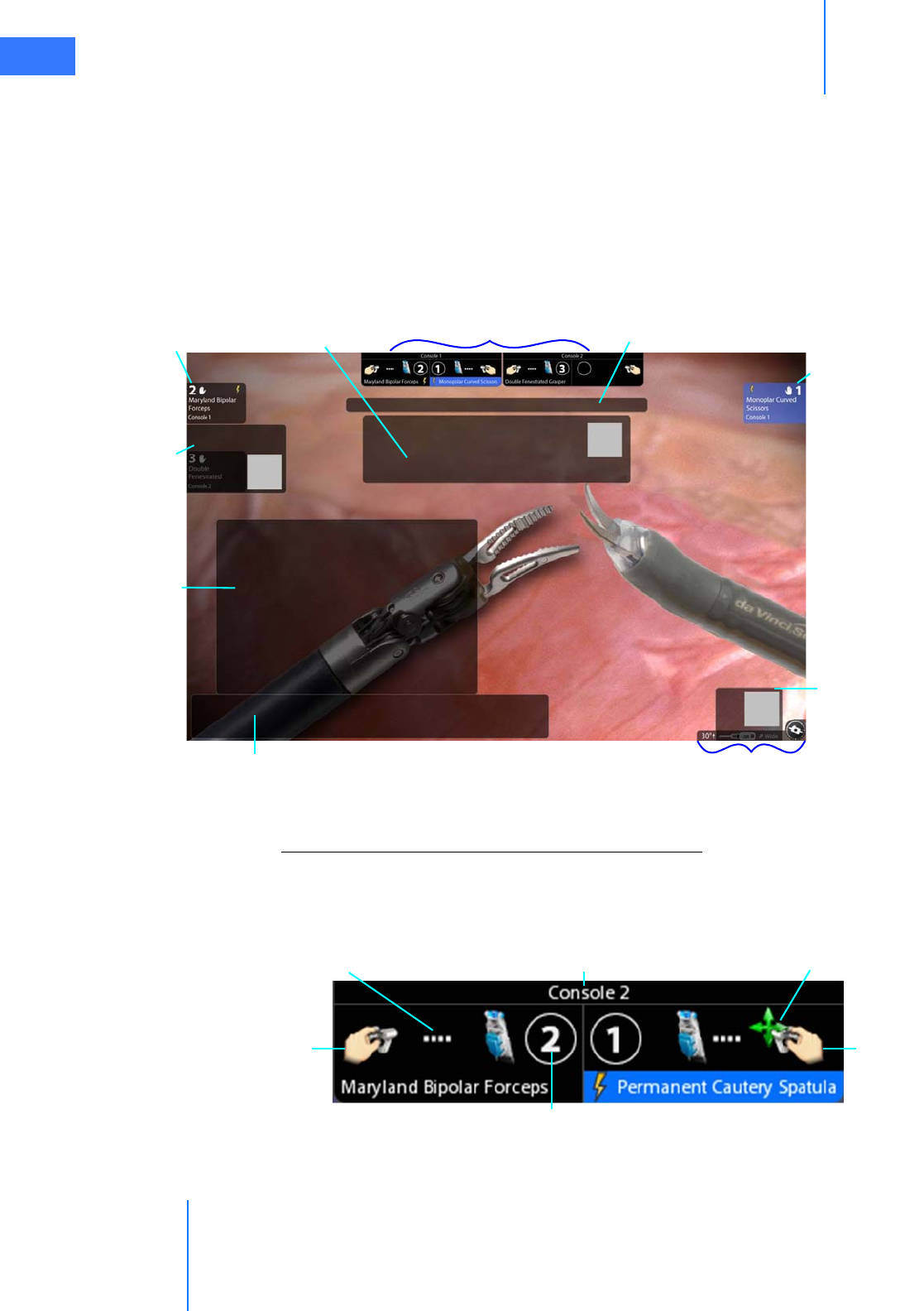
Vision System Use
da Vinci® Si™
7-15
DRAFT/PRE-RELEASE/CONFIDENTIAL
10/9/14
7.4 Working with the Touchscreen Vision Controls
The touchscreen monitor provides the ability to adjust vision system functions as described in
this section. The following figure illustrates arrangement of overlaid elements in the
touchscreen display. Note that many overlaid elements appear only when needed, and others
are usually or always present. For a complete list of icons and text messages, please refer to
Appendix G: Symbols, Icons and Text Messages Reference.
Touchscreen Display
Figure 7.19 Touchscreen display
Single or Dual Console Masters & Instruments Status Area
When one Surgeon Console is in use, the touchscreen shows masters and instruments status
at top center with a single status area like the one shown in Figure 7.20 below. When in dual
console mode, two small status areas (as below in Figure 7.20) appear side by side at top
center of the touchscreen.
Figure 7.20 Masters and instruments status area for consoles in use
Arm 2 data:
on left, surgeon
name or console
control
Single or dual console Modal message
area
Critical message
area/icon masters & instruments status
Menu tabs area Camera angle, zoom,
rotation indicator
Camera message
area, icon
Arm 1 data:
on right, instrument
name, energized
(bolt), foot over
enabled pedal pair
(blue)
Instrument arm
message areas,
icons
Menu pop up area
Right master
status and
association
Left master
status and
association
Instrument name, status
Console number or surgeon name if logged in
Associated arm number
Finger clutched
Indicates association
(blue=foot over enabled pedal)
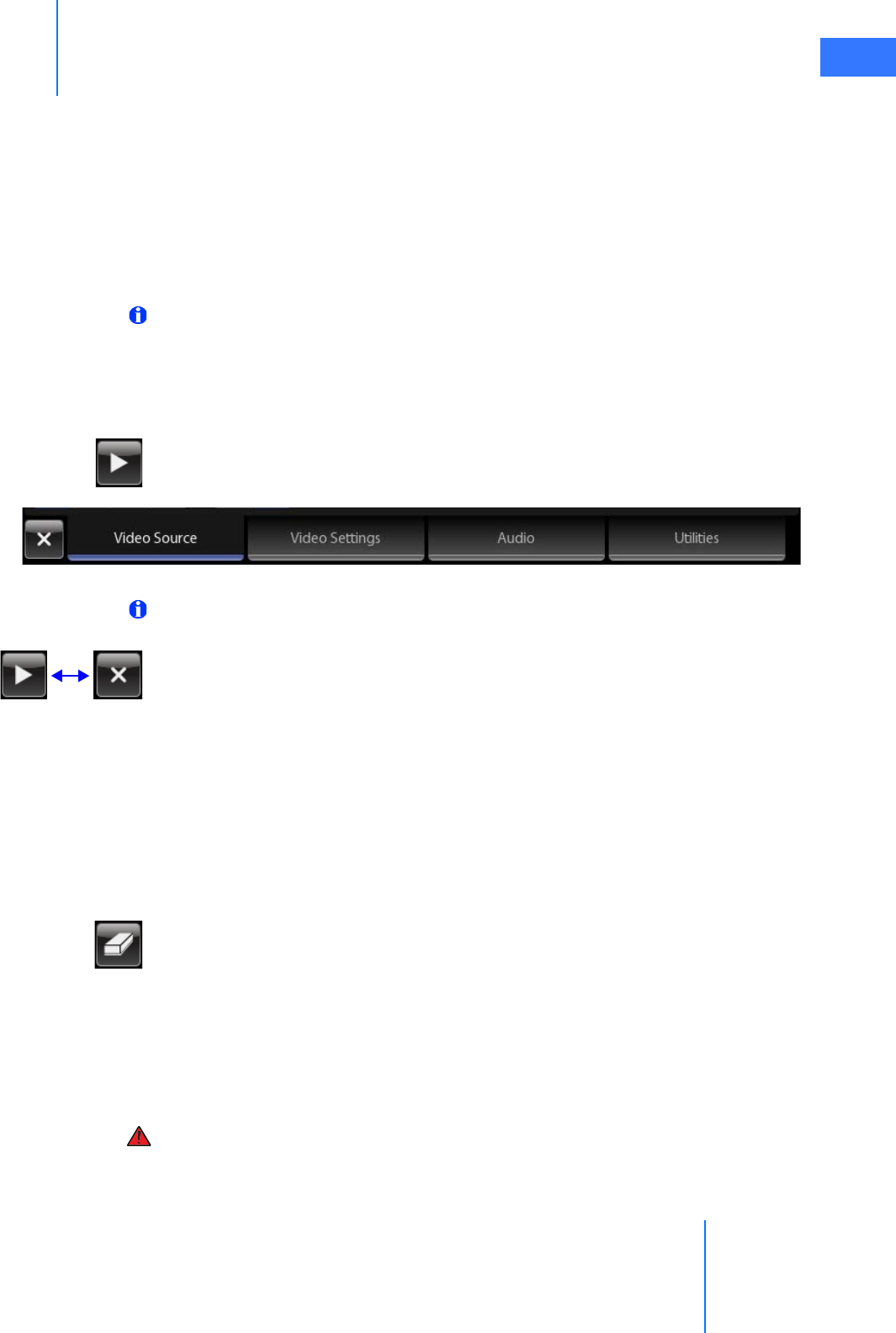
da Vinci® Si™
Vision System Use 7-16
DRAFT/PRE-RELEASE/CONFIDENTIAL
10/9/14
This area provides masters and instruments status for consoles in use, showing:
• The console number at the top, or the user name of the surgeon if logged in
• For left and right masters, the associated instrument name, arm number and energy
status, including turning orange when firing
• The same status icons as appear elsewhere, and the additional icon showing that the
master is clutched (finger clutched) as seen on the right above. For a complete list of
icons and text messages, please refer to Appendix G: Symbols, Icons and Text Messages
Reference.
Note: On the stereo viewer when in dual console mode, only one of these status areas
appears, at upper left, showing the instrument status of the other Surgeon Console. If
you select the Surgeon View from the Video Source Tab (see page 7-17), you will have
the further choice of which console’s view and icons to see on the touchscreen.
Touchscreen Menu Access
Touch the Open button in the bottom left corner to access the following menu tabs to make
adjustments:
Figure 7.21 Touchscreen menu tabs: Video Source, Video Settings, Audio, Utilities
Note: Items highlighted blue are currently selected. Grayed-out items are not available
in the current context.
The Open button toggles to Close when the menu is open; touch it to close the menu. Below
we address the adjustments available in each menu tab. Before that, we explain telestration,
since it is always available.
Telestration
Telestration is available by default. You can telestrate on the touchscreen monitor no matter
what video source is displayed. To telestrate, drag your finger on the monitor, pressing slightly,
to draw a colored line on the video image. The telestration drawn also appears in the Surgeon
Console viewer, overlaid on whichever video channel (left or right) is being used at the
touchscreen. The surgeon cannot block the appearance of telestration, but can remove it by
pressing the camera pedal.
•Erase Button: The Erase button is always present when telestration is available. Touch it
to erase all telestration marks from the touchscreen and Surgeon Console. The following
actions also erase telestration marks:
• Pressing the camera footpedal
• Clutching the camera arm or camera arm setup joint
• Change in endoscope
• Change in video source selection
WARNING: Telestration is an educational tool and should be used to assist in
communication during surgery. Telestration should not be used as a tool for performing
surgery (for example, making telestration marks to indicate where to cut).
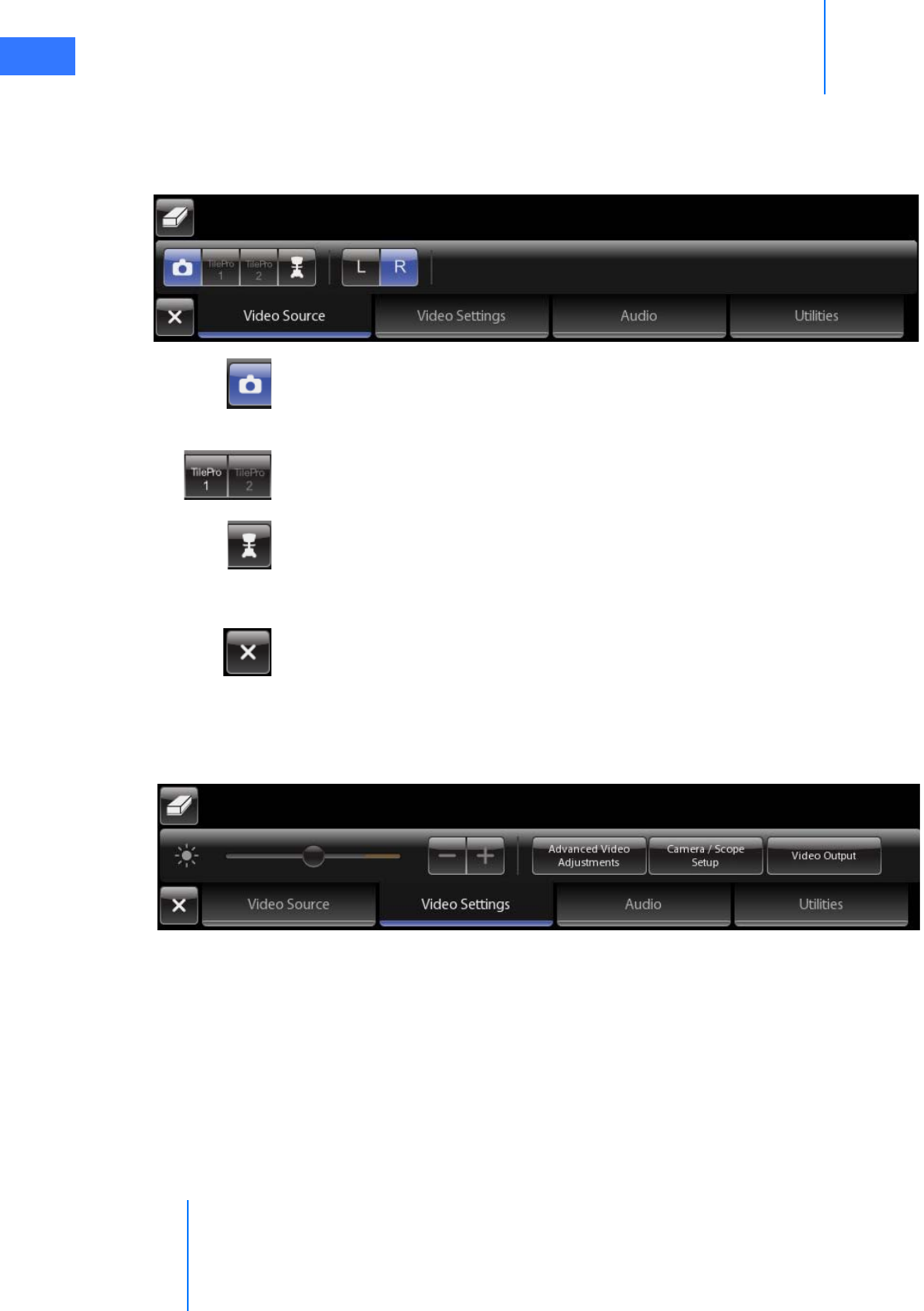
Vision System Use
da Vinci® Si™
7-17
DRAFT/PRE-RELEASE/CONFIDENTIAL
10/9/14
Video Source Tab
When you touch the Video Source tab, you can select which video source to display on the
touchscreen. You can also select which eye’s video image to display, right or left, and use
telestration. Select from the following options:
Figure 7.22 Video Source tab
•Endoscope: Touch this camera icon to display the endoscope video image. The
touchscreen displays either the left or right eye video, and you can select which eye using
the L (left) or R (right) button. This L / R option is useful when something impairs video
from one or the other eye.
•TilePro 1 or TilePro 2: Touch either to display the video input from the TilePro 1 or
TilePro 2 connection on the back of the Core or Surgeon Console.
•Surgeon View: Touch to display the surgeon’s view, including overlays. (Among these are
those that show energy status of instruments.) When selected, you have the further
option to select the surgeon’s left or right eye video image using the L (left) or R (right)
button. This L / R option is useful when something impairs video from one or the other
eye. When two Surgeon Consoles are in use, another option becomes available to select
which console view to display. Select either to display that console’s view and icons. To
exit the surgeon view and access the menu tabs, you must touch the X button.
Video Settings Tab
The Video Settings tab enables you to adjust the brightness of the surgical image, and gives
access to Advanced Video Adjustments, Camera / Scope Setup and Video Output.
Figure 7.23 Video Settings tab
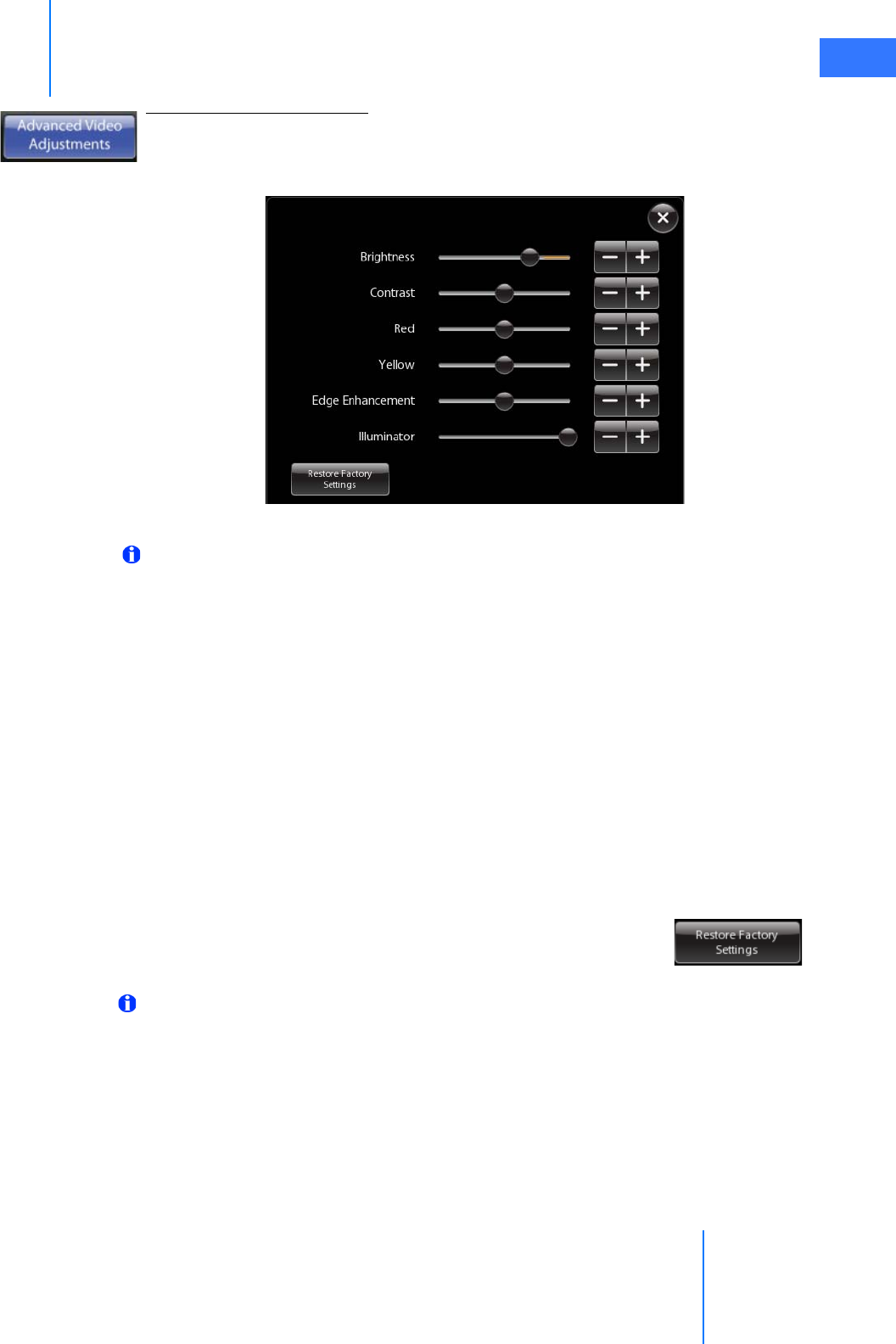
da Vinci® Si™
Vision System Use 7-18
DRAFT/PRE-RELEASE/CONFIDENTIAL
10/9/14
Advanced Video Adjustments
Enables adjustment of Brightness, Contrast, Red, Yellow, Edge Enhancement, and
Illuminator. You can also revert to factory default settings by touching Restore Factory
Settings.
Figure 7.24 Advanced Video Adjustments
Note: The specific adjustment of these settings is a matter of surgeon preference. Like
any adjustable video image, you may observe that some settings affect others, with the
result that a specific combination of settings may represent a tradeoff, for example,
between glare in one part of the image and enhanced visibility in another part. Keep in
mind that you can readjust these settings at any time.
•Brightness: Drag the slider to adjust the brightness of the surgical image. This is video
brightness, as opposed to actual illumination.
•Contrast: Drag the slider to adjust the contrast of the surgical image.
•Red: Drag the slider to adjust the red of the surgical image.
•Yellow: Drag the slider to adjust the yellow of the surgical image.
•Edge Enhancement: Drag the slider to adjust the edge enhancement of the surgical
image. Increasing edge enhancement (slider to the right) may also increase noise.
•Illuminator: Drag the slider to adjust the actual light output transmitted to the surgical
field in 10% increments.
•Restore Factory Settings: Touch to restore all advanced video
adjustments to default values, which should be appropriate for
most clinical scenarios.
Note: Both the Brightness slider (video brightness) and the Illuminator slider (lamp
intensity) will affect the brightness of the image seen in the stereo viewer. To minimize
fogging, maintain heating of the endoscope tip by setting the Illuminator slider to
maximum and then adjust image brightness using the Brightness slider. If working close
to tissue, decrease the Illuminator intensity using the Illuminator slider, and increase
image brightness as necessary using the Brightness slider. If the image is too dark, check
both the Illuminator and Brightness sliders, making sure each is far enough to the right,
given the working distance of the endoscope tip from tissue.
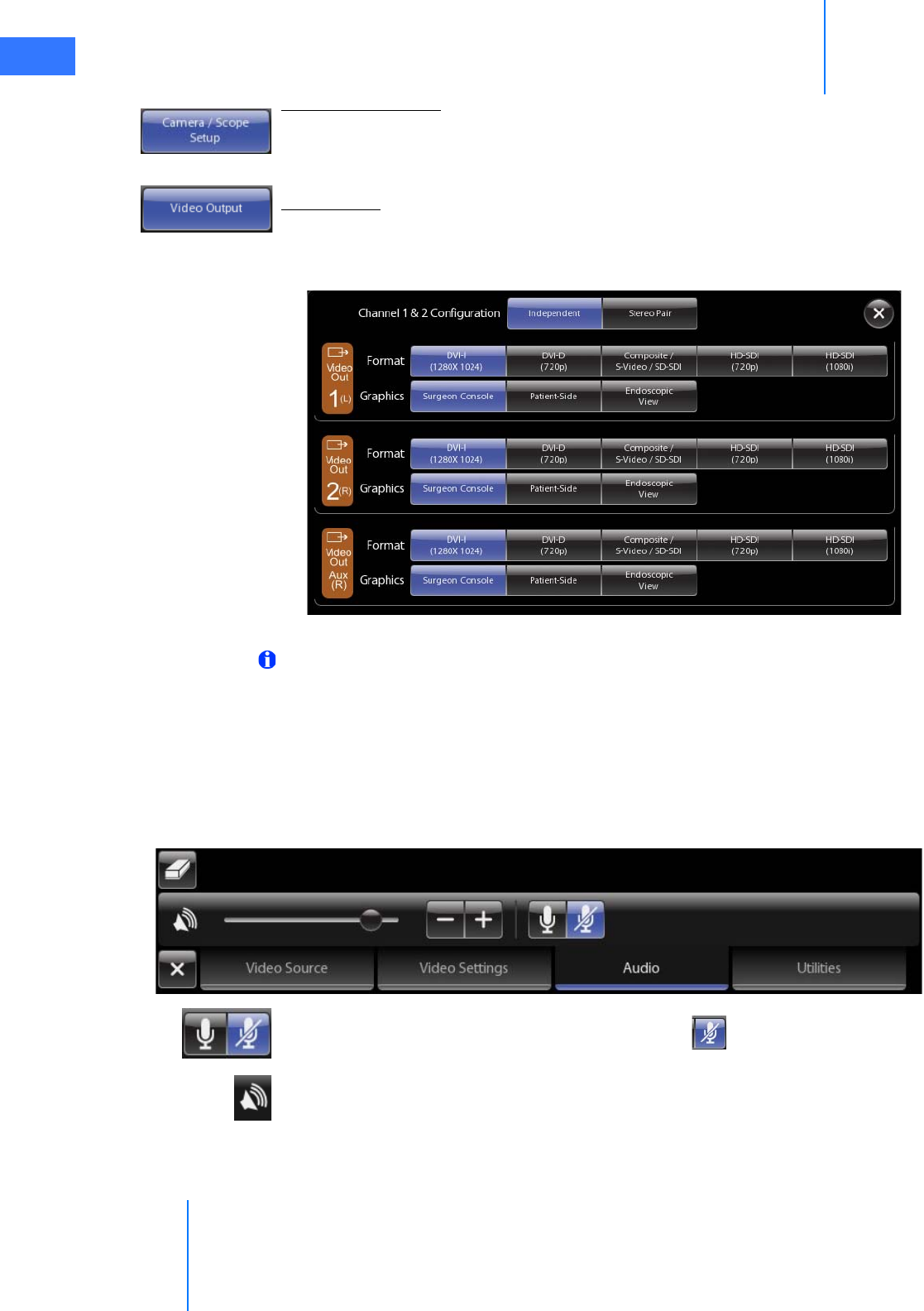
Vision System Use
da Vinci® Si™
7-19
DRAFT/PRE-RELEASE/CONFIDENTIAL
10/9/14
Camera / Scope Setup
Provides the ability to perform white balance, scope calibration, and to manually set the scope
angle when the system does not detect it automatically. See the interface and instructions for
this tool under Vision System Overview on page 7-1.
Video Output
Enables you to specify the video output format and graphics source for up to three video
outputs. (Video Out Aux available by default; Video Out 1 and 2 available as part of optional
upgrades.) See the example below.
Figure 7.25 Example of video output option selections
Note: One video output is standard. Optional upgrades can provide up to two additional
video outputs.
The software buttons on this screen correspond to the applicable Video Out connector bay as
explained in Table H-1 Video Output Connections – Core, page H-2.
Audio Tab
The Audio tab enables you to adjust touchscreen speaker volume and mute the touchscreen
microphone.
Figure 7.26 Audio tab
•Microphone On and Off: On by default, select to mute the touchscreen
microphone.
•Volume Adjustment: Use the slider—volume increases to the right—or the Volume
Decrease (–) or Increase (+) buttons.
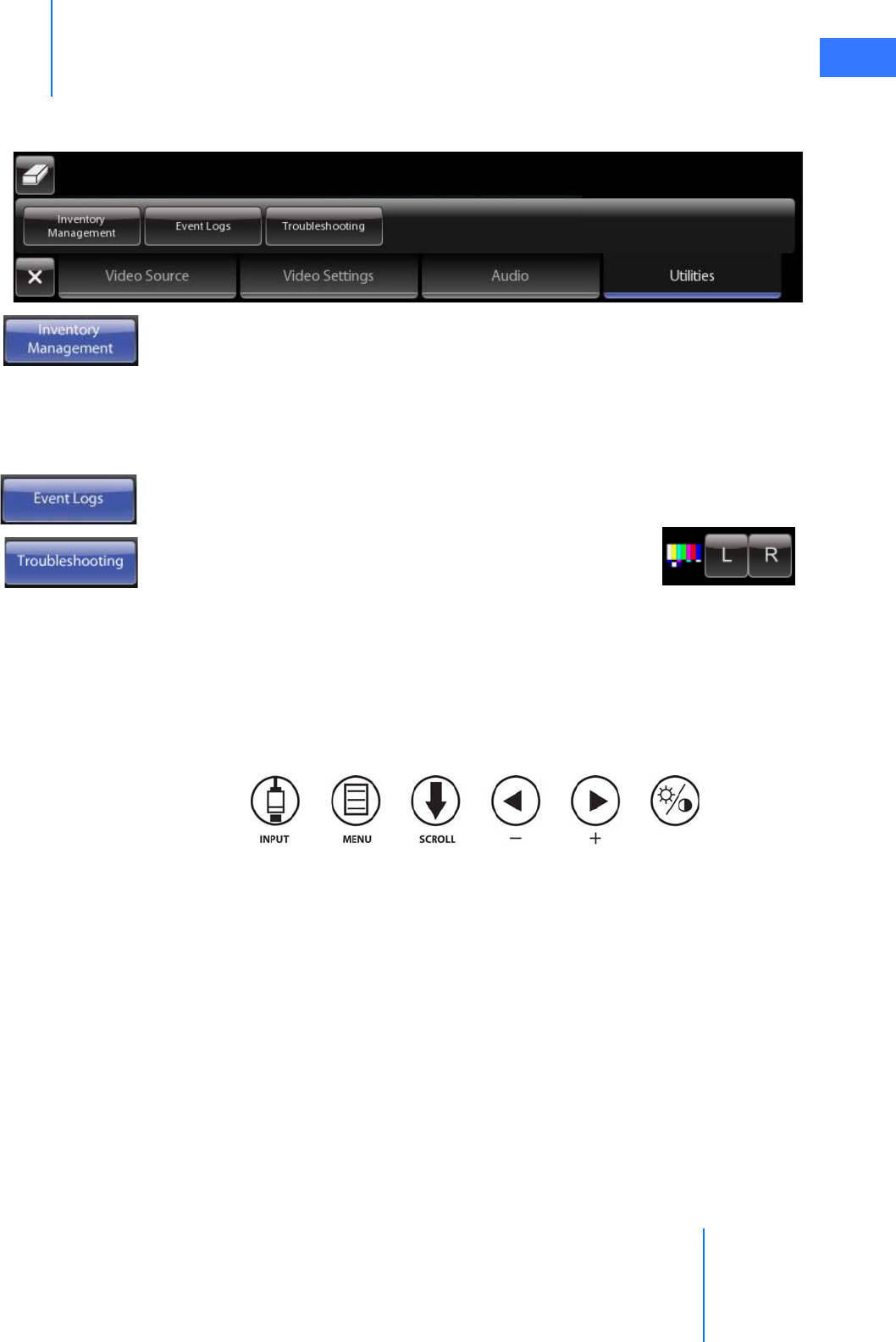
da Vinci® Si™
Vision System Use 7-20
DRAFT/PRE-RELEASE/CONFIDENTIAL
10/9/14
Utilities Tab
The Utilities tab provides access to Inventory Management, Event Logs and Troubleshooting.
Figure 7.27 Utilities tab
•Inventory Management: Provides an overview of the accessories used during the
procedure.
•Viewing Lamp Hours: To view usage hours of the lamp module, select Inventory
Management (on the touchscreen or touchpad). You can also view the lamp hours on
the Illuminator by pressing the decrease (–) and increase (+) buttons simultaneously,
as described in Appendix C: Illuminator Information.
•Event Logs: Provides access to the system event logs, including error logs.
•Troubleshooting: Displays the system name and system
software version, and provides L (left) and R (right) buttons to
display the color bar test pattern in the left or right video channel
independently.
7.5 Adjusting the Touchscreen Monitor
The hardware controls to adjust the touchscreen monitor image are locked. We recommend
you make video settings adjustments through the Video Settings tab on the touchscreen (see
page 7-17). If you wish to change the video settings of the monitor, contact Intuitive Surgical
Technical Support.
Figure 7.28 Touchscreen monitor hardware controls
7.6 Troubleshooting Image Quality
Missing Image (One or Both Eyes)
1. Re-do white balance.
2. Ensure camera cable connections are tightly connected.
3. Replace the camera head and camera cable.
Image Poor
Two scenarios may be encountered intra-operatively where adjustments may be required: 1. a
condition where the image appears too bright, or 2. a condition where the image appears too
dark or the color is poor. We provide specific recommendations to optimize each scenario.

Vision System Use
da Vinci® Si™
7-21
DRAFT/PRE-RELEASE/CONFIDENTIAL
10/9/14
Overly Bright Image
1. From the Video Settings tab of the touchscreen or touchpad, decrease the brightness to
the desired level.
CAUTION: If the endoscope is working close to tissue, reduce the light source output by
adjusting the Illuminator to a lower light output setting. This will prevent tissue damage
due to excessive heat. Note that decreasing the light output will result in a more grainy
image.
Note: Do not use the Illuminator to control image brightness as this may result in
increased fogging.
Dark Image or Poor Color
1. Restore factory settings from the touchscreen or touchpad: Video Settings> Advanced
Video Adjustments> Restore Factory Settings.
2. Increase video brightness from the touchscreen or touchpad: Video Settings>
Advanced Video Adjustments.
Note: Increasing the brightness may cause the image to look noisier and reduce image
quality.
3. Perform white balance.
4. Check the light guide connection to the Illuminator to ensure it is secure.
5. If the problem persists, replace the endoscope.
6. If the problem persists, replace camera head and camera cable.
7. Perform white balance.
8. If possible, clean the tip of the endoscope with a piece of moistened sterile gauze. Blood
or other protein may have accumulated on the tip, diminishing light throughput.
Flickering Image
If the image is flickering in one or both eyes:
1. Power off the system.
2. Check and reseat the vision cable connections, including the camera cable at the CCU.
3. Power on the system.
a. If the image in the Surgeon Console is clear, continue with normal use.
b. If flickering continues and is constant: contact customer service for assistance: U.S.
800-876-1310, International +800 0821 2010 or +41 21 821 2020.
c. If flickering happens only when applying cautery, proceed to Step 4:
4. Remove the ESU from the Vision Cart.
a. If the image quality in the Surgeon Console is clear, continue with normal use.
b. If the problem persists, contact customer service for assistance: U.S. 800-876-1310,
International +800 0821 2010 or +41 21 821 2020.
“Soft” Image
1. Try adjusting the focus by pressing the camera pedal and rotating the masters on the
Surgeon Console or using the Focus In and Out buttons on the camera head.

da Vinci® Si™
Vision System Use 7-22
DRAFT/PRE-RELEASE/CONFIDENTIAL
10/9/14
2. If possible, clean the tip of the endoscope with a piece of moistened sterile gauze. Blood
or other protein may have accumulated on the tip, diminishing light throughput.
3. Adjust the edge enhancement setting to increase the sharpness of the image. Edge
Enhancement is found under Advanced Video Adjustments (see page 7-18 or page
10-13).
Blurry Image
1. Remove endoscope and detach from camera head. Clean both the endoscope tip and the
end where it connects to the camera head. If possible, wipe the camera head lenses.
a. Check the image quality in the Surgeon Console. If the image is clear, continue with
normal use.
2. Focus the image.
3. If one eye is in focus and one eye is not in focus, change the endoscope.
a. Check the image quality in the Surgeon Console. If the image is clear, continue with
normal use.
b. If the problem persists, proceed to Step 3:
4. Power off the system and replace the camera.
5. Power on the system.
a. Perform white balance and 3D calibration.
b. Check the image quality in the Surgeon Console. If the image is clear, continue with
normal use.
c. If the problem persists, contact customer service for assistance: U.S. 800-876-1310,
International +800 0821 2010 or +41 21 821 2020.
Unable to Focus
1. Clean the tip of the endoscope with a piece of moistened sterile gauze.
a. Check the image quality in the Surgeon Console. If the image is in focus, continue
with normal use.
b. If the image in the Surgeon Console is not in focus:
2. Focus the image. (From the camera head, use the Focus In and Out buttons. From the
Surgeon Console, press the camera pedal and rotate one master controller.)
a. If the image is in focus in one eye only, change the endoscope and then check the
image quality in the Surgeon Console. If the image is in focus, continue with normal
use.
b. If the image is not in focus:
3. Power off the system.
4. Change the camera head and camera cable.
5. Power on the system.
a. Focus the image. (From the camera head, use the Focus In and Out buttons. From the
Surgeon Console, press the camera pedal and rotate one master controller.)
b. Perform white balance and 3D calibration.

Vision System Use
da Vinci® Si™
7-23
DRAFT/PRE-RELEASE/CONFIDENTIAL
10/9/14
6. Check the image quality in the Surgeon Console.
a. If the image is in focus, continue with normal use.
b. If the problem persists, contact customer service for assistance: U.S. 800-876-1310,
International +800 0821 2010 or +41 21 821 2020.
Replacing the Lamp Module
If the lamp does not turn on or the illumination seems faint even when illumination is set at
100%, the lamp module may require replacement. For further instructions, see Illuminator
Lamp Module Replacement on page 12-2.
_________________________________End of section______________________________
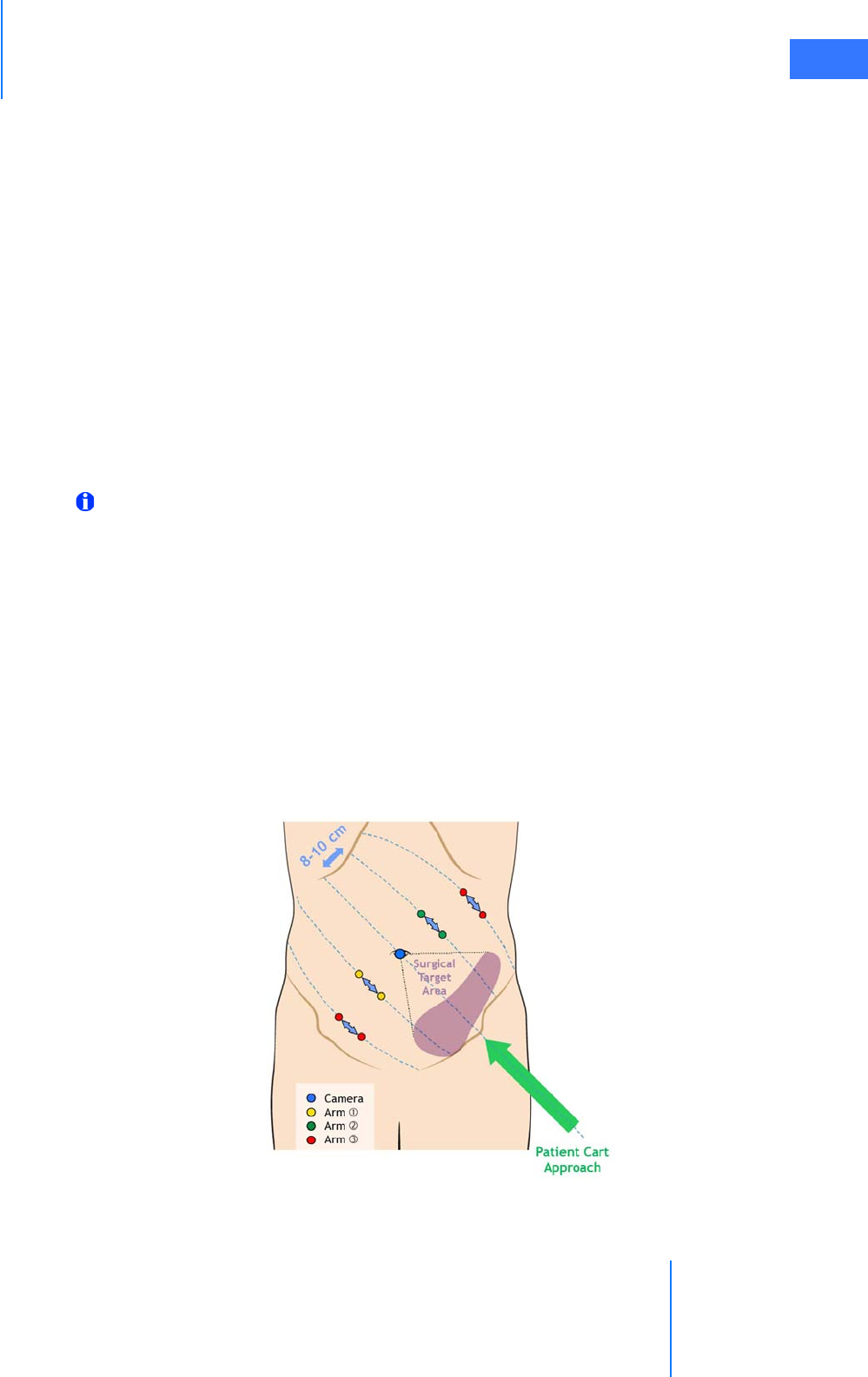
da Vinci® Si™
Patient Preparation, Port Placement, and Docking 8-1
DRAFT/PRE-RELEASE/CONFIDENTIAL
10/9/14
8Patient Preparation, Port Placement, and
Docking
This chapter provides instructions for the following:
•8.1 Patient Preparation Guidelines, page 8-1
•8.2 Port Placement and Cannula Insertion, page 8-1
•8.3 Docking, page 8-4
8.1 Patient Preparation Guidelines
Patient positioning is procedure-specific and is at the discretion of the surgeon. System
positioning guidelines, specific to the da Vinci Si Surgical System, are as follows:
• Arrange Patient Cart arms to avoid contact with the patient.
Note: The patient should be positioned before docking. Table movements are most
easily performed before driving the Patient Cart into position.
8.2 Port Placement and Cannula Insertion
Port Placement Guidelines
Port placement is key to a successful da Vinci Si procedure. The goals of port placement are to
avoid Patient Cart arm collisions and to maximize instrument and endoscope range of motion.
Port placement varies by procedure and patient and should be thoroughly discussed with an
experienced surgeon, since improper port placement may cause difficulty performing da Vinci
Surgery. For procedure-specific port placements, see published Intuitive Surgical Procedure
Guides. Contact your local ISI representative for available Procedure Guides. An example of the
basic port placement philosophy is provided in Figure 8.1.
Figure 8.1 Port placement philosophy example

Patient Preparation, Port Placement, and Docking
da Vinci® Si™
8-2
DRAFT/PRE-RELEASE/CONFIDENTIAL
10/9/14
The following are generic guidelines for choosing port placement. Anatomical restrictions
may necessitate an alternate setup.
Determine port placement based on a parallel line pattern:
• Insufflate before measuring.
• Use the camera location as the center point (maintain 10-20 cm from target anatomy).
• Based on line from target anatomy to camera port, draw parallel lines with 8-10 cm line
spacing.
•Place da Vinci ports along lines, maintaining 10-20 cm from target anatomy, and 8-10 cm
from other da Vinci ports.
•Triangulate da Vinci ports toward or away from the target anatomy as necessary for the
procedure.
• Do not place ports within surgical target area (maintain 10-20 cm from target anatomy).
• For accessory ports, maintain at least 5 cm from the other ports, with a clear trajectory to
the target anatomy.
• If working in more than two quadrants, re-dock the Patient Cart.
Placing Ports and Inserting Cannulae
Note: Follow the instructions in the Instrument and Accessories User Manual to inspect
cannulae before use, including use of a gage pin for 8 mm cannulae.
Initial port location should be selected giving consideration to the procedure, specific
anatomy, and the type of components being used (such as endoscope and camera
combination, cannula length, etc.). For procedure specific port placements, see published
Intuitive Surgical Procedure Guides. Contact your local ISI representative for available
Procedure Guides.
The patient should be prepped, draped and positioned in standard fashion. Following
insufflation, mark the desired location of all instrument and accessory ports. Place all ports
using a standard surgical technique. The camera head and endoscope assembly can be used
manually (not connected to the Patient Cart) during port placement.
Note: Hold the body of the camera head during manipulation to avoid potential damage
to the wiring harness.
da Vinci instrument cannulae may be placed with either blunt or bladeless obturators.
Note: It is recommended that obturator tips remain in view at all times during cannula
insertion (under endoscopic video visualization).
Specific applications may warrant placement of the cannula while connected to the
instrument arm (for example, Cardiac and Thoracic procedures). In this application, the Patient
Cart will need to be positioned before cannula insertion. As with all port placement, this
should be done only under endoscopic video vision.
Note: When inserting cannulae into the patient while the cannulae are attached to the
instrument arms, ensure that Patient Cart is positioned with instruments arms and
setup joints near the center of their range of motion.
WARNING: Once the da Vinci Si System is connected to the patient, the surgical table
MUST NOT BE MOVED in any way. Serious injury could result.
If intraoperative OR table movement is necessary, remove all instruments and the
endoscope, undock the da Vinci Si System, move the OR table and re-dock the system.
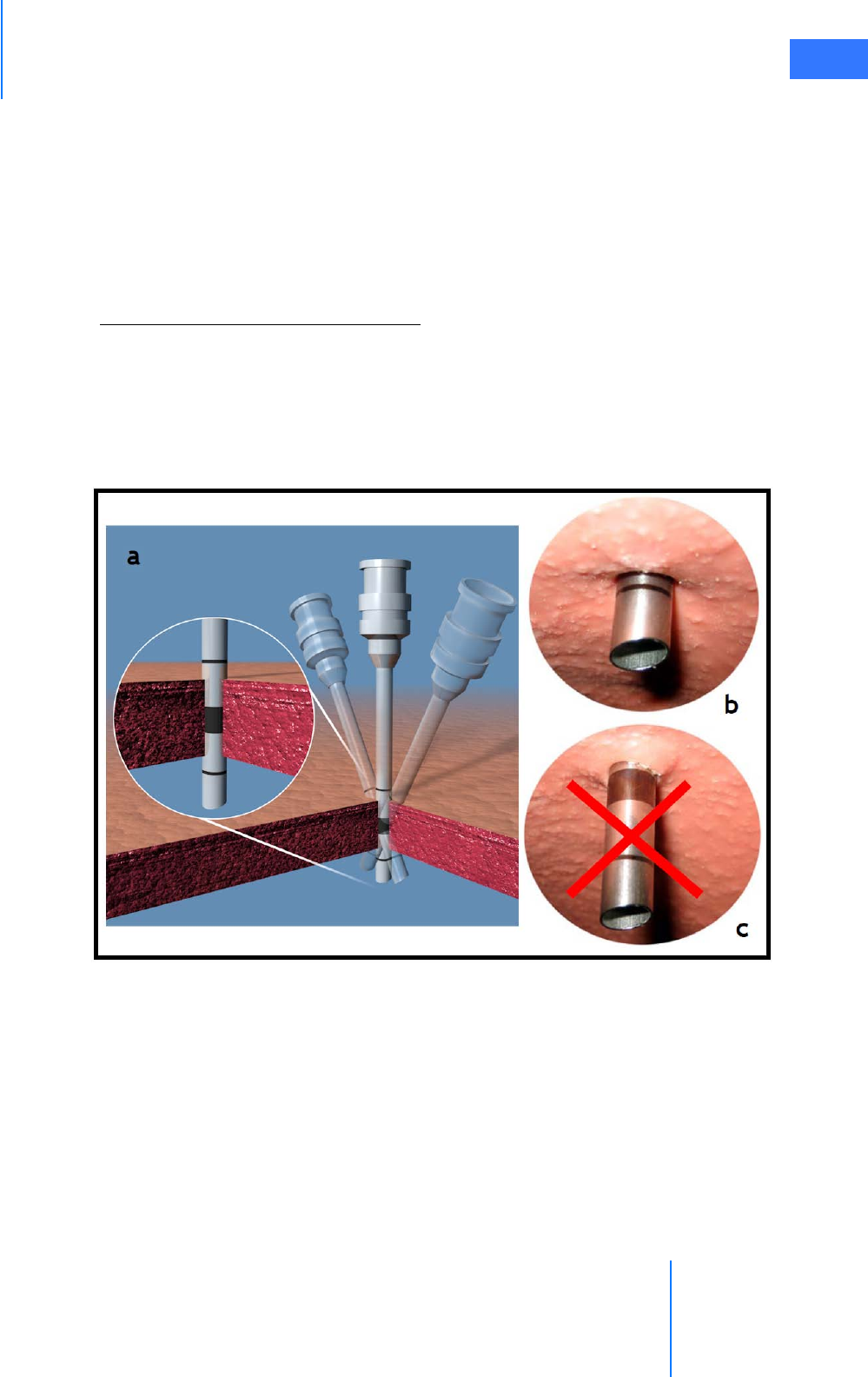
da Vinci® Si™
Patient Preparation, Port Placement, and Docking 8-3
DRAFT/PRE-RELEASE/CONFIDENTIAL
10/9/14
Remote Center
The instrument arms and the camera arm on da Vinci Surgical Systems use remote center
technology. Remote center technology enables the System to maneuver instruments and
endoscopes in the surgical site while exerting minimal force on the patient's body wall. The
remote center is the fulcrum point around which the da Vinci System moves the instrument
and camera arms. When the cannula’s remote center is placed correctly in the patient’s body
wall, moving the Patient Cart arms around the remote center exerts minimal pull and tug at
the port site, which lends itself to reduced pain and faster healing of the incision.
Instrument Cannula Remote Center Setup
The instrument arm remote center is indicated by the thick, center black band on the
instrument cannula.
• To correctly place the remote center, the thick black line on the da Vinci cannula (which
indicates the remote center) should be inserted within the boundaries of the patient’s
body wall. Correct placement allows instruments to pivot through the incision with less
friction and greater precision, which reduces tissue trauma (Figure 8.2 a).
Figure 8.2 Proper placement of instrument cannula remote center
• Correct placement of the cannula should be verified by looking at the cannula tip with
the endoscopic camera (cannulae should always be placed under endoscopic
visualization). Only the first thin line at the distal cannula tip should be visible. This
indicates that the remote center is placed correctly within the boundaries of the patient’s
body wall (Figure 8.2 b).
• If the thick black line on the cannula is seen in the endoscopic view, this means that the
remote center is inserted too deeply. Moving the arms with the remote center incorrectly
placed increases friction, reduces precision and increases tissue trauma at the port site
(Figure 8.2 c).
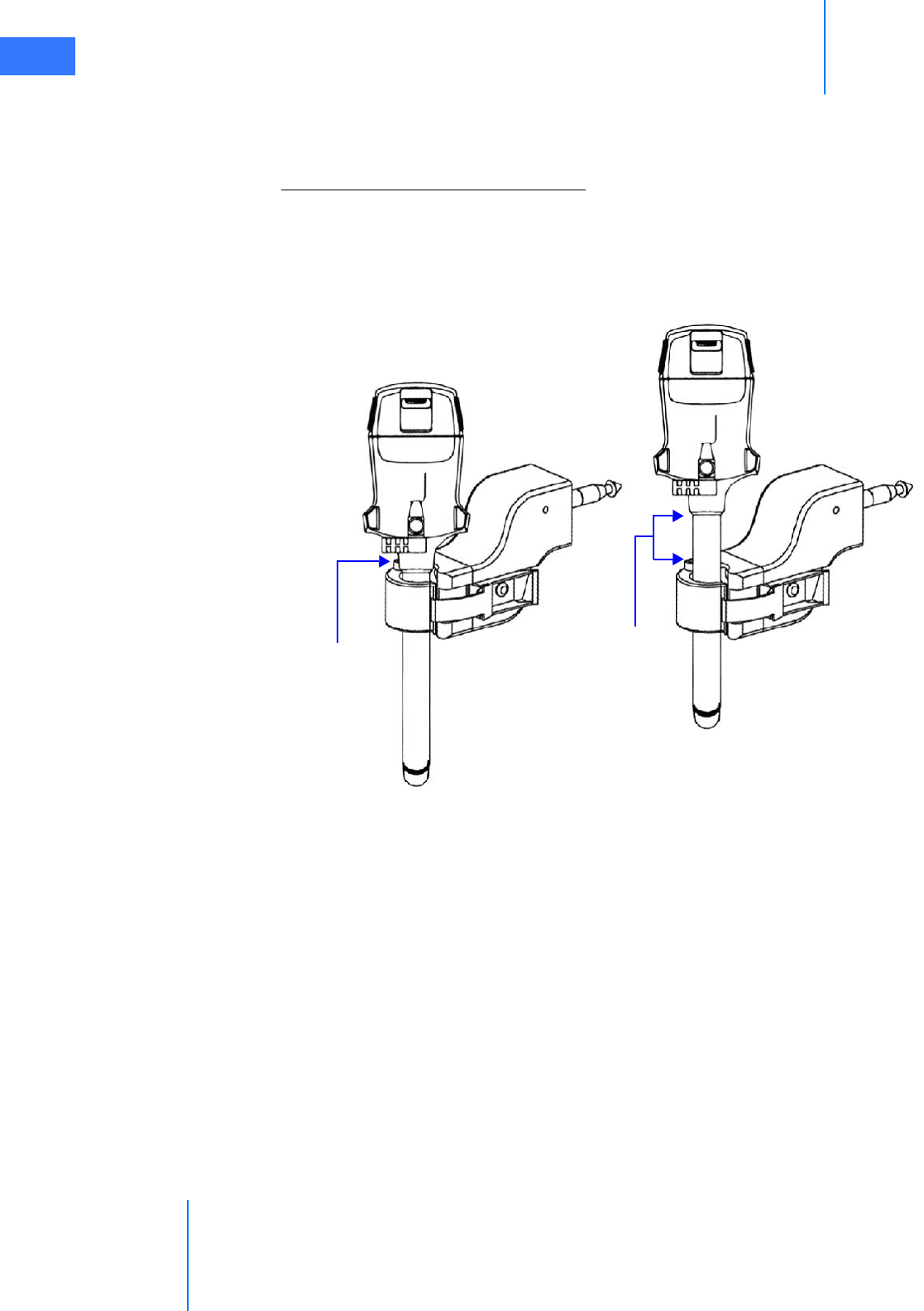
Patient Preparation, Port Placement, and Docking
da Vinci® Si™
8-4
DRAFT/PRE-RELEASE/CONFIDENTIAL
10/9/14
The Surgeon Console operator cannot move the instrument arm remote center. However, the
Patient Cart operator can reposition the remote center by pressing the port clutch button and
repositioning the instrument arm.
Endoscope Cannula Remote Center Setup
Endoscope cannulae used with the da Vinci System do not have a ring or other mark to
indicate the remote center. Therefore, it is vital to attach the endoscope cannula correctly in
the endoscope cannula mount.
• To ensure the remote center of the cannula is properly positioned, the cannula should be
attached at a point immediately below the cannula housing (see Figure 8.3 below).
Figure 8.3 Proper attachment of the endoscope cannula
8.3 Docking
Docking is the process of moving the Patient Cart up to the OR table and connecting the
Patient Cart arms to the patient.
Patient Cart Positioning
Once cannulae are inserted in the patient, a non-sterile person operates the Patient Cart
motor drive to move the Patient Cart into the sterile field. Communication is critical when
docking the Patient Cart. Only one person should give directions to the non-sterile person to
advise of potential collisions and to direct him/her when approaching the patient. Use
anatomical or room references (such as “toward the head,” or “away from the Vision Cart”) to
direct the non-sterile person as they move the cart. Avoid using relative terms such as left or
right.
Correct Incorrect
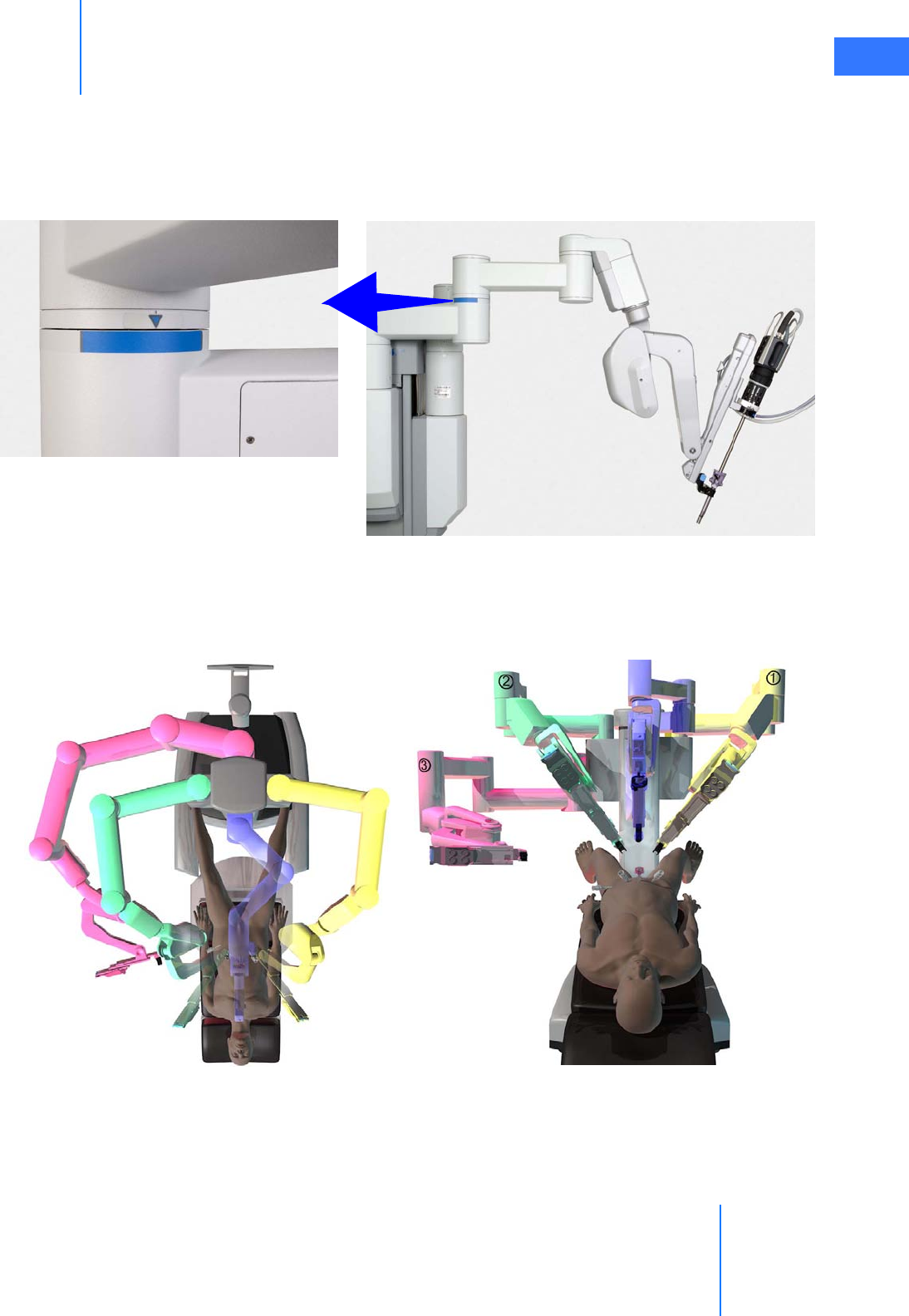
da Vinci® Si™
Patient Preparation, Port Placement, and Docking 8-5
DRAFT/PRE-RELEASE/CONFIDENTIAL
10/9/14
1. Make sure the camera arm remote center is sufficiently away from the Patient Cart tower
to facilitate adequate range of motion for the Patient Cart arms. This is known as setting
the “sweet spot.” To set the “sweet spot,” move the camera arm so that the blue arrow
lines up between the limits of the blue bar located in the middle of the camera arm setup
joint (left or right side).
Figure 8.4 “Sweet spot” label
2. Move the Patient Cart towards the patient using the motor drive. See Motor Drive
Operation on page 3-3 for details. The Patient Cart should approach the patient with the
tower of the Patient Cart lined up in a straight line with the camera cannula and the
target anatomy.
Figure 8.5 Patient Cart positioned over patient model
3. Position the Patient Cart so the camera arm cannula mount is just above the camera
cannula.
Align Patient Cart tower, camera cannula and camera port
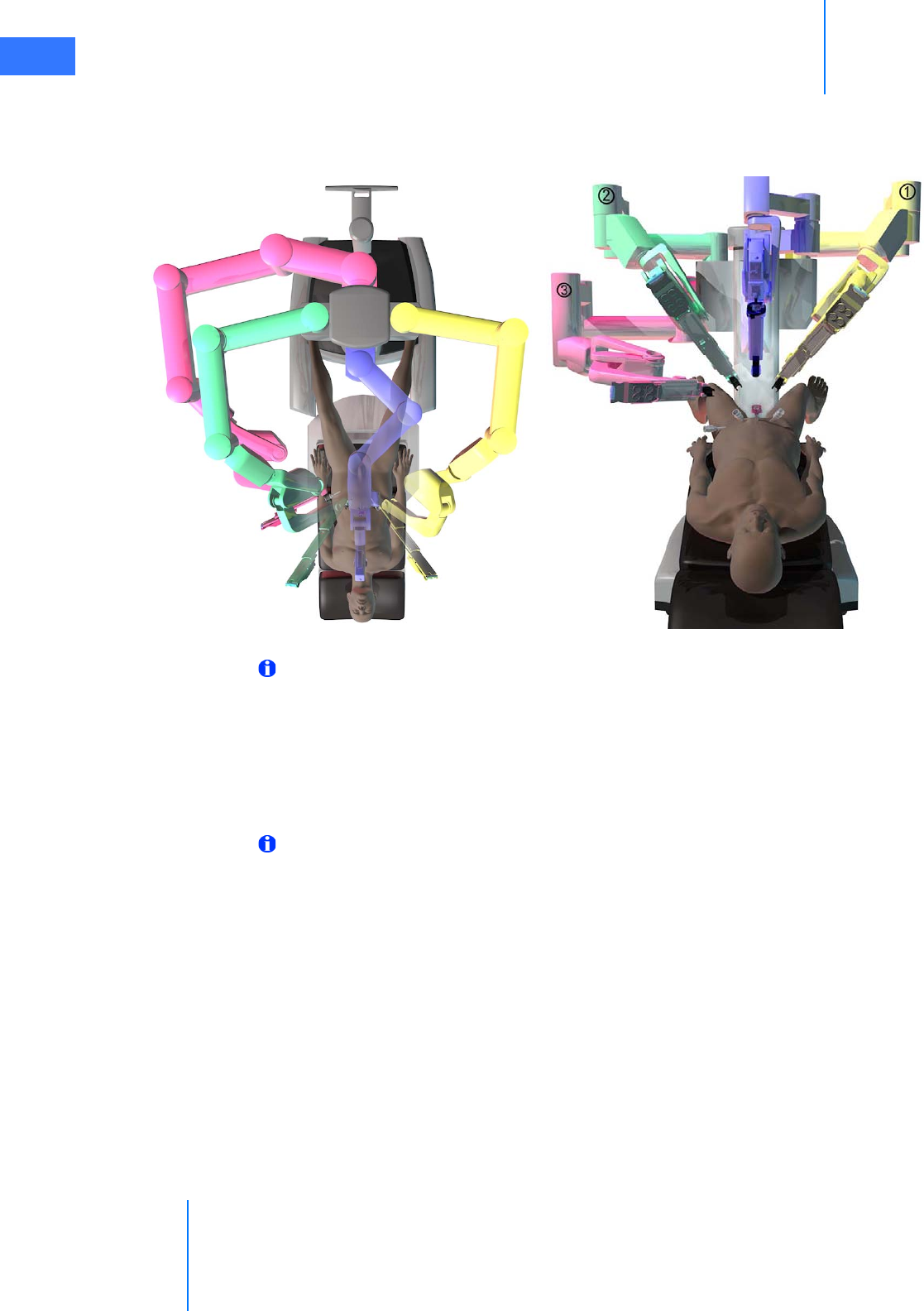
Patient Preparation, Port Placement, and Docking
da Vinci® Si™
8-6
DRAFT/PRE-RELEASE/CONFIDENTIAL
10/9/14
Camera Arm Docking
1. Once the camera cannula mount is above the camera cannula, use the camera arm port
clutch button to bring the cannula mount toward the cannula.
Figure 8.6 Clutch arms to move into docking position
Note: Refer to section 9.2 Moving the Patient Cart Arms on page 9-3 for detailed
instructions on instrument arm, camera arm and port clutching.
2. Align the cannula mount to the cannula by using the camera arm clutch button. Be sure
to un-clutch the camera arm afterwards.
3. Ensure the drape boot is properly aligned with the cannula mount. Connect the cannula
mount to the cannula by using the latches located on the cannula mount. Make sure that
both latches are closed.
Note: To prevent the cart from moving during a procedure, the Patient Cart will
automatically engage the motor drive brakes when any cannula is docked.
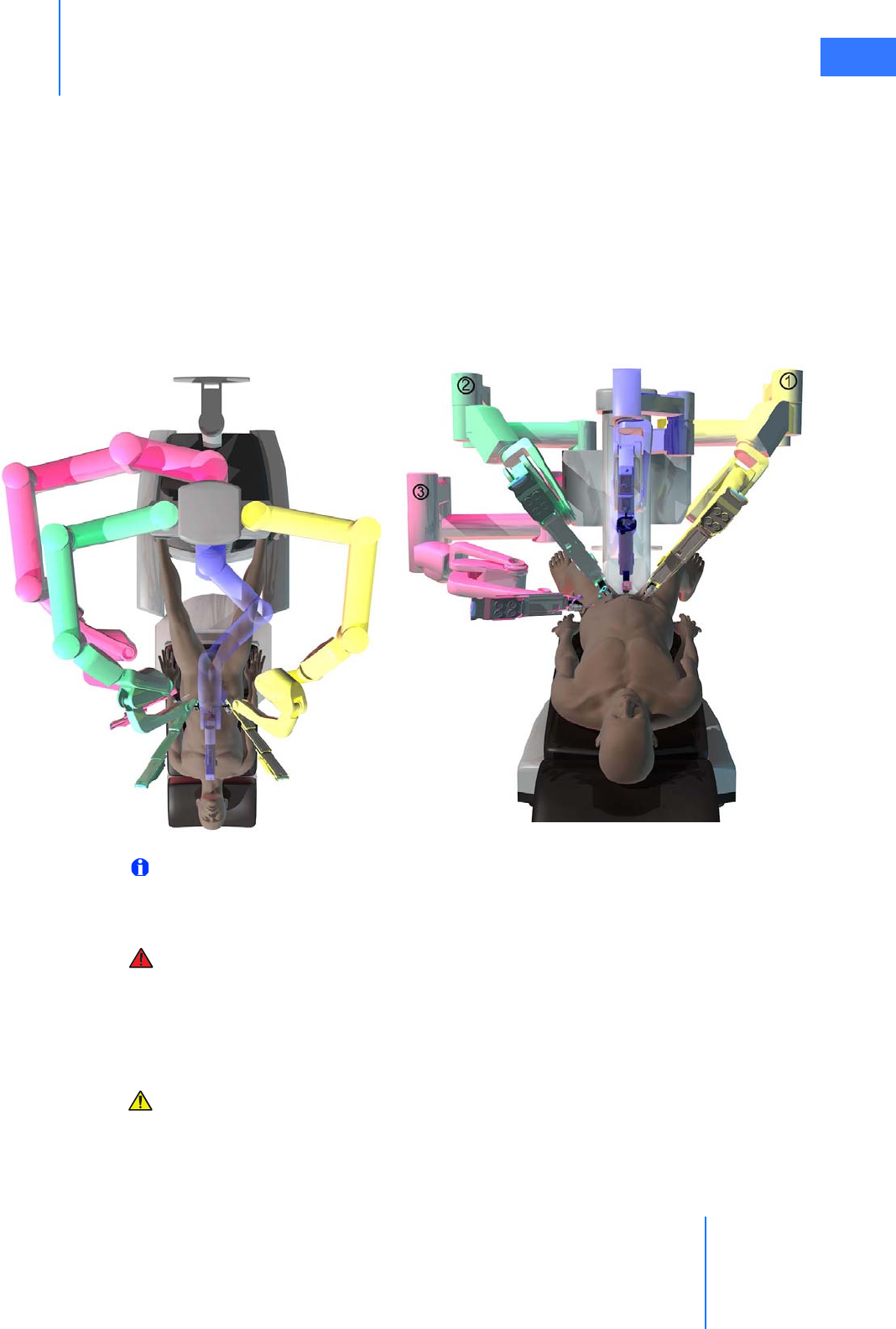
da Vinci® Si™
Patient Preparation, Port Placement, and Docking 8-7
DRAFT/PRE-RELEASE/CONFIDENTIAL
10/9/14
Instrument Arm Docking
1. Use the instrument arm port clutch button to bring the cannula mount to the cannula.
2. Align the cannula mount to the instrument cannula by using the instrument arm clutch
button. Be sure to un-clutch the instrument arm afterwards to lock the arm in place.
3. Ensure the drape boot is properly aligned with the cannula mount. Connect the cannula
mount to the cannula by using the latches located on the cannula mount. Make sure that
both latches are closed.
4. Ensure the back end of the instrument arm is rotated away from the camera arm. If there
are two instrument arms on one side, ensure the instrument arm closest to the camera
arm has adequate range of motion while minimizing collisions.
Figure 8.7 Docking complete
Note: Once the Patient Cart arms are docked, the port clutch button should only be used
to reposition the remote center. If the port clutch button is used, use care to prevent
sliding the cannula out of the port site.
WARNING: Once the da Vinci Si System is positioned, cannulae are placed in the patient
and Patient Cart arms are attached to the cannulae, the surgical table MUST NOT BE
MOVED in any way. Serious injury could result.
If intraoperative OR table movement is necessary, undock the da Vinci Si System, move
the OR table and re-dock the system.
CAUTION: Unexpected motion can occur when instruments collide. Ensure there is
adequate room for instruments to move inside the patient.

Patient Preparation, Port Placement, and Docking
da Vinci® Si™
8-8
DRAFT/PRE-RELEASE/CONFIDENTIAL
10/9/14
CAUTION: Make sure there is adequate room for the arms to move without contacting
the patient during the procedure. Ensure that the patient-side assistant can see all arms
during the procedure and can alert the surgeon when the arms are close to contacting
the patient.
Note: If, while operating, you move the masters and no instrument motion occurs, there
may be a collision between instruments or instrument arms, or between an arm and the
patient. Resolve the collision before proceeding with the surgery.
Note: If collisions between the arms occur, it may be possible to slightly adjust the
position of setup joints using the port clutch button to create more space between arms.
Remove the instruments before pressing the port clutch button and use care to prevent
sliding of the cannula out of the port site while you adjust the set up joint positions.
Note: If collisions between the arms occur, ensure that the instruments are still fully
engaged on the instrument arm.
_________________________________End of section______________________________
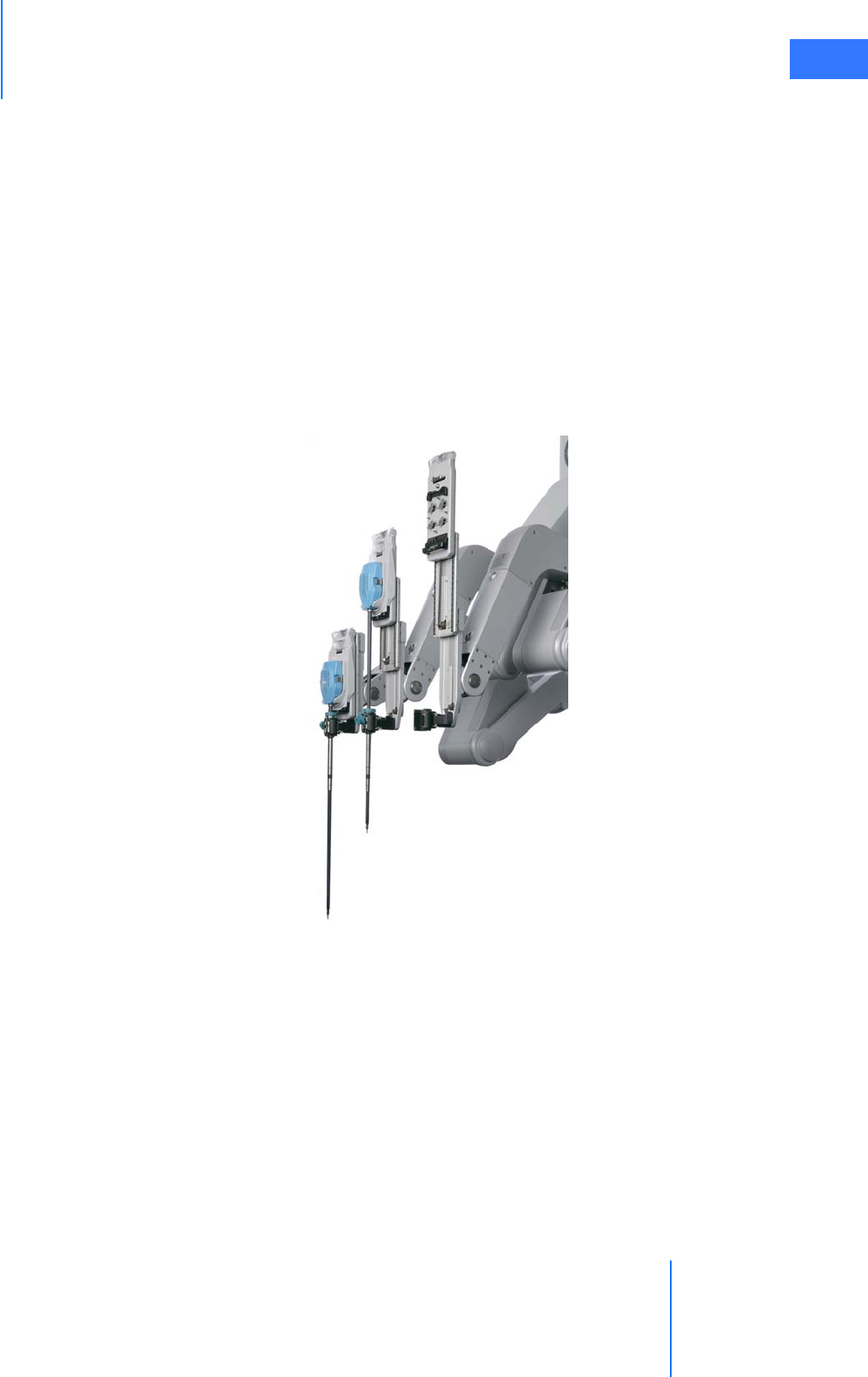
da Vinci® Si™
Patient Cart Use 9-1
DRAFT/PRE-RELEASE/CONFIDENTIAL
10/9/14
9Patient Cart Use
This chapter explains the use of the Patient Cart during surgery. The following subjects are
covered:
•9.1 Patient Cart Overview, page 9-1
•9.2 Moving the Patient Cart Arms, page 9-3
•9.3 Working with EndoWrist Instruments, page 9-5
•9.4 Instrument Installation, Insertion, Removal and Intraoperative Care, page 9-7
•9.5 Working with the Endoscope at the Patient Side, page 9-14
•9.6 Endoscope Installation, Insertion, Removal and Intraoperative Care, page 9-16
Figure 9.1 Instruments installed on the insertion axes
9.1 Patient Cart Overview
The Patient Cart has five main components with which users interact:
•Setup Joints
• Instrument Arms
• Camera Arm
•EndoWrist Instruments
• Endoscope Assembly
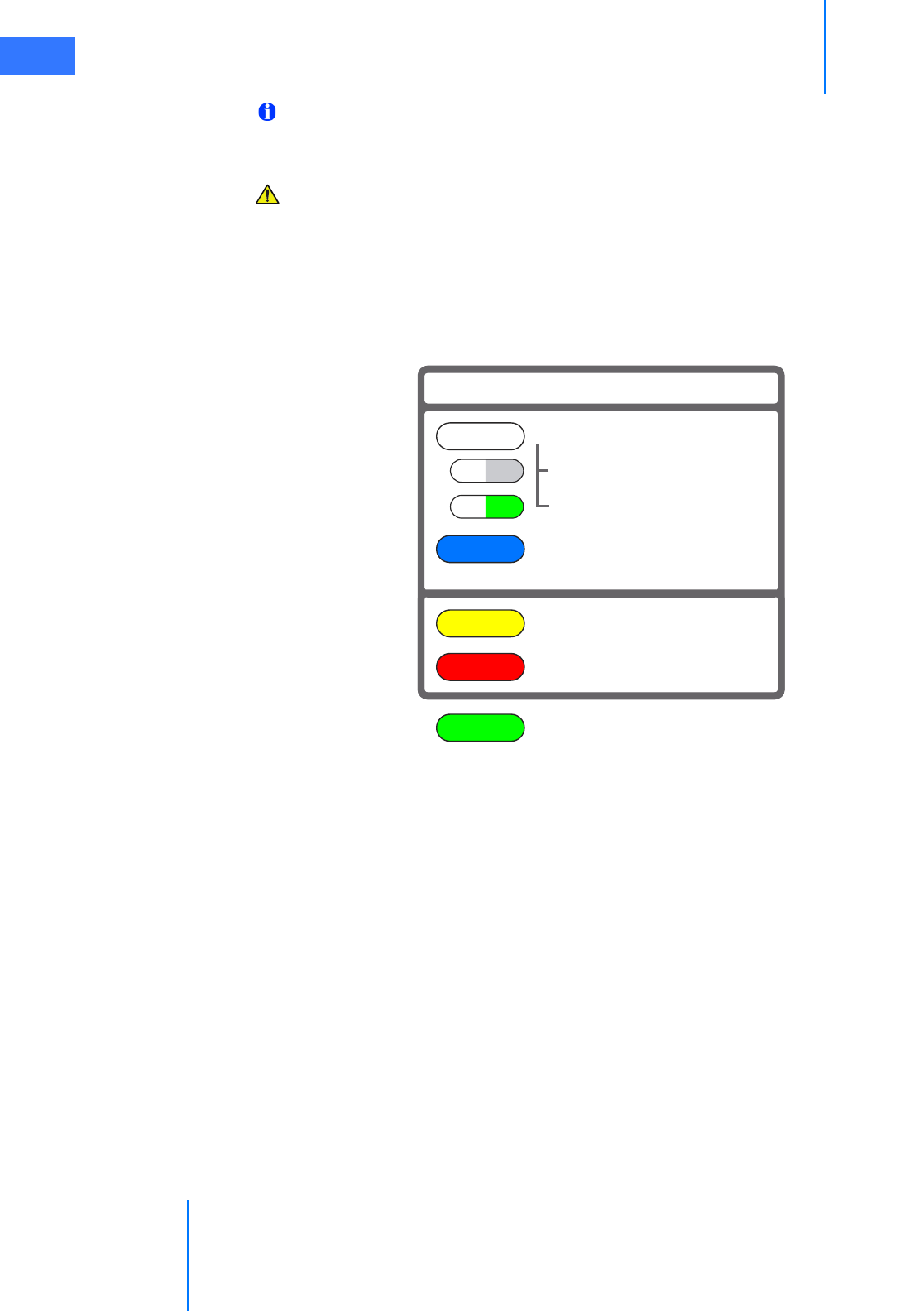
Patient Cart Use
da Vinci® Si™
9-2
DRAFT/PRE-RELEASE/CONFIDENTIAL
10/9/14
Note: Some Patient Cart functions are not used during surgery. Functions used outside
of surgery (such as system setup and teardown) are explained in their respective
sections.
CAUTION: Do not touch any wire harnesses or mechanical cables located on the camera
or instrument arms while simultaneously touching the patient or when positioning the
arms.
LED Status Indicators
Indications of the status of the instrument and camera arms are provided by LEDs on the top
of the insertion axis of each instrument and camera arm. The meanings of the colors are as
follows:
Figure 9.2 LED Quick Reference
Corresponding LED icons—graphics that reproduce the LED status—appear simultaneously
on the touchscreen and stereo viewer.
LED Quick Reference
Not ready for surgeon control
blinking
blinking
blinking
Arm or port clutch
Guided tool change
Ready for surgeon control
Warning: Intervention required
See display for details
Error: System restart required
See display for details
System working.
Please wait.
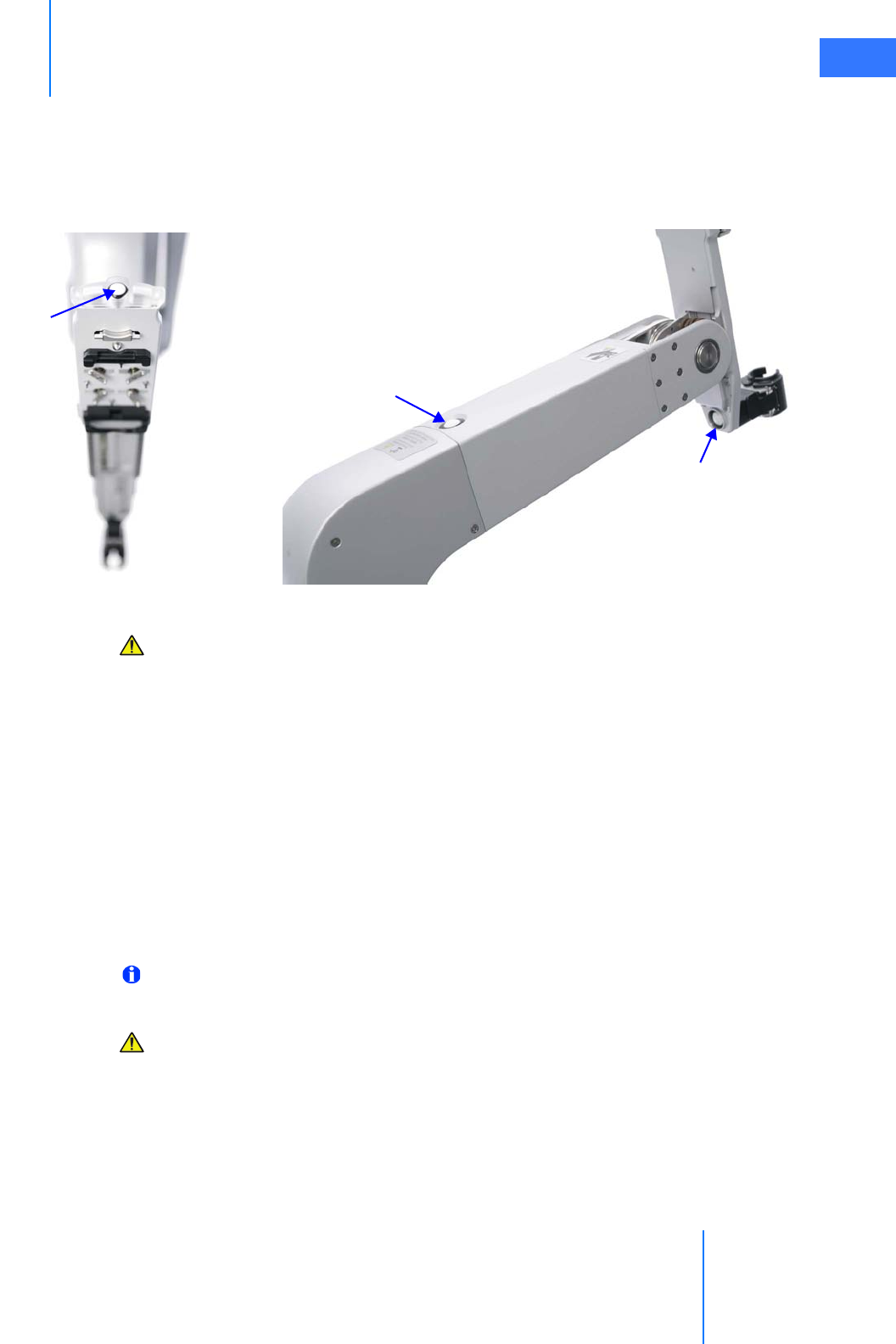
da Vinci® Si™
Patient Cart Use 9-3
DRAFT/PRE-RELEASE/CONFIDENTIAL
10/9/14
9.2 Moving the Patient Cart Arms
Arm Clutch and Port Clutch Buttons
Use the arm clutch and port clutch buttons (Figure 9.3) to position the instrument and camera
arms.
Figure 9.3 Arm clutch and port clutch buttons
CAUTION: When using setup joint or clutch buttons, keep your fingers clear of the joints
located on the camera and instrument arms to avoid injury.
Arm Clutch to Move Arms Manually
You can manually position instruments and endoscopes in the surgical field using their arm
clutch buttons (Figure 9.3). While you clutch an arm, you can move the arm around the remote
center, but the remote center does not move. When clutched, the arm LED blinks white,
alternating side to side.
You can clutch the arm in two ways:
•Press and hold: Press and hold the arm clutch button to free the arm and move it. When
you release the button, the arm exits clutch mode and the brakes are reapplied.
•Quick click: Quick click the arm clutch button to free the arm and move it. Quick click the
arm clutch button again to exit clutch mode.
Note: For instrument arms, the telescoping insertion axis extends fully when you
remove an instrument, and remains fully extended until an instrument is re-installed.
CAUTION: To prevent movement of the insertion axis while clutching, hold the
instrument or camera arm steady by grasping the top of the insertion axis whenever you
press the arm clutch button.
Arm
Clutch
Port
Clutch
Port Clutch
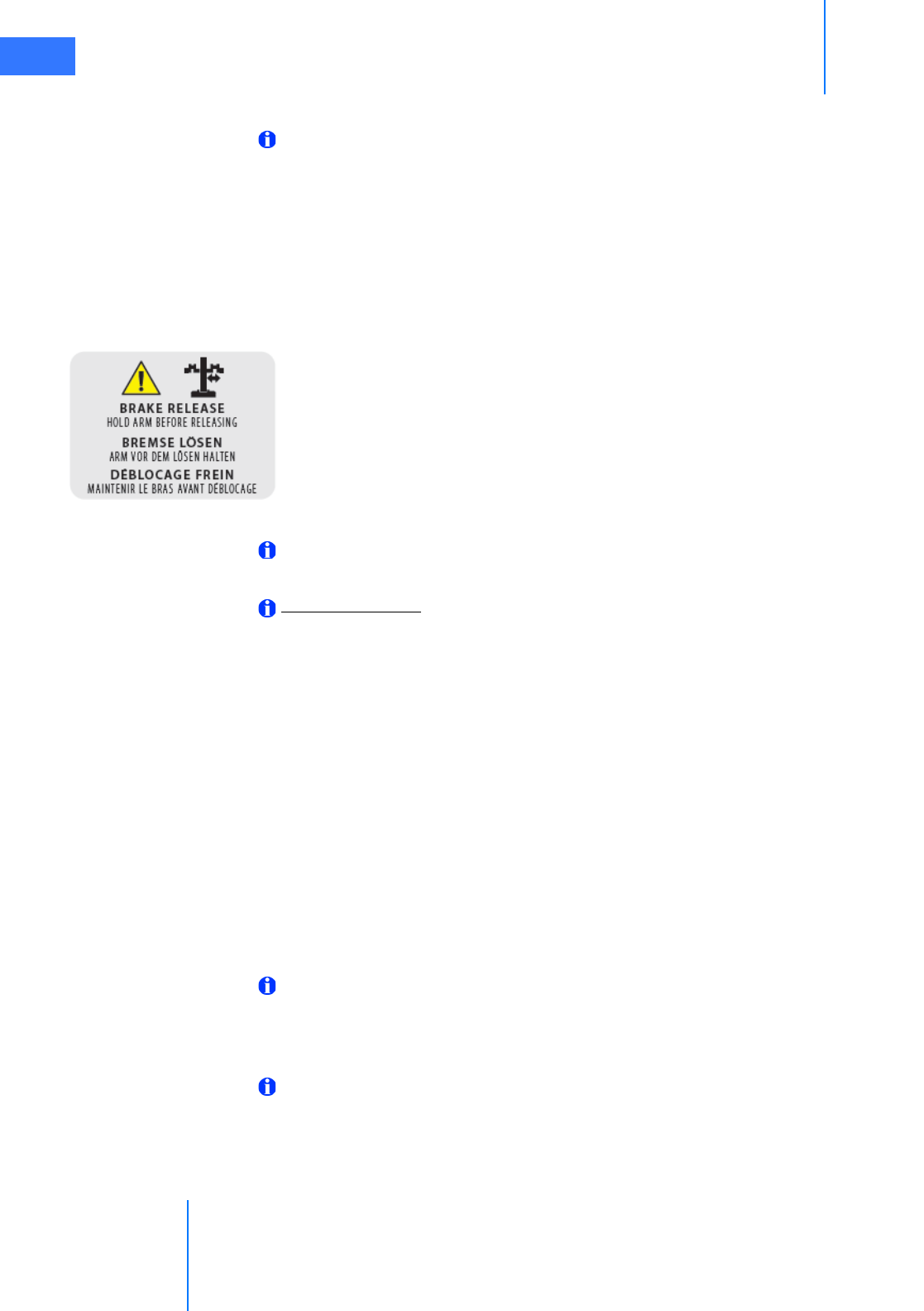
Patient Cart Use
da Vinci® Si™
9-4
DRAFT/PRE-RELEASE/CONFIDENTIAL
10/9/14
Port Clutch to Move Setup Joints Manually
Note: The term “port clutch” is used interchangeably with “set-up arm clutch”; both
refer to the button and to the action that results from pressing it, which is to free the
setup joint so you can reposition the setup arm manually.
You can move Patient Cart setup joints manually using the port clutch button. Both
instrument and camera arms have two port clutch buttons on the lower part of the arm, one
behind the cannula mount and one on the middle of the arm. (See Figure 9.3 above.) When
you move the setup joint, it changes the position of the remote center (port position). While
you clutch the setup joint, the associated arm LED blinks white, alternating side to side.
To move a setup joint, first hold the arm and then apply the port clutch in this way:
•Press and hold. Press and hold the port clutch button to free the setup joint and move it.
When you release the button, the setup joint exits port clutch mode and the brakes are
reapplied.
The label at left appears near the upper port clutch buttons. It includes the following text in
English, and translations of the same in German and French:
“BRAKE RELEASE
HOLD ARM BEFORE RELEASING”
Note: It may be necessary for the reader to be as close as 6 in (15 cm) from the label to
read this information.
Notes on Clutching
Note: You can apply the arm clutch and port clutch simultaneously. On an instrument
arm, if you clutch arm and port simultaneously, it locks the instrument arm insertion
axis; this does not apply to the camera arm.
Note: Clutching an instrument arm prevents control of that arm at the Surgeon Console.
Clutching the camera arm prevents control of all arms at the Surgeon Console.
Unexpected Setup Joint Motion
Unexpected setup joint motion occurs when the setup joint brakes are overpowered. Multiple
factors can cause this, including excessive force on the patient and collisions of Patient Cart
components (arms, setup joints, nearby objects). If the system detects unexpected setup joint
motion, the arm LED for the associated setup joint turns yellow and a message appears on
screen.
• To clear the error, press the port clutch button for that arm. This also relieves any potential
excessive force on the patient.
Note: If collisions between the arms occur, it may be possible to slightly adjust the
position of setup joints using the port clutch button to create more space between arms.
Remove the instruments before pressing the port clutch button and use care to prevent
sliding of the cannula out of the port site while you adjust the setup joint positions.
Note: If collisions between the arms occur, ensure that the instruments are still fully
engaged on the instrument arm.
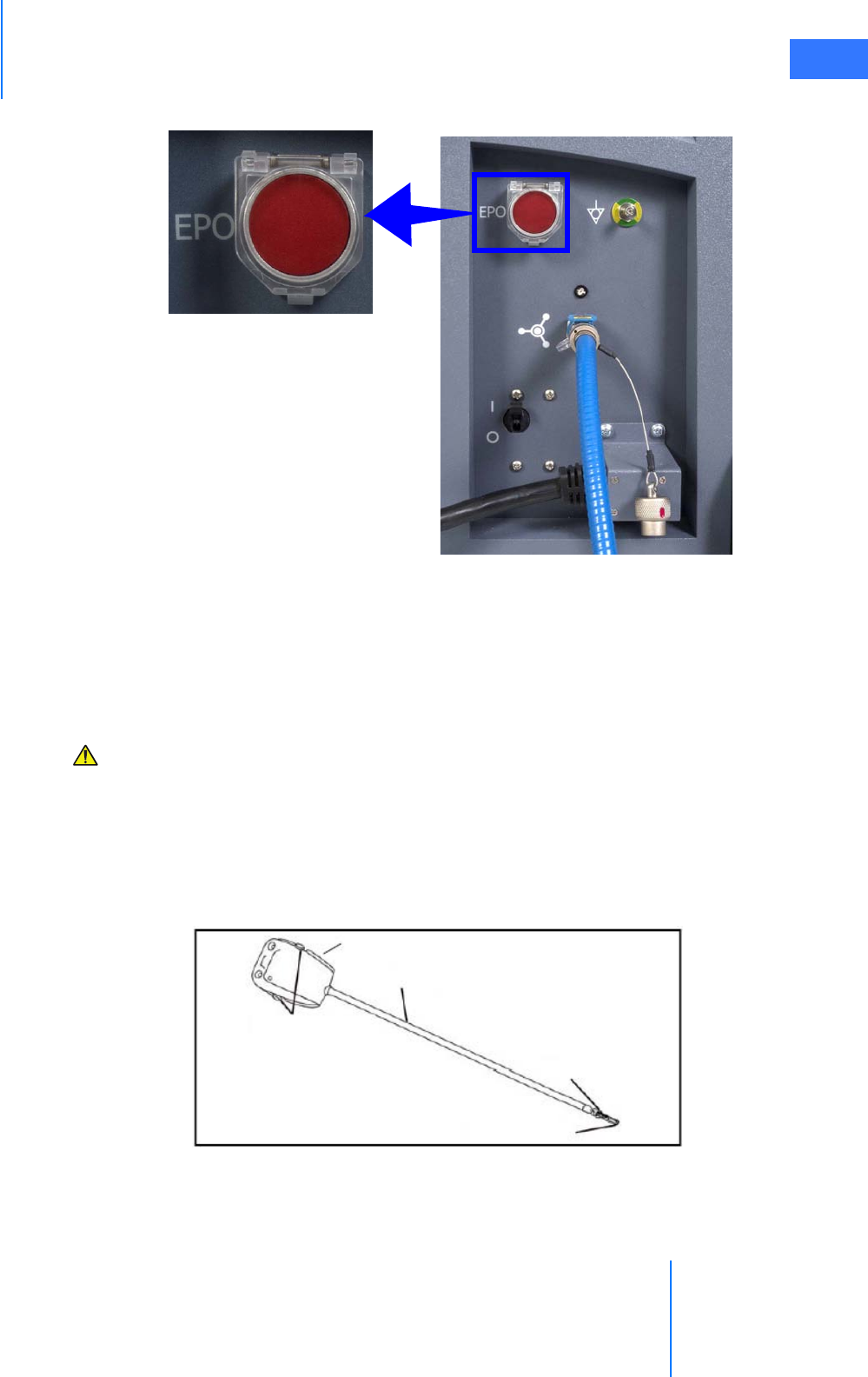
da Vinci® Si™
Patient Cart Use 9-5
DRAFT/PRE-RELEASE/CONFIDENTIAL
10/9/14
EPO (Emergency Power Off)
Figure 9.4 EPO button on rear of Patient Cart
The Emergency Power Off (EPO) button is on the back of the Patient Cart. Press this button to
completely remove power to the Patient Cart. The system classifies this a non-recoverable
fault. The system must be restarted.
9.3 Working with EndoWrist Instruments
CAUTION: Only use instruments and accessories approved by Intuitive Surgical for use
with the da Vinci® Si™ Surgical System. Intuitive Surgical performs extensive testing to
ensure compatibility of approved instruments and accessories. Compatibility of the
system with non-approved instrumentation cannot be guaranteed. Any damage to the
da Vinci Si Surgical System as a result of using non-approved instruments and
accessories is not covered under warranty.
EndoWrist instruments consist of five main components (illustrated in Figure 9.5):
Figure 9.5 EndoWrist instrument components
1. Tip: The end effector of the instrument (such as graspers, cautery hooks, scalpels, etc.)
2. Wrist: The articulating wrist designed to mimic the wrist of the human hand
Tip
Wrist
Shaft
Release
Instrument Housing
Levers
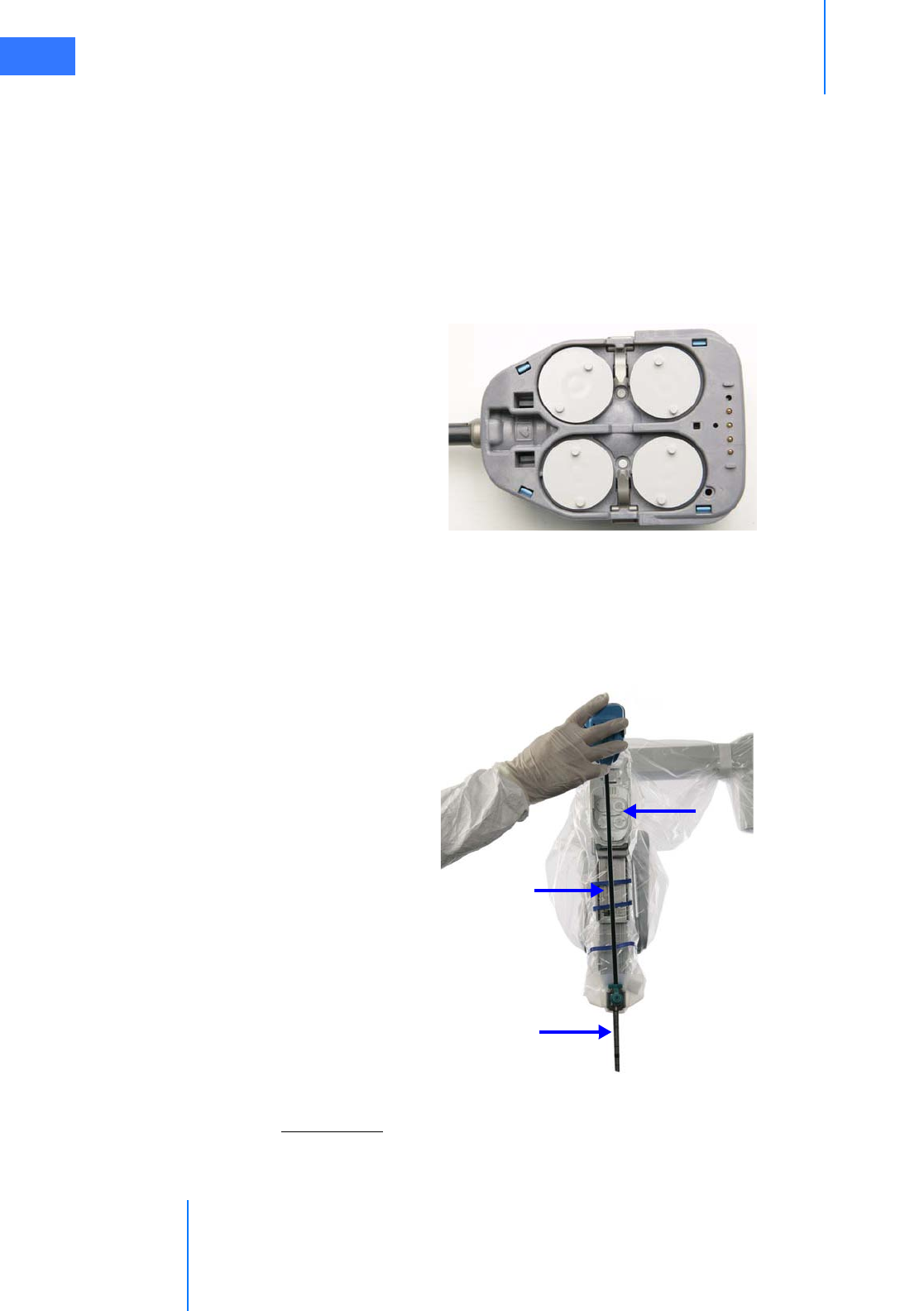
Patient Cart Use
da Vinci® Si™
9-6
DRAFT/PRE-RELEASE/CONFIDENTIAL
10/9/14
3. Shaft: The rotating “arm” of the instrument
4. Release Levers: The mechanism for removal of the instrument
5. Instrument Housing: The portion of the instrument that engages with the sterile
adapter of the instrument arm
On the bottom of the instrument housing, you'll see a series of discs, which connect to the
instrument wrist via cables that run through the instrument shaft. The movement of the
master controllers on the Surgeon Console is translated through the pulleys to the EndoWrist
instrument wrist. You also can rotate these disks by hand (when not attached to the sterile
adapter) to verify the cable functionality, or to align the wrist for tool insertion.
Figure 9.6 Discs located in the instrument housing
The instrument interface of the instrument arm consists of three parts (Figure 9.7):
1. Insertion Axis
2. Instrument Sterile Adapter
3. Cannula
Figure 9.7 Insertion axis, sterile adapter and cannula with instrument being loaded
Insertion Axis
The telescoping insertion axis delivers the instrument to the surgical site. When no instrument
is present, the insertion axis is fully retracted.
Insertion axis
Cannula
Sterile adapter
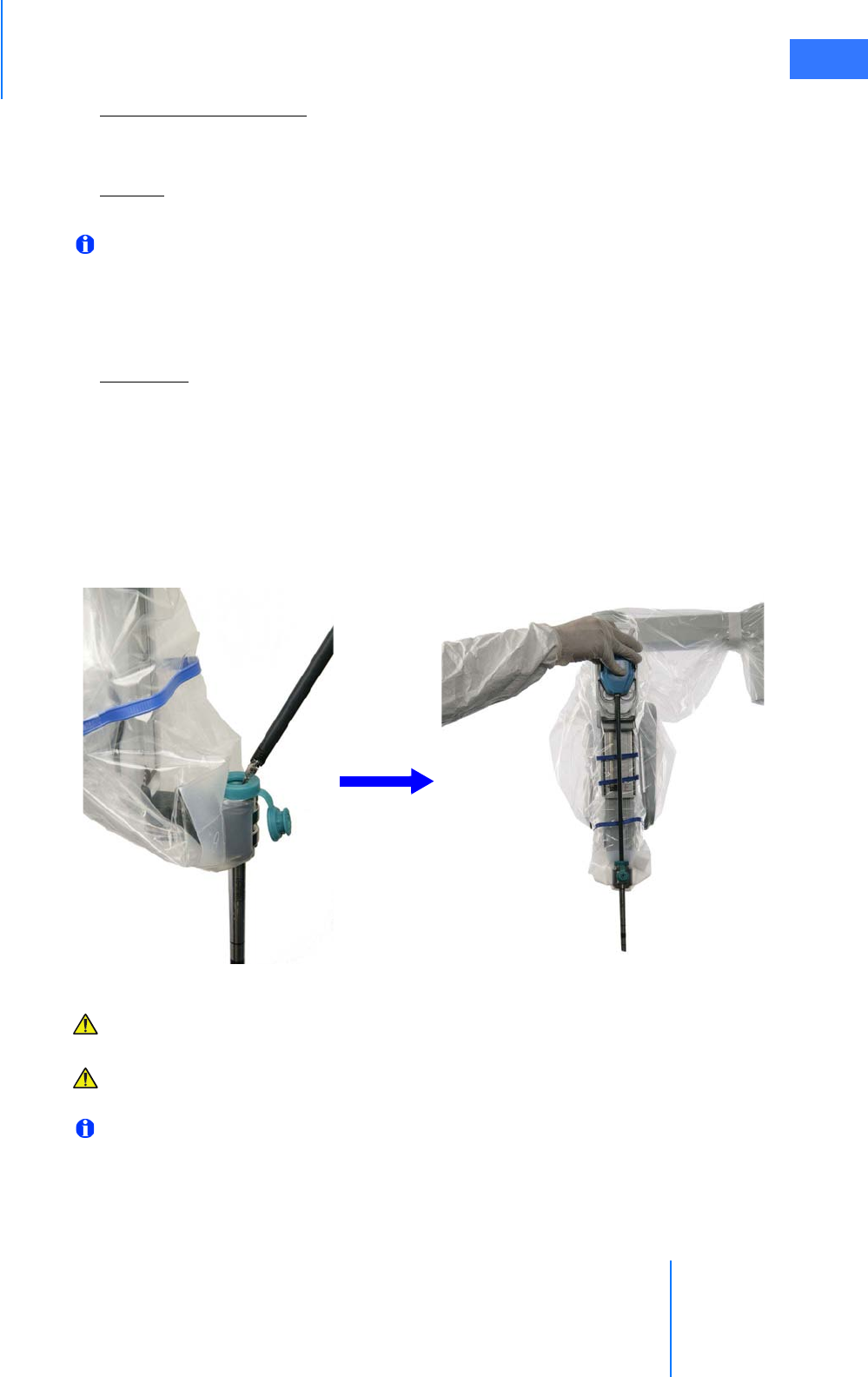
da Vinci® Si™
Patient Cart Use 9-7
DRAFT/PRE-RELEASE/CONFIDENTIAL
10/9/14
Instrument Sterile Adapter
The instrument sterile adapter is part of the instrument arm drape and provides the point of
connection between the instrument and the instrument Arm.
Cannula
The cannula provides the port through the body wall of the patient.
Note: Follow the instructions in the Instrument and Accessories User Manual to inspect
cannulae before use, including use of a gage pin for 8 mm cannulae.
9.4 Instrument Installation, Insertion, Removal and
Intraoperative Care
Installation
1. Inspect the instruments for broken, cracked, chipped, or worn parts and discontinue the
use of instruments if any damage is noticed.
2. Straighten the instrument wrist—by rotating the discs on the back of the instrument
housing, not by manipulating the wrist directly—to ensure easy insertion into the
cannula and to prevent damage to the instrument.
3. Insert the instrument tip into the cannula and slide the instrument housing into the
sterile adapter. You will hear three beeps when the instrument is engaged.
Figure 9.8 Inserting the instrument into the cannula and sterile adapter
CAUTION: When inserting the instrument tip into the cannula, be careful not to
puncture the instrument arm drape with the tip of the instrument.
CAUTION: Ensure all installed instruments are visible in the Surgeon Console view
before proceeding to prevent inadvertent harm to the patient.
Note: One instrument life is used whenever the instrument is used via the Surgeon
Console (following mode). The number of uses left on the instrument may be queried
without using a “life” by removing the instrument before entering following mode.
When an instrument has no remaining uses, it will not engage on the system and a
message on the touchscreen says the instrument has expired.

Patient Cart Use
da Vinci® Si™
9-8
DRAFT/PRE-RELEASE/CONFIDENTIAL
10/9/14
Instrument Installation Best Practices
1. Verify the sterile adapter discs are aligned using the
process above before installing an instrument.
2. Do not squeeze the release levers while installing
the instrument onto the Sterile Adapter.
3. Do not apply excessive force when installing the
instrument.
4. Verify pins on the back of the arm are flush on the
arm and not protruding.
Troubleshooting
Sequence:
1. If the instrument does not engage properly, reseat the instrument.
2. If the problem is not resolved, reseat the sterile adapter using the Sterile Adapter Engagement Verification
process on page 6-11.
3. If the problem is not resolved, re-drape the arm.
For assistance, contact Technical Support: U.S. 800-876-1310, International +800 0821 2010 or +41 21 821
2020.
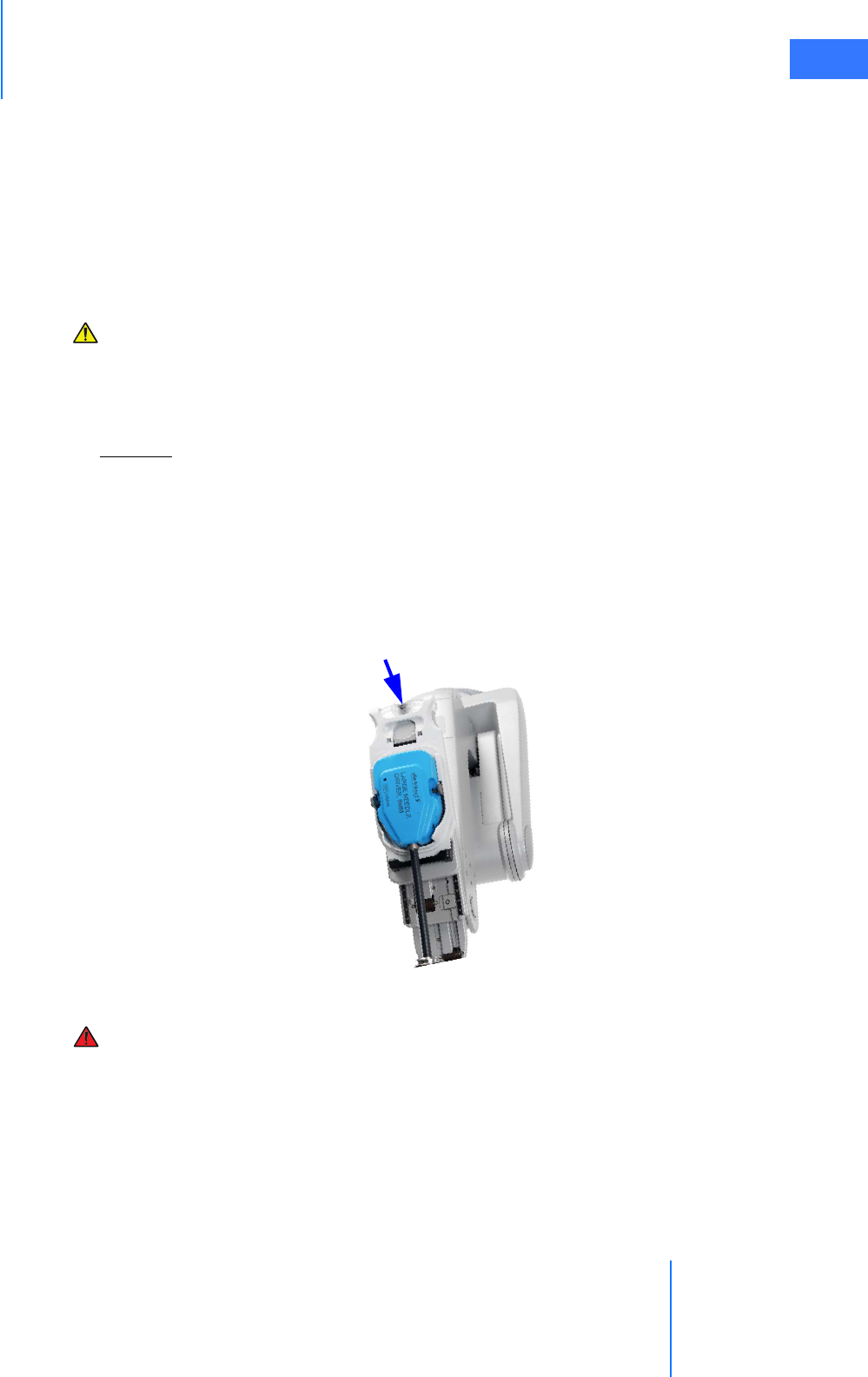
da Vinci® Si™
Patient Cart Use 9-9
DRAFT/PRE-RELEASE/CONFIDENTIAL
10/9/14
Plug and Play
Newly released instruments may need to download their new parameters to the da Vinci Si
System. This process is only required once for each new type of instrument, and will take up to
15 seconds. During this download period, the arm LED will rapidly flash green and a message
is displayed. Progress is shown as a percentage of completion. If an error occurs during plug
and play, re-install the instrument.
Insertion
CAUTION: Make sure the Surgeon Console operator is ready to resume control of the
instrument before inserting an instrument into the sterile field.
Once the system recognizes an instrument installed on an arm, you can insert it into the
patient’s body either manually or by using Guided Tool Change.
Manually
For the first instrument you install on an arm for this procedure, you must manually insert the
instrument by pressing an arm clutch button (see Figure 9.9). The LEDs will blink alternating
white during arm clutch. The Surgeon Console operator cannot control the instrument until it
is moved out of the cannula and is no longer being clutched. Note that if you press and release
the arm clutch button, instead of holding it down continuously as you insert the instrument,
you must press and release the arm clutch button again after insertion through the cannula,
to give control of the instrument to the surgeon.
Figure 9.9 Using arm clutch to insert an instrument manually
WARNING: The instrument may not be immediately visible when being moved from the
cannula into the patient. Move the endoscope to visualize the instrument and use
appropriate caution when inserting instruments into the patient.
Arm clutch button
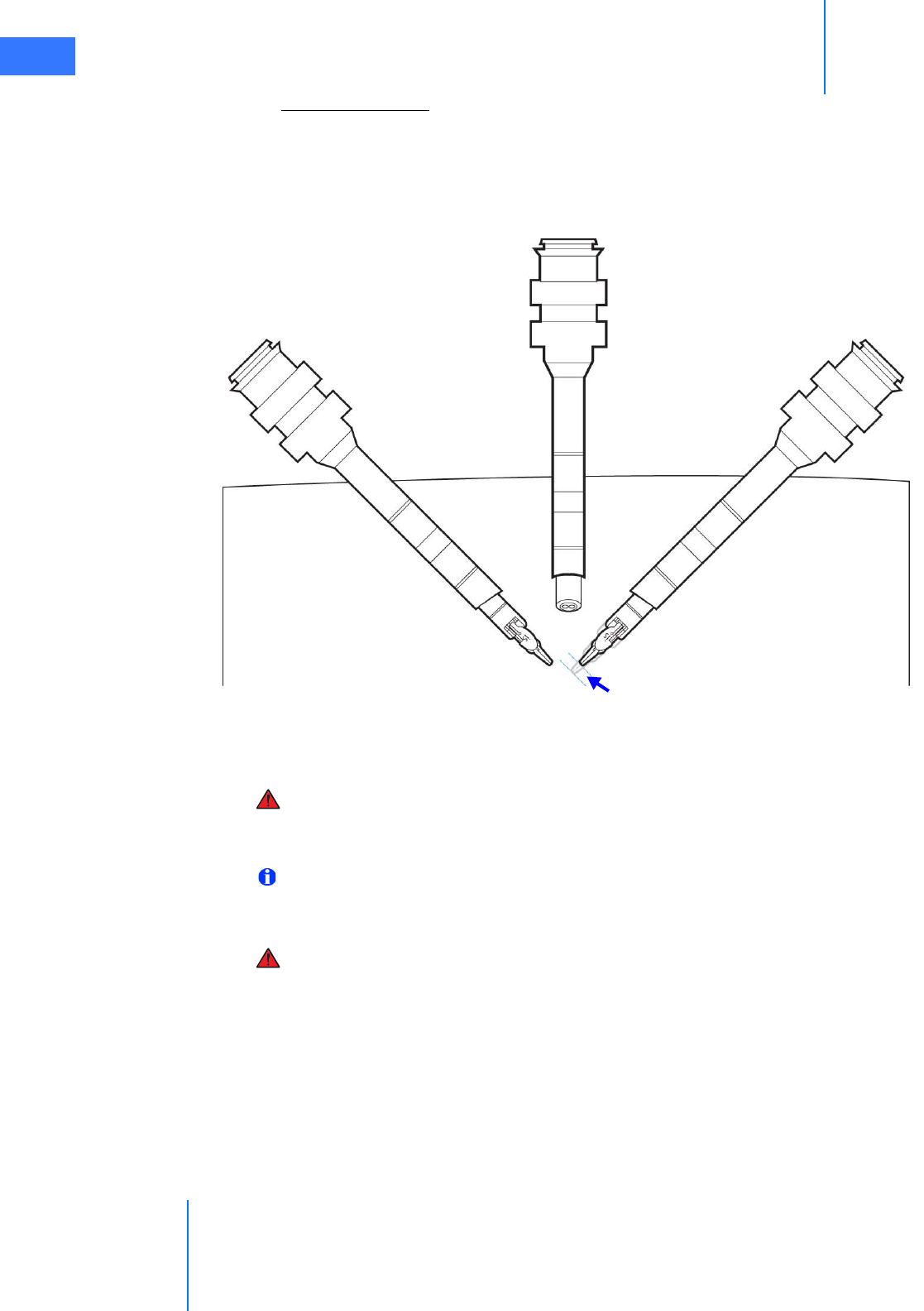
Patient Cart Use
da Vinci® Si™
9-10
DRAFT/PRE-RELEASE/CONFIDENTIAL
10/9/14
Guided Tool Change
To provide an efficient and safe method for instrument insertion, the system can assist the
patient-side assistant by guiding an instrument into the patient. Guided Tool Change only
works when you replace an instrument. When you install the next instrument, the insertion
axis unlocks and guides the instrument tip to a location just short of the last position of the
previously installed instrument tip (Figure 9.10).
Figure 9.10 Illustration of Guided Tool Change
• If Guided Tool Change is enabled, the instrument arm LED blinks side-to-side, alternating
white and green.
WARNING: During an instrument exchange, including using Guided Tool Change, the
surgeon must not remove his/her hands from the masters until he/she has removed
his/her head from the stereo viewer.
Note: For Guided Tool Change, the surgeon should remove their head from the stereo
viewer to take all instruments out of following before removing and installing an
instrument.
WARNING: Use appropriate caution when inserting instruments into the patient by
visualizing the instrument on the touchscreen as it is being inserted.
• If Guided Tool Change is not enabled, the instrument arm LED is white and does not
blink. Also, the system will display an icon and message instructing you to insert the
instrument past the cannula tip.
The following occurrences disable Guided Tool Change:
• Pressing an instrument arm or port clutch button
•Any errors
• Instrument tip too close to cannula
Guided Tool Change
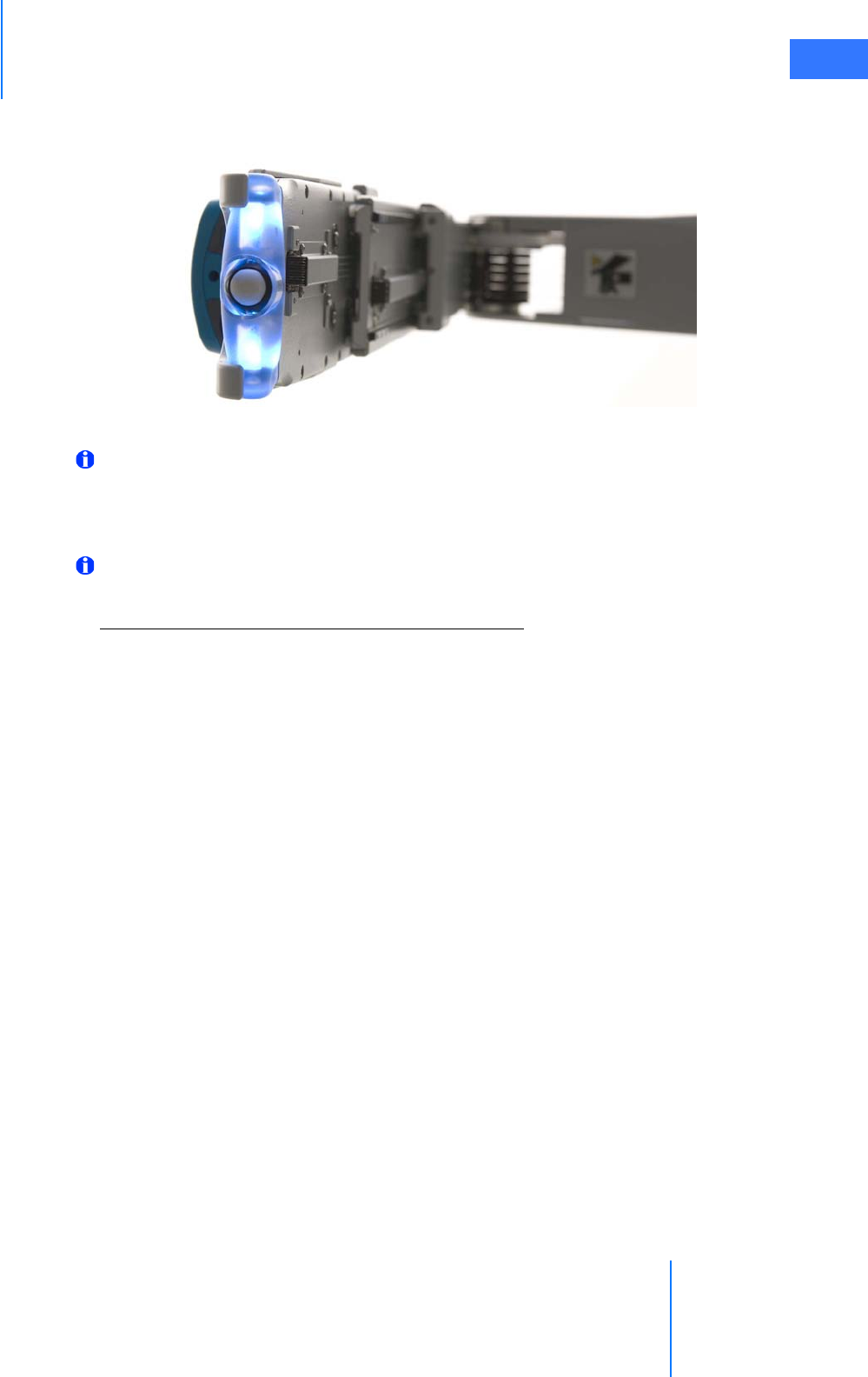
da Vinci® Si™
Patient Cart Use 9-11
DRAFT/PRE-RELEASE/CONFIDENTIAL
10/9/14
After successful instrument insertion (using either Guided Tool Change or manual clutching),
the arm LED turns blue, which means that now the surgeon can control the arm.
Figure 9.11 Blue arm LED indicates successful instrument insertion
Note: When certain instruments are installed, the instrument arm provides extra
holding force to ensure the instrument does not move during operation. If an outside
force is acting on the arm for more than 300 milliseconds, the system will prevent
following on that arm and will give error beeps until the force is removed.
Note: If Guided Tool Change is disabled or does not initiate, use the arm clutch button to
insert the instrument Manually, as described on page 9-9.
Troubleshooting: Guided Tool Change Does not Initiate
1. Remove and reseat the instrument and the instrument arm sterile adapter.
2. Use the arm clutch button to insert the instrument manually, under visualization, as
described on page 9-9.
3. On the next instrument exchange, pull the instrument straight out and reinsert a new
instrument without touching the clutch buttons.
If the problem persists, contact customer service for assistance: U.S. 800-876-1310, Inter-
national +800 0821 2010 or +41 21 821 2020.
Fluid Leakage Precautions
The EndoWrist instruments are designed so that they may be positioned horizontally or
inclined upwards during surgery according to the requirements of the procedure. As with any
laparoscopic instrument, these positions can allow blood or other fluids to migrate through
the instrument shaft towards its proximal end in such instrument positions. The EndoWrist
instruments are designed to resist fluid migration of this nature and minimize fluid leakage
from the proximal end.
However, in the event that blood or other fluid is noticed leaking out of the instrument and
onto the instrument arm drapes or sterile adapter during the surgery, please take following
actions:
1. Remove the instrument from the instrument arm and hold it vertically (tip down) to drain
any fluids.
2. Thoroughly wipe any fluid off of the sterile adapter and drape before inserting any other
instrument.
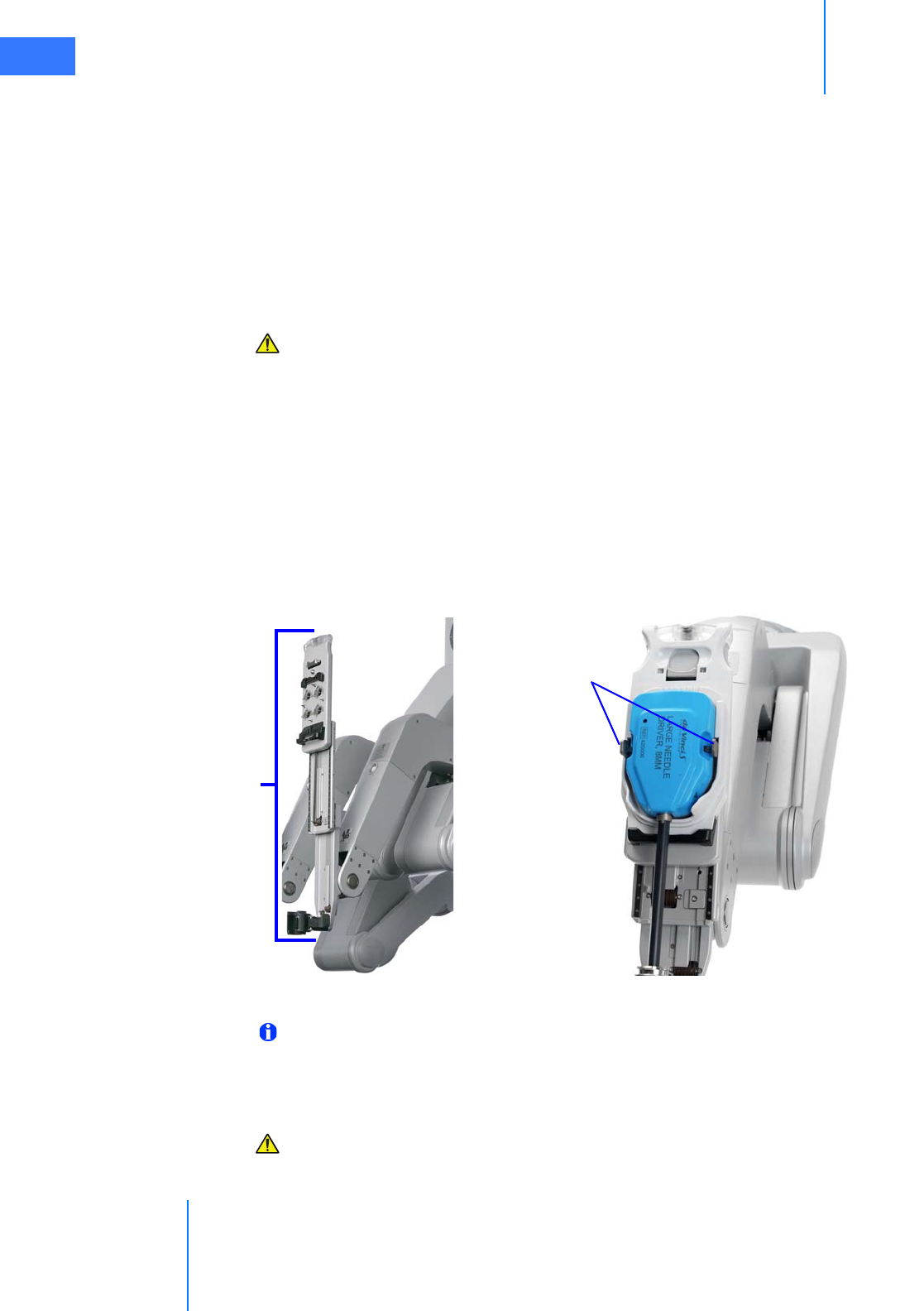
Patient Cart Use
da Vinci® Si™
9-12
DRAFT/PRE-RELEASE/CONFIDENTIAL
10/9/14
3. After surgery, thoroughly clean the instrument following the cleaning instructions from
the IFU before reuse.
In addition, if any blood or other fluid is observed on the inside of the drapes (on the
instrument arm), contact Intuitive Surgical Technical Support as soon as possible and before
any future use. Intuitive personnel will provide guidance in adequately cleaning the
instrument arm.
Instrument Removal
Before attempting to remove an instrument, make sure the surgeon is ready for it.
CAUTION: Removal of instruments during a procedure should be done very carefully
and only with the knowledge of and full view of the Surgeon Console operator. Do not
remove the instrument if it is not in view.
1. Before instrument removal, the Surgeon Console operator should do the following:
a. Ensure that the instrument tip is in view and is free of any patient anatomy.
b. Straighten the instrument wrist.
c. Clearly communicate to the patient-side assistant which instrument to remove.
Identify the name of the instrument or the number of the instrument arm (for
example, instrument arm 1, 2, 3).
2. Once the instrument is positioned for removal, the patient-side assistant should squeeze
the release levers on the sides of the instrument and pull the instrument out.
Figure 9.12 Telescoping axis and instrument release levers
Note: The instrument arm insertion axis will automatically retract when the instrument
is removed. If the instrument is not removed in time, the instrument sterile adapter may
re-engage the instrument during the insertion axis retraction. If this happens, simply
remove the instrument from the instrument arm.
CAUTION: Any lateral pressure on the instrument during removal may damage the
instrument.
Telescoping
insertion axis
Instrument
release
levers
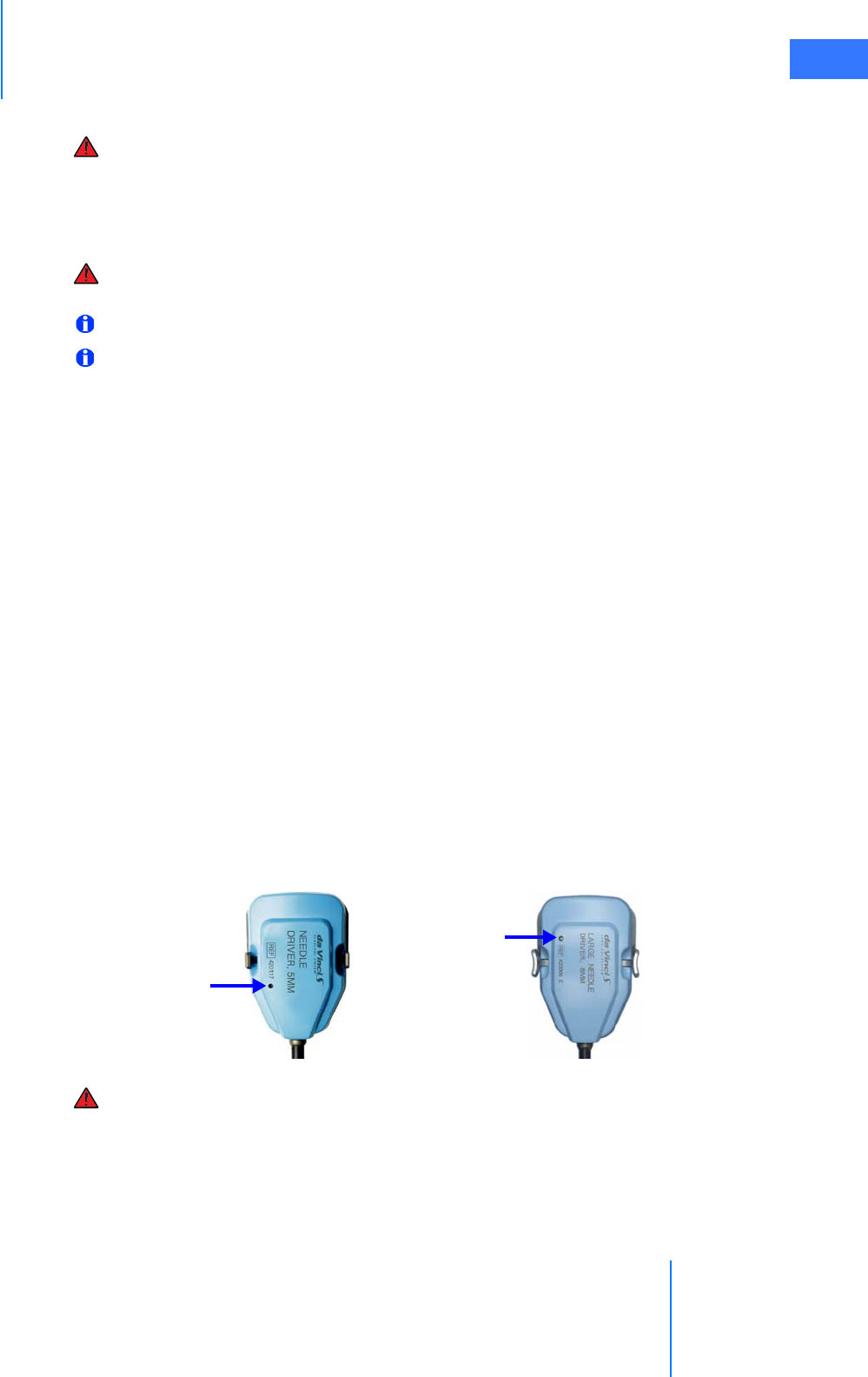
da Vinci® Si™
Patient Cart Use 9-13
DRAFT/PRE-RELEASE/CONFIDENTIAL
10/9/14
Grip Release
WARNING: Do not perform grip release on a non-faulted system without first pressing
the Emergency Stop button. Failure to observe this warning may result in unintended
instrument motion or damage to the grip release mechanism.
For additional information regarding the Emergency Stop button, see Right-Side Pod – Power
and Emergency Stop, on page 10-4 (Chapter 10, Surgeon Console Use).
WARNING: Rotating the grip release tool too far and/or in the incorrect direction can
cause unintended instrument motion or damage to the grip release mechanism.
Note: Whenever possible, use Surgeon Console control to release the instrument grips.
Note: The EndoWrist instrument release kit (PN 381199) includes a grip release tool
attached to illustrated instructions for quick-reference. Be sure to keep a sterile
instrument release kit in an accessible location.
The grip release mechanism facilitates removal of an instrument in the event of a system fault
or power failure. For example, if the instrument tips are gripping tissue, the grip release tool
allows the patient-side operator to manually open the grips.
To release the instrument grips manually, perform these steps while visualizing the surgical
site:
1. Press Emergency Stop on the right-side of the Surgeon Console.
2. Insert the grip release tool into the grip release socket on the instrument housing (Figure
9.13). Ensure that the tool engages with the socket. Once engaged, you will feel slight
resistance when you gently rotate the tool.
3. For 8 mm Clip Appliers and Harmonic instruments, carefully turn the grip release tool
clockwise (approximately 1/4th turn) to open the instrument grips. For other instruments,
carefully turn the grip release tool counter-clockwise (approximately 1/4th turn).
4. Under visualization, clear tissue from the grips. If needed, adjust the instrument arm to
position the instrument away from tissue: support the instrument arm before clutching,
to prevent unintended instrument motion.
5. Once tissue is cleared from the grips, remove the grip release tool from the instrument.
6. Squeeze the release levers on the sides of the instrument housing and pull the
instrument out. Do not reuse the instrument.
Figure 9.13 Grip release socket
WARNING: Do not reuse an instrument that has had its grip released with the instrument
release kit. Reusing an instrument after use of the instrument release kit could result in
critical failure of the instrument and injury to the patient.
After use of the instrument release kit, return the affected instrument to Intuitive Surgical by
contacting Technical Support. In the US, call 1-800-876-1310. International, call
+800.0821.2010 or +41 21.821.2020.
Grip release socket
Grip release socket
8 MM
5 MM

Patient Cart Use
da Vinci® Si™
9-14
DRAFT/PRE-RELEASE/CONFIDENTIAL
10/9/14
Intraoperative Instrument Care
Please follow these recommendations to ensure the EndoWrist instruments are kept at their
highest level of functionality:
• Clean the tips of instruments between instrument exchanges
• Do not use instruments to clean other instruments while inside the body
Instrument Usage
EndoWrist instruments are valid for a predetermined number of uses. We designed this feature
to help ensure reliable and consistent performance throughout the EndoWrist instrument life.
The system decrements one use from an instrument the first time it is installed and taken into
following mode during a procedure. While we design most instruments to be used for a
predetermined number of procedures, a few (such as the Large and Small Clip Appliers) we
design to be used for a predetermined number of activations.
Note: When an instrument’s life is based on activations, it usually has a relatively large
number of activations compared to instruments whose life is based on the number of
procedures it is used in. For these instruments, the system decrements one use from the
instrument each time it is installed on the system and goes into following mode.
View Remaining Uses
You can view the number of uses left for all instruments used during the current procedure by
accessing Inventory Management on the Utilities tab of the touchscreen (see page 7-20) or
the touchpad (see page 10-18).
• If an installed instrument is taken into following mode, the system decrements one use
for that instrument. If an installed instrument does not enter following mode, it may be
removed without reducing the number of uses remaining.
When you start to use an instrument that is on its last use, the system displays the message,
“Instrument will expire after procedure.” In this case, and when the Inventory Management
screen reports “0” remaining uses for an installed instrument, you still can use that instrument
during the current procedure, but not for a new procedure.
Expiration and Disposal
When instruments expire, they are automatically inactivated and can no longer be used.
Expired instruments must be properly disposed of following all applicable national and local
laws and guidelines.
9.5 Working with the Endoscope at the Patient Side
The Endoscope Assembly
The patient-side assistant is responsible for endoscope installation, insertion, removal and
intraoperative camera head maintenance. The operator must ensure that the endoscope is
handled with great care, as the instrument is very delicate and can be easily broken if dropped
or struck. For instructions to assemble and prepare the endoscope for use, see Setting Up the
Vision System on page 7-5.
The endoscope assembly consists of two main components:
•Endoscope: The interchangeable sterile endoscope
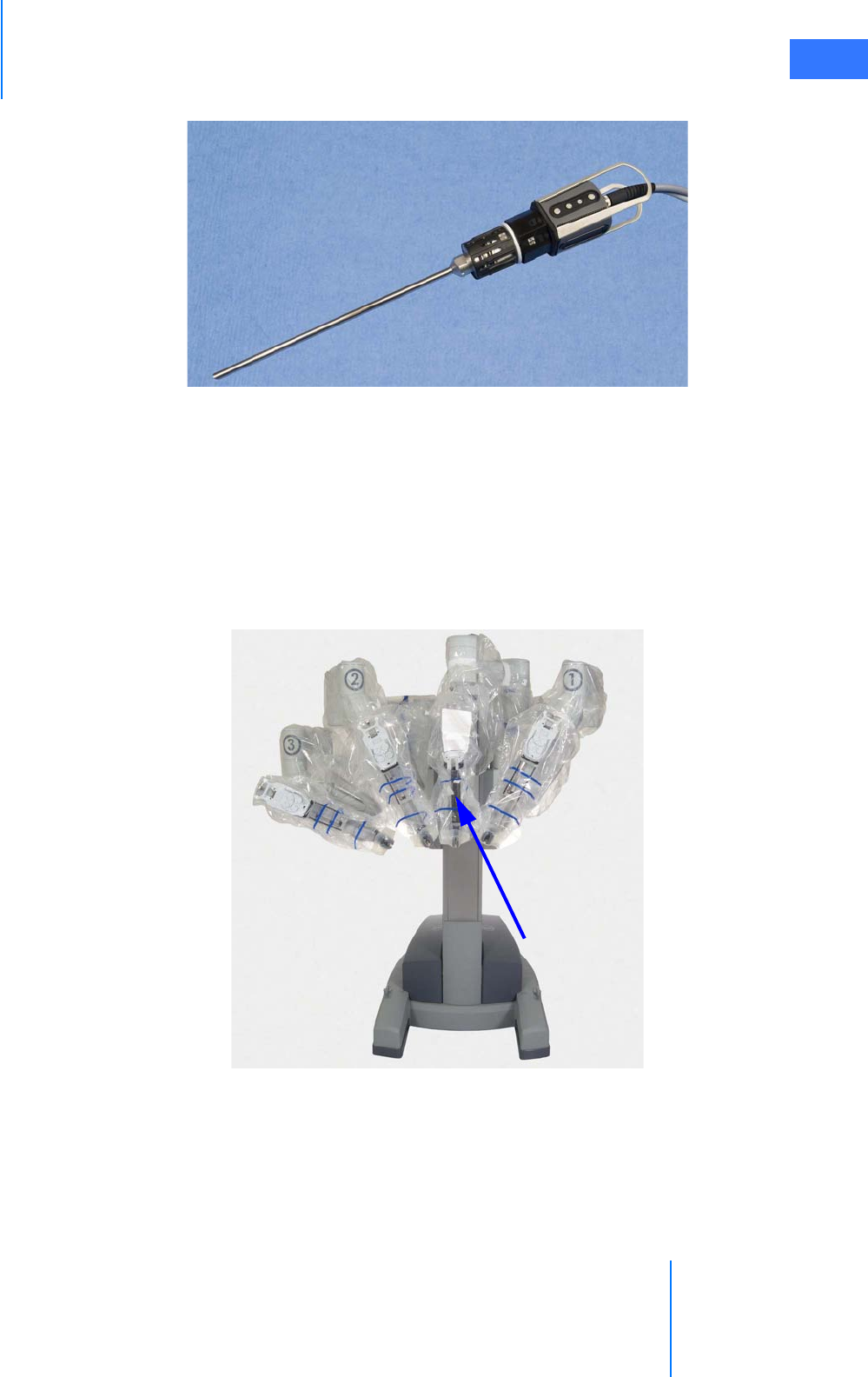
da Vinci® Si™
Patient Cart Use 9-15
DRAFT/PRE-RELEASE/CONFIDENTIAL
10/9/14
•Camera Head: The draped video capture device
Figure 9.14 Endoscope assembly
The endoscope interface of the camera arm consists of four parts:
•Insertion Axis: Delivers the endoscope to the surgical site.
•Camera Arm Sterile Adapter: Provides the point of connection for the endoscope to the
camera arm.
•Cannula Mount: Designed to hold the cannula securely in place
•Cannula: Provides the port through the body wall of the patient, through which the
endoscope is inserted.
Figure 9.15 Patient Cart showing endoscope interface location
Endoscope
interface
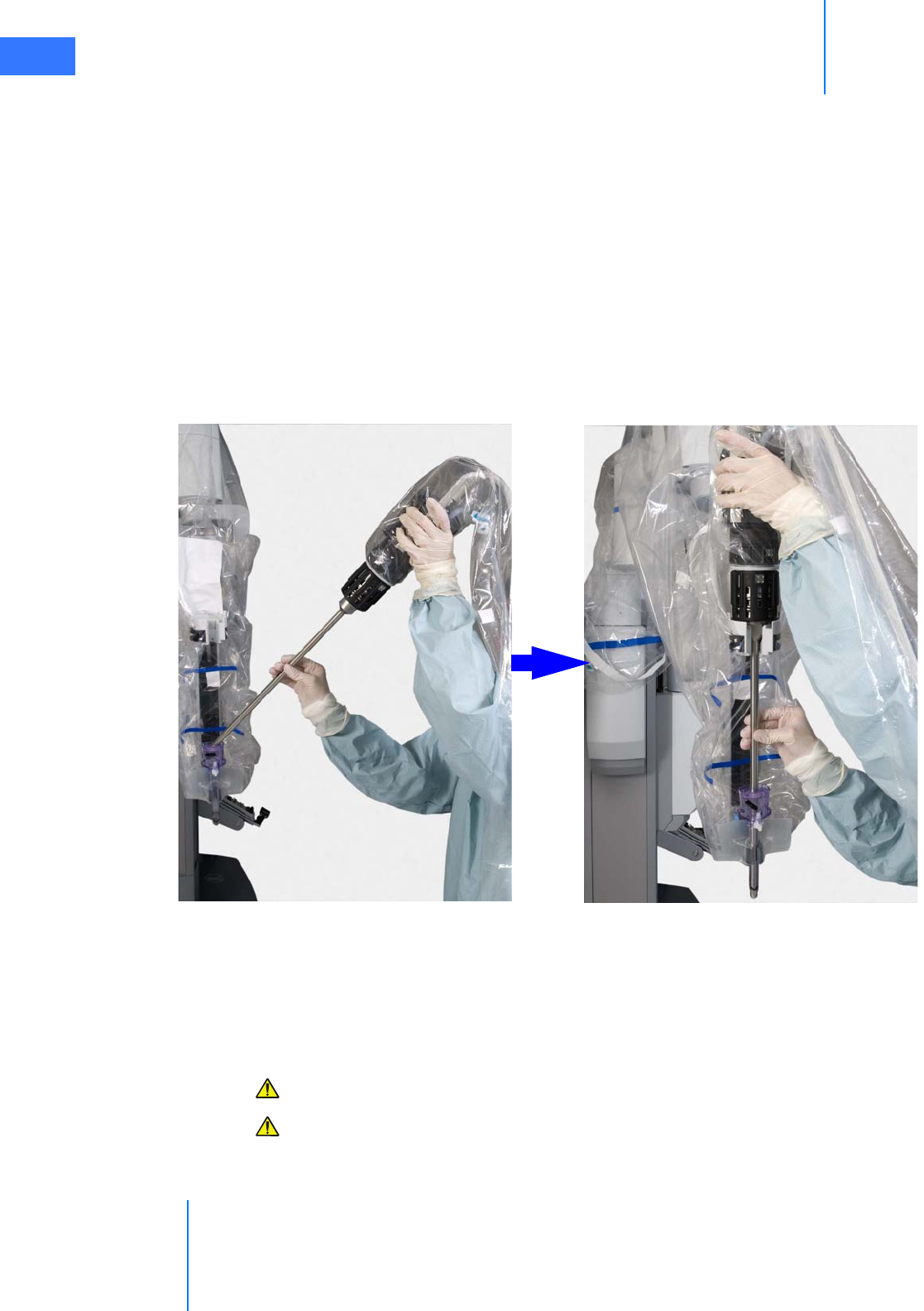
Patient Cart Use
da Vinci® Si™
9-16
DRAFT/PRE-RELEASE/CONFIDENTIAL
10/9/14
9.6 Endoscope Installation, Insertion, Removal and
Intraoperative Care
Preoperative Endoscope Care
Before use, ensure the endoscope tip is adequately heated to minimize fogging when
entering the surgical site. To heat the endoscope tip, dip it in a canister of heated sterile water.
Place a piece of sterile gauze at the bottom of the canister to prevent damage to the delicate
endoscope tip.
Installation
When the endoscope is ready to install on the camera arm, follow these steps:
1. Make sure the camera control buttons on the camera head are facing the tower of the
Patient Cart. Carefully insert the endoscope tip through the camera cannula.
Figure 9.16 Installing the endoscope on the camera arm
2. Align the scope with the insertion axis as you pass it through the camera cannula and
press the endoscope body into the camera arm sterile adapter. You will hear a click when
the endoscope body is pressed into the sterile adapter. Make sure the endoscope body is
fully engaged by gently pulling up on the endoscope. If properly engaged, the
endoscope will not disengage from the sterile adapter. Re-seat as necessary.
CAUTION: If not fully engaged, the endoscope may fall out.
CAUTION: To avoid possible thermal damage to the cannula, do not leave the
endoscope tip inside a plastic endoscope cannula for a prolonged period of time while
the lamp is on.
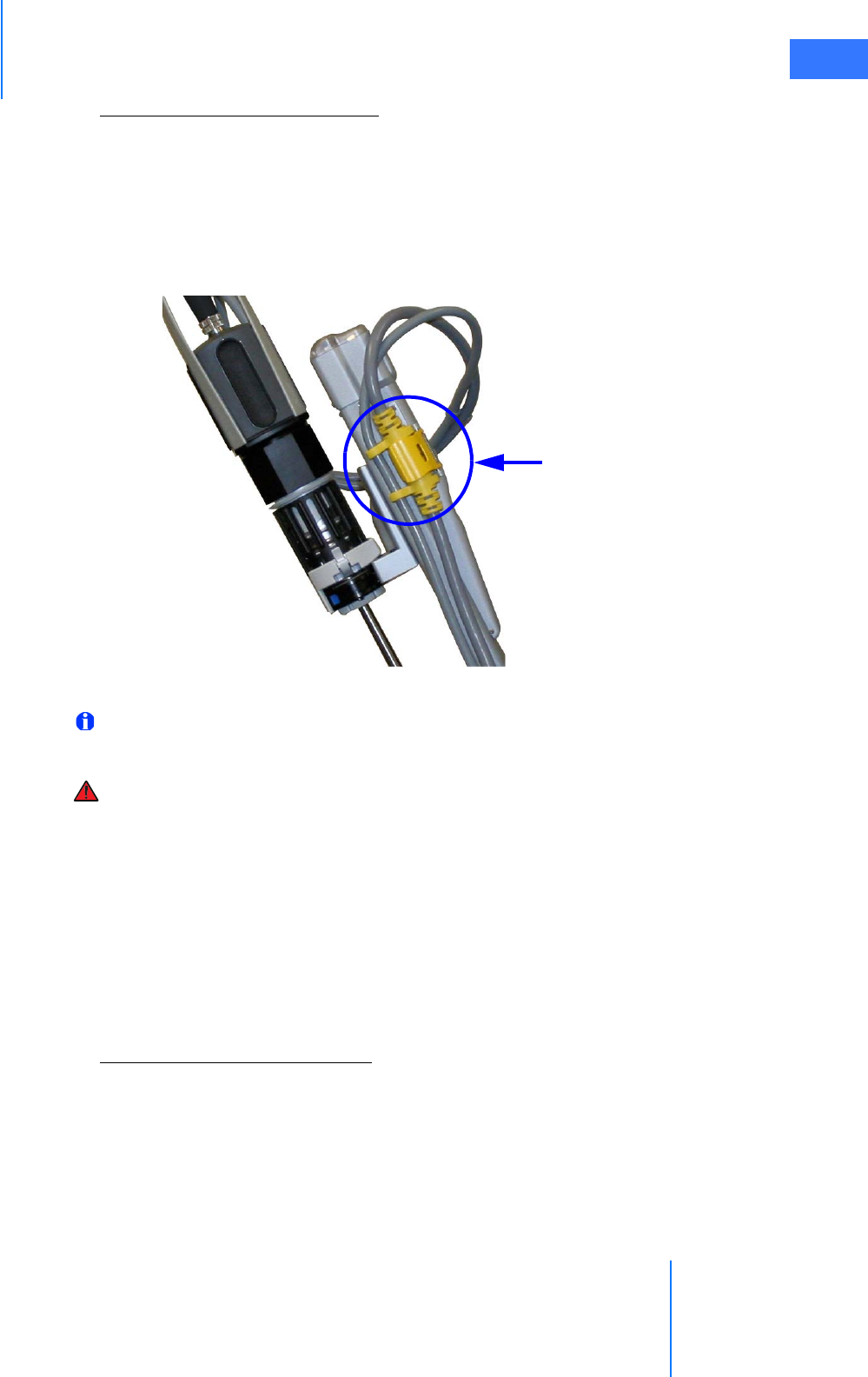
da Vinci® Si™
Patient Cart Use 9-17
DRAFT/PRE-RELEASE/CONFIDENTIAL
10/9/14
Confirm Live Image in Stereo Viewer
Each time you install an endoscope, and after changing view modes or settings during a
procedure, look in the stereo viewer to confirm a live image is present and has the desired
orientation. Adjust endoscope orientation as necessary. If no image is present, confirm the
lamp is on and at 100% intensity, as shown below. See section C.3 Basic Troubleshooting, page
C-5, for further troubleshooting if no image is present.
3. Connect the yellow portion of the camera cable to the strain relief support on the camera
arm.
Figure 9.17 Camera cable in strain relief support shown without sterile drapes
Note: Leave the cable attached to the strain relief support when working with the
camera head or endoscope assembly.
WARNING: The temperature of the distal tip of the endoscope may exceed 41°C during
use. Avoid contact with skin, tissue and clothing when the Illuminator is turned on and
the endoscope is outside the camera cannula, as damage may occur to skin, clothing
and equipment. Do not contact tissue with the endoscope nor attempt to clean the tip of
the endoscope by dipping it in tissue. The tissue can be damaged because of the heat,
and the tip of the endoscope may develop baked-on deposits which can decrease light
throughput.
Insertion
Once the endoscope is installed, use the camera arm clutch to manually guide it into the
patient’s body.
Intraoperative Endoscope Cleaning
As necessary due to fogging or smudging of the tip, remove the endoscope and wipe the tip
with a piece of moistened sterile gauze.
Removal
1. Release the camera head cables from the strain relief support.
2. Squeeze the release levers on either side of the camera arm sterile adapter and gently
pull the endoscope straight up and out of the cannula.
Strain relief support

Patient Cart Use
da Vinci® Si™
9-18
DRAFT/PRE-RELEASE/CONFIDENTIAL
10/9/14
Note: Intuitive recommends you wipe clean the tip of the endoscope immediately after
removing it, to prevent hardening of deposits that may be present.
Changing the Endoscope
WARNING: The connection point between the camera head and the endoscope can
become hot. Exercise caution when handling the endoscope.
The endoscope may be changed during a procedure. To change the endoscope, perform the
following steps:
1. Remove the endoscope from the camera arm as instructed above.
2. Remove the endoscope from the camera head.
3. Assembly is the opposite of disassembly. If using an angled endoscope, ensure the tip is
oriented correctly.
_________________________________End of section______________________________
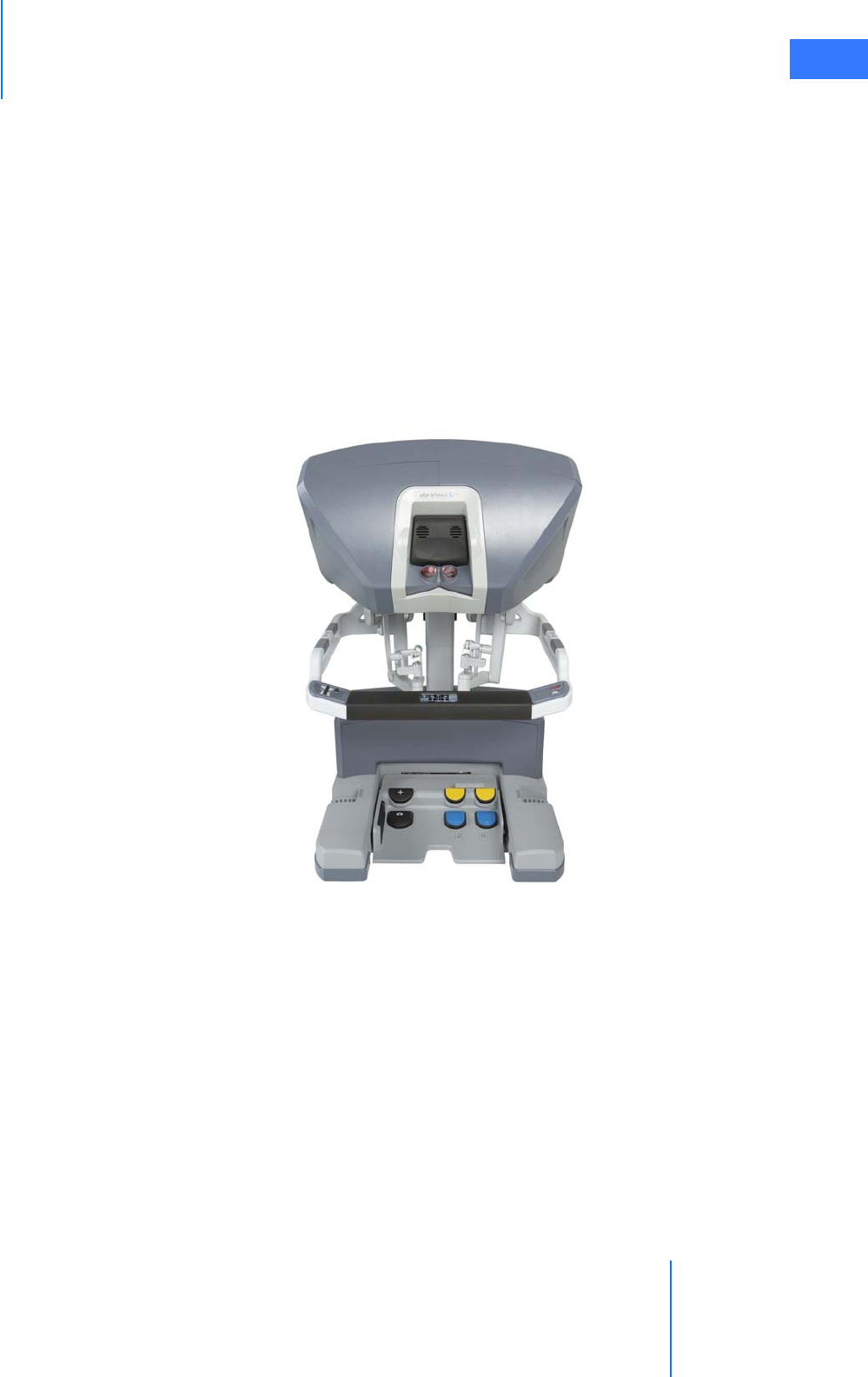
da Vinci® Si™
Surgeon Console Use 10-1
DRAFT/PRE-RELEASE/CONFIDENTIAL
10/9/14
10Surgeon Console Use
This chapter explains use of the da Vinci Si Surgeon Console during surgery. The following
subjects are covered:
•10.1 Surgeon Console Overview, page 10-1
•10.2 Setting up the Surgeon Console, page 10-5
•10.3 Touchpad Controls, page 10-11
•10.4 Surgical Controls, page 10-22
•10.5 Dual Console Surgery, page 10-39
Figure 10.1 Surgeon Console
10.1 Surgeon Console Overview
The Surgeon Console has six main components:
•Master Controllers (left and right), page 10-2
•Stereo Viewer, page 10-2
•Touchpad, page 10-3
•Left-Side Pod – Ergonomic Controls, page 10-4
•Right-Side Pod – Power and Emergency Stop, page 10-4
•Footswitch Panel, page 10-5
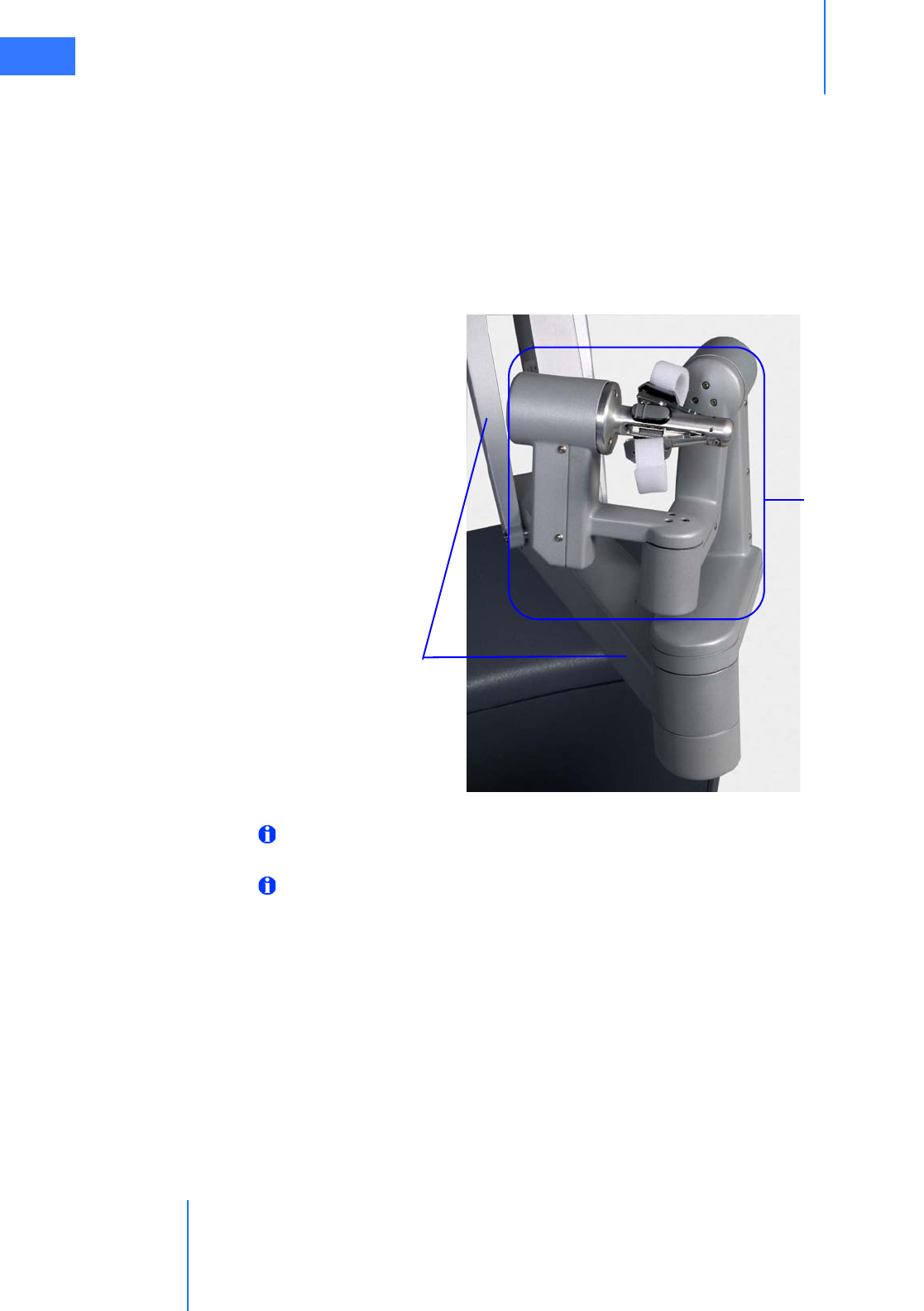
Surgeon Console Use
da Vinci® Si™
10-2
DRAFT/PRE-RELEASE/CONFIDENTIAL
10/9/14
Master Controllers
The master controllers (masters) enable the Surgeon Console operator to control the Patient
Cart instruments and endoscope. The masters have two main parts, an orientation platform
and a positioning arm.
• The orientation platform (Figure 10.2) rotates the instrument tips and opens and closes
the grips of the instruments.
• The positioning arm (Figure 10.2) moves the instrument in the surgical environment.
Positioning movements can be scaled to a 3:1 (Fine), 2:1 (Normal), or 1.5:1 (Quick) ratio.
Figure 10.2 Master controller
Note: If instruments cannot be manipulated in a precise and controlled manner contact
Intuitive Surgical Technical Support.
Note: If instrument motion appears to be non-intuitive, contact Intuitive Surgical
Technical Support immediately. In the US, call 1-800-876-1310, where phones are
staffed 24 hours a day, seven days a week. In Europe, call +41.21.821.2020.
For more information on use of the masters, see Matching Grips (page 10-22), Finger Clutch
(page 10-23), and the Surgical Controls section starting on page 10-22.
Stereo Viewer
The stereo viewer provides the video image to the Surgeon Console operator, the surgeon.
With his or her head in the viewer, the surgeon can view the 3D image in full-screen mode or
can choose to swap to TilePro™ mode, which displays the 3D image along with up to two
auxiliary images. Icons and text messages are overlaid on the video to provide extended
information to the surgeon. The system provides 2-way audio communications with the
Positioning
arm
Orientation
platform
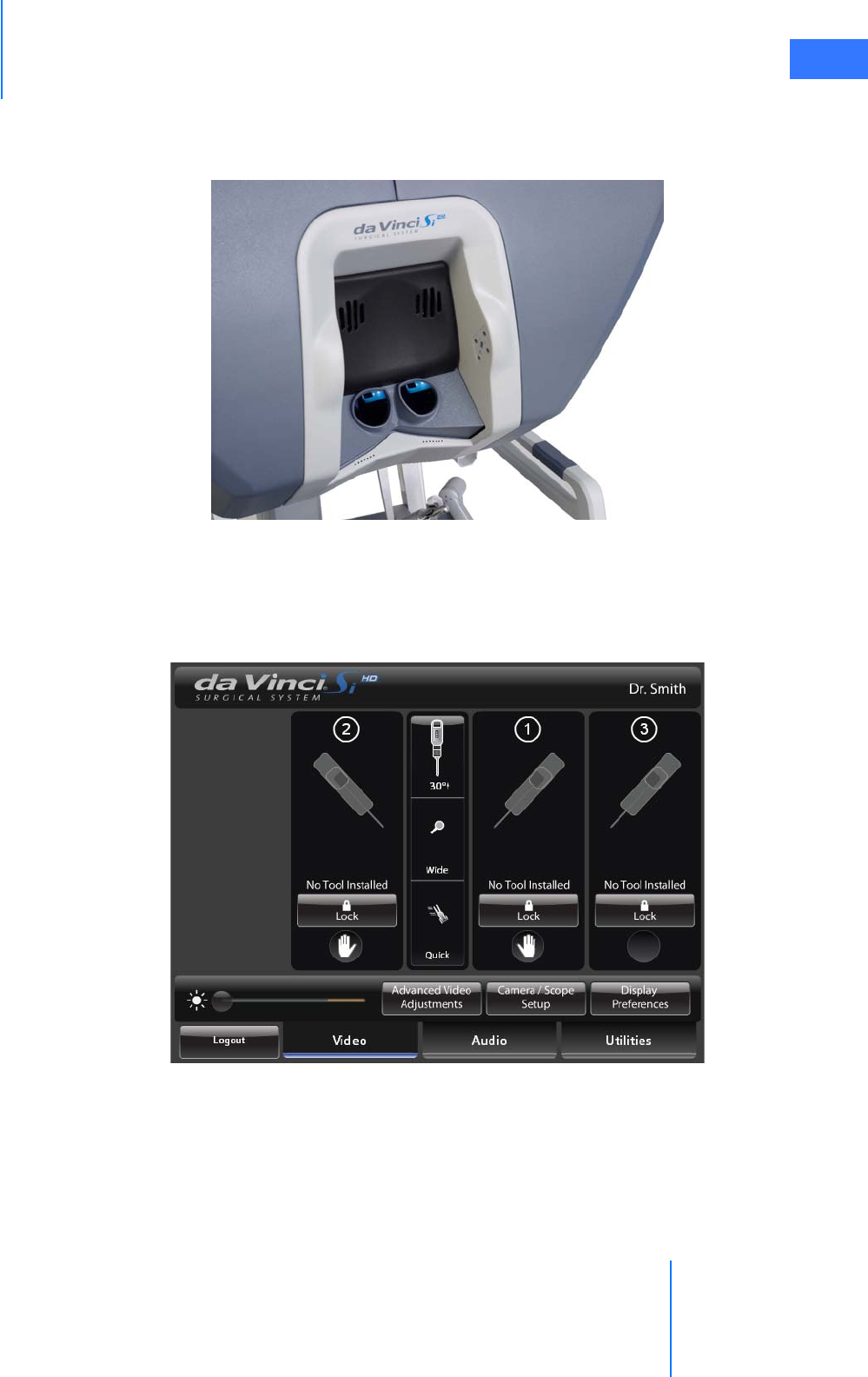
da Vinci® Si™
Surgeon Console Use 10-3
DRAFT/PRE-RELEASE/CONFIDENTIAL
10/9/14
Patient Cart operator by a microphone located under the viewport and a pair of speakers
located in the head rest. See Video (page 10-12) and Audio (page 10-17) for more information
on use and adjustment of the stereo viewer.
Figure 10.3 Stereo viewer
Touchpad
The touchpad is the main control interface of the Surgeon Console. Functional descriptions of
the specific controls are provided in the following section.
Figure 10.4 Touchpad (home screen)
For more information on use of the touchpad, see 10.3 Touchpad Controls on page 10-11.
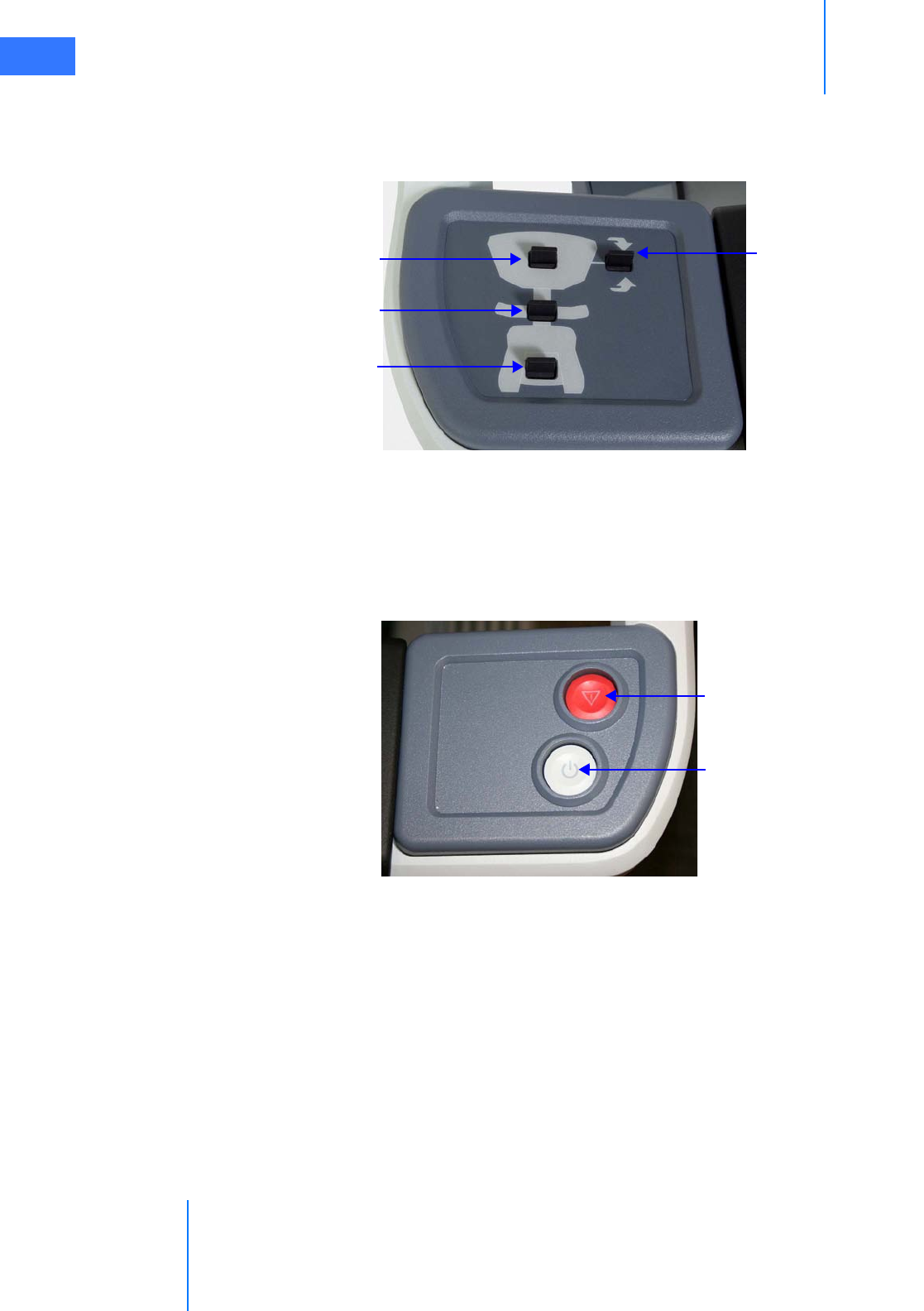
Surgeon Console Use
da Vinci® Si™
10-4
DRAFT/PRE-RELEASE/CONFIDENTIAL
10/9/14
Left-Side Pod – Ergonomic Controls
The left-side pod provides the ergonomic adjustment controls for the Surgeon Console, as
indicated below.
Figure 10.5 Left-side pod – ergonomic controls
For more detail on ergonomic adjustments, see Ergonomic Setup on page 10-10.
Right-Side Pod – Power and Emergency Stop
The right-side pod on the Surgeon Console provides Power and Emergency Stop buttons
(Figure 10.6).
Figure 10.6 Right-side pod
Press the red Emergency Stop button should it be necessary to stop system operation at any
time. The Emergency Stop button will cease robotic control of the instruments and
endoscope. The instruments and endoscope will stay in their last commanded position.
If the instrument grips are closed when the Emergency Stop button is pressed, the grips will
remain closed. However, the gripping force of the instrument may decrease.
Pressing Emergency Stop generates a recoverable fault, which can be cleared by pressing
Recover on the touchscreen or touchpad. The Emergency Stop button illuminates until the
fault is recovered.
Stereo viewer height
Armrest height
Footswitch panel
Stereo viewer tilt
depth
Emergency
Stop
Power
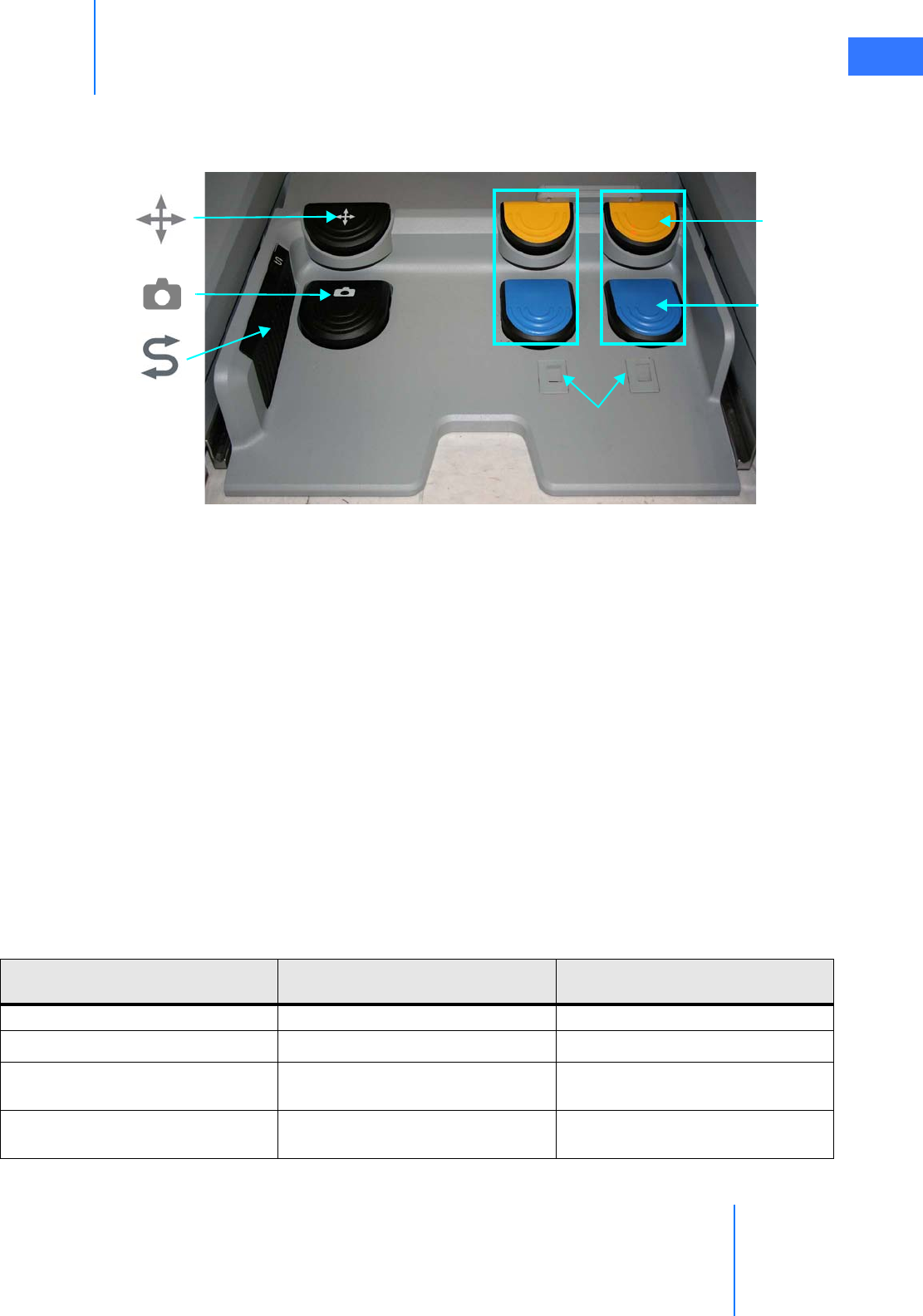
da Vinci® Si™
Surgeon Console Use 10-5
DRAFT/PRE-RELEASE/CONFIDENTIAL
10/9/14
Footswitch Panel
The footswitch panel allows the surgeon to control the camera, instruments, and ESU without
removing his or her head from the stereo viewer
Figure 10.7 Footswitch panel
For instructions to use the footswitch panel, see Footswitch Panel Use on page 10-24.
10.2 Setting up the Surgeon Console
This section explains how to set up the Surgeon Console for use.
Login and Settings
The da Vinci Si System provides enhanced ease of use by automatically saving your last set of
user-adjustable settings, such as your ergonomic settings, with your user name, and then
applying your preferences automatically when you log in. To enjoy this benefit, we
recommend you log in with your user name each time you use the Surgeon Console. (It is
possible to bypass login, in which case your preferences cannot be saved.)
For each of the settings in Table 10-1 below, the system saves the last selection made to the
current user profile, when a user is logged in. Table 10-2 lists settings not saved to a user
profile, but applied until changed again. For all settings, the second column reports whether
changes made on one Surgeon Console affect the other console when changes are made
while in dual console mode.
Arm
Swap
Camera
Control and Focus
Secondary
energy (yellow)
above
Primary
energy (blue)
below
Foot sensors
Master Clutch
Table 10-1 Settings Saved to the User Profile
Setting (options, default bold) Change affects other console when
made in dual console modea
For details, see
this section, on page
Ergonomic Settings No, local effect only Ergonomic Setup, page 10-10
Video Brightness (0-100) Yes, affects other consoleaVideo, page 10-12
Video Contrast (0-100) Yes, affects other consoleaAdvanced Video Adjustments, page
10-13
Video Saturation, Red & Yellow
(0-100) Yes, affects other consoleaAdvanced Video Adjustments, page
10-13
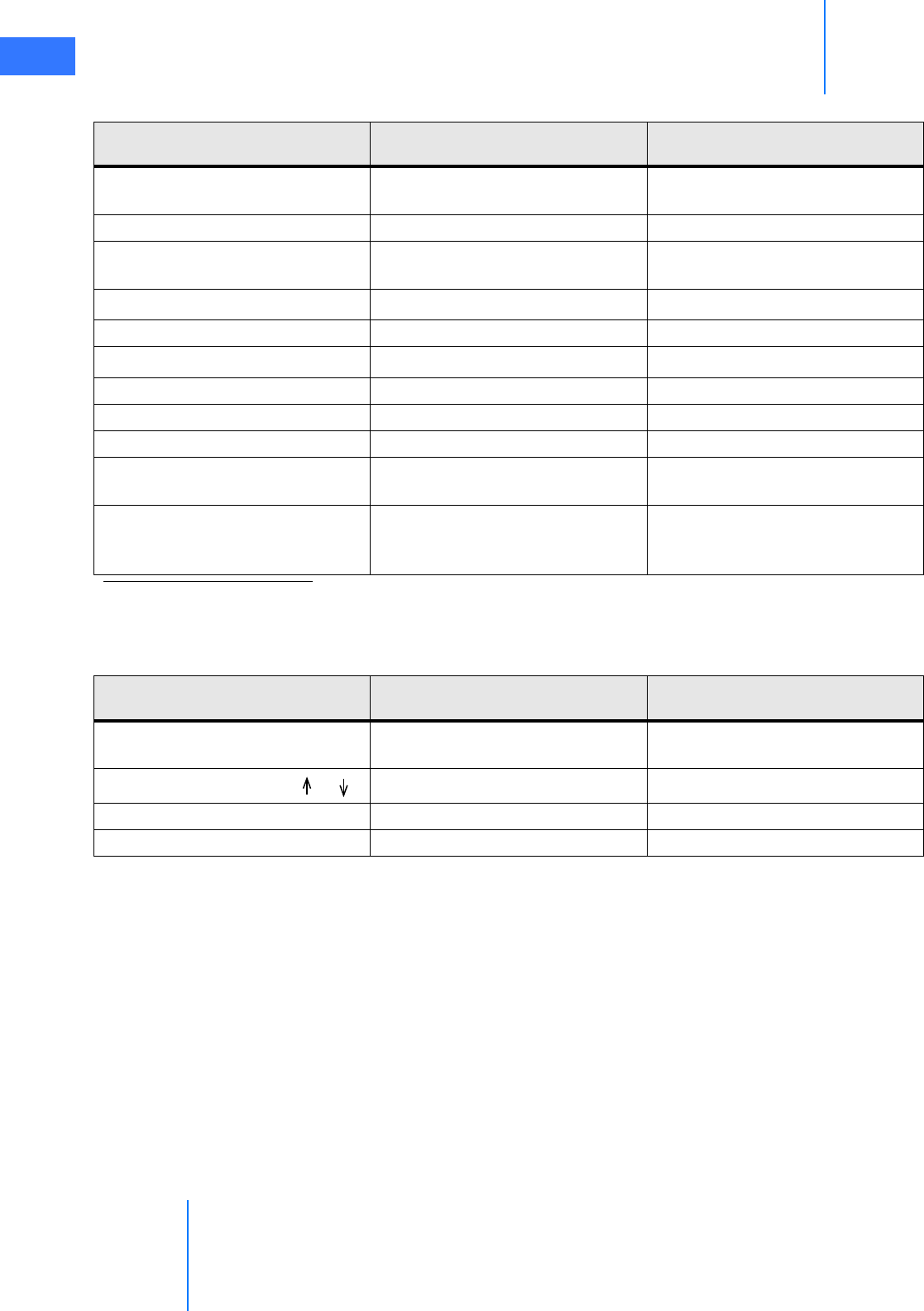
Surgeon Console Use
da Vinci® Si™
10-6
DRAFT/PRE-RELEASE/CONFIDENTIAL
10/9/14
Video Edge Enhancement (0-100) Yes, affects other consoleaAdvanced Video Adjustments, page
10-13
Digital Zoom (Wide/Full/2x/4x) No, local effect only Display Preferences, page 10-15
TilePro (Off/2D/3D, and
TilePro window sizing slider)
No, local effect only Display Preferences, page 10-15
Telestration Eye (L/R)Yes, affects other consoleaDisplay Preferences, page 10-16
Image Depth (Normal/Far) No, local effect only Display Preferences, page 10-16
Image Enhancement (On/Off) Yes, affects other consoleaDisplay Preferences, page 10-16
Finger Clutch (On/Off ) No, local effect only Control Preferences, page 10-20
TilePro QuickClick (On/Off) No, local effect only Control Preferences, page 10-20
Haptic Zoom (On/Off) No, local effect only Control Preferences, page 10-20
Motion Scaling (from masters to
instruments, Quick/Normal/Fine)
No, local effect only Control Preferences, page 10-20
Disable SmartPedal Notification
screen (present on login and
unlock)
No, local effect only On SmartPedal Notification screen,
before surgeon login
a. Changes that affect video image display also affect video output to the touchscreen and to the Video
Out Aux bay of video output ports on the Core.
Table 10-1 Settings Saved to the User Profile
Setting (options, default bold) Change affects other console when
made in dual console modea
For details, see
this section, on page
Table 10-2 Settings Not Saved to a User Profile
Setting (options, default bold) Change affects other console when
made in dual console mode
For details, see
this section, on page
Illuminator Light Output (0-100) Yes, affects other console Advanced Video Adjustments, page
10-13
Scope Angle (0 degrees/30 /30 )Yes, affects other console Camera / Scope Setup, page 10-14
Stereo Viewer Mode (2D/3D)No, local effect only Display Preferences, page 10-16
Master Associations (Configure) Yes, affects other console Control Preferences, page 10-21
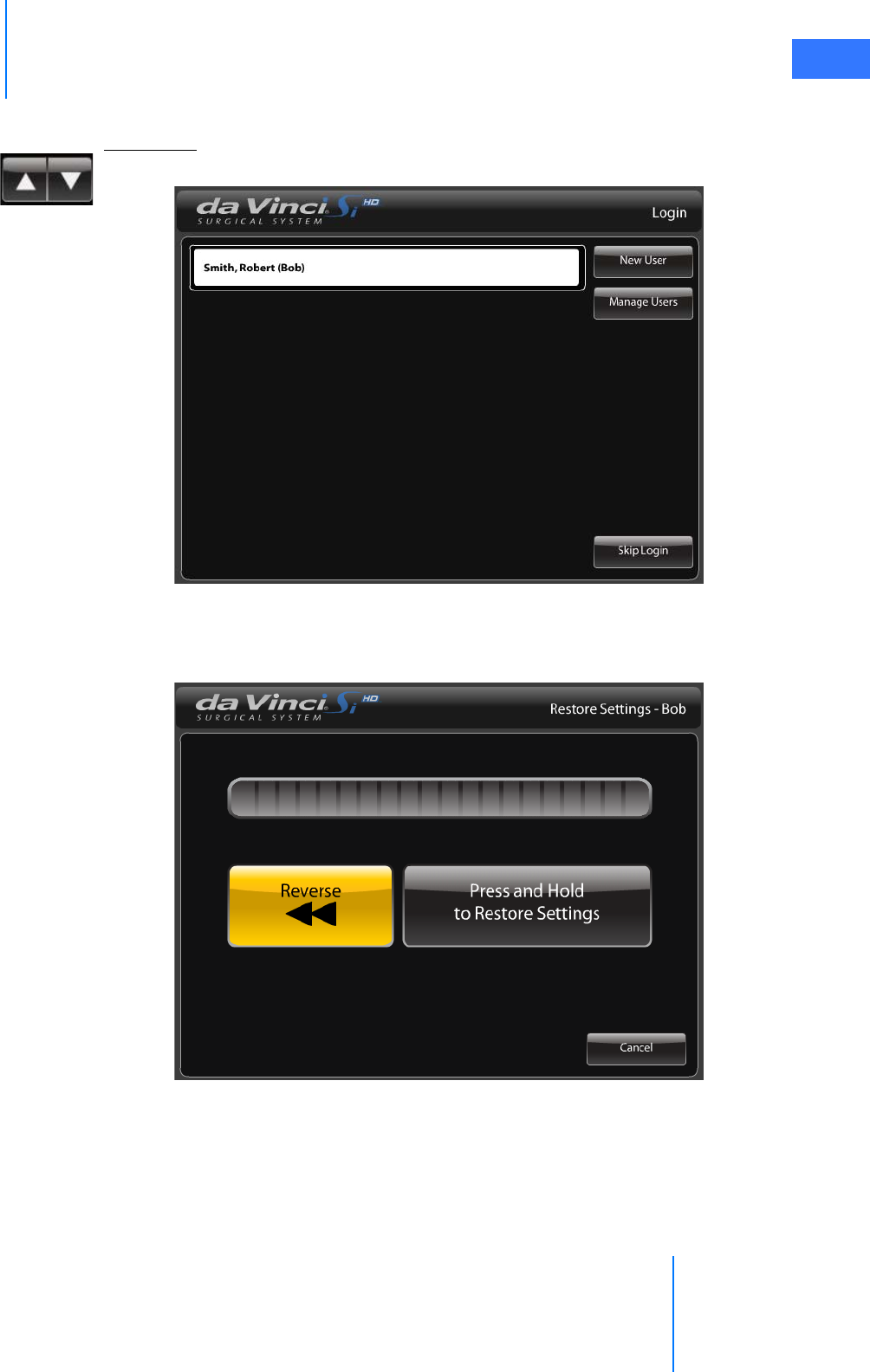
da Vinci® Si™
Surgeon Console Use 10-7
DRAFT/PRE-RELEASE/CONFIDENTIAL
10/9/14
Follow these steps to log in:
Repeat User
If you already have a user name, touch it to log in. Scroll using the arrow keys if necessary.
Figure 10.8 Login screen
When you select the user name, the touchpad notifies you by the following screen that the
ergonomic adjustment axes of the Surgeon Console will move:
Figure 10.9 Restore ergonomic settings
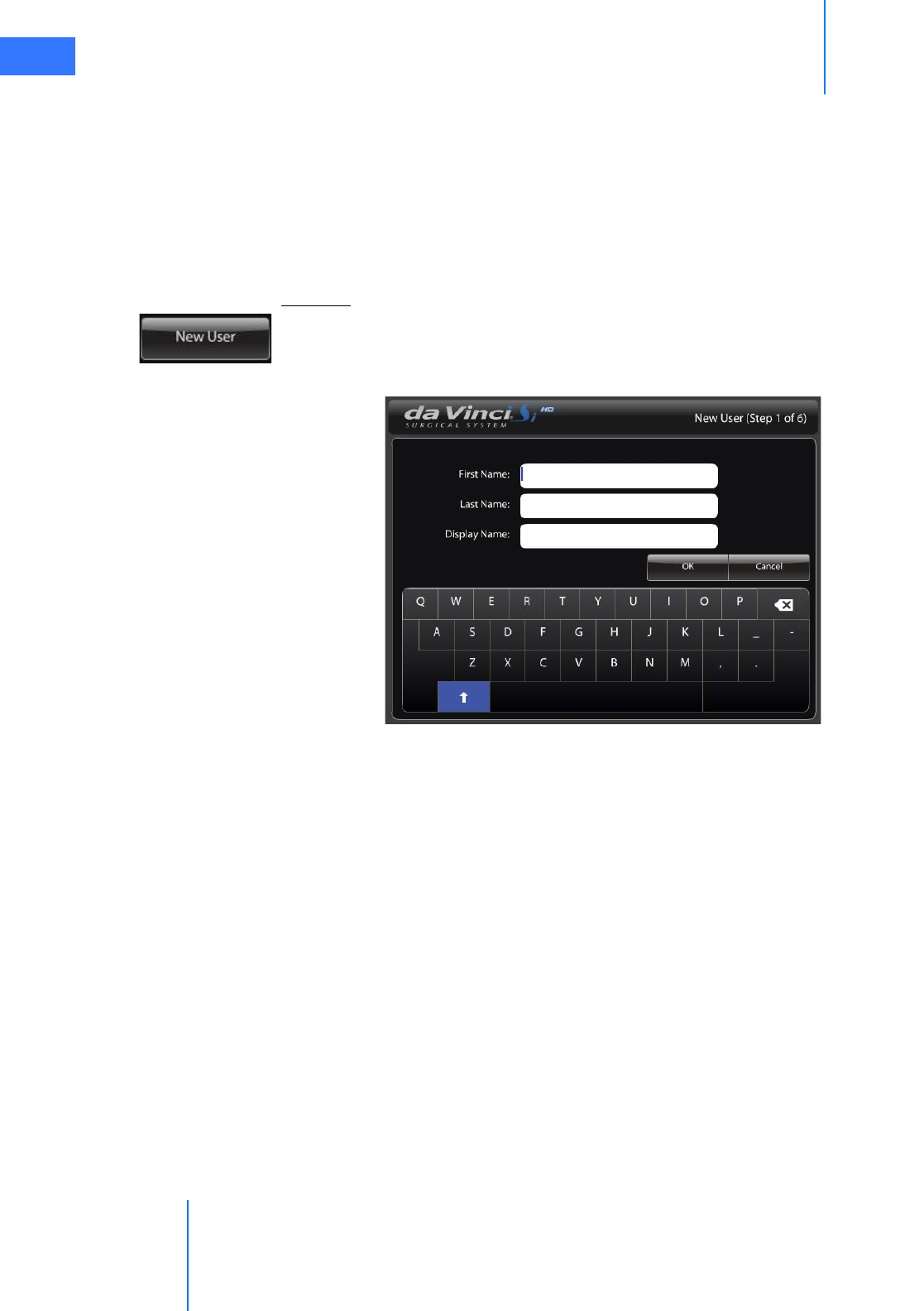
Surgeon Console Use
da Vinci® Si™
10-8
DRAFT/PRE-RELEASE/CONFIDENTIAL
10/9/14
Make sure persons and objects are clear of the Surgeon Console and, as the button says, Press
and Hold to Restore Settings. A blue bar indicates progress as the Surgeon Console applies
the last ergonomic settings for this user. If you press and hold the Reverse button, the
Surgeon Console reverses its movement, and the progress bar backs up. If you release either
button, movement stops, as does the progress bar. Press and hold the desired button again to
resume movement in that direction. When you finish restoring settings, the Restore Settings
screen closes automatically and the touchpad home screen appears (see Figure 10.13, page
10-11). (Touch Cancel at any time to login with the current ergonomic settings.)
New User
If you have not logged in to the system before, setup a user account like this:
1. Touch the New User button located on the login screen of the touchpad. The New User
(Step 1 of 6) screen appears.
Figure 10.10 New User (Step 1 of 6) screen
2. Enter your name using the touchpad keyboard and touch OK.
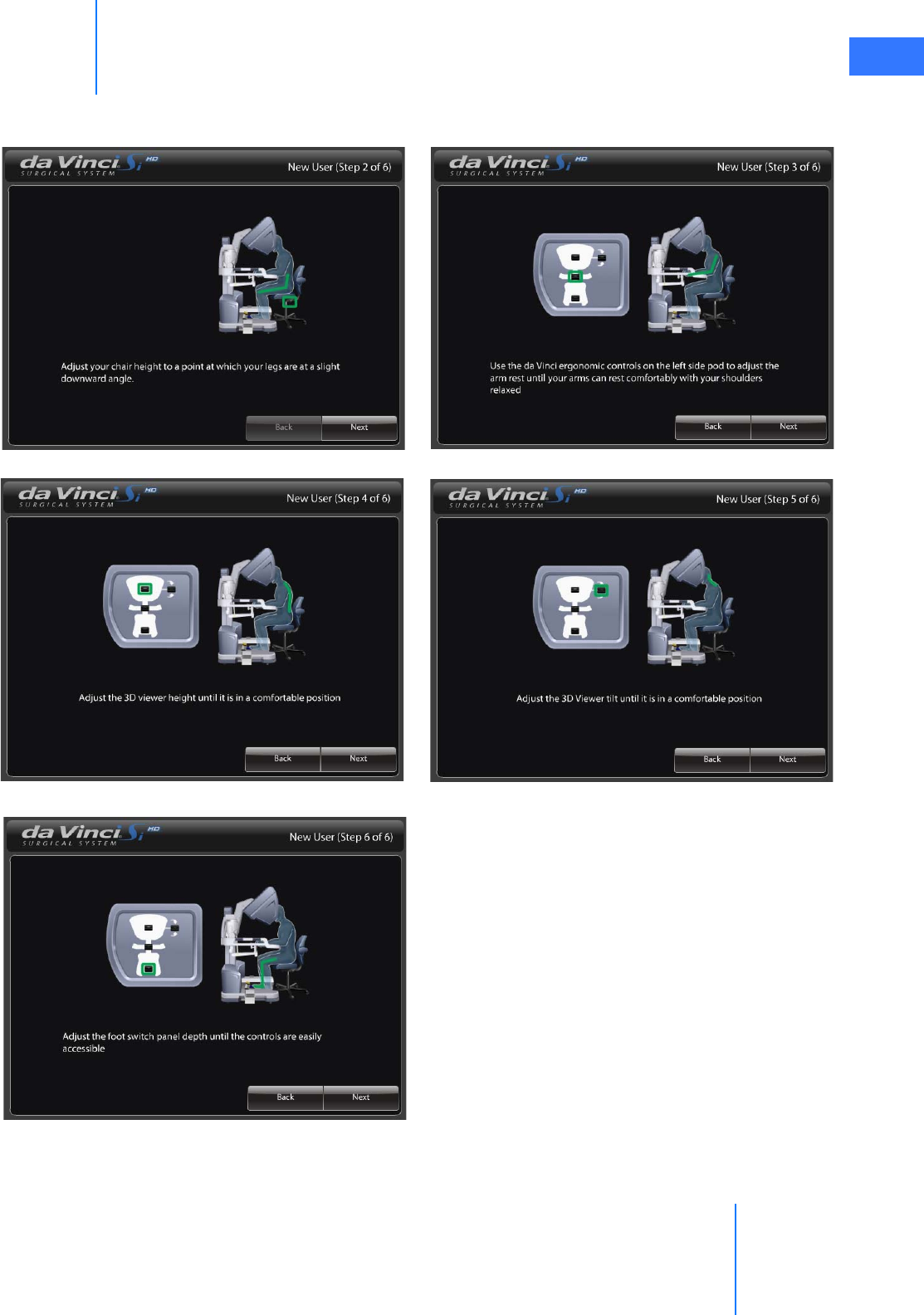
da Vinci® Si™
Surgeon Console Use 10-9
DRAFT/PRE-RELEASE/CONFIDENTIAL
10/9/14
Now the system walks you through ergonomic setup. This is required only one time,
when creating a new account. The following New User screens appear in order.
Figure 10.11 New User ergonomic setup screens
Step 2: Adjust chair height Step 3: Adjust armrest height
Step 4: Adjust viewer height Step 5: Adjust viewer tilt
Step 6: Adjust foot switch panel depth
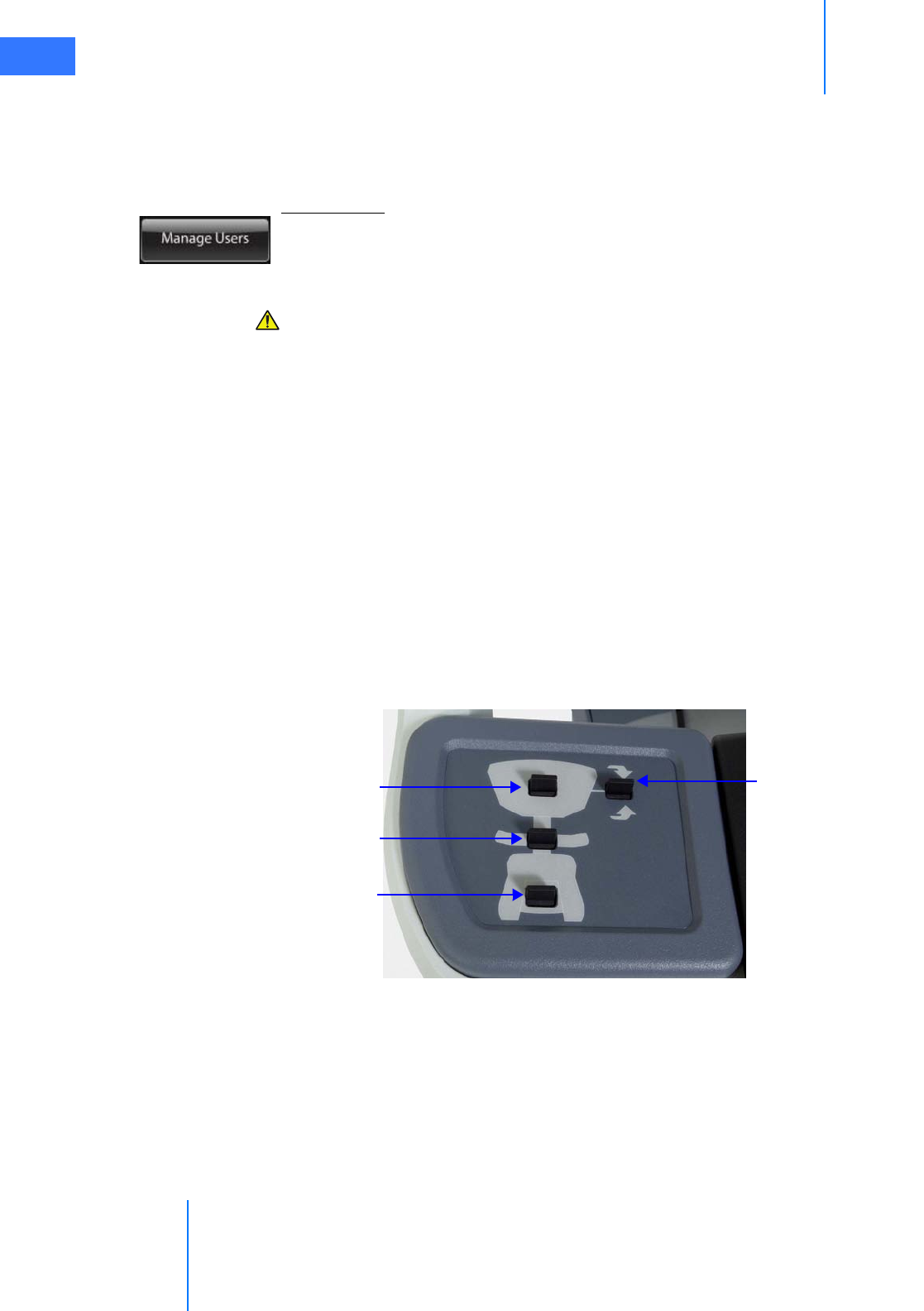
Surgeon Console Use
da Vinci® Si™
10-10
DRAFT/PRE-RELEASE/CONFIDENTIAL
10/9/14
You are now logged in. Once logged in, the system saves to your profile any changes you
make to the system configuration, like ergonomic settings, and then applies your profile
automatically each time you log in again. To logout, touch the Logout button in the lower left
corner of the home screen.
Manage Users
Touch Manage Users to access the Manage Users screen, where you can delete users.
Ergonomic Setup
CAUTION: Before adjusting ergonomic controls on the Surgeon Console, make sure
there is adequate room for the components to move.
Once logged in, the system saves to your profile any changes you make to the system
configuration, like ergonomic settings, and then applies your profile automatically each time
you log in again. To adjust the Surgeon Console ergonomics to your preference, perform the
following steps:
1. Adjust the chair height so your thighs are at a slightly downward angle relative to the
floor. This ensures easy movement of the legs to activate the footswitches.
2. Adjust the armrest height so your forearms rest comfortably on the armrest with your
shoulders relaxed (Figure 10.12).
3. Adjust the stereo viewer height to your preference (Figure 10.12).
4. Adjust the stereo viewer tilt according to your preference (Figure 10.12). Tilting up allows
for a more comfortable neck angle. Tilting down allows for more alignment of your hands
and the instruments in the stereo viewer.
5. Adjust the footswitch panel depth to your preference (Figure 10.12).
Figure 10.12 Left-side pod adjustments
Stereo viewer height
Armrest height
Footswitch panel
Stereo viewer tilt
depth
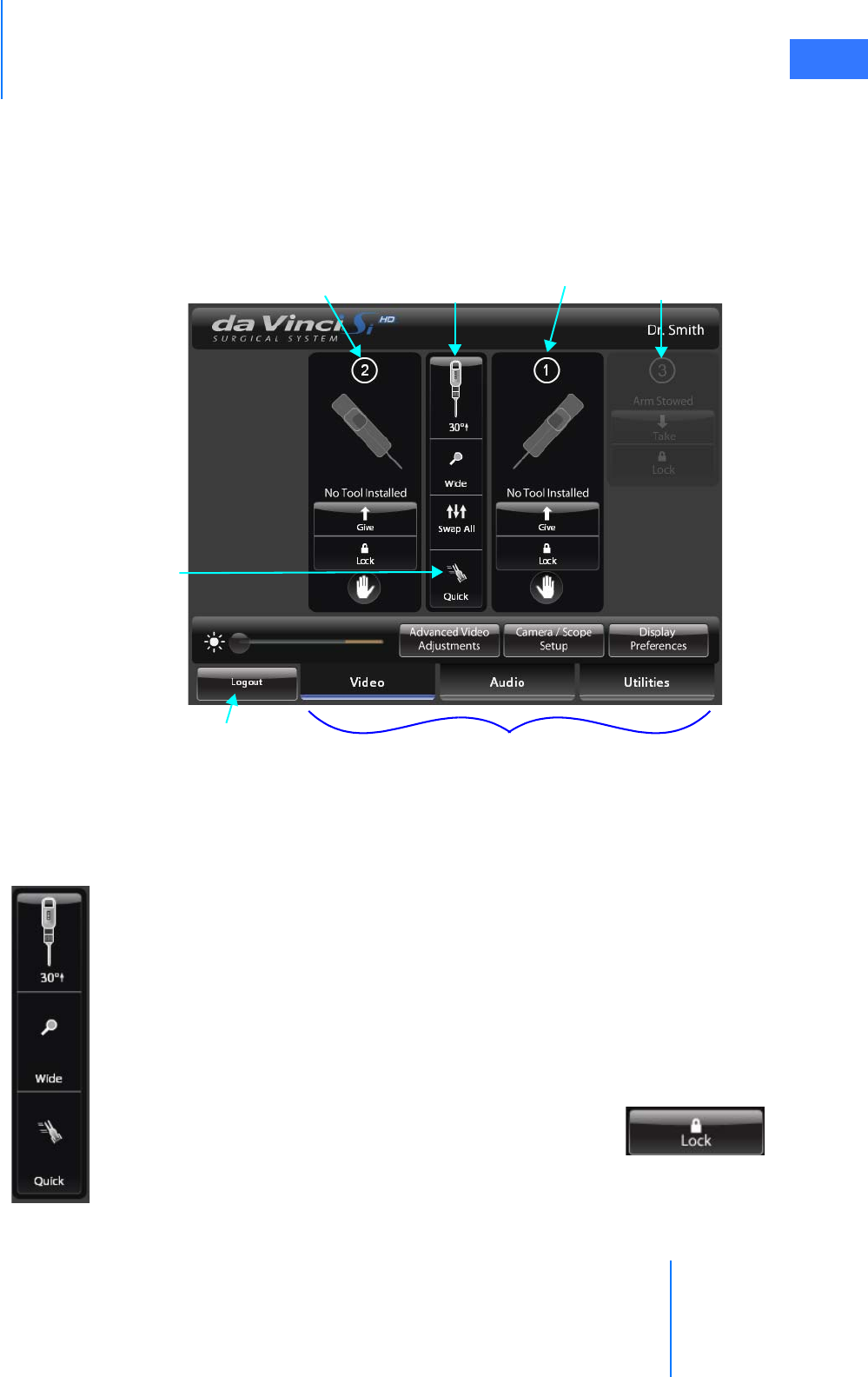
da Vinci® Si™
Surgeon Console Use 10-11
DRAFT/PRE-RELEASE/CONFIDENTIAL
10/9/14
10.3 Touchpad Controls
Overview
The touchpad home screen provides system status, including instrument arms, camera arm,
and energy controls. In dual console mode, it also enables you to give or take control of
instrument arms (see Dual Console Surgery on page 10-39).
Figure 10.13 Touchpad home screen
• In general, as for the touchscreen menus:
• Grayed-out items are not active or unavailable in the current context. Observe that
Arm 3 is stowed and not available for use in Figure 10.13.
• Items highlighted blue are selected.
•Quick Settings Buttons: Three quick settings buttons run down the center of the screen.
From top to bottom, the buttons indicate current settings for scope angle, zoom level (in
the stereo viewer) and motion scaling. Touching these opens the associated settings
screen, where you can adjust:
•Camera / Scope Setup, see page 10-14
• Zoom level, as in Display Preferences, see page 10-15
•Control Preferences, see page 10-20
•Lock: Touch Lock to lock an arm’s position and prevent
accidental switching to an instrument arm that is performing a
static function (for example, retracting or stabilizing tissue). When
an instrument arm is locked, it maintains its position. The lock
button is highlighted blue when selected, indicating it is locked. You must touch Lock
again to enable control of the arm.
Scope status,
angle, zoom Arm 3 status
Arm 1 status
Arm 2 status
Login/Logout Function tabs
Motion scaling
setting
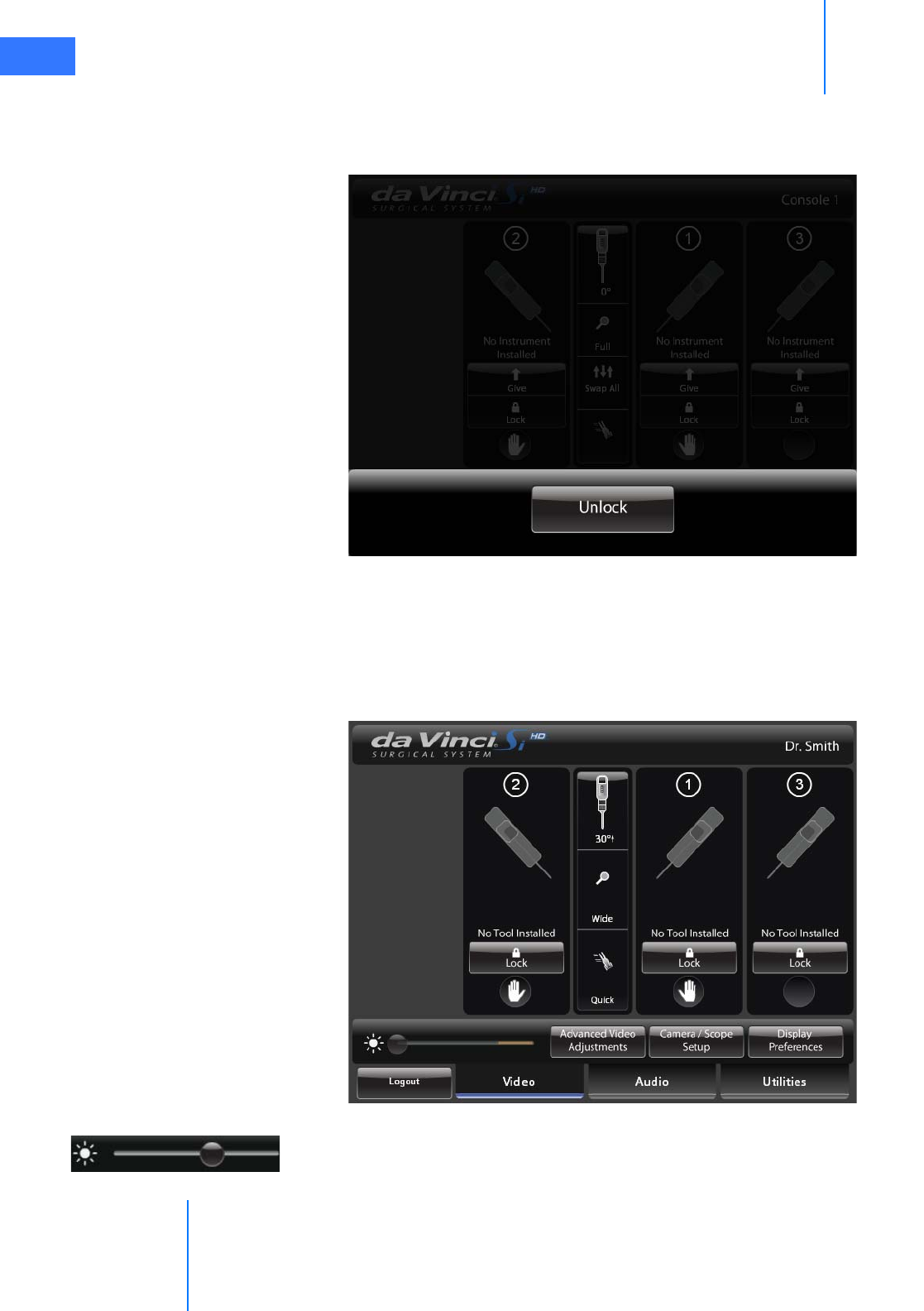
Surgeon Console Use
da Vinci® Si™
10-12
DRAFT/PRE-RELEASE/CONFIDENTIAL
10/9/14
Unlock Touchpad
When the surgeon takes instruments into following mode, the touchpad automatically locks,
to prevent inadvertent actions.
Figure 10.14 Touchpad locked
Touch Unlock to access the touchpad again.
Video
The Video tab provides quick access to the brightness adjustment as well as Advanced Video
Adjustments, Camera/Scope Setup and Display Preferences.
Figure 10.15 Video tab
•Brightness: Drag the Brightness slider (sun icon at lower left) to adjust video brightness
(not actual illumination) in the stereo viewer. Brightness increases to the right.
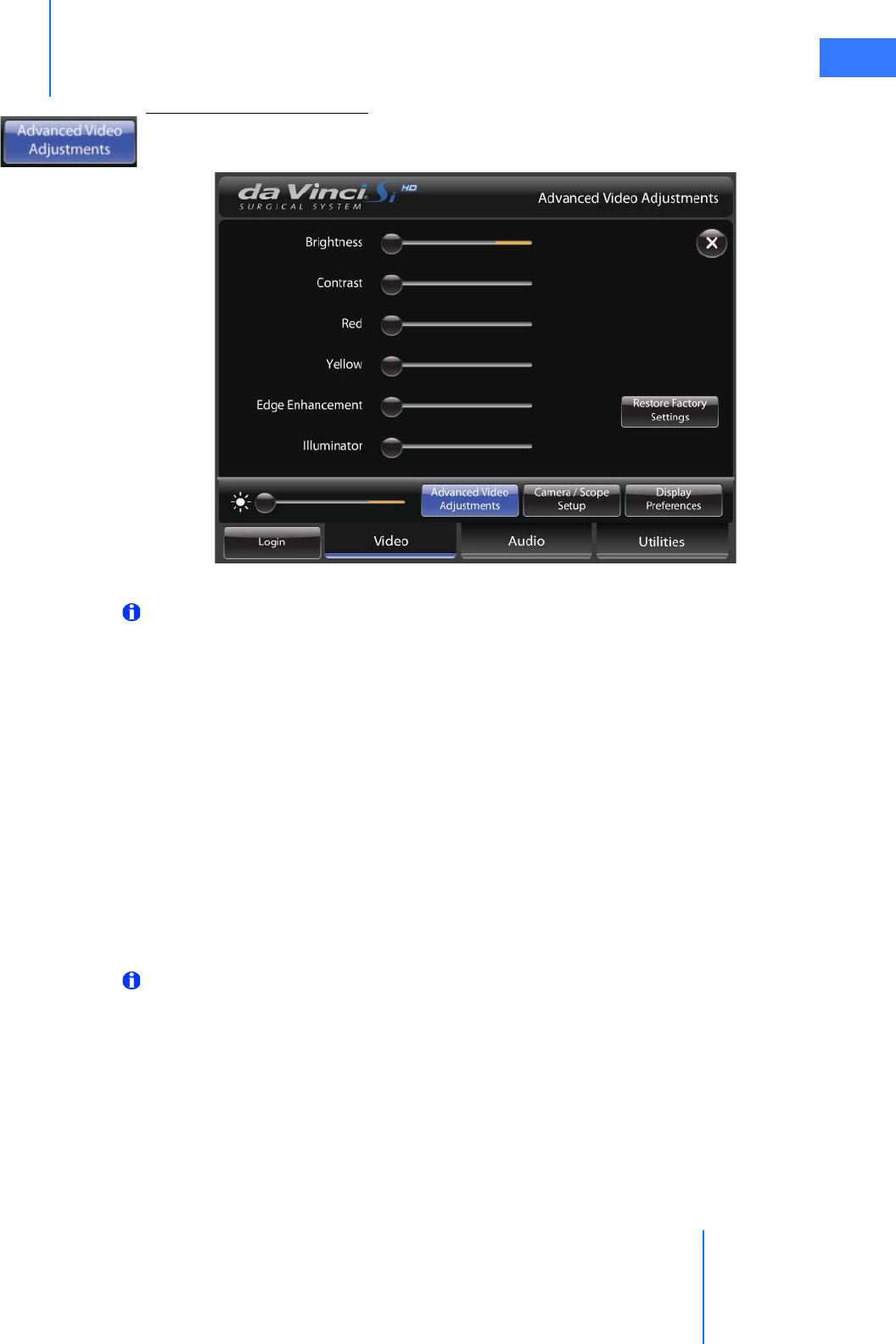
da Vinci® Si™
Surgeon Console Use 10-13
DRAFT/PRE-RELEASE/CONFIDENTIAL
10/9/14
Advanced Video Adjustments
Touch Advanced Video Adjustments to adjust the Advanced Video settings of the surgical
image.
Figure 10.16 Advanced Video Adjustments
Note: The specific adjustment of these settings is a matter of surgeon preference. Like
any adjustable video image, you may observe that some settings affect others, with the
result that a specific combination of settings may represent a tradeoff, for example,
between glare in one part of the image and enhanced visibility in another part. Keep in
mind that you can readjust these settings at any time.
•Brightness: Drag the slider to adjust the brightness of the surgical image. This is video
brightness, as opposed to actual illumination.
•Contrast: Drag the slider to adjust the contrast of the surgical image.
•Red: Drag the slider to adjust the red of the surgical image.
•Yellow: Drag the slider to adjust the yellow of the surgical image.
•Edge Enhancement: Drag the slider to adjust the edge enhancement of the surgical
image. Increasing edge enhancement (slider to the right) may also increase noise.
•Illuminator: Drag the slider to adjust the actual light output transmitted to the surgical
field in 10% increments.
Note: To minimize fogging, maintain heating of the endoscope tip by setting the
Illuminator intensity to 100% and adjust the brightness of the surgical image using the
Illumination slider on the touchpad or touchscreen under Advanced Video Adjustments.
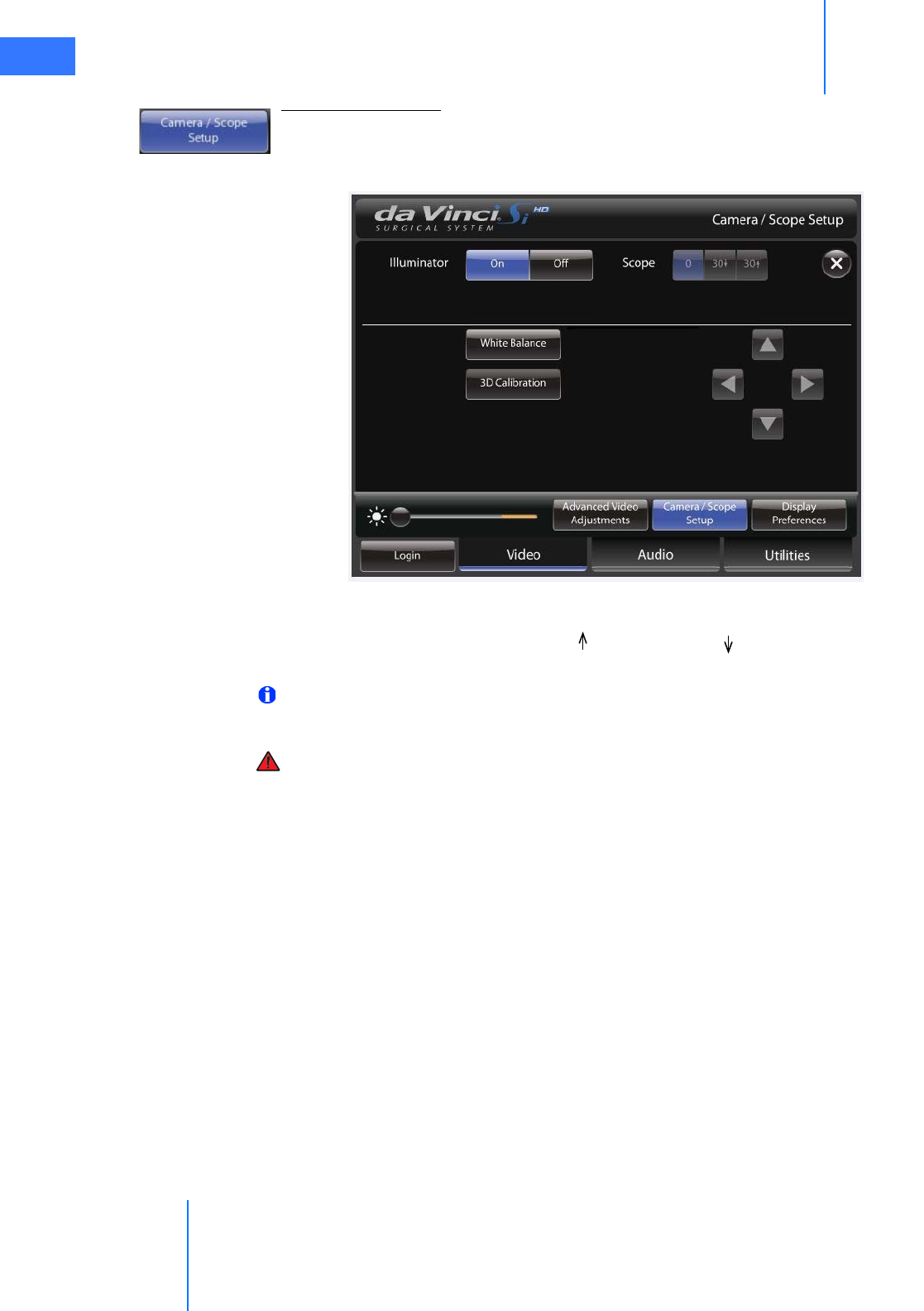
Surgeon Console Use
da Vinci® Si™
10-14
DRAFT/PRE-RELEASE/CONFIDENTIAL
10/9/14
Camera / Scope Setup
Touch Camera / Scope Setup to setup the camera head and endoscope from the Surgeon
Console. This is equivalent to setup using the touchscreen and/or camera head (see Camera /
Scope Setup from the Camera Head on page 7-7)
Figure 10.17 Camera / Scope Setup
•Scope Angle: You can specify the scope angle by touching the corresponding button: 0
(degrees, for straight endoscopes), 30 (degrees up) or 30 (degrees down) for angled
endoscopes.
Note: When a new scope angle is selected, the system realigns the master controllers to
match the instrument tip orientation and position.
WARNING: If the wrong scope angle is manually selected, instrument motion may
appear non-intuitive.
•White Balance: Touch to perform white balance.
•3D Calibration: Touch to calibrate the camera/scope assembly from the Surgeon
Console. For further instructions, see 3D Calibration of the Endoscope Assembly on page
7-10.
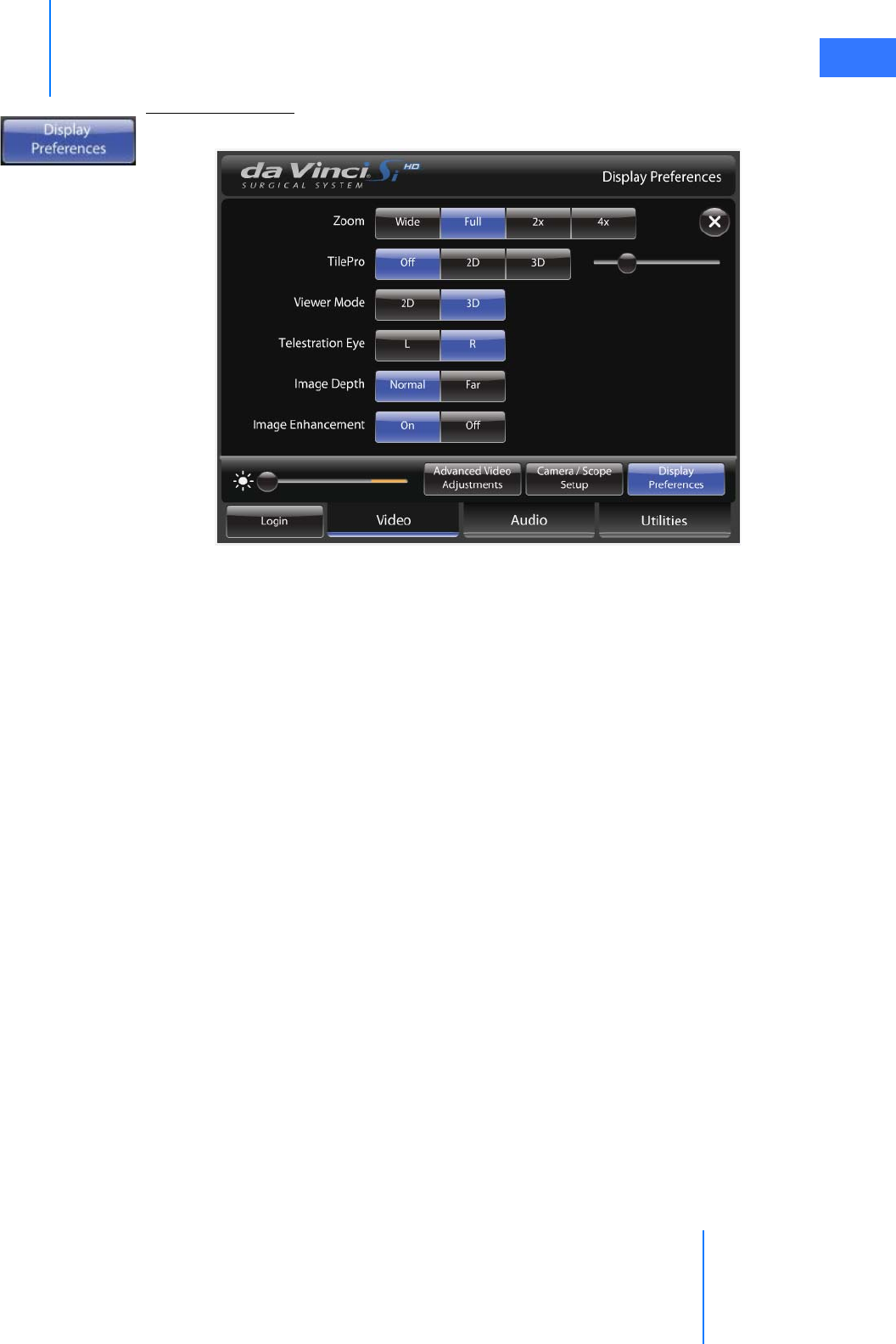
da Vinci® Si™
Surgeon Console Use 10-15
DRAFT/PRE-RELEASE/CONFIDENTIAL
10/9/14
Display Preferences
Touch Display Preferences to configure the stereo viewer display.
Figure 10.18 Display Preferences
•Zoom: Also known as digital zoom, this allows you to zoom in on the image without
changing the position of the endoscope tip. Zoom has four settings (Wide, Full, 2x, 4x).
The current setting appears below the scope status icon on the touchpad.
When you change the Zoom setting, a navigation window appears in the bottom right
corner of the Surgeon Console image. The navigation window represents the widescreen
(16:9) image. The blue rectangular outline indicates the zoom level.
•TilePro: Selecting 2D or 3D switches the stereo viewer display from full endoscope view
to TilePro (multi-image) mode. TilePro allows display of up to two auxiliary video inputs
(PACS, ultrasound, room camera, etc.) along with the operative image. When TilePro is
active, the system detects auxiliary video inputs and arranges the TilePro display
accordingly. While in TilePro mode, you can use the slider to scale the endoscopic image
relative to the auxiliary images. As the operative image size changes, the auxiliary images
will scale to fill in the remaining display area.
•3D TilePro: To display a 3D TilePro video source in the stereo viewer, connect a
compatible (stereo) video source to both the TilePro (L) and (R) connectors at once
and select 3D on the touchpad.
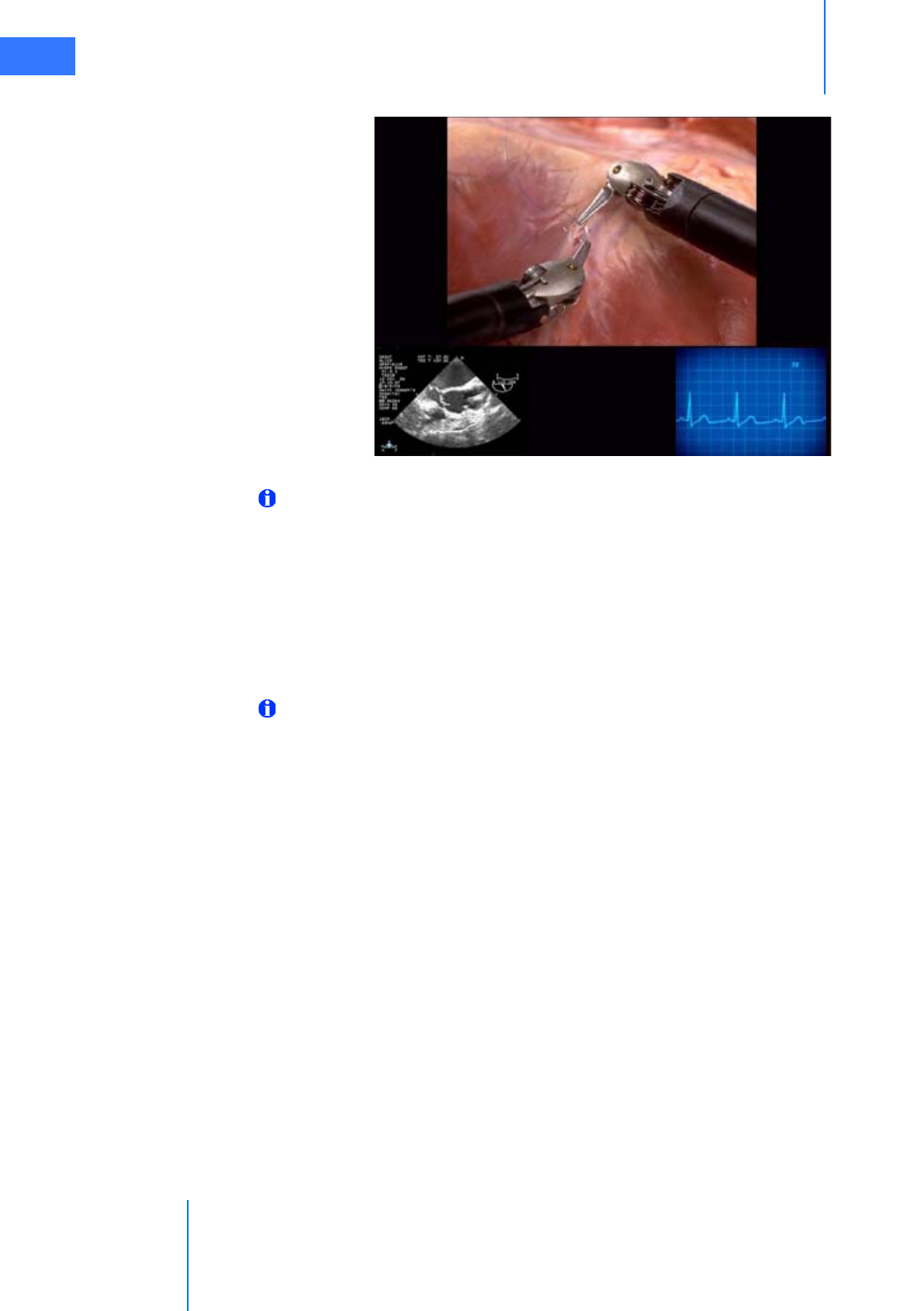
Surgeon Console Use
da Vinci® Si™
10-16
DRAFT/PRE-RELEASE/CONFIDENTIAL
10/9/14
Figure 10.19 Sample TilePro layout in stereo viewer
Note: TilePro is disabled unless the system senses auxiliary video input(s).
•Viewer Mode: Toggles the stereo viewer between 2D and 3D mode.
• Telestration Eye: Toggles display of telestration overlay between the left-eye (L) and
right-eye (R) image.
• Image Depth: Optimizes the surgeon’s ability to see a fused 3D image at Normal or Far
distances. The system defaults to Normal.
• Image Enhancement: Default is On. When on, it optimizes sharpness of the video image
display in most situations. Turning it off may reduce noise in the image.
Note: For details regarding icons and text messages overlaid on the stereo viewer
display see Appendix G: Symbols, Icons and Text Messages Reference.
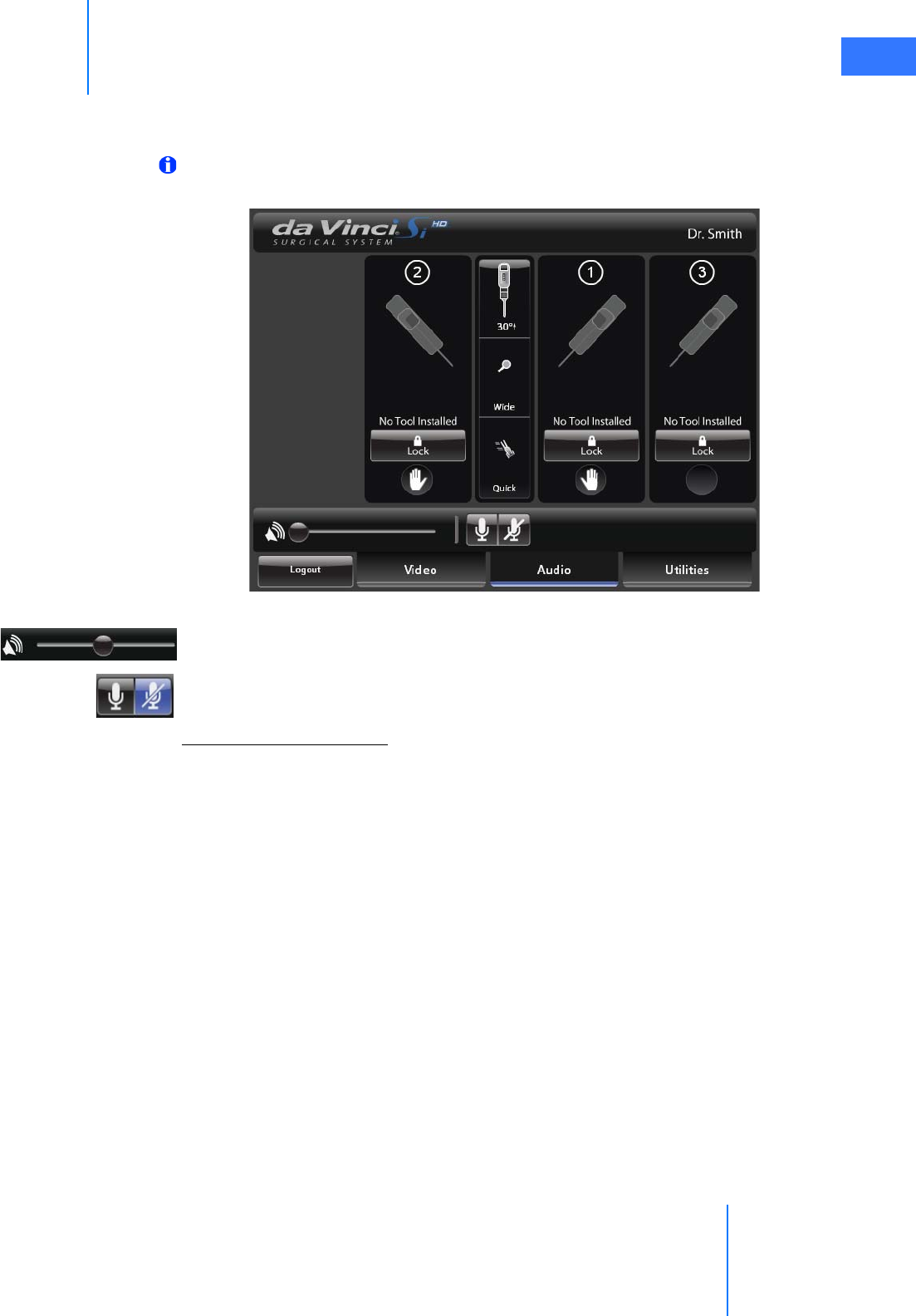
da Vinci® Si™
Surgeon Console Use 10-17
DRAFT/PRE-RELEASE/CONFIDENTIAL
10/9/14
Audio
The Audio tab enables volume adjustments and microphone mute.
Note: If you experience difficulty in communicating with the patient side assistant,
check the audio settings.
Figure 10.20 Audio tab
•Volume: Drag the slider to adjust volume in the Surgeon Console speakers; volume
increases left to right.
•Mute: Touch to mute the Surgeon Console microphone.
Addressing Audio Feedback
To address audio feedback, attempt the following mitigations:
• Reduce speaker volume in the Surgeon Console and/or at the touchscreen.
• Orient the Surgeon Console(s) and touchscreen so that microphones and speakers do not
point toward each other.
• Increase the distance between the Surgeon Console(s) and touchscreen.
• Mute either the Surgeon Console or touchscreen microphone to allow amplified audio in
one direction only.
• Use an external speaker connected to the Surgeon Console Audio Line Out to amplify the
audio output from that Surgeon Console only.
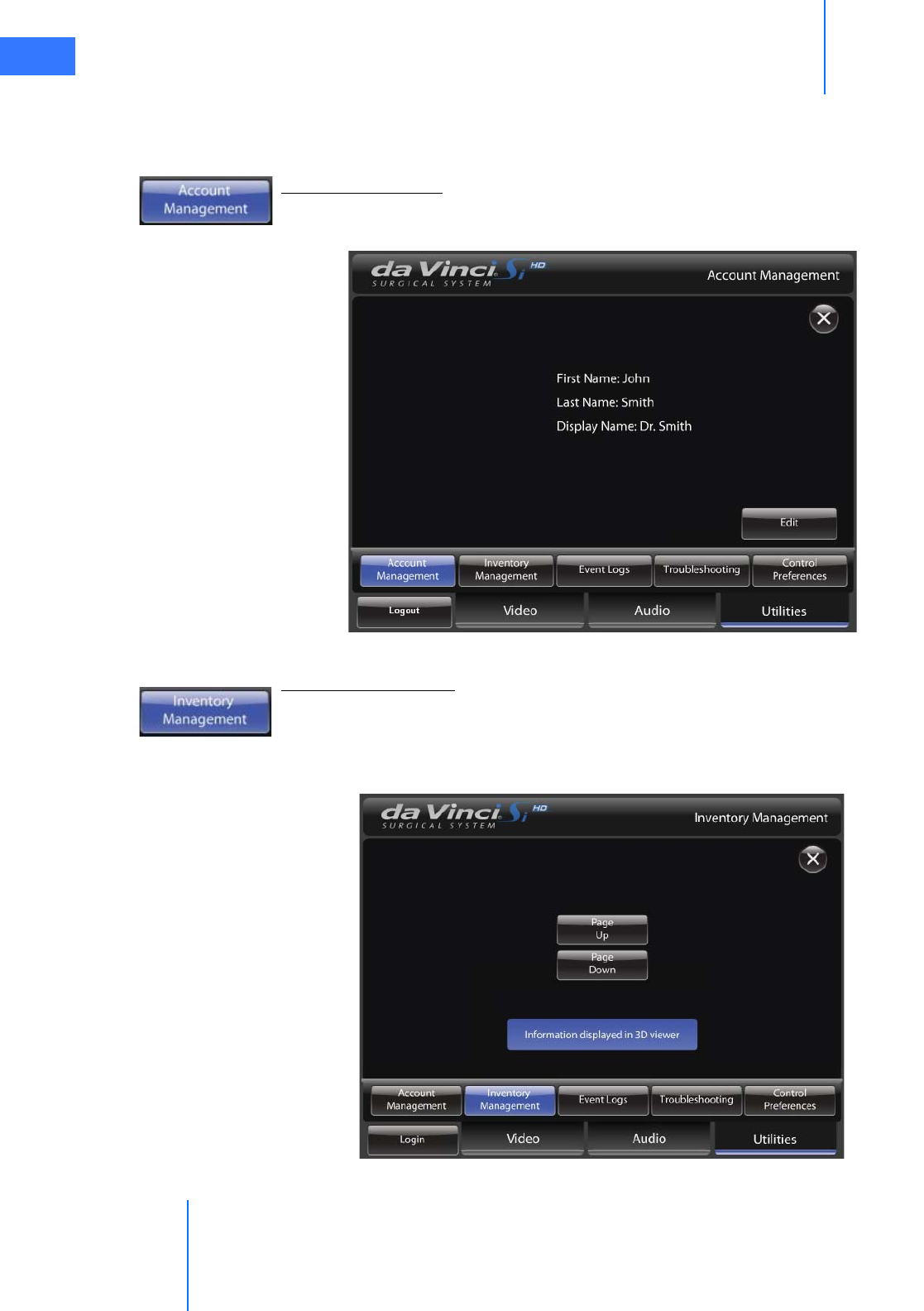
Surgeon Console Use
da Vinci® Si™
10-18
DRAFT/PRE-RELEASE/CONFIDENTIAL
10/9/14
Utilities
The Utilities tab provides access to Account Management, Inventory Management, Event
Logs and Control Preferences.
Account Management
Provides access to user account information. Users may change information regarding their
profile or delete their account.
Figure 10.21 Account Management
Inventory Management
Reports usage status for instruments used during the procedure. When the surgeon selects
Inventory Management, the inventory list appears in the stereo viewer, not the touchpad.
The list also displays the usage hours of the lamp module. Press Page Up or Page Down to
scroll the inventory list.
Figure 10.22 Inventory Management
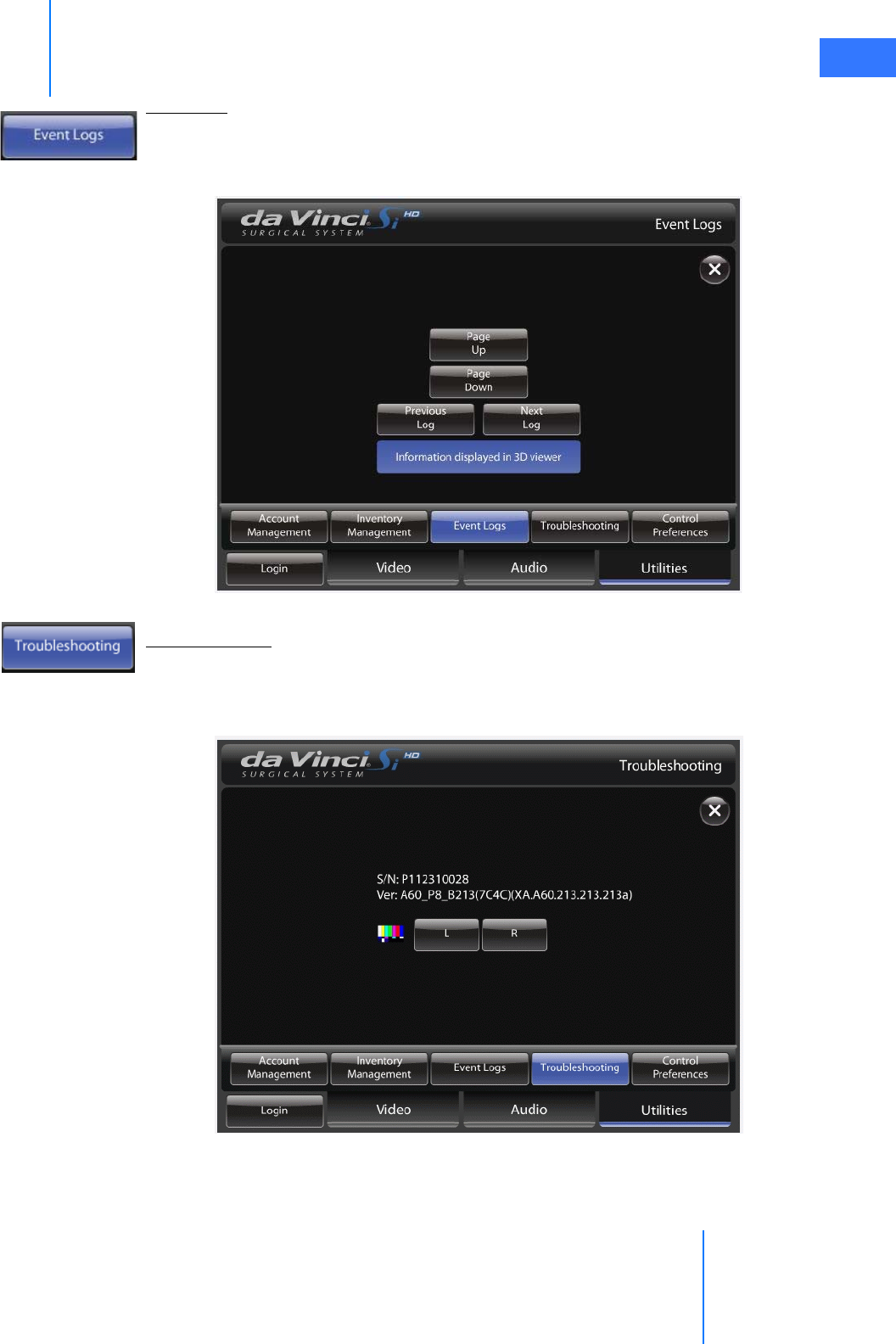
da Vinci® Si™
Surgeon Console Use 10-19
DRAFT/PRE-RELEASE/CONFIDENTIAL
10/9/14
Event Logs
Provides access to system event logs, including error logs. When the surgeon selects Event
Logs, the event logs appear in the stereo viewer, not the touchpad. The touchpad notifies you
that the information is displayed in the stereo viewer.
Figure 10.23 Event Logs
Troubleshooting
Displays the system name and system software version, and provides L (left) and R (right)
buttons to display the color bar test pattern in the left or right video channel independently.
The functionality is the same as found on the touchscreen Troubleshooting screen.
Figure 10.24 Troubleshooting on touchpad
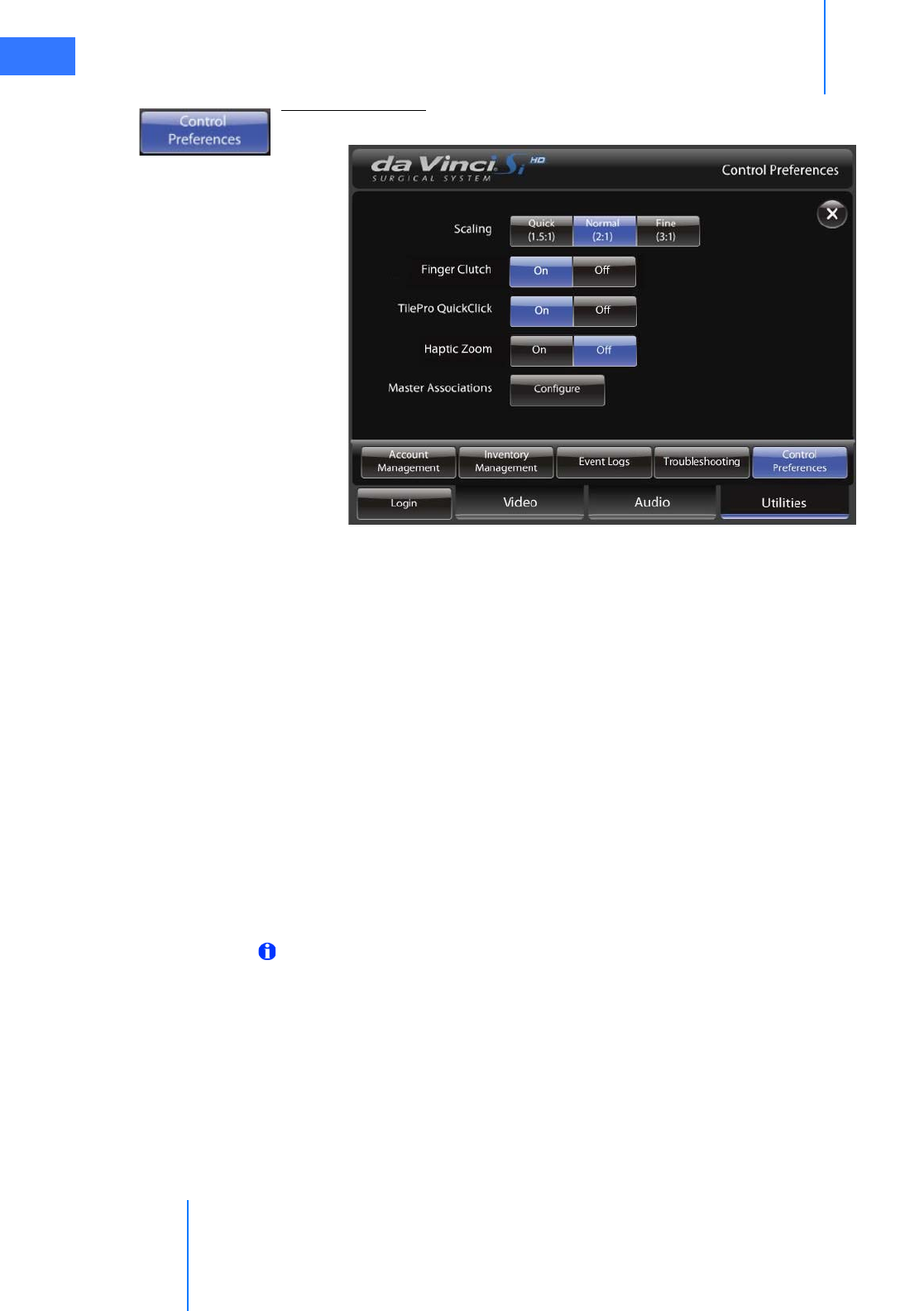
Surgeon Console Use
da Vinci® Si™
10-20
DRAFT/PRE-RELEASE/CONFIDENTIAL
10/9/14
Control Preferences
Allows the surgeon to configure the system controls.
Figure 10.25 Control Preferences
•Scaling: Scales master controller positioning movements to Quick (1.5:1), Normal (2:1)
and Fine (3:1) ratios. The system defaults to Fine.
•Finger Clutch: Turn finger clutching on or off. The finger clutch buttons on the masters
are on by default, when no one is logged in to the Surgeon Console. However, note that
finger clutch on or off is saved to a user’s profile. So if you change the setting while
logged in to the Surgeon Console, that setting will be saved to your profile and apply
automatically whenever you log in.
•TilePro QuickClick: Turn TilePro QuickClick on or off. When on, the surgeon can switch
into TilePro mode by quickly clicking the camera pedal.
•Haptic Zoom: Turn haptic zoom on or off. Off by default, haptic zoom is a method to
apply digital zoom using the masters, while in camera control mode. Recall that digital
zoom does not move the endoscope tip. To use haptic zoom, press the camera pedal to
enter camera control mode and:
• Push the masters closer together to zoom in (digitally).
• Pull the masters apart from each other to zoom out (digitally).
Note: You may feel a slight detent (pushback) on the masters as the levels are adjusted.
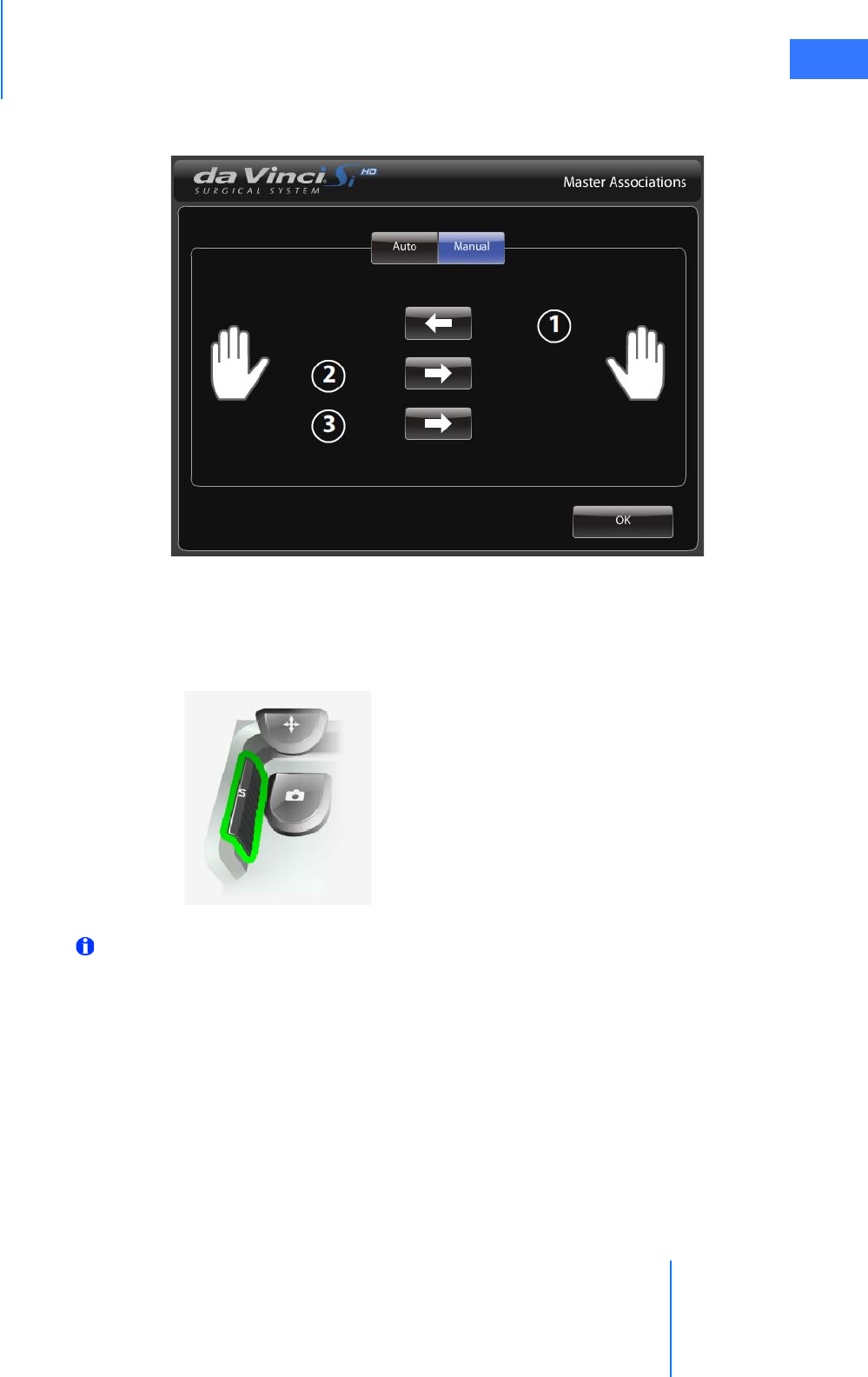
da Vinci® Si™
Surgeon Console Use 10-21
DRAFT/PRE-RELEASE/CONFIDENTIAL
10/9/14
•Master Associations: Touch Configure to open the Master Association screen, which
enables you to manually associate either master with any instrument arm.
Figure 10.26 Master Associations
• You can press Auto to apply master associations automatically, or use the arrow
buttons to manually switch masters association by instrument arm. When
instruments are reassigned, the system takes the instruments out of following,
notifies and prompts you with the icon and associated message below:
Figure 10.27 Icon and message when instruments reassigned
Note: In dual console mode, either surgeon can use the Master Associations screen to
reassign instruments to different masters – even while the other surgeon has control of
the instruments. The new instrument assignment applies on both consoles and persists
when instruments are swapped. The system notifies the surgeons as usual when
reassignment occurs.
Your instruments have been reassigned.
Tap ‘Arm Swap’ pedal to acknowledge
and continue.
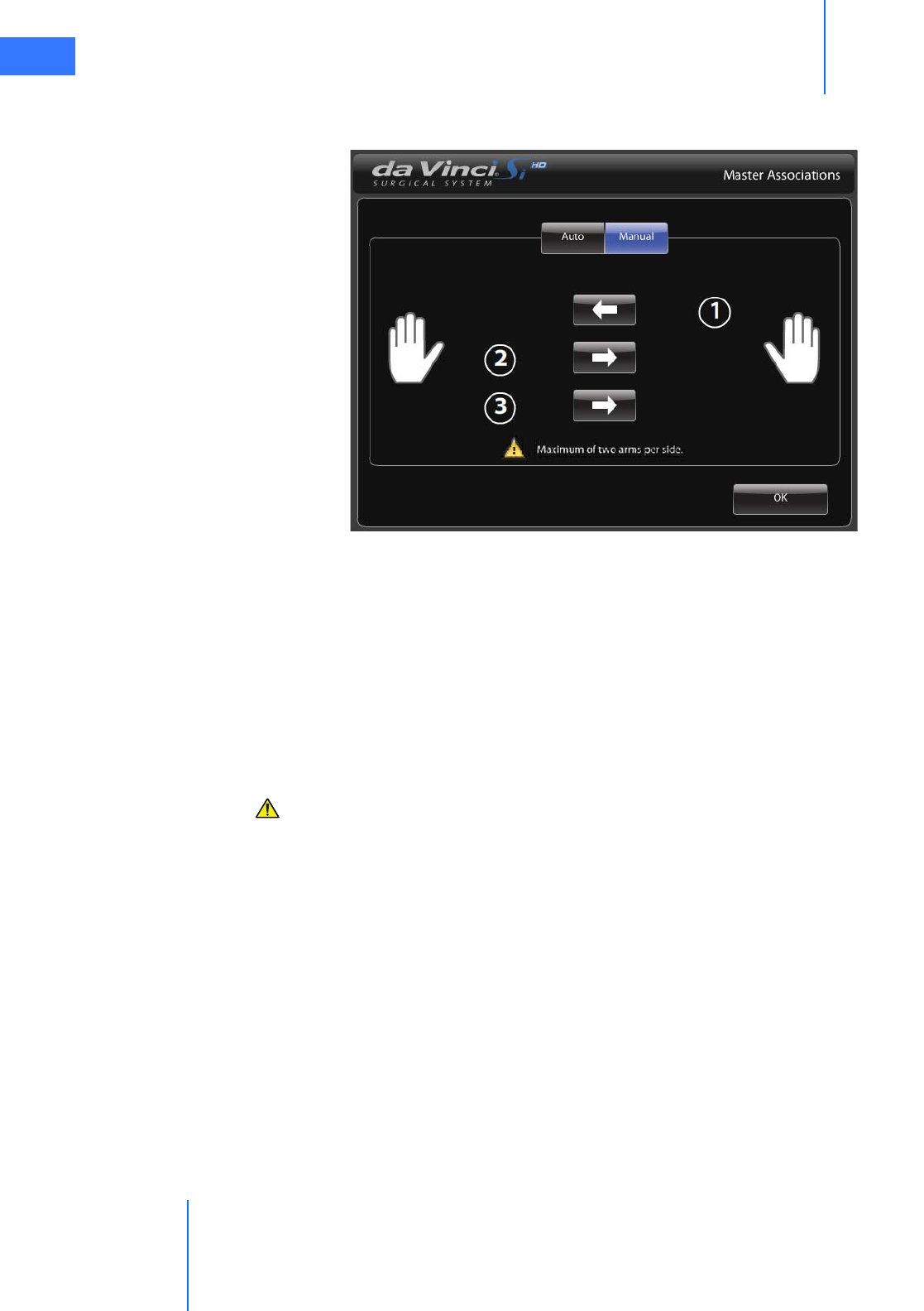
Surgeon Console Use
da Vinci® Si™
10-22
DRAFT/PRE-RELEASE/CONFIDENTIAL
10/9/14
• The system does not allow you to associate all 3 arms with one master, and notifies
you if you attempt it: “Maximum of two arms per side.”
Figure 10.28 Maximum of two arms per side
10.4 Surgical Controls
This section describes the interface for controlling the instruments, camera and stereo viewer
display via the masters and footswitch panel.
To begin using the surgical controls, the surgeon must first put his or her head in the stereo
viewer. The stereo viewer uses a pair of infrared head sensors to determine whether the
system is in use or not. If the surgeon’s head is out of the viewer, he or she cannot take control
of the instruments or camera.
CAUTION: The infrared head sensors performs a safety function by preventing
movement of the Patient Cart arms when the surgeon’s head is not in the viewer. Do not
defeat this safety feature by intentionally blocking the sensors.
Matching Grips
Before taking control of instruments, the surgeon must first “match grips.” Matching grips is a
safety feature designed to prevent inadvertent activation of instruments. It also ensures that
items being held by inactive instruments are not accidentally dropped when activated.
To enable surgeon control, matching grips requires two steps:
1. Satisfy Intended Motion: Satisfy intended motion by using the master to partially close
or open the grips, or slightly rotate the grips.
2. Match Grip Angle: After satisfying intended motion, you must match the master grip
angle to the instrument grip angle.
Once you match grips, you can control the instruments. You cannot match grips until the
instrument tip moves past the cannula tip. When the instrument is ready to match grips, an
icon and text message prompt you to match grips.
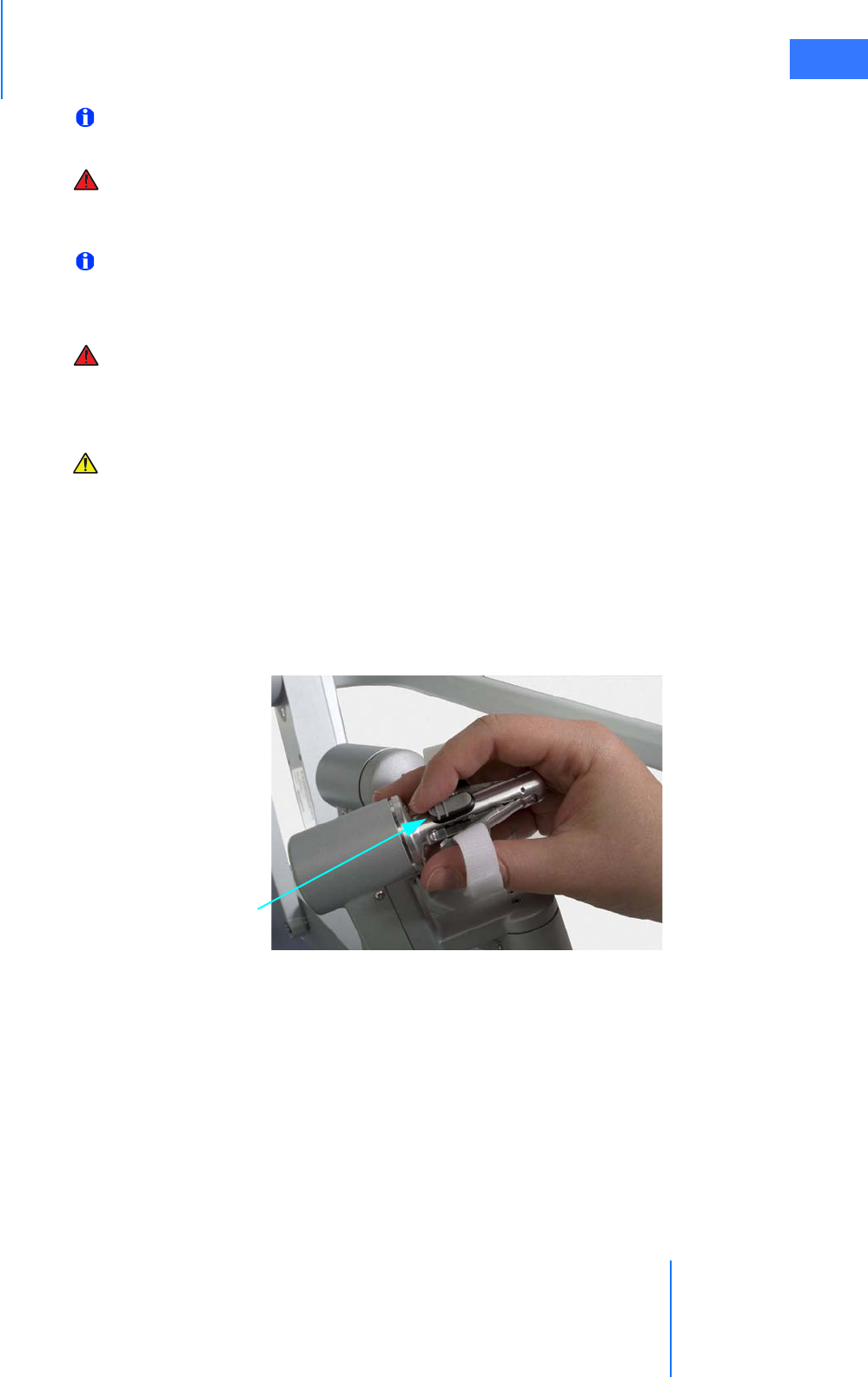
da Vinci® Si™
Surgeon Console Use 10-23
DRAFT/PRE-RELEASE/CONFIDENTIAL
10/9/14
Note: Clip appliers must match grips and be open more than 90% before they will be
allowed to close.
WARNING: For patient safety, the surgeon must not match grips nor move instruments
whose tips are not visible in the stereo viewer. Failure to observe this warning can cause
serious harm to the patient.
Note: To ensure patient safety, the Patient Cart operator's actions take precedence over
Surgeon Console control. Any movement of the arms by the Patient Cart operator takes
all instruments out of following.
WARNING: Once in following, the Surgeon Console operator must not remove his or her
hands from the masters until removing his or her head from the Surgeon Console
viewer—thereby taking the system out of following mode. Failure to do so may result in
uncontrolled movement of the masters, resulting in serious harm to the patient.
CAUTION: To avoid an electrical hazard, the Surgeon Console operator must not touch
the patient while using the master controllers.
Maintain a light grip on the masters when taking or retaking control of the masters (for
example, when a new instrument is installed, when the Patient Cart operator moves the
Instrument or camera arms, after instrument arm swapping, etc.). This allows the system to
align the master grips relative to the tips of the instruments in the stereo viewer.
Finger Clutch
Figure 10.29 Finger clutch
Slide the finger clutch to decouple the master from control of its instrument. While you hold
the finger clutch, you can move the master and the instrument will not move. Unlike the
master clutch pedal, the finger clutch applies only to its own master controller. So when you
apply one finger clutch, the other master’s instrument remains in following. Applying the
finger clutch enables you to reposition the master for comfort, and to reclaim space to
maneuver when the master reaches its limits. To resume control, release the finger clutch and
match grips as usual (see Matching Grips on page 10-22).
• You can turn off finger clutching using the Control Preferences screen on the touchpad
(see page 10-20).
Finger clutch
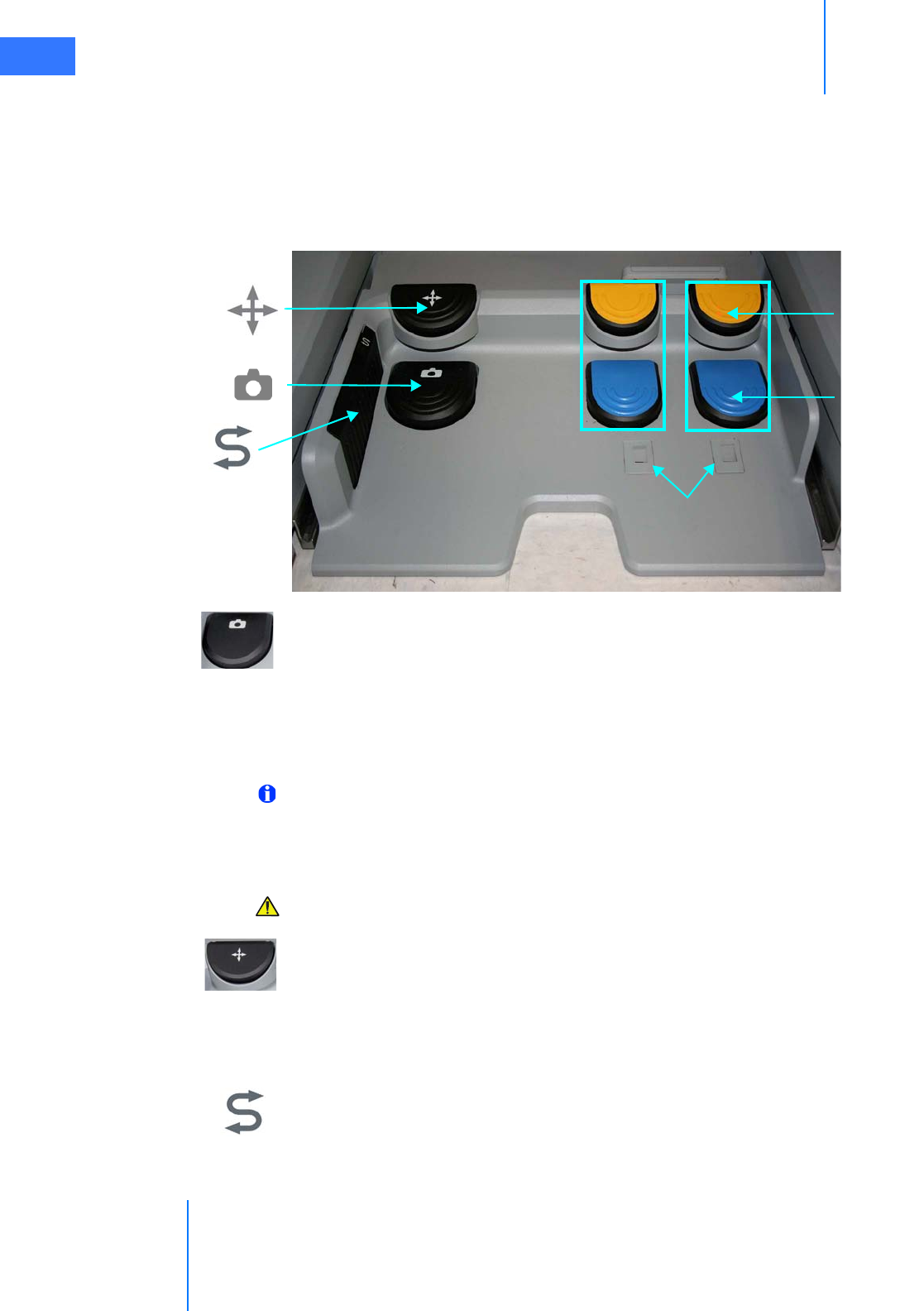
Surgeon Console Use
da Vinci® Si™
10-24
DRAFT/PRE-RELEASE/CONFIDENTIAL
10/9/14
Footswitch Panel Use
The footswitch panel features two groups of footswitches. The three switches on the left
control system functions (camera control, master clutch, and arm swap). The four pedals on
the right side of the footswitch panel control energy activation for devices connected to the
Energy connectors on the Core (for example, electrosurgical units or ESUs). The energy
control pedals are arranged as a left pair of pedals and a right pair of pedals.
Figure 10.30 Footswitch panel controls
•Camera Control and Focus: Press the camera pedal to switch the masters from
instrument control to camera (endoscope) control. In camera mode, the surgeon’s
movement of both masters together – such as moving in or out, side to side, or rotating –
translates into endoscope movements. To move the scope in, pull the image toward you:
pull both masters toward your eyes. To rotate the image clockwise, rotate the two
masters together clockwise, like a steering wheel. To adjust focus, rotate your wrists in
either direction while holding the masters.
Note: Pressing the camera pedal takes all instruments out of following and also stops
firing of energy instruments on the other console when operating in dual console mode
(see section 10.5 Dual Console Surgery). When you release the camera pedal, the
masters resume control of the instruments.
CAUTION: Instrument tips should be kept in the view of the surgeon at all times.
•Master Clutch: Pressing the master clutch pedal decouples both masters from control of
their instruments and enables you to move the masters easily while all instruments
remain immobile. (You cannot use the footpedal to clutch masters independently.)
Pressing the master clutch pedal allows the surgeon to reposition the masters for
ergonomic comfort, and to reclaim space to maneuver the masters when they run out of
working space. All instruments remain immobile until the surgeon resumes control by
releasing the pedal and then matching grips as usual (see Matching Grips on page 10-22).
•Arm Swap (left kick-plate): Swaps control between two instrument arms associated
with the same master.
Arm
Swap
Camera
Control and Focus
Secondary
energy (yellow)
above
Primary
energy (blue)
below
Foot sensors
Master Clutch
Left pair Right pair
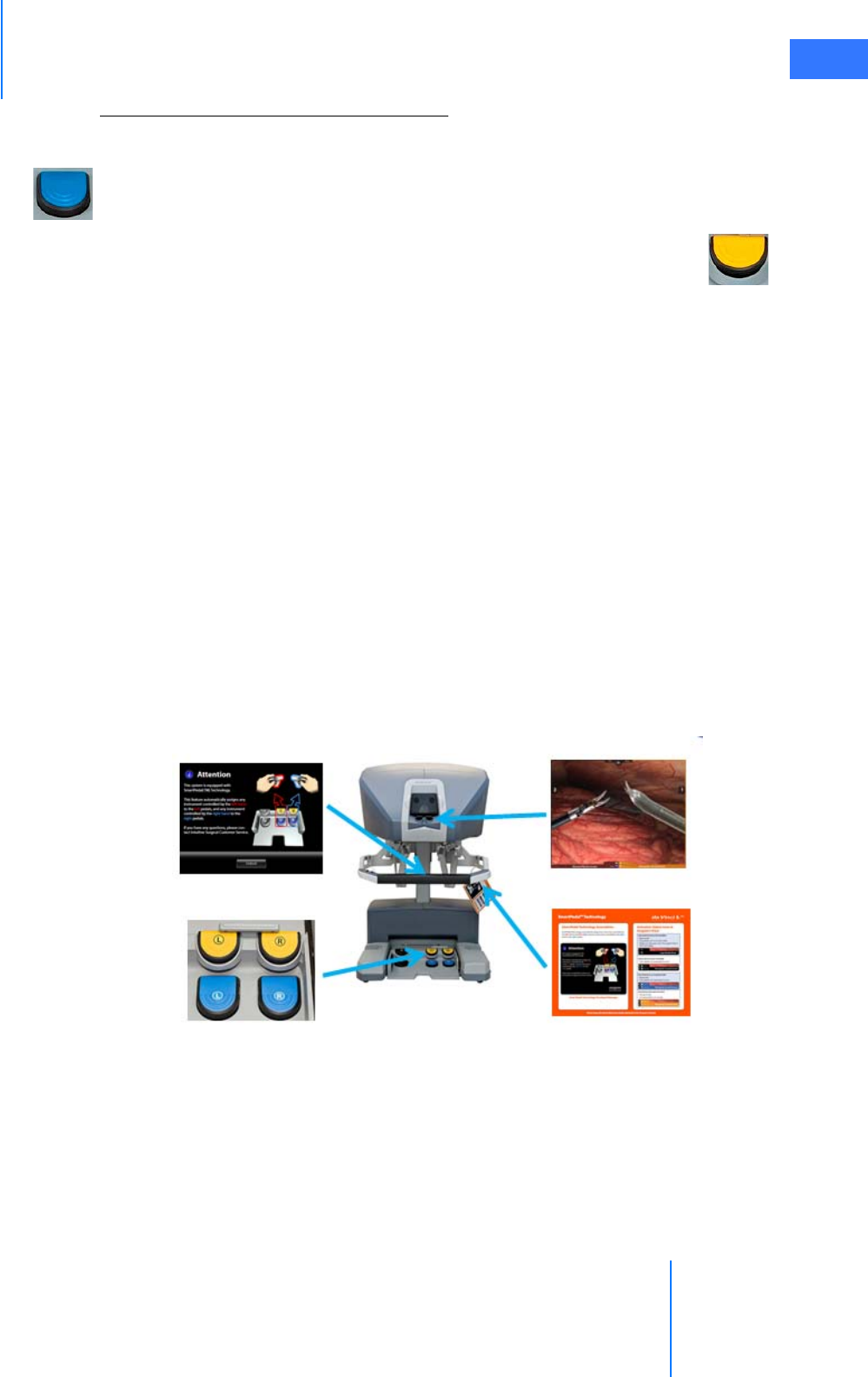
da Vinci® Si™
Surgeon Console Use 10-25
DRAFT/PRE-RELEASE/CONFIDENTIAL
10/9/14
Primary (Blue) and Secondary (Yellow) Pedals
Each pair has a blue pedal below for primary activation, and a yellow pedal above for
secondary activation.
•Primary Pedal (blue): Activates the primary function of a pedal-linked instrument (for
example, Coag for monopolar instruments).
•Secondary Pedal (yellow): Activates the secondary function of a
pedal-linked instrument (for example, Cut for monopolar instruments).
For information about the user interface associated with pedal activation, see
Footswitch Panel Use on page 10-24.
Identify System Configuration: SmartPedal™ Technology or Not
The da Vinci Si System may be equipped with SmartPedal technology or not. This manual
provides instructions for both configurations, in consecutive sections. It is important to
distinguish which configuration is present to use the energy pedals correctly.
The following things indicate the presence of SmartPedal technology on the system:
• “L” and “R” pedal labels on the blue and yellow pedals
•Orange SmartPedal Quick Reference Guide hanging on Surgeon Console
• User interface differences, particularly in the footswitch map at bottom center of stereo
viewer display. These differences are shown in the following sections on each
configuration.
SmartPedal notification screen (Figure 10.31) appears on touchpad, upon startup, and at the
login and unlock screens. Note that this message can be permanently disabled for each user
when logging in by pressing “Don’t show this message again.” Once disabled, the message will
not be displayed at the login and unlock screens.
Figure 10.31 SmartPedal Indicators
The following things indicate that SmartPedal technology is not present on the system:
• No “L” and “R” pedal labels on the blue and yellow pedals
• User interface differences, particularly in the footswitch map at bottom center of the
stereo viewer display.
Notification screen Surgeon’s View
Labels Quick Reference Guide
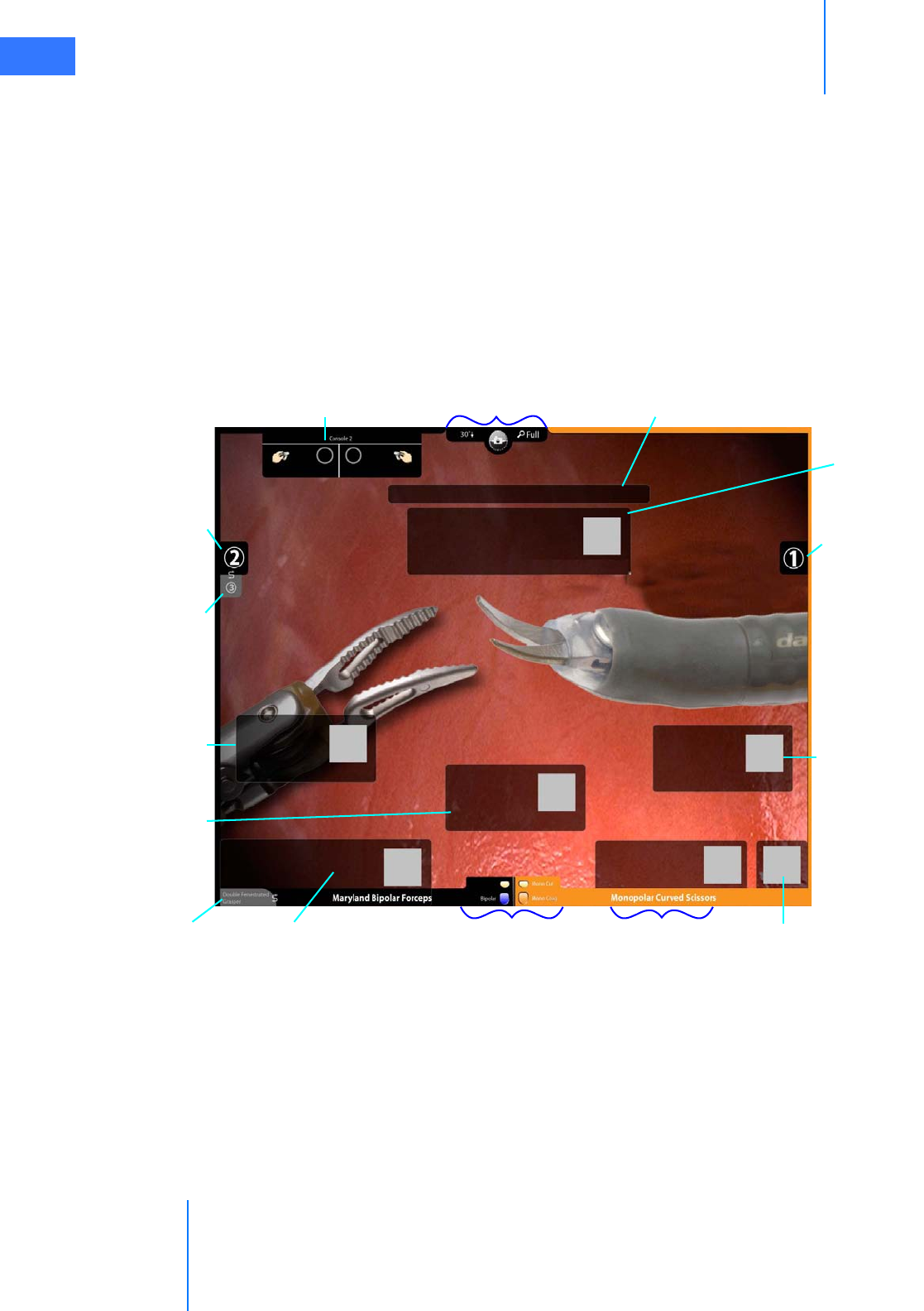
Surgeon Console Use
da Vinci® Si™
10-26
DRAFT/PRE-RELEASE/CONFIDENTIAL
10/9/14
If your system is configured with SmartPedal technology, follow the instructions immediately
below. If your system is configured without SmartPedal technology, follow the instructions
starting on page10-32 with the section Non-SmartPedal: Energy Control Pedals.
SmartPedal Technology: Stereo Viewer Display
The high resolution stereo viewer displays the surgical site and provides extended system
information via icons and text messages. The following figure illustrates arrangement of
overlaid elements displayed in the stereo viewer monitor. Note that many overlaid elements
appear only when needed, and others are usually or always present. For a complete list of
icons and text messages, please refer to Appendix G: Symbols, Icons and Text Messages
Reference.
Figure 10.32 Stereo viewer display
Camera indicators:
angle, rotation, zoom Modal message
area
Critical message
area/icon
Arm 1
status:
on right,
active (larger)
Arm 3
status:
on left
inactive (smaller,
below, gray)
Arm 2
status:
on left,
active (larger)
Footswitch map Active instrument
name
Active instrument arm
message areas/icons
Inactive instrument
arm message area/icon
Left master
message area/icon Right master
message area/icon
Camera arm
message area/icon
Other console
instrument status area/icon
Inactive instrument
name (gray)
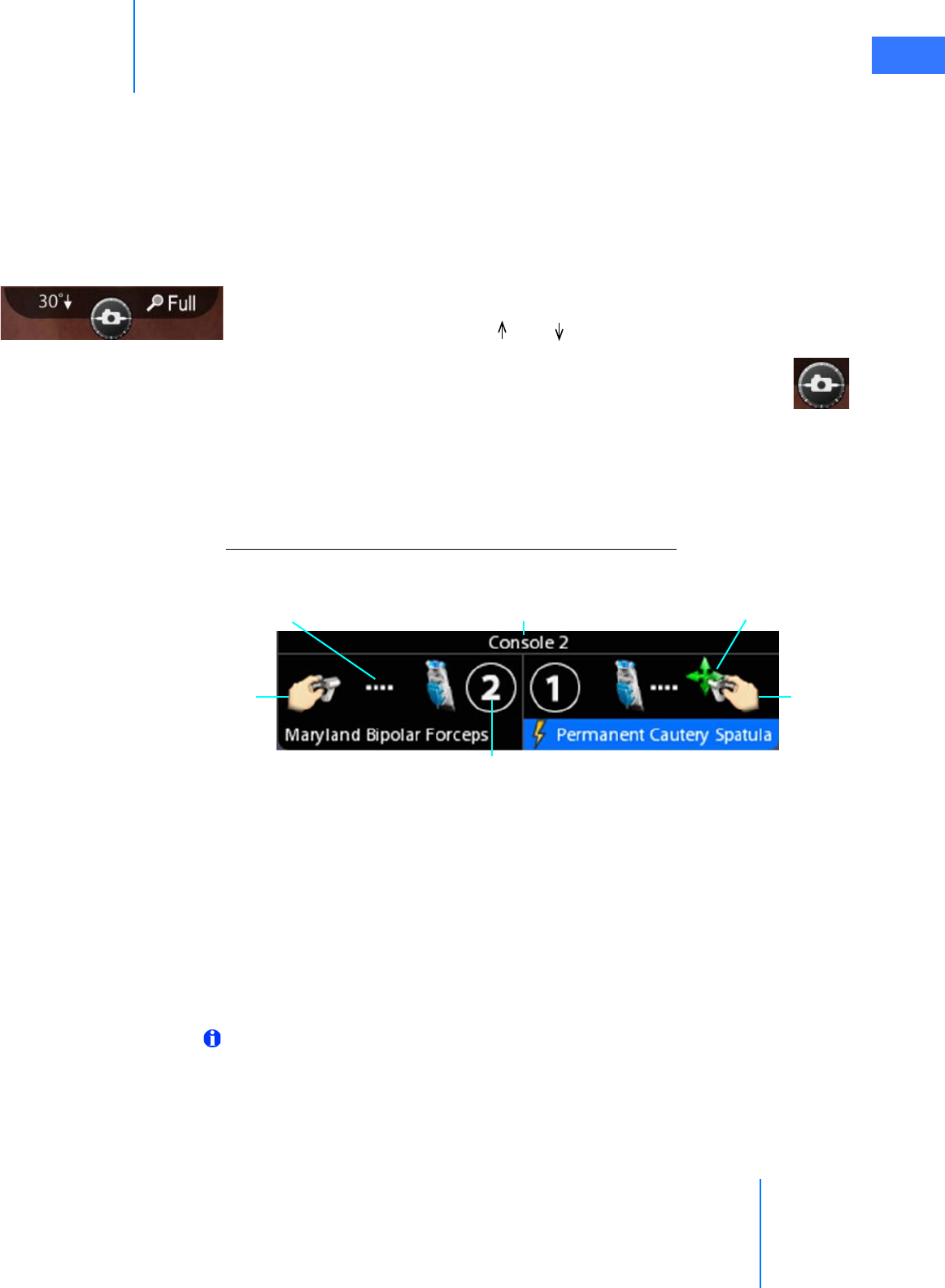
da Vinci® Si™
Surgeon Console Use 10-27
DRAFT/PRE-RELEASE/CONFIDENTIAL
10/9/14
•Instrument Arm Indicator: Provides the instrument arm number on the same side as the
master that controls the instrument arm. When two arms are associated with the same
master, the top number represents the active arm.
•Background colors on instrument names, arm numbers: The background colors on
instrument names and arm numbers, which extend around the screen border on that
side, have the following meanings:
•Blue: Foot detected over an enabled pedal pair
•Orange: Instrument activated
•Camera Indicators: At top center of stereo viewer display, they include:
•Camera Angle: Displays 0º, 30º or 30º .
•Camera Rotation: Provides information regarding the rotation of the
endoscope relative to ground. This feature is useful for understanding
the frame of reference of the video relative to the anatomy.
•Zoom: Shows current zoom level (Wide, Full, 2x, 4x) of the viewer.
•Footswitch Map: Provides a reference for understanding the available function and
status of the instrument activation pedals.
•Message Areas: Provide extended information regarding the state of the system.
SmartPedal Technology: Other Console Instrument Status Area
When in dual console mode, a small status area as in Figure 10.33 appears at upper left of the
stereo viewer.
Figure 10.33 Dual console status area
This area provides the instrument status for the other console, showing:
• The console number at the top, or the user name of the surgeon if logged in
• For left and right masters, the associated instrument name, arm number and activation
status, including turning orange when activated
• The same status icons as appear elsewhere, and the additional icon showing that the
master is clutched (finger clutched) as seen on the right above. For a complete list of
icons and text messages, please refer to Appendix G: Symbols, Icons and Text Messages
Reference.
Note: On the touchscreen, two of these status areas appear side by side at top center
when in dual console mode.
Right master
status and
association
Left master
status and
association
Instrument name, status
Console number or surgeon name if logged in
Associated arm number
Finger clutched
Indicates association
(blue=foot over enabled pedal)
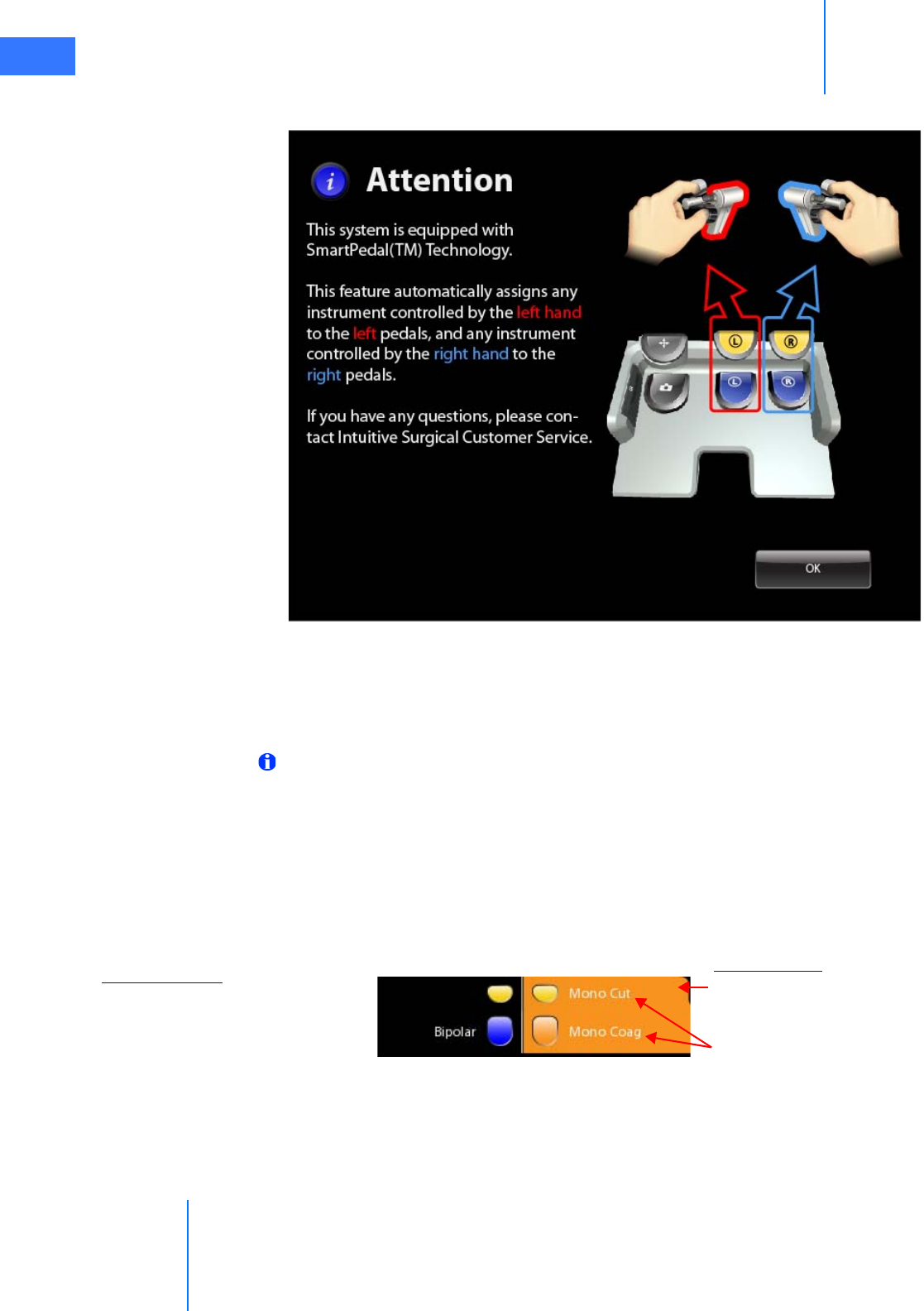
Surgeon Console Use
da Vinci® Si™
10-28
DRAFT/PRE-RELEASE/CONFIDENTIAL
10/9/14
SmartPedal Technology: Left Controls Left, Right Controls Right
Figure 10.34 SmartPedal Technology touchpad message: Pedal to instrument associations
SmartPedal Technology expresses a simple association of pedals with instruments: The left
pair of pedals activate the instrument associated with the left master; likewise, the right pair of
pedals activate the instrument associated with the right master. These automatic associations
for pedals cannot be changed.
Note: This message can be permanently disabled for each user when logging in by
pressing “Don’t show this message again”. Once disabled, the message will not be
displayed upon login or in the unlock screen.
SmartPedal Technology: Footswitch Map (Stereo Viewer)
The footswitch map in the bottom center of the stereo viewer displays the available function
and status for each pedal, when a pedal-linked instrument is installed and an ESU supporting
that function is connected to the system Core.
Figure 10.35 Footswitch map example
Available function
Pedal color meaning: blue = foot over enabled pedal
blue or yellow= enabled pedal
gray = disabled pedal orange = activated
orange = activated pedal
Background colors:
orange pedal outline = disabled pedal being pressed
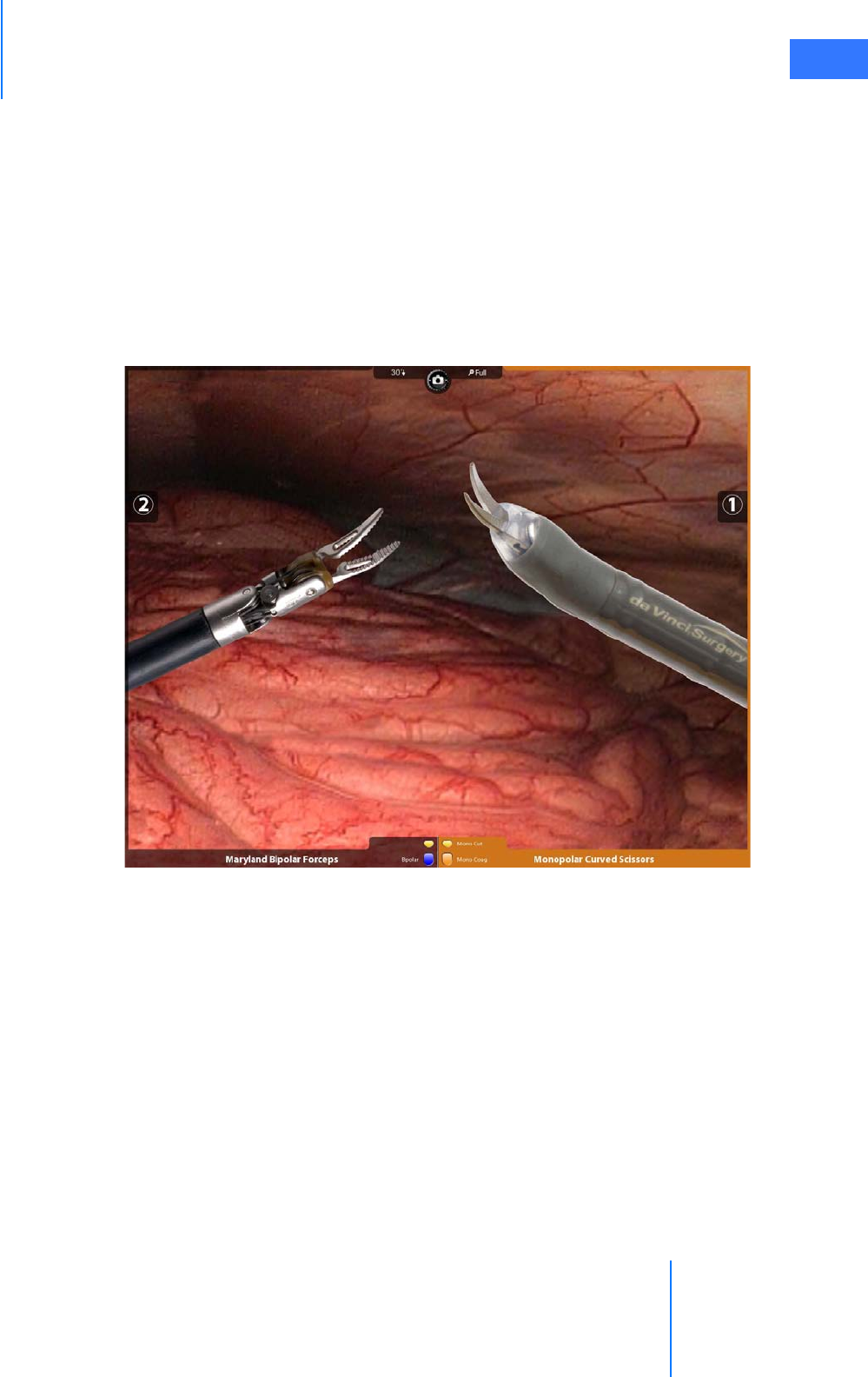
da Vinci® Si™
Surgeon Console Use 10-29
DRAFT/PRE-RELEASE/CONFIDENTIAL
10/9/14
• When no pedal function is available, the pedal is disabled and its icon is gray and lacks
accompanying text that would list an available function. When a disabled pedal is
pressed, its outline is highlighted orange, though it is not activated.
• When a pedal function is available, the pedal is enabled and its icon is blue or yellow, and
has accompanying text showing the available function.
SmartPedal Technology: Stereo Viewer Border Colors
The activation status colors in the stereo viewer extend around the screen border for the
instrument on that side. A blue border means that a foot is over (close to or touching) an
enabled pedal on that side. An orange border means a pedal function is activated on that side.
Figure 10.36 Example of orange border on right
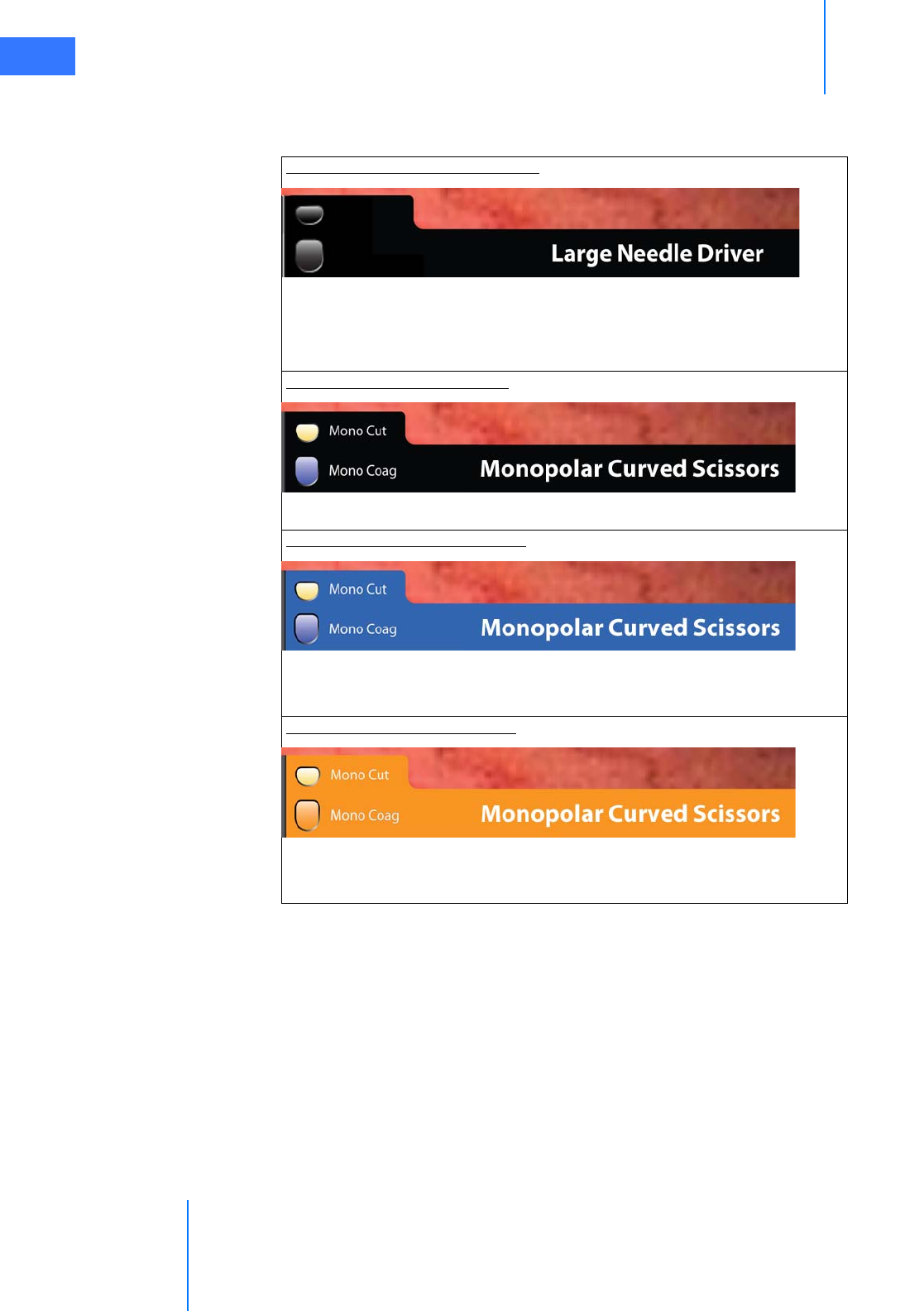
Surgeon Console Use
da Vinci® Si™
10-30
DRAFT/PRE-RELEASE/CONFIDENTIAL
10/9/14
SmartPedal Technology: Activation Status Indicators in Surgeon’s
View
SmartPedal Technology: Pedal Activation Behavior
• The system can activate only one energy instrument at a time: pressing a second pedal
on a single console makes the first stop firing, and neither can fire until both pedals are
released. The lone exception to this behavior regards the Suction/Irrigator, which can be
activated at the same time as other energy instruments.
• In dual console mode, if each surgeon controls an energy instrument, the first press of an
energy pedal activates the associated instrument, and other presses are locked out until
the first is ended. When the first press ends, a blocked press must be released and
re-applied before it is effective.
Instrument Function Not Available
•Black border
• Gray pedals with no function listed
• Pedals turn light gray when the surgeon’s foot is held over a pedal
Instrument Function Available
• Color pedals with associated function
Foot Held Over an Enabled Pedal
•Blue border
• Color pedals with associated function
Activating Instrument Function
•Orange border
• Activated pedal turns orange
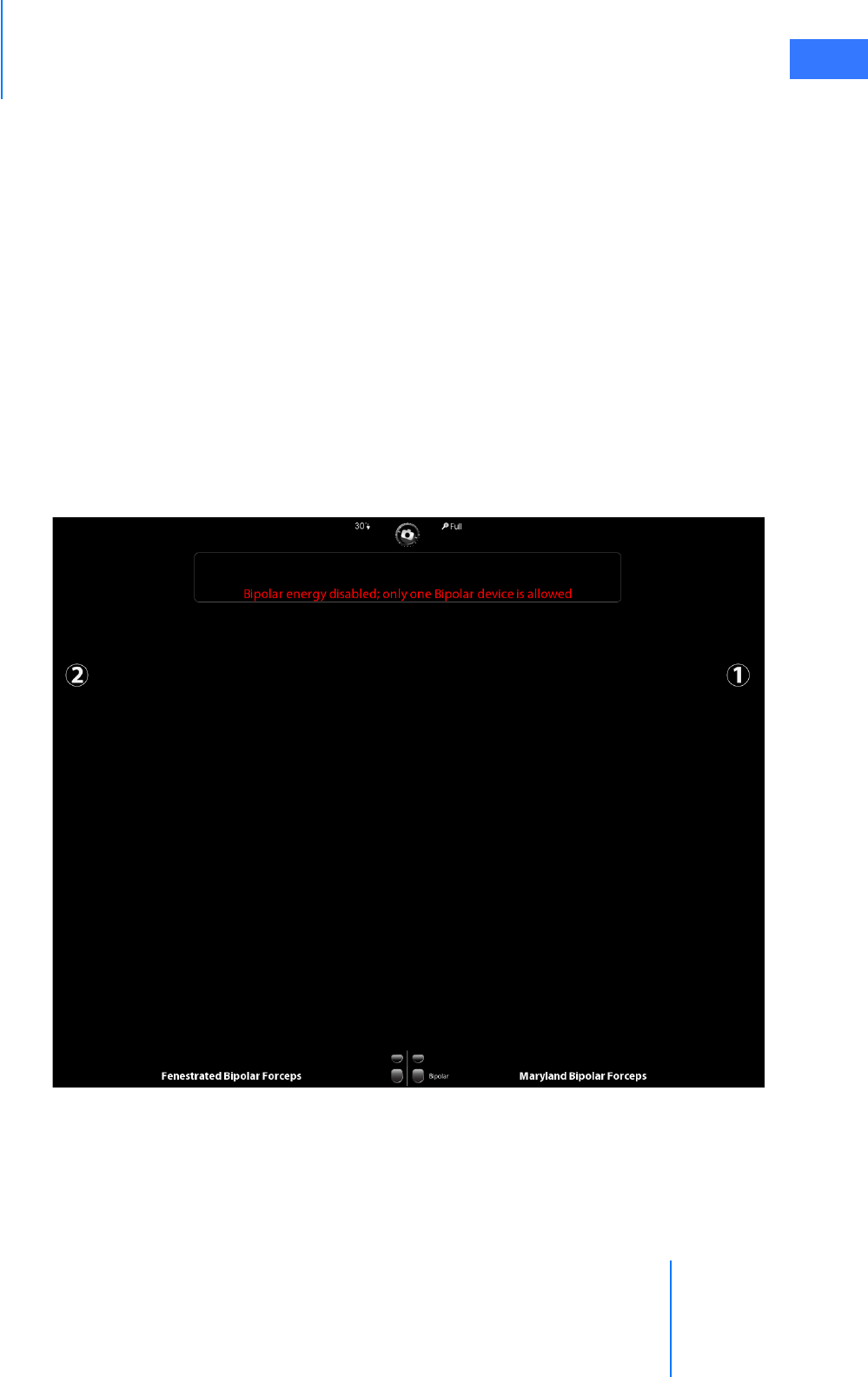
da Vinci® Si™
Surgeon Console Use 10-31
DRAFT/PRE-RELEASE/CONFIDENTIAL
10/9/14
• In single and dual console mode, pressing the camera control pedal stops all energy
firing (and instrument motion).
• The system beeps if you press a pedal while the instrument cannot be activated.
SmartPedal Technology – Troubleshooting: Activation Not
Available
Activation is disabled in any of the following situations:
• The associated generator is not connected to the da Vinci System, or not powered on.
• Two generators with the same energy type are connected to the system, for example, two
monopolar ESUs.
• Two energy instruments of the same type are installed on the system, for example, two
bipolar instruments as shown below. Observe that:
• Red text near the top of the screen reports, Bipolar energy disabled; only one
Bipolar device is allowed.
• The pedals of the footswitch map are grayed out, meaning the pedals are disabled.
Figure 10.37 Example of energy device conflict
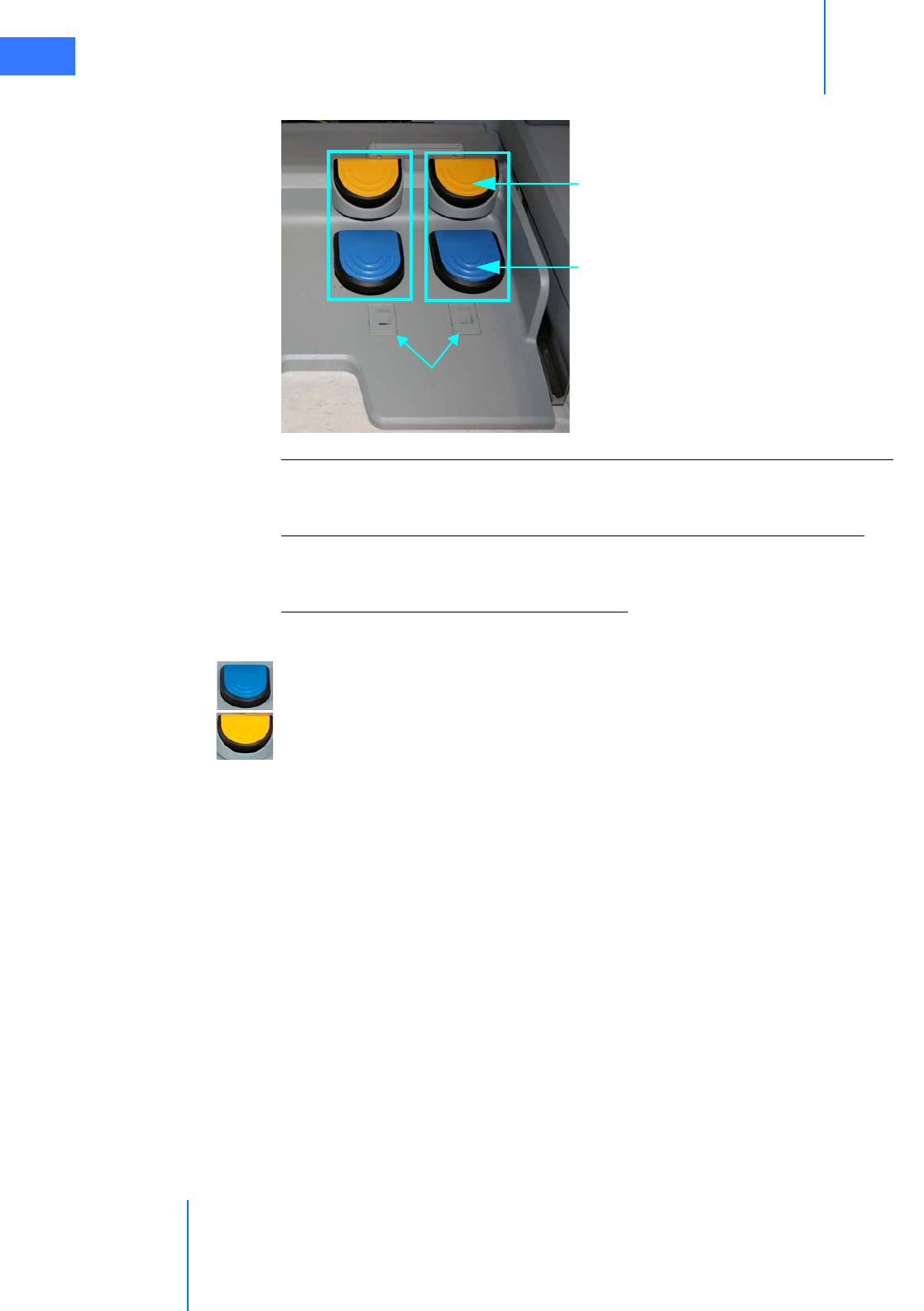
Surgeon Console Use
da Vinci® Si™
10-32
DRAFT/PRE-RELEASE/CONFIDENTIAL
10/9/14
Non-SmartPedal: Energy Control Pedals
Right Pair Controls Monopolar, Harmonic, Vessel Sealer and Stapler Instruments
The right pair of pedals controls energy activation for monopolar, harmonic, Vessel Sealer and
Stapler energy instruments.
Left Pair Controls Bipolar Instruments (Standard or PK) and Suction/Irrigator
The left pair of pedals controls energy activation for bipolar energy instruments, either
standard or PK, and the Suction/Irrigator instrument.
Primary (Blue) and Secondary (Yellow) Pedals
Each pair has a blue pedal below for primary energy control, and a yellow pedal above for
secondary energy control.
•Primary Energy (blue): Activates the primary energy mode of an energized instrument
(for example, Coag for monopolar instruments).
•Secondary Energy (yellow): Activates the secondary energy mode of an energized
instrument (for example, Cut for monopolar instruments).
For information about the user interface associated with energy control, see Footswitch Panel
Use on page 10-24.
Secondary
energy (yellow)
above
Primary
energy (blue)
below
Foot sensors
Left pair Right pair
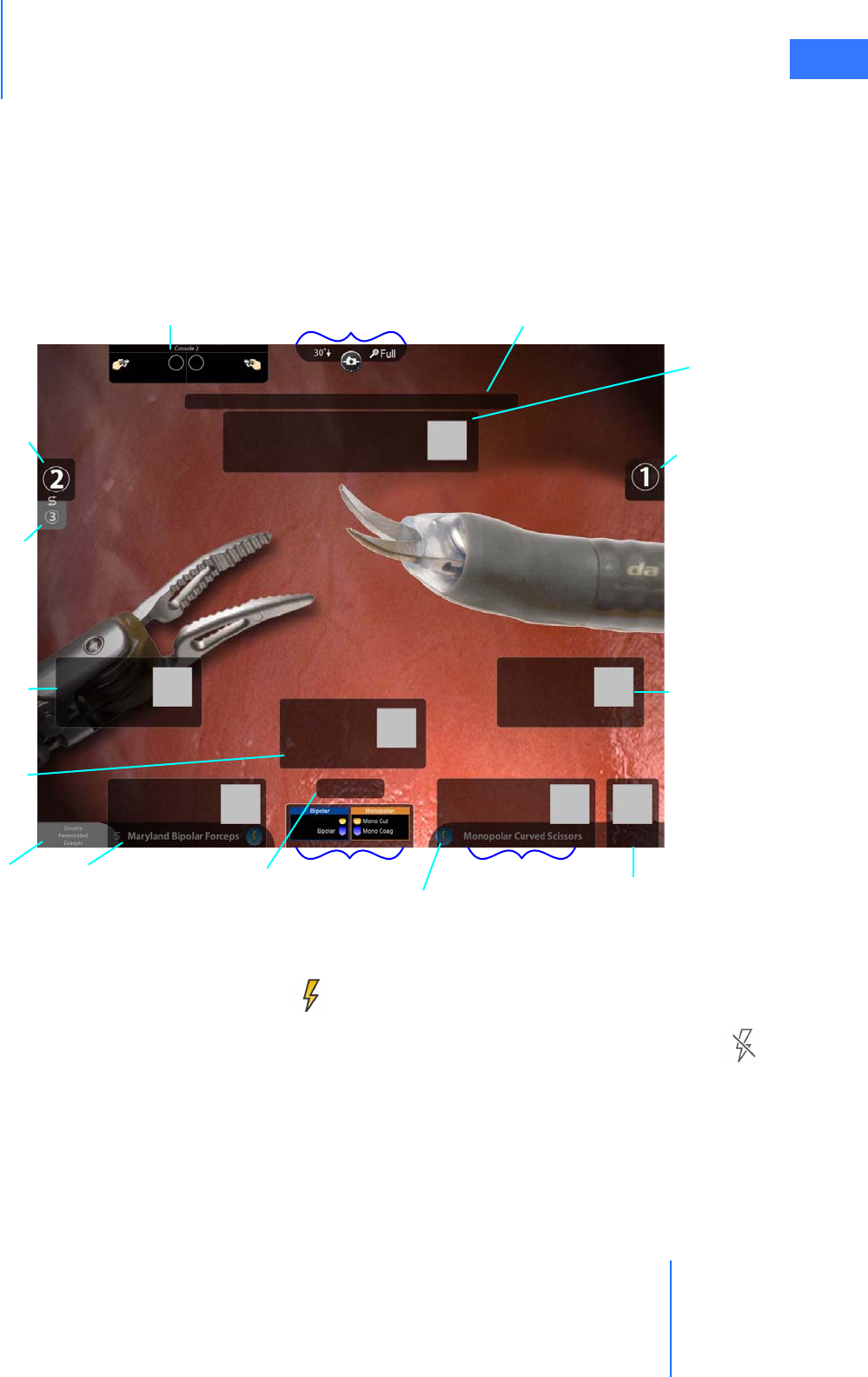
da Vinci® Si™
Surgeon Console Use 10-33
DRAFT/PRE-RELEASE/CONFIDENTIAL
10/9/14
Non-SmartPedal: Stereo Viewer Display
The high resolution stereo viewer displays the surgical site and provides extended system
information via icons and text messages. The following figure illustrates arrangement of
overlaid elements displayed in the stereo viewer monitor. Note that many overlaid elements
appear only when needed, and others are usually or always present. For a complete list of
icons and text messages, please refer to Appendix G: Symbols, Icons and Text Messages
Reference.
Figure 10.38 Stereo viewer display
•Energized indicator: This lightning bolt icon, filled with yellow, appears next to the
name of instruments that are energized and ready to fire. When an energy instrument is
not ready to fire for some reason, the lightning bolt icon is crossed out and empty .
•Instrument Arm Indicator: Provides the instrument arm number on the same side as the
master that controls the instrument arm. When two arms are associated with the same
master, the top number represents the active arm.
Energized
indicator
Masters
status area
Critical message
area/icon
Modal message
area
Camera indicators:
angle, rotation, zoom
Other console
instrument status area/icon
Arm 2
status:
on left,
active (larger)
Arm 3
status:
on left
inactive (smaller,
below, gray)
Left master
message area/icon
Camera arm
message area/icon
Arm 1
status:
on right,
active (larger)
Right master
message area/icon
Inactive instrument
name (gray)
Footswitch map
Active instrument arm
message areas/icons
Active instrument
name Inactive instrument
arm message area/icon
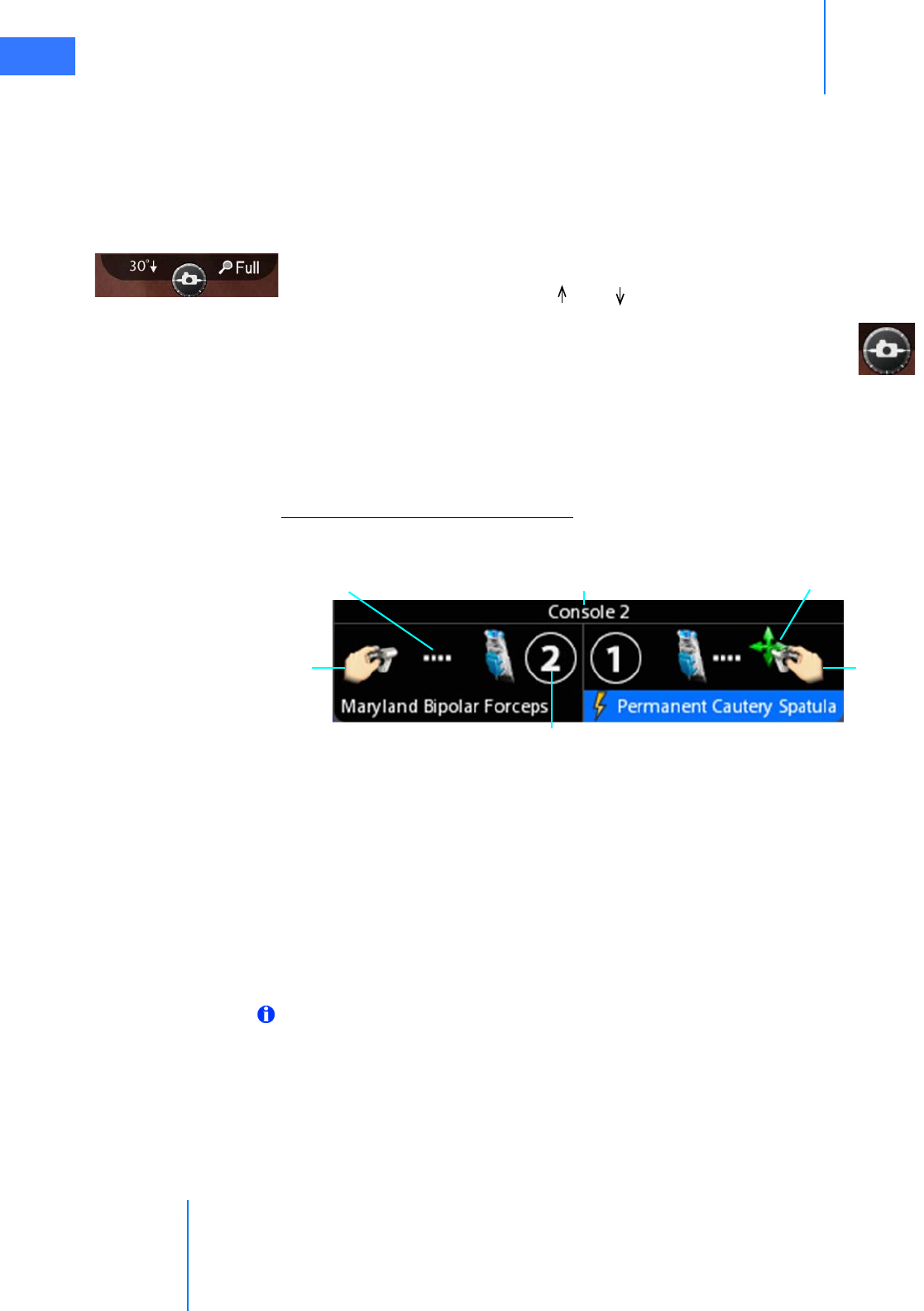
Surgeon Console Use
da Vinci® Si™
10-34
DRAFT/PRE-RELEASE/CONFIDENTIAL
10/9/14
•Background colors on instrument names, arm numbers: The background colors on
instrument names and arm numbers have the following meanings:
•Black, partially transparent (default): Foot sensors detect nothing
•Gray: Foot detected over a disabled pedal pair
•Blue: Foot detected over an enabled pedal pair
•Orange: Energy firing
•Camera Indicators: At top center of stereo viewer display, they include:
•Camera Angle: Displays 0º, 30º or 30º .
•Camera Rotation: Provides information regarding the rotation of the
endoscope relative to ground. This feature is useful for understanding
the frame of reference of the video relative to the anatomy.
•Zoom: Shows current zoom level (Wide, Full, 2x, 4x) of the viewer.
•Footswitch Map: Provides a reference for understanding the locations and status of the
footswitch panel pedals. See Footswitch Panel Use on page 10-24.
•Message Areas: Provide extended information regarding the state of the system.
Other Console Instrument Status Area
When in dual console mode, a small status area as in Figure 10.39 appears at upper left of the
stereo viewer.
Figure 10.39 Dual console status area
This area provides the instrument status for the other console, showing:
• The console number at the top, or the user name of the surgeon if logged in
• For left and right masters, the associated instrument name, arm number and energy
status, including turning orange when firing
• The same status icons as appear elsewhere, and the additional icon showing that the
master is clutched (finger clutched) as seen on the right above. For a complete list of
icons and text messages, please refer to Appendix G: Symbols, Icons and Text Messages
Reference.
Note: On the touchscreen, two of these status areas appear side by side at top
center when in dual console mode.
Right master
status and
association
Left master
status and
association
Instrument name, status
Console number or surgeon name if logged in
Associated arm number
Finger clutched
Indicates association
(blue=foot over enabled pedal)
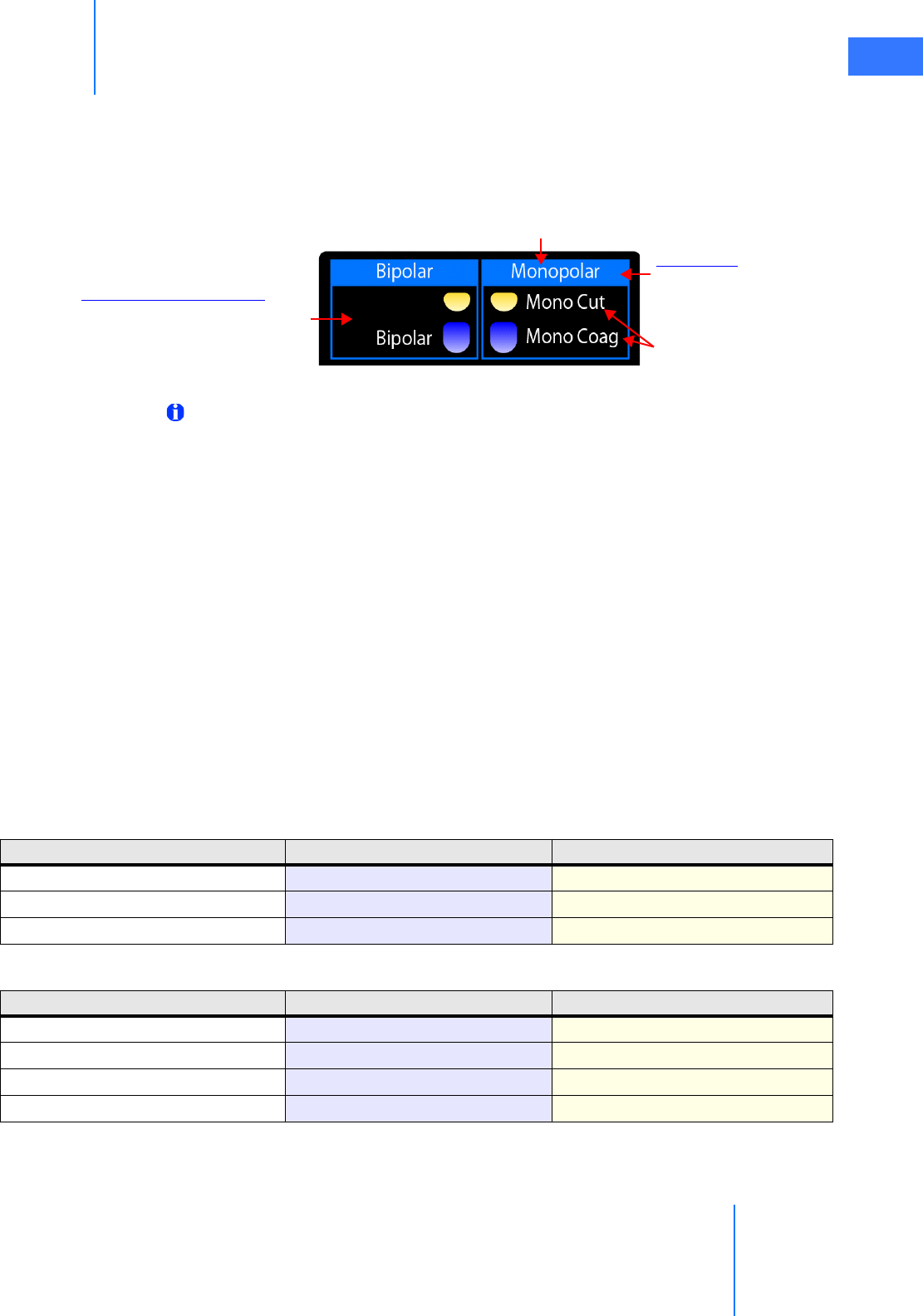
da Vinci® Si™
Surgeon Console Use 10-35
DRAFT/PRE-RELEASE/CONFIDENTIAL
10/9/14
Non-SmartPedal: Footswitch Map (Stereo Viewer)
The footswitch map in the bottom center of the stereo viewer displays the type of energy
instrument and the available primary and secondary energy modes, when an energy
instrument is installed and an ESU supporting that energy type is connected to the system
Core.
Figure 10.40 Footswitch map example
Note: If combinations of installed energy instruments or connected ESUs make
mapping of energy pedals ambiguous, the system will not map nor enable the
pedals for that energy type. The system will prompt the user to resolve the
ambiguity by either disconnecting or powering down one of the ESUs, or by
removing one of the conflicting instruments.
• For example, if two monopolar instruments are installed at the same time, the system
cannot determine which should be mapped to the right pair of pedals, so both
monopolar instruments will be unable to fire until one is removed. For ESUs, if two
powered ESUs that support monopolar energy instruments, for example, are connected
to the Core at the same time, both ESUs will be disabled until one is powered down or
disconnected. For more explanation, see Non-SmartPedal – Simultaneous Energy
Control: Disallowed Combinations on page 10-37.
• If the system can map an instrument to either the left or right pair of pedals, the mapped
energy type appears above the pedals on that side, and the associated energy mode
appears next to each pedal icon. The table below shows energy types and associated
pedal modes that can appear in the footswitch map.
Border color:
gray = energy disabled
Available energy
modes
Energy type, right pair, when mapped
Pedal area background color: blue = energy enabled
blue = foot over enabled pedal pair
gray = foot over disabled pedal pair
orange = energy firing
Table 10-3 Left Pedal Pair: Energy Types and Associated Pedal Modes
Instrument Primary Energy (blue) Secondary Energy (yellow)
Bipolar Bipolar Not available
PK PK Not available
Suction/Irrigator Suction Irrigation
Table 10-4 Right Pedal Pair: Energy Types and Associated Pedal Modes
Instrument Primary Energy (blue) Secondary Energy (yellow)
Monopolar Mono Coag Mono Cut
Harmonic Max Min
Vessel Sealer Seal Cut
Stapler Clamp Fire
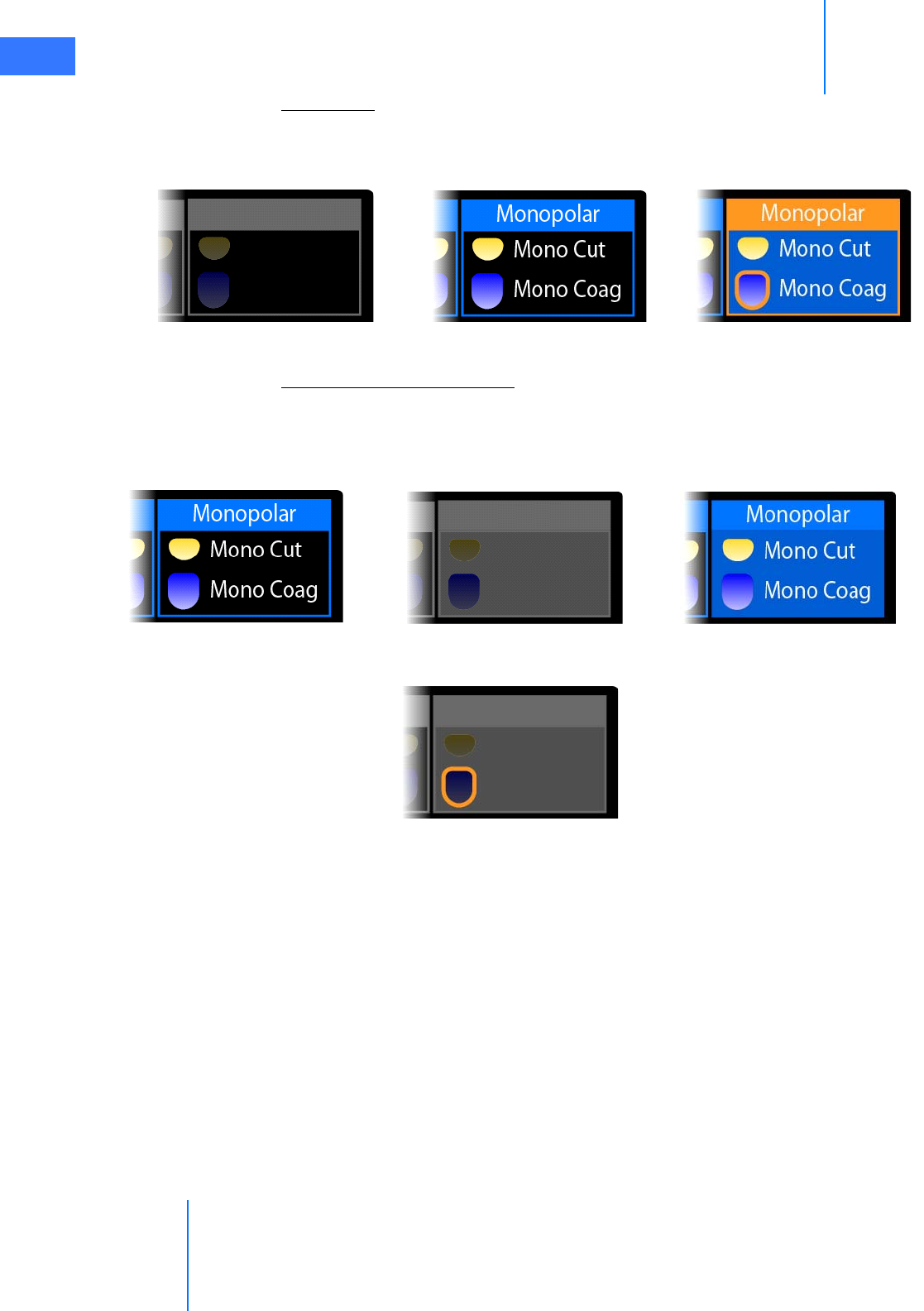
Surgeon Console Use
da Vinci® Si™
10-36
DRAFT/PRE-RELEASE/CONFIDENTIAL
10/9/14
Border Color
The color of the border on each side can be blue, gray or orange: gray signifies that energy is
disabled, or not ready to fire; blue signifies that energy is enabled, or ready to fire; and orange
signifies that energy is firing.
Figure 10.41
Pedal Area Background Colors
Besides the default black, the pedal area background color turns blue when a foot is over
(close to or touching) a pedal pair ready to fire, or gray when over a pedal pair not ready to fire.
When a pedal is pressed, its outline is highlighted orange, whether energy is actually firing or
not.
Figure 10.42 Pedal area background colors
•Black, partially transparent (default): Foot sensors detect nothing
•Gray: Foot detected over a disabled pedal pair
•Blue: Foot detected over an enabled pedal pair
•Orange: Energy firing
Non-SmartPedal: Energy Activation Behavior
The da Vinci Si System displays the following energy activation behavior:
• The system does not support combinations of ESUs or energy instruments that make
pedal controls ambiguous; you cannot be in simultaneous energy control of two
energized instruments of the same type (for example, bipolar and bipolar). The system
blue border = energy enabledgray border = energy disabled orange border = energy firing
blue background: foot overgray background: foot over
orange highlight on pedal = pedal pressed
Pedal is highlighted orange when pressed,
whether enabled or not.
black background (default):
disabled pedal pair enabled pedal pairno foot detected

da Vinci® Si™
Surgeon Console Use 10-37
DRAFT/PRE-RELEASE/CONFIDENTIAL
10/9/14
indicates a disallowed configuration in different ways, depending on the source of
ambiguity. In all cases, the system grays out the energized indicator and does not map a
pedal whose function would be ambiguous.
• The system can activate only one energy instrument at a time: pressing a second pedal
makes the first stop firing, and neither can fire until both pedals are released.
• In dual console mode, if each surgeon controls an energy instrument, the first press of
an energy pedal activates the associated instrument, and other presses are locked out
until the first is ended. When the first press ends, a blocked press must be released
and re-applied before it is effective.
• In dual console mode, pressing the camera control pedal stops firing of energy
instruments on the other console, but not on your own. (It also takes all instruments out
of following mode on both consoles, which means they do not move.)
• The system beeps if you press an energy pedal while energy cannot be activated.
Non-SmartPedal – Simultaneous Energy Control: Disallowed
Combinations
If combinations of the installed energy instruments or connected ESUs make mapping of
energy pedals ambiguous, the system will not map nor activate the pedals for that energy
type. For instance, you can not be in simultaneous energy control of two energized
instruments of the same type (for example, bipolar and bipolar): if a surgeon has bipolar
energy instruments active on both the left and right masters, then he or she will not be able to
activate energy on either instrument.
Disallowed Combinations for Simultaneous Energy Control
On the da Vinci Si system, simultaneous energy control is not allowed for the following
combinations of energy instrument types and ESUs:
• Two of the same type of energy instruments, for example:
• Bipolar and Bipolar
•Monopolar and Monopolar
• Two energy instruments activated by the same pedals, for example:
• Bipolar and PK (both use left pedals)
•Monopolar and Harmonic (both use right pedals)
• Two of the same type of ESU generators
Example: Controlling Two of Same Type of Energy Instrument
When a surgeon has simultaneous control of two of the same type of energy instrument,
neither instrument is mapped to pedals, the energy indicator (lightning bolt icon) is grayed
out, and so are the borders of the footswitch map, as shown:
Figure 10.43 Example: Controlling two of same type of energy instrument
Footswitch map borders grayed out
Energy indicators grayed out
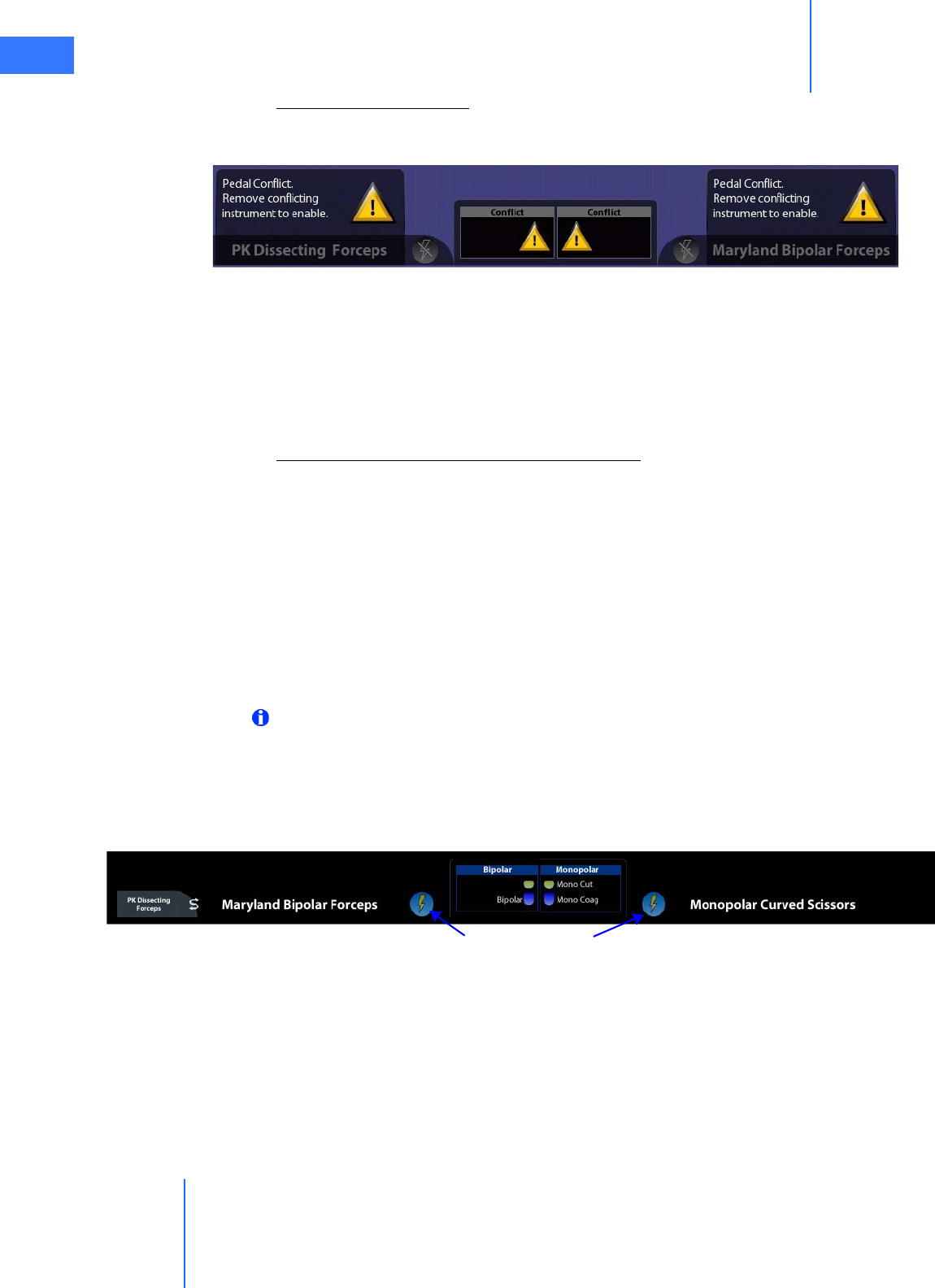
Surgeon Console Use
da Vinci® Si™
10-38
DRAFT/PRE-RELEASE/CONFIDENTIAL
10/9/14
Example of Pedal Conflict
When a surgeon has simultaneous control of energy instruments that use the same pedals,
the system reports a pedal conflict, as in the example shown below.
Figure 10.44 Example of pedal conflict
In Figure 10.44, the PK Dissecting Forceps is installed and active on instrument arm 1, and the
Maryland Bipolar Forceps is installed and active on instrument arm 2. Since the system would
map both instruments to the left pair of energy pedals, the system does not allow either
instrument to fire, because which instrument should fire on a left energy pedal press is
ambiguous. The system disables energy and displays the message shown in Figure 10.44:
“Pedal Conflict. Remove conflicting instrument to enable.”
Two of Same Type of ESU Generators Connected
The system displays an analogous message in red text near the top center of the screen if
pedal mapping is ambiguous due to two of the same type of ESU generators being connected
to the system. The message instructs you to disconnect or power down an ESU.
Non-SmartPedal – Swapping Energy Control: Allowed
Combinations
It is possible to swap between the following combinations of energy instruments, but only if
both instruments are associated with the same master controller:
• between monopolar and Harmonic
• between a bipolar and PK instrument
Note: It is never possible to swap between two monopolar or two bipolar
instruments because they require the same ESU cord.
These combinations permit swapping energy control because the two instruments can never
be in simultaneous control, when they are associated with the same master. An example is
shown in Figure 10.45.
Figure 10.45 Example of an allowed configuration
Here a Maryland Bipolar Forceps is installed on instrument arm 2, a PK Dissecting Forceps is
installed on instrument arm 3, and both arms are associated with the left master. Since both
are on the left master, the surgeon can never simultaneously control both energy instruments.
Therefore energy control ambiguity is impossible. The surgeon can swap control between
these two energy instruments and avoid simultaneous control of a disallowed combination.
The system indicates an allowable combination by highlighting blue the energy indicators
and the borders of the footswitch map.
Footswitch map borders blue
Energy indicators blue
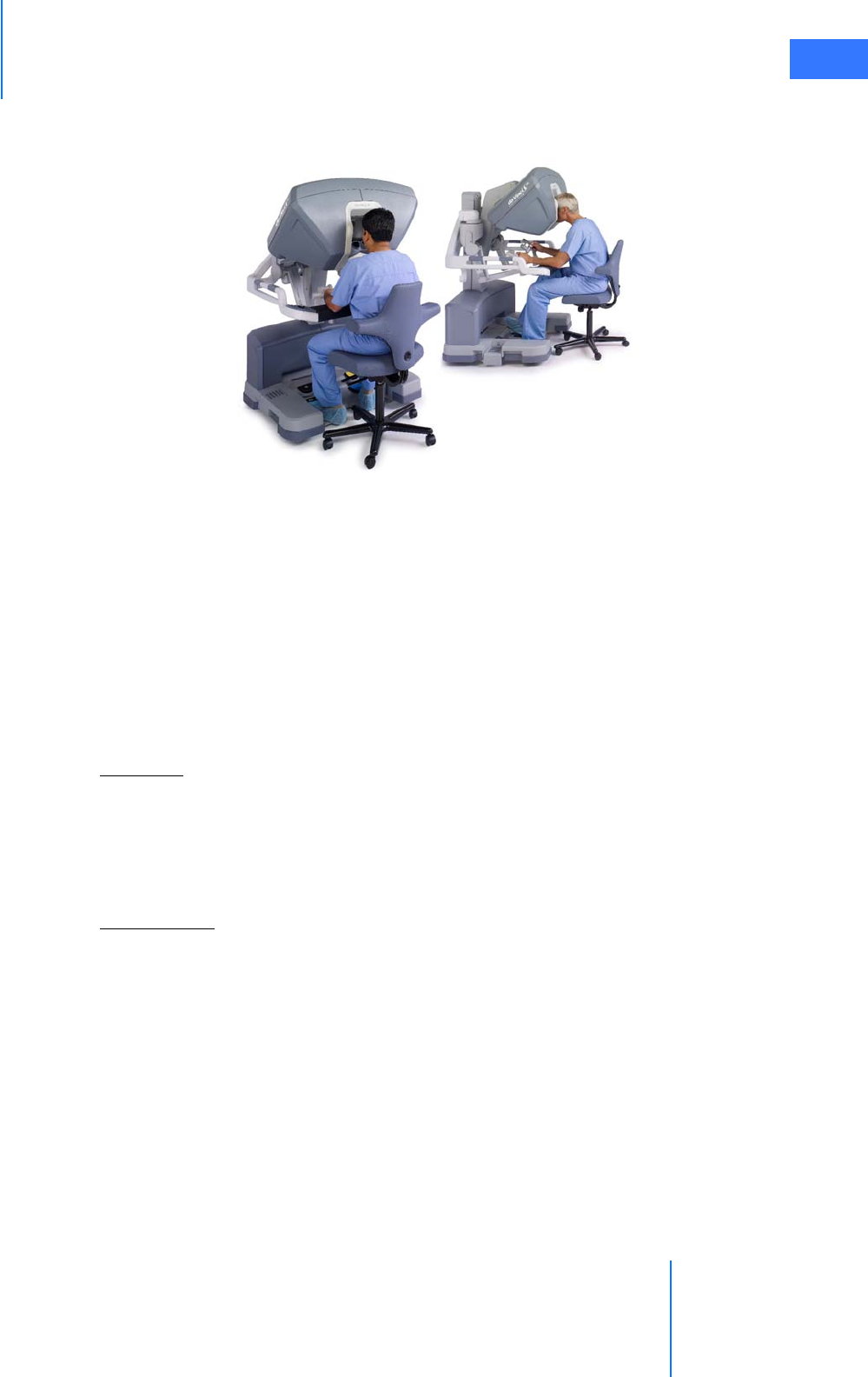
da Vinci® Si™
Surgeon Console Use 10-39
DRAFT/PRE-RELEASE/CONFIDENTIAL
10/9/14
10.5 Dual Console Surgery
This section describes the interface for working with two Surgeon Consoles.
Dual Console Connection and Startup
To operate in dual console mode (using a second Surgeon Console), simply plug the second
console’s system cable in one of the available Fiber ports on the back of the Core. No other
connection is necessary, except of course to plug in the Surgeon Console to a dedicated AC
power outlet. The second Surgeon Console behaves just as the first with respect to power
operations, as described in Chapter 5 Startup.
Comparison Between Consoles
This section describes the relationships between the touchpads, stereo viewers and
instrument controls when two Surgeon Consoles are in use.
Touchpads
Except for the availability of the Give/Take and Swap All buttons, the arm status area
functions the same as usual, reporting arm status to both consoles. Each surgeon controls
independently the touchpad settings that affect only their console and viewer. For example,
one surgeon can apply digital zoom and TilePro in their viewer without affecting the other
surgeon’s viewer.
Stereo Viewers
The stereo viewers act independently except that they share the endoscopic video source and
its associated video settings for view of the surgical field, and the overlays associated with
shared elements like the endoscope (for example, the camera rotation indicator). Each stereo
viewer presents the overlays for instruments that the surgeon controls in the usual places, and
shows information about the instruments the other surgeon controls near the top center of
the stereo viewer. Each surgeon can adjust their view independently, both content and
settings. For example, one surgeon can apply digital zoom and use TilePro in their viewer
without affecting the other surgeon’s viewer. See Comparison Between Consoles on page
10-39 for additional details on what surgeons can see about the instrument status of the other
console.
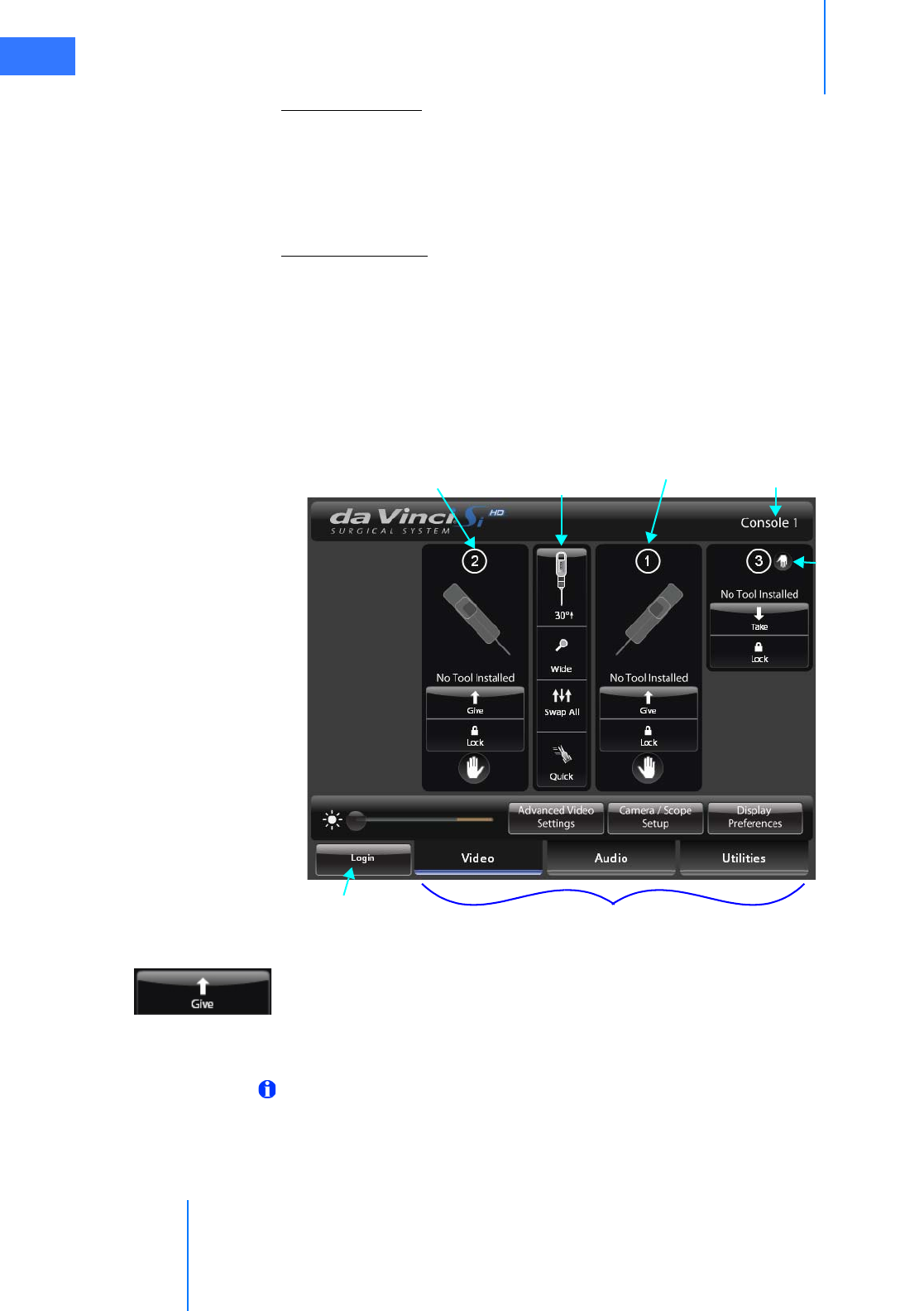
Surgeon Console Use
da Vinci® Si™
10-40
DRAFT/PRE-RELEASE/CONFIDENTIAL
10/9/14
Instrument Control
The instrument control settings, in particular motion scaling, operate independently for each
Surgeon Console. When instrument control is transferred, the instrument goes out of
following until the surgeon assuming control matches grips in the usual way (see Matching
Grips on page 10-22). When she takes control, she does so using the control settings selected
at her console.
Master Associations
The system gives both surgeons the ability to reassign instruments to different masters, and
this feature continues to operate in dual console mode. The new instrument assignment
applies on both consoles and persists when instruments are swapped. For details, see Master
Associations on page 10-21.
Instrument Control
When the system detects two Surgeon Consoles in use, the Give/Take and Swap All buttons
on the touchpad home screen appear.
Figure 10.46 Dual console home screen
•Give/Take button: This button says “Give” when you have control and “Take” when you
do not have control at your console. Either surgeon can Give or Take control of a specific
instrument arm by touching its Give or Take button. When control is transferred by
touching Give or Take, the instrument goes out of following until the surgeon assuming
control matches grips in the usual way (see Matching Grips on page 10-22).
Note: During dual console surgery, you can give or take a locked instrument arm using
the Give/Take button on the touchpad home screen. Instrument arms remain locked
when transferred until unlocked at the touchpad in the usual way.
Scope status
angle, magnification
Arm 3 status
Arm 1 Status
Arm 2 status
Login/Logout Function tabs
Console 1 or 2
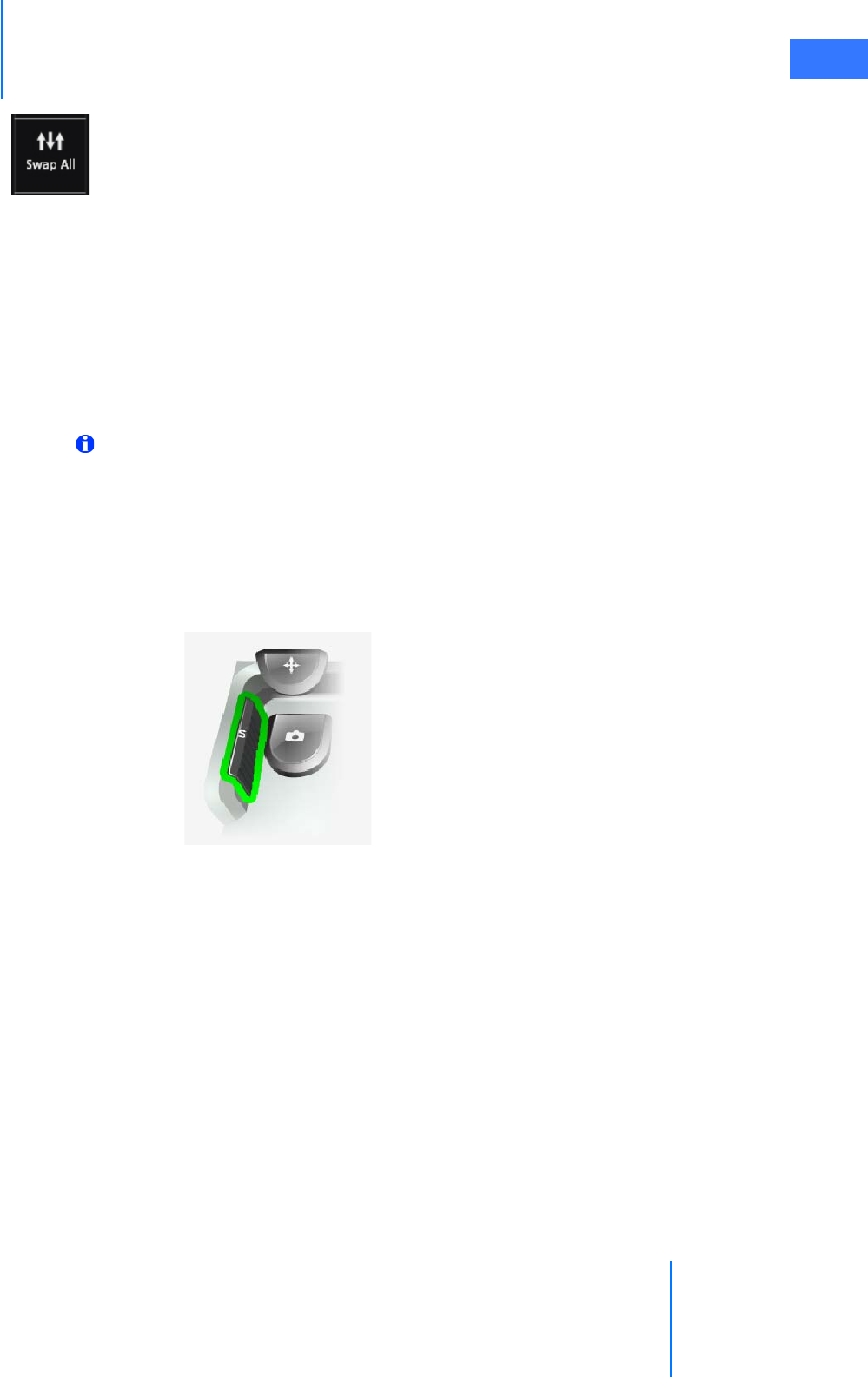
da Vinci® Si™
Surgeon Console Use 10-41
DRAFT/PRE-RELEASE/CONFIDENTIAL
10/9/14
•Swap All: Either surgeon can change control of all (instrument) arms by touching Swap
All. Energy control follows the instrument arm. All instruments go out of following after
Swap All is touched until the surgeon assuming control matches grips as usual (see
Matching Grips on page 10-22).
Swap All affects all 3 instrument arms (not the endoscope). However, if Surgeon A con-
trols no arms before the swap, Surgeon A can control only up to two arms when he
matches grips after the swap. He or she must first match grip on the two instruments that
were in following with the other surgeon before the swap; the third arm will remain out
of following as it was. To take control of the third instrument, he or she must press the
arm swap pedal (left kick-plate) as usual.
•Lock: The surgeon with control can use the Lock button to lock the instrument in place
as usual, and unlock a locked arm to enable control of it. The current lock status shows on
both Surgeon Consoles.
Note: In dual console mode, either surgeon can use the Master Associations screen (see
page 10-21) to reassign instruments to different masters – even while the other surgeon
has control of the instruments. The new instrument assignment applies on both
consoles and persists when instruments are swapped. The system notifies the surgeons
as usual when reassignment occurs.
• When instruments are reassigned via the Master Associations screen, the system takes
the instruments out of following, notifies and prompts you with the icon and associated
message below:
Figure 10.47 Icon and message when instruments reassigned
Camera Control
Either surgeon can take control of the camera arm by pressing the camera pedal as usual; the
first one to do so has camera control and, as usual, all instrument arms go out of following
while the camera arm is under control, and energy instruments on the other Surgeon Console
will stop firing.
Video Control
While in dual console mode, video settings are shared between the two Surgeon Consoles as
well as the touchscreen monitor on the Vision Cart. Video settings are not saved while in dual
console mode.
Your instruments have been reassigned.
Tap ‘Arm Swap’ pedal to acknowledge
and continue.
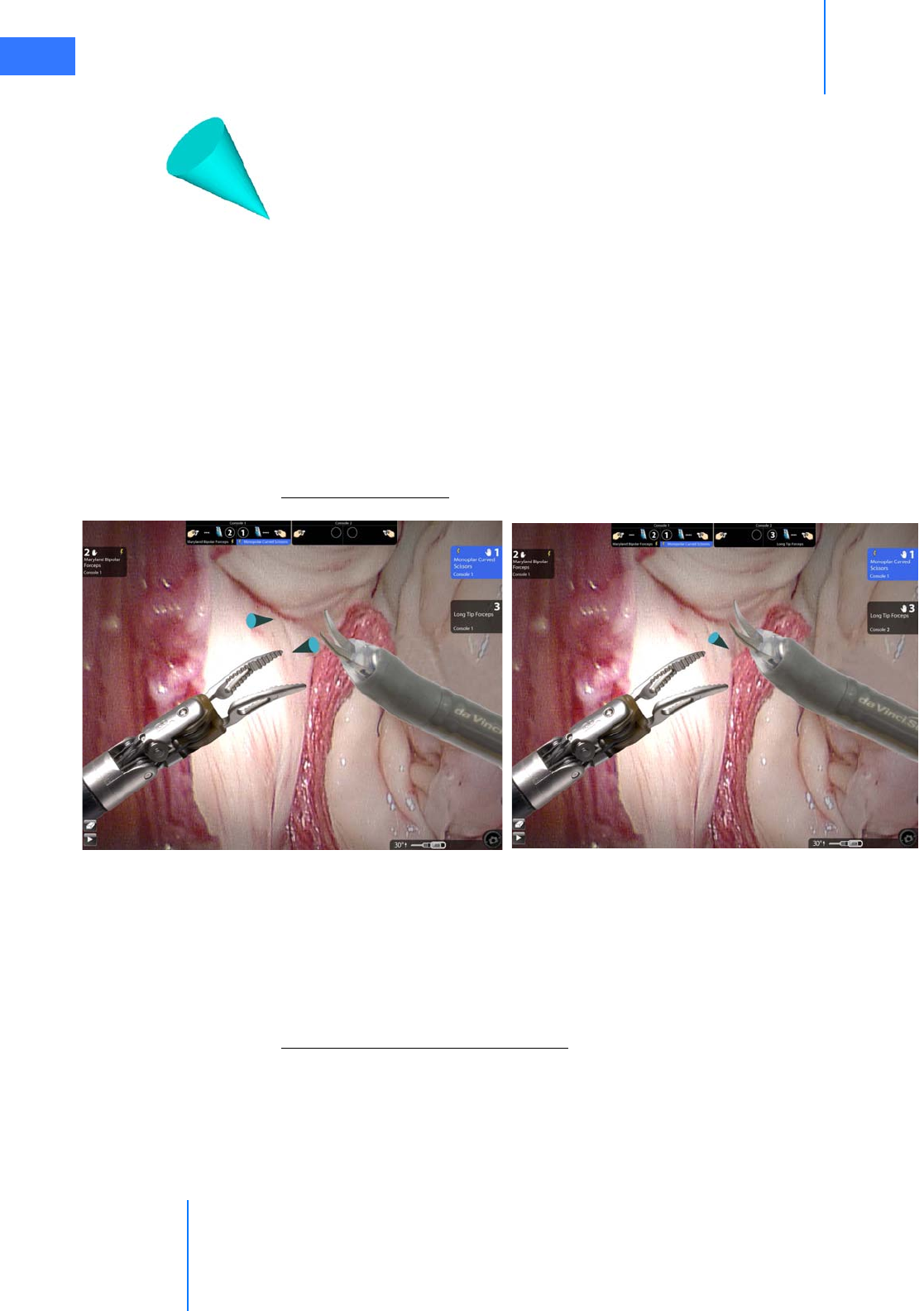
Surgeon Console Use
da Vinci® Si™
10-42
DRAFT/PRE-RELEASE/CONFIDENTIAL
10/9/14
Virtual Pointer (Dual Console Teaching Aid)
The virtual pointer is a software tool designed as an instructional aid, typically for use during
dual console surgery. The pointer is a three-dimensional (3D) graphical object, light blue and
conical in shape, which appears overlaid on the live video image when activated. It enables a
surgeon to point and refer to specific anatomical features on the live video image
intraoperatively. The surgeon can activate and control one pointer with each master that is
not associated with an instrument arm. Normally, an unassociated master is available only
during dual console surgery. It is possible to activate two pointers simultaneously, as
described in the usage scenarios below.
Virtual Pointer Usage Scenarios
Since a pointer can be activated only by a master not associated with an instrument arm, you
can arrange the usage scenarios below by setting master associations and giving or taking
instrument arm control on a given Surgeon Console. Set master associations by going to
Utilities > Control Preferences and touching Configure next to Master Associations. Give
or take instrument arm control using the Give/Take button on the dual console home screen.
Typical Usage Scenario
Figure 10.48 Typical dual console usage for proctoring
In the typical usage scenario, a proctor surgeon at Surgeon Console 2, which controls either
one or no instrument arms, is providing guidance to a surgeon being proctored at Surgeon
Console 1, which controls 2 or 3 instrument arms. The proctor surgeon would use one or two
unassociated masters to activate one or two pointers, and then use each pointer to refer to
anatomical features while speaking with the surgeon being proctored.
One Pointer Controlled at Each Console
In a less typical scenario, both Surgeon Console 1 and Surgeon Console 2 can have one
unassociated master and therefore each surgeon can activate one pointer as desired. In this
scenario, one surgeon would have control of two instrument arms associated with the same
master, and the other surgeon would have control of the other instrument arm, so that one
master on each console is not associated with an instrument arm.
Dual console, 2 pointers Dual console, 1 pointer

da Vinci® Si™
Surgeon Console Use 10-43
DRAFT/PRE-RELEASE/CONFIDENTIAL
10/9/14
Note: It is possible to activate the pointer when using a single Surgeon Console if the
third arm is stowed. For example, if arm 3 is stowed and you associate arms 1 and 2 with
the left master, the right master can be used to activate the pointer.
Use Characteristics
The virtual pointer has the following use characteristics:
• By closing the grips of an unassociated master, the surgeon activates a virtual pointer. Its
initial position is vertically centered and slightly offset right or left in correspondence
with the master used. At a console having neither master associated with an instrument
arm, the surgeon can activate two pointers simultaneously by closing the grips of both
masters.
• While a pointer is activated, the master controlling it is free to move. The surgeon
manipulates the position and orientation of the pointer using the master while holding
the grips closed. The pointer’s tip corresponds to the fingertips closing the grips.
• As part of the 3D effect, the pointer is shaded as if the light comes from where you are
looking, and it gets smaller as you move it away from you, and larger as you move it
back towards you. It has vanishing points left and right, near and far, past which you
can bring it back on screen if you do not release the grips. If you do release the grips
while past a vanishing point, the pointer reappears in its default position when you
close the grips again.
• If telestration marks are on screen, they are erased when the pointer is activated, and
telestration is not available while the pointer is activated.
• You can clutch the master while the pointer is active to reposition the master without
moving the pointer.
• The pointer disappears when the surgeon releases the grips and while a surgeon presses
the camera pedal (during camera control mode). The master that controlled the pointer is
not free to move when the pointer is not present, except by clutching the master as usual.
• On subsequent activations, the pointer appears in its last position, unless that position is
such that it would be off screen. In that case, it reappears in its initial position.
_________________________________End of section______________________________
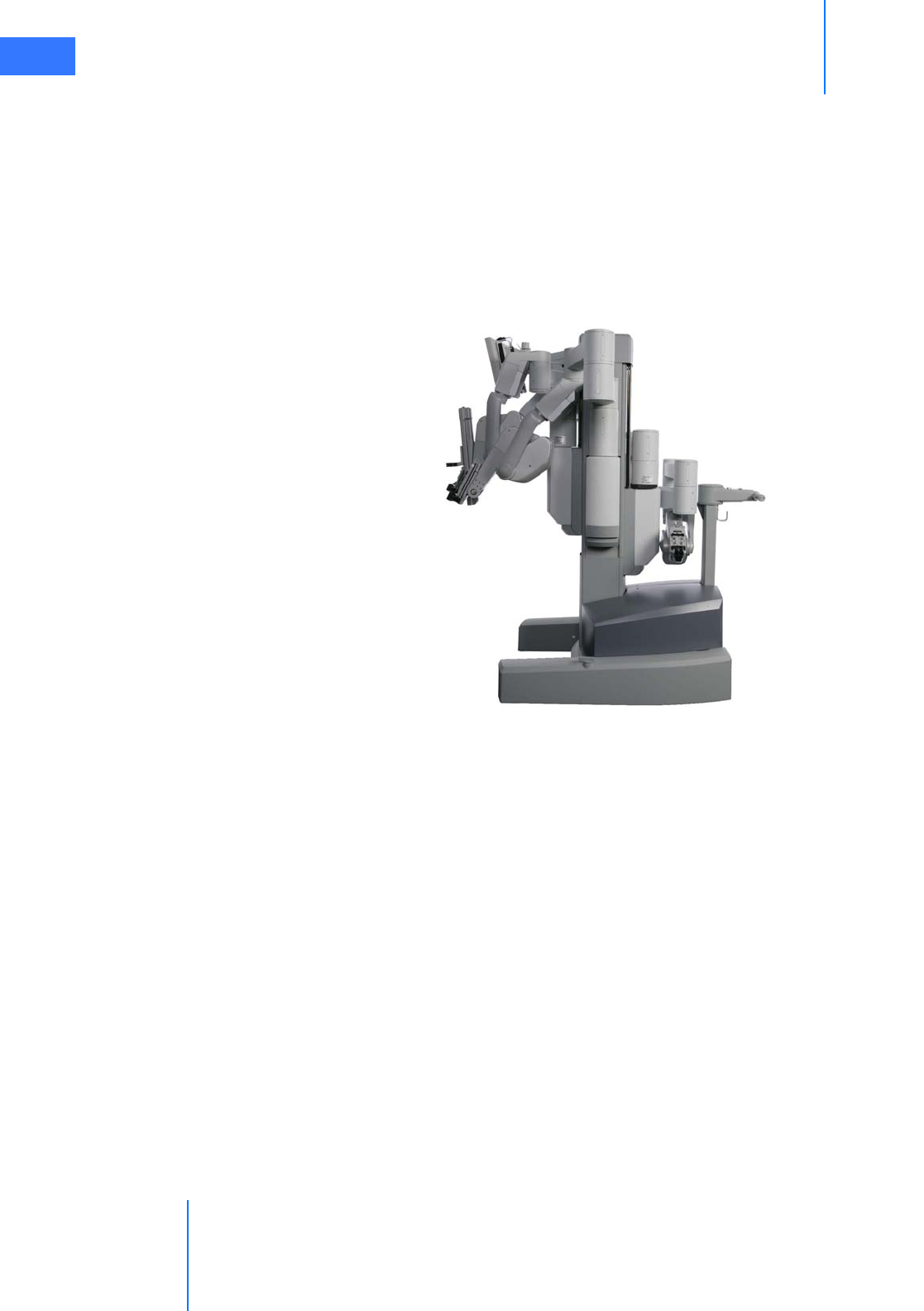
System Shutdown and Storage
da Vinci® Si™
11-1
DRAFT/PRE-RELEASE/CONFIDENTIAL
10/9/14
11System Shutdown and Storage
This chapter explains the following:
•11.1 Preparing the System for Shutdown, page11-1
•11.2 Inventory Management, page 11-2
•11.3 Shutting Down the da Vinci Si System, page 11-3
•11.4 Storing the System, page 11-4
Figure 11.1 Patient Cart in stow position, ready for storage
11.1 Preparing the System for Shutdown
1. Remove the instruments and endoscope from the Patient Cart.
2. Disconnect the cannulae from the instrument and camera arms.
3. Use the port clutch buttons to move the instrument and camera arms away from the
patient.
4. Move the Patient Cart away from the OR table.
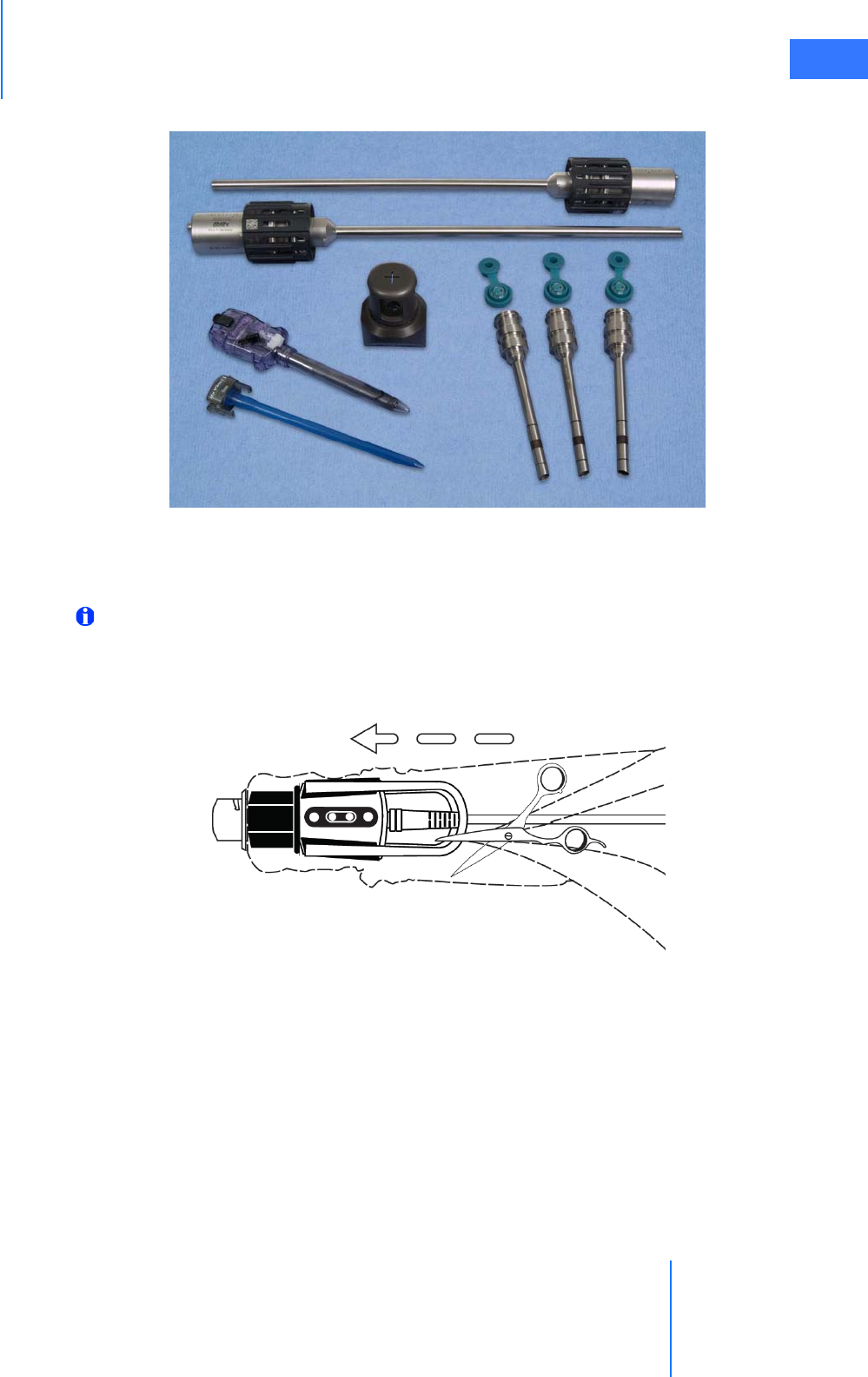
da Vinci® Si™
System Shutdown and Storage 11-2
DRAFT/PRE-RELEASE/CONFIDENTIAL
10/9/14
5. Remove all sterile system accessories for cleaning.
Figure 11.2 System accessories
For instructions on cleaning system components, see 12.2 System Cleaning on page 12-1.
6. Remove and properly dispose of all drapes.
Note: Users will find it easier to separate the camera head from the sterile adapter by
first cutting off the camera head drape, as indicated by the label on the drape itself,
shown here.
Figure 11.3 Cut off camera head drape to remove sterile adapter
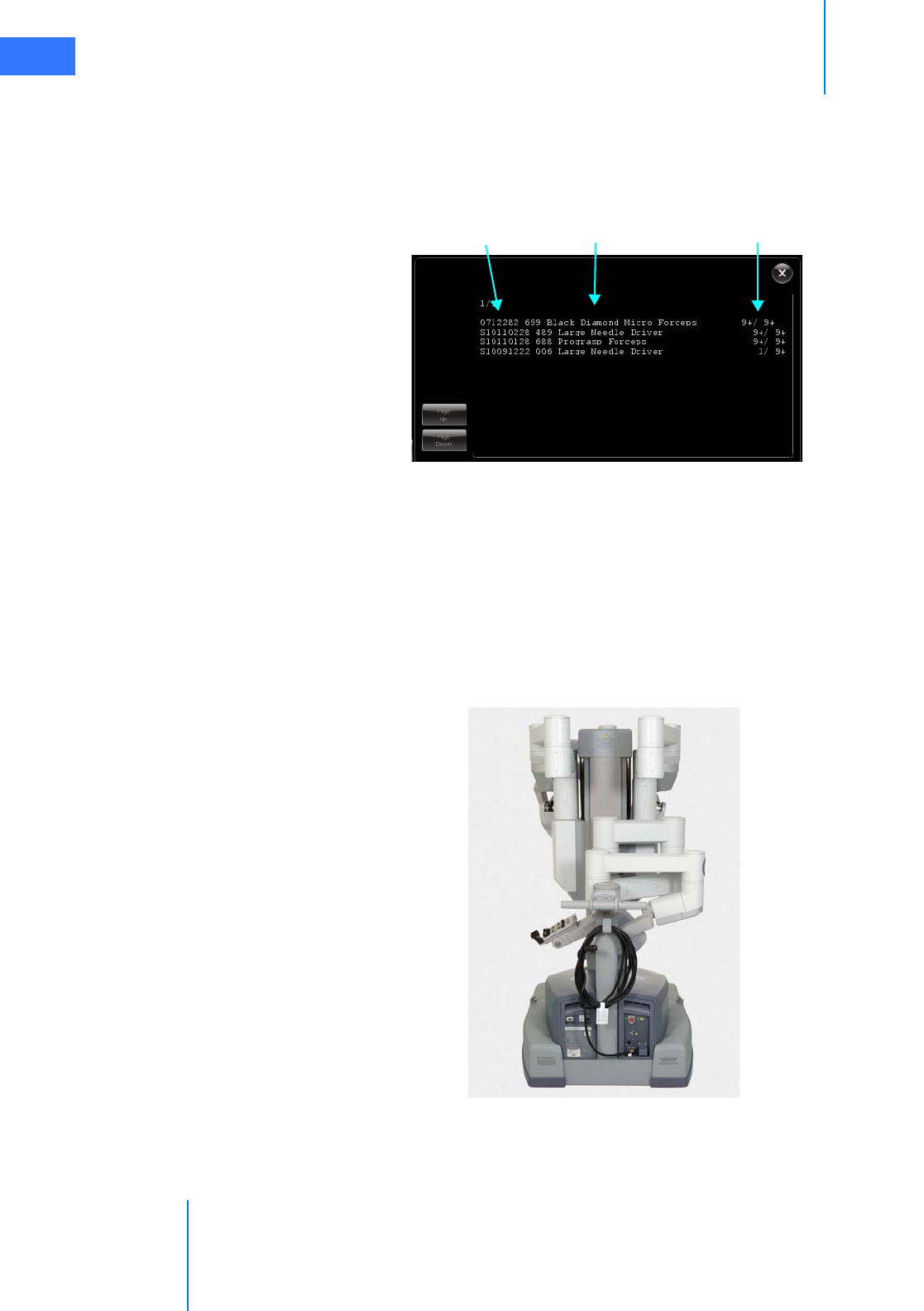
System Shutdown and Storage
da Vinci® Si™
11-3
DRAFT/PRE-RELEASE/CONFIDENTIAL
10/9/14
11.2 Inventory Management
You can view the number of uses left for all instruments used during the current procedure by
accessing Inventory Management on the Utilities tab of the touchscreen (see page 7-20) or
the touchpad (see page 10-18).
Figure 11.4 Usage Summary
For instruments that expire after a certain number of procedures, the system displays the
number of uses or activations left out of uses allowed in the right column. See Instrument
Usage on page 9-14 for details on how the system tracks usage.
11.3 Shutting Down the da Vinci Si System
1. Prepare the Patient Cart for storage by folding the setup joints against the cart as shown
in Figure 11.5. Instrument arm 3 should be placed in the stow position. (See Stow Position
on page 5-7 for details on preparing the Patient Cart for stow position.)
Figure 11.5 Patient Cart in the stow position
Serial Number Description
Uses Left

da Vinci® Si™
System Shutdown and Storage 11-4
DRAFT/PRE-RELEASE/CONFIDENTIAL
10/9/14
2. Press any system Power button. The system will begin the ten second shutdown process
and displays the following message:
Preparing to shutdown.
Press Power to reverse within 10 seconds.
Note: If the system is not restarted within ten minutes after power down, the system will
view any restart as a new procedure and instrument uses will be decremented
accordingly.
Note: Cooling fans on the Patient Cart and the Core (Vision Cart) run continually when
either is plugged into AC. This is part of normal operation. Do not use the Patient Cart
Emergency Power Off (EPO) button to turn off the cooling fans. This will prevent the
Patient Cart battery from charging.
3. It is now safe to disconnect all system cables, although we recommend that you leave
them connected to minimize exposure of the connectors to contaminants.
Note: If possible, the system cables should be left connected to minimize exposure to
contaminants.
Should you need to detach system cables, follow these steps:
1. Remove non-system connections as necessary (such as auxiliary video and audio cables,
ESUs, insufflators, etc.)
2. Disconnect system cables from the Surgeon Console and Patient Cart by twisting
counter-clockwise and pulling back on the metal collar.
Note: Immediately attach the protective cap to protect the connectors from
contamination and physical damage.
3. Store the system cables on the side of the Vision Cart.
11.4 Storing the System
Follow these steps to store the da Vinci Si System:
1. Ensure the storage room meets the following specifications:
a. Room temperature between -10 to 55 °C (14 to 131 °F).
b. Relative humidity between 10 to 85% non-condensing
2. Place the Patient Cart near a wall outlet and plug it into AC power.
Note: To maintain battery backup charge, it is important to keep the Patient Cart
plugged into AC power while stored. Failure to do so will drain the batteries. The
Surgeon Console and Vision Cart do not need to be plugged into AC power.
Note: A cooling fan continues to run on the Patient Cart when plugged into AC power. Do
not use the Patient Cart Emergency Power Off (EPO) button to turn off the cooling fan.
This will prevent the Patient Cart battery from charging.
_________________________________End of section______________________________

Cleaning and Maintenance
da Vinci® Si™
12-1
DRAFT/PRE-RELEASE/CONFIDENTIAL
10/9/14
12Cleaning and Maintenance
This chapter covers the following subjects:
•12.1 System Maintenance, page 12-1
•12.2 System Cleaning, page 12-1
•12.3 Illuminator Lamp Module Replacement, page 12-2
•12.4 CCU Fuse Replacement, page 12-6
12.1 System Maintenance
Preventive maintenance is required and must be performed by an authorized Intuitive Surgical
Service Representative. There are no user-serviceable parts on the main system components,
with the exception of the Illuminator.
WARNING: Do not service or perform maintenance on the da Vinci Si System while in use
with a patient unless noted otherwise.
For Technical Support
If the system requires maintenance or service, please call our Technical Support line. In the US,
call 1-800-876-1310, where phones are staffed 24 hours a day, seven days a week. In Europe,
call +41.21.821.2020.
12.2 System Cleaning
Surgeon Console, Patient Cart, Vision Cart, System Cables
Use a soft, lint-free cloth and a surface disinfectant product (or a pre-moistened disinfectant
wipe product) to wipe the exterior surfaces of the system components and cabling at the
frequency required by individual hospital policy. Examples of these products include
Envirocide®, CaviCide®, deconex® S-WIPES, neodisher® neoform MED rapid and 70% isopropyl
alcohol or the corresponding pre-moistened disinfectant wipe product. Allow components to
dry before use. If any liquids – including bodily fluids – get inside the system, contact ISI
Technical Support.
CAUTION: Equipment on the Vision Cart, Patient Cart and Surgeon Console is not
designed for exposure to liquids. Care should be taken to ensure liquids do not come
into contact with electronic equipment on the system components.
Note: In particular, do not submerge the camera and camera cables. They are not
designed to be submerged and could be damaged if fluid gets inside them.
Note: Pay particular attention to areas where the Surgeon Console operator comes into
contact with the system (such as the master controller grips, the stereo viewer, and the
armrest).
Note: The system cables and their receptacles contain fiber-optics. Only when requested
by Intuitive Surgical personnel, clean both cable and receptacles by blowing the fiber
ends with a generic dry and oil-free canned air duster.

da Vinci® Si™
Cleaning and Maintenance 12-2
DRAFT/PRE-RELEASE/CONFIDENTIAL
10/9/14
Cleaning the Touchscreen Display
Follow your hospital protocol for the handling of blood and body fluids. Clean the display with
a diluted mixture of mild detergent and water. Use a soft towel or swab. Use of certain
cleaning agents may cause degradation to the labels and plastic components of the product.
Consult cleanser manufacturer to see if agent is compatible with it. Do not allow liquid to
enter the display.
Instrument Release Kit
Clean and sterilize the instrument release kit in the same way as the grip release tool. For grip
release tool cleaning and sterilization instructions, refer to the Reprocessing Instructions (PN
550875).
12.3 Illuminator Lamp Module Replacement
WARNING: During operation, the lamp gets very hot, even if lit only for a short time.
After turning off the lamp, allow the internal fans to cool the lamp for 5 minutes before
removing power to the Illuminator.
WARNING: Use ONLY approved lamp modules. Use of a non-approved lamp may result
in premature failure or severe damage.
CAUTION: The Illuminator lamp module should be replaced every 1000 hours.
The Cermax VQ Xenon Lamp module typically provides more than 1000 hours of service. It
should be replaced every 1000 hours to avoid periods of diminished light output or lamp
failure during a procedure. The symptoms indicating the need for replacement are:
• Repeated ignition attempts without lamp going into operation.
• Evident low light output at maximum light level setting.
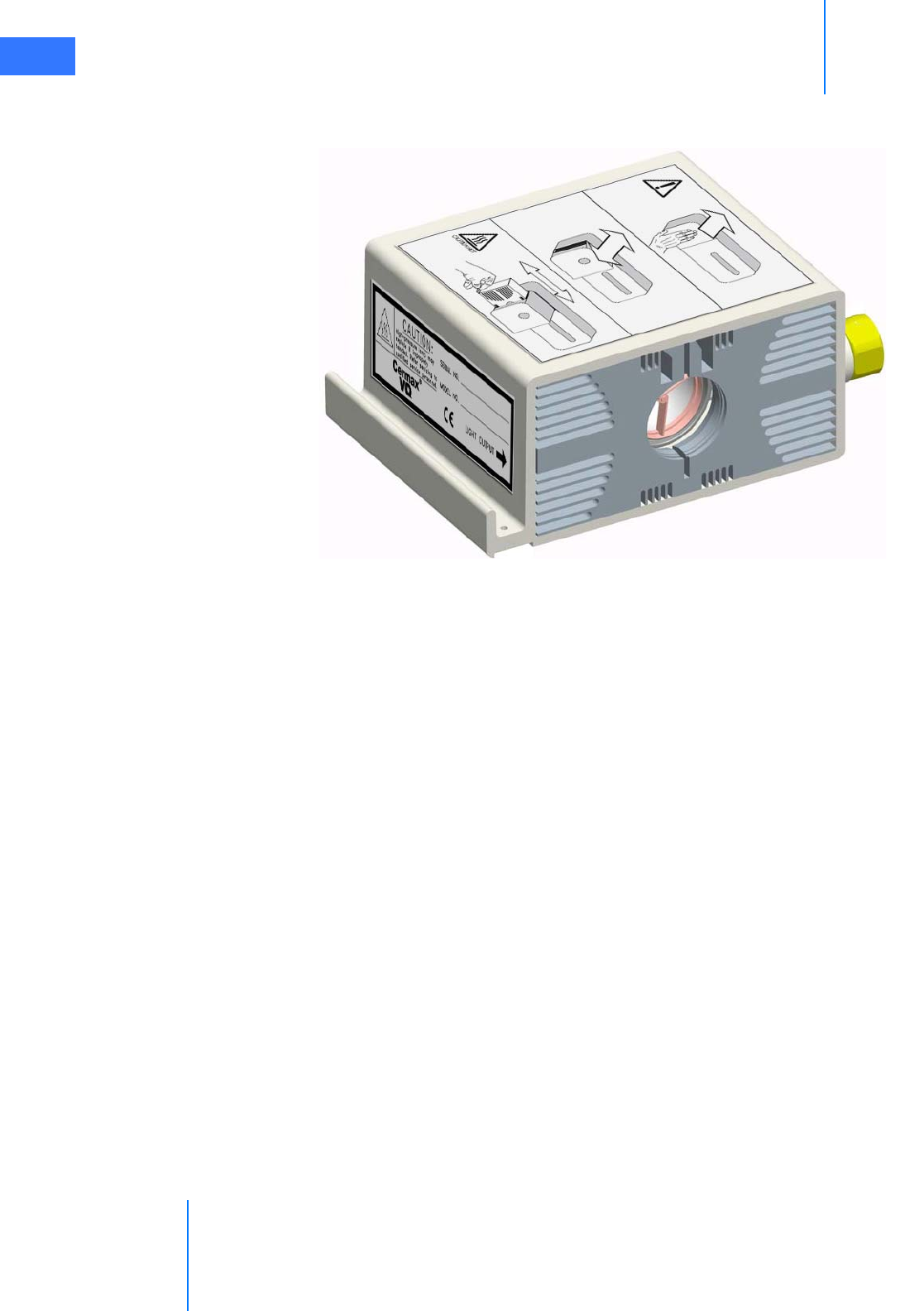
Cleaning and Maintenance
da Vinci® Si™
12-3
DRAFT/PRE-RELEASE/CONFIDENTIAL
10/9/14
When the lamp requires changing, you must replace the complete lamp module. The lamp
and heat sinks are installed as a complete unit as shown below.
Figure 12.1 Cermax VQ Xenon Lamp Module
The module is designed for simple and quick changing, but should be performed by qualified
personnel.
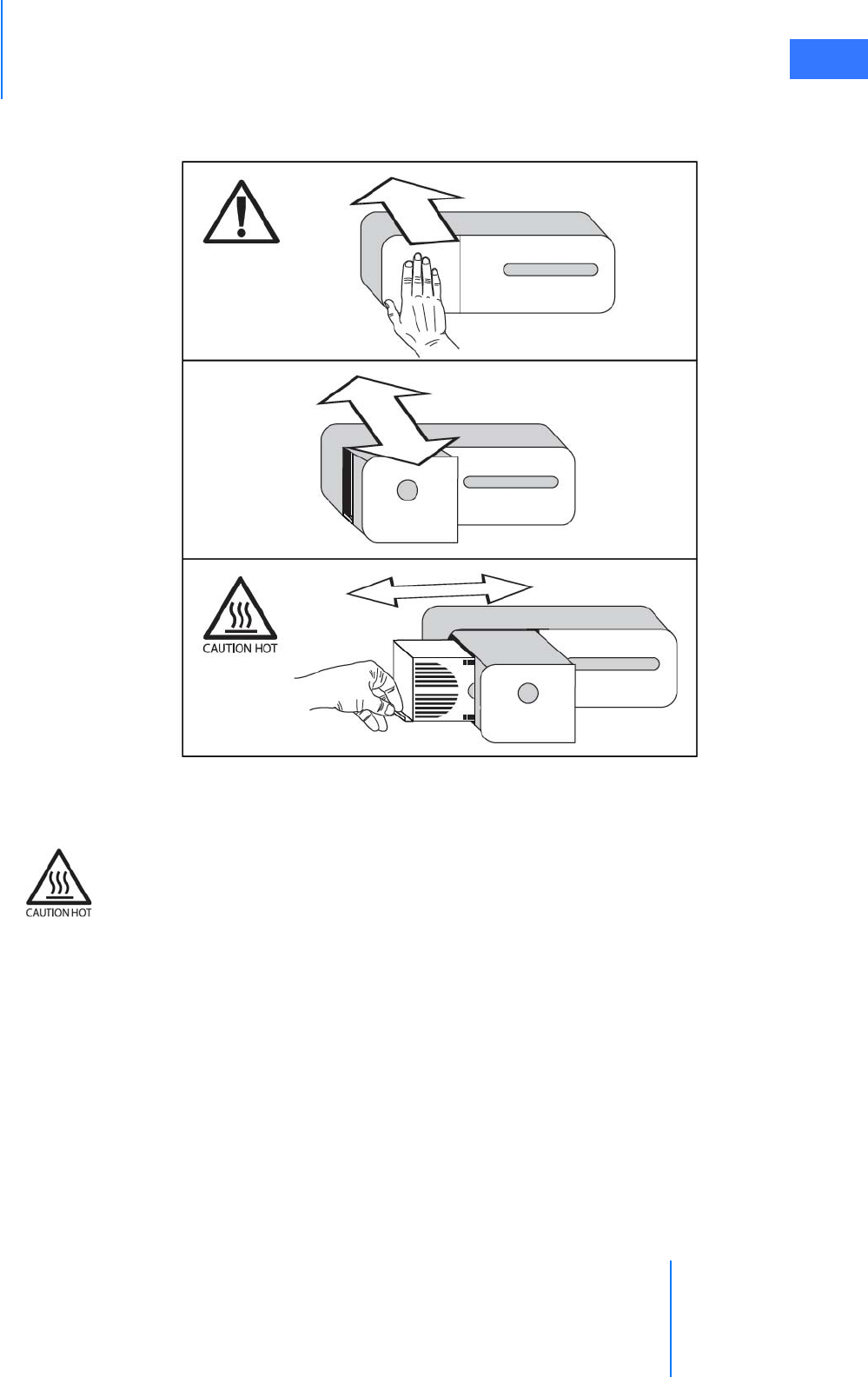
da Vinci® Si™
Cleaning and Maintenance 12-4
DRAFT/PRE-RELEASE/CONFIDENTIAL
10/9/14
The following image shows the label affixed to the lamp module itself, and explains pictorially
the steps to replace the lamp module.
Figure 12.2 Lamp module replacement label—on lamp module
To remove the old lamp module:
1. Turn the Illuminator off by pressing the Lamp On/Off button.
CAUTION: Hot. Wait 10 minutes while system is cooling with internal fan operation.
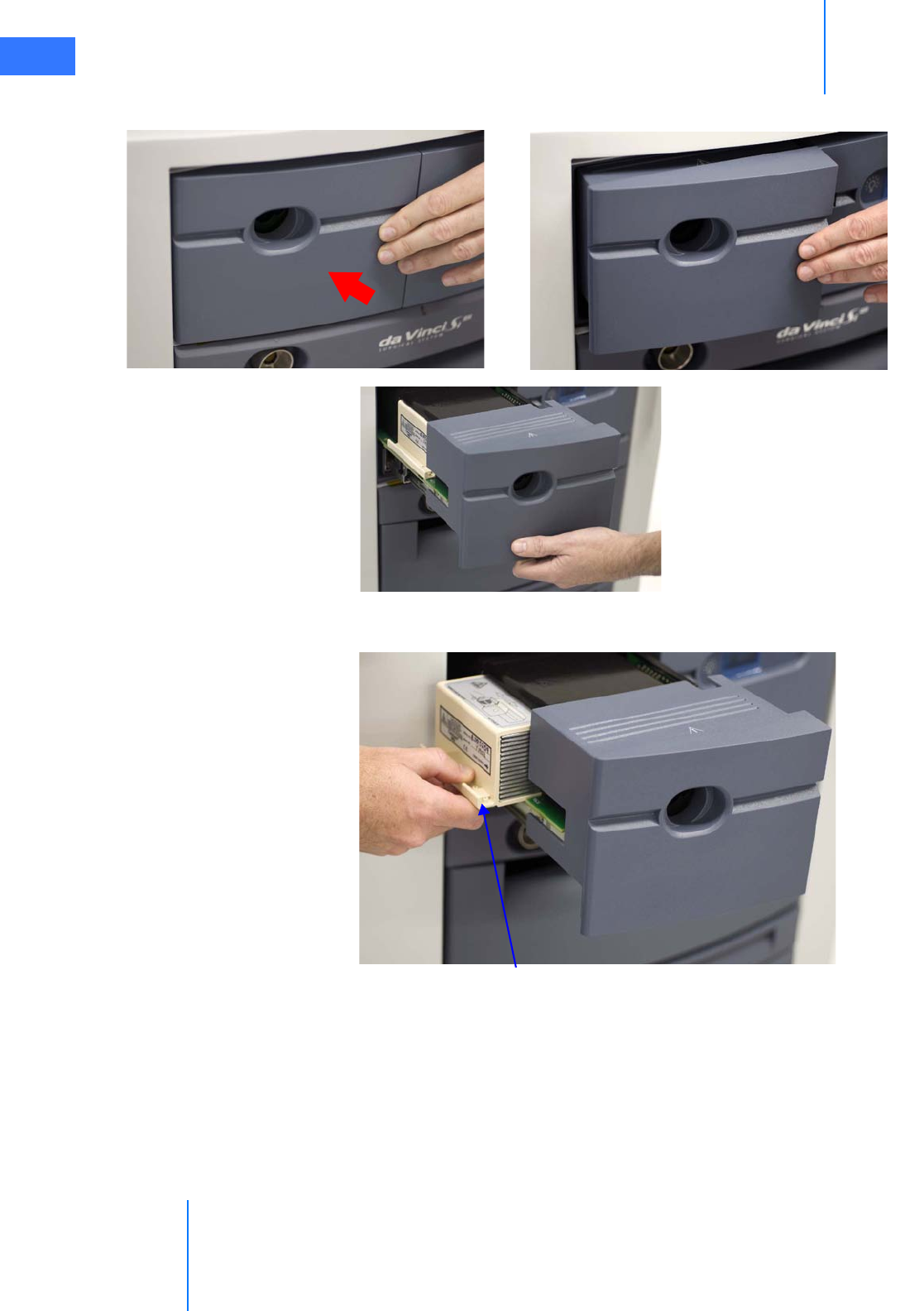
Cleaning and Maintenance
da Vinci® Si™
12-5
DRAFT/PRE-RELEASE/CONFIDENTIAL
10/9/14
2. Push inward to open the access drawer on the left side (front) of the Illuminator.
Figure 12.3 Open the access drawer
3. Grasp the handle and pull the entire lamp module out as shown.
Figure 12.4 Grasp handle and remove module
Push in to release Released
Pull out drawer
Handle
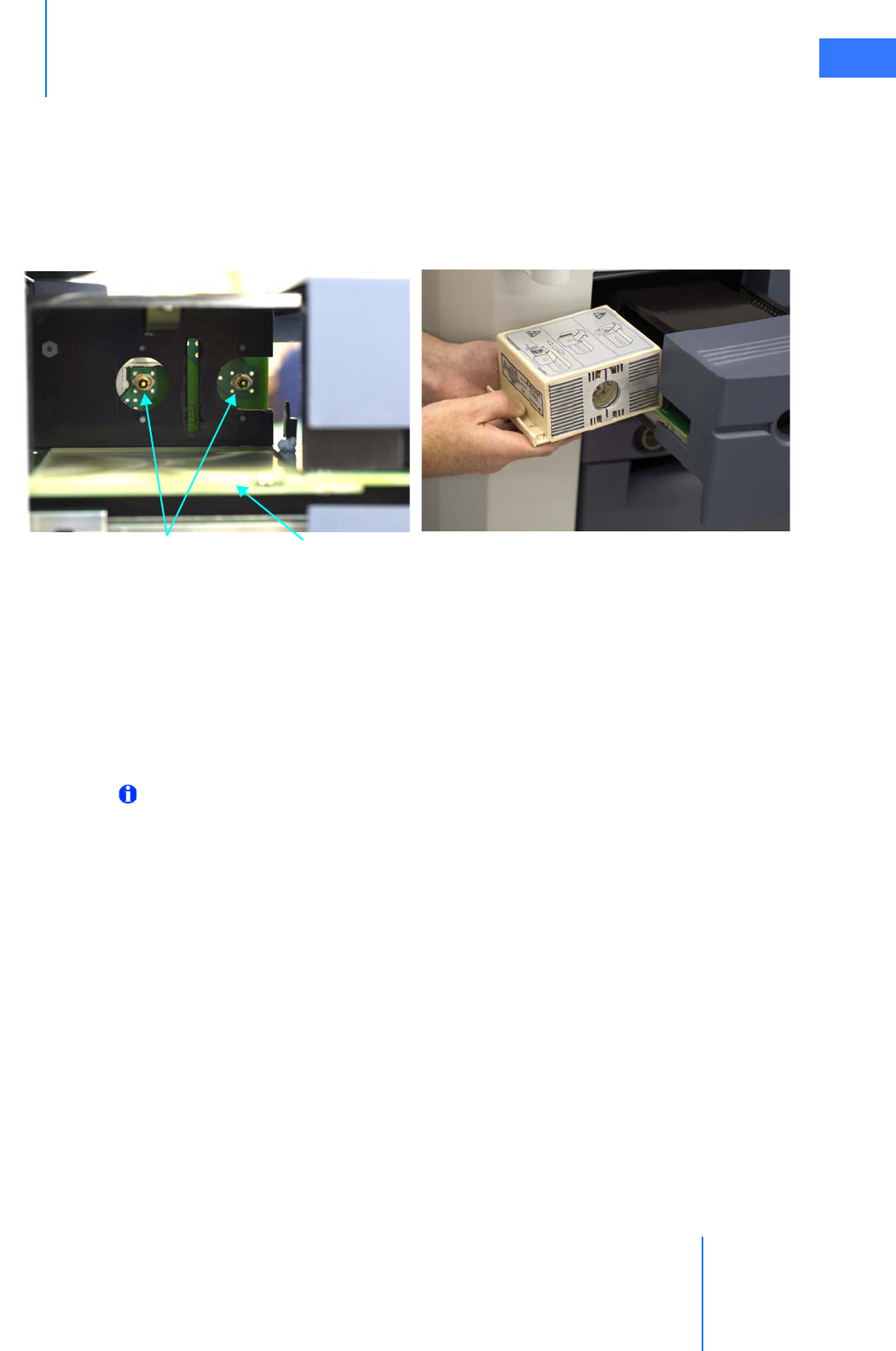
da Vinci® Si™
Cleaning and Maintenance 12-6
DRAFT/PRE-RELEASE/CONFIDENTIAL
10/9/14
To insert new lamp module:
1. Orient the new lamp module so the lamp window faces the front of the Illuminator,
handle on the bottom.
2. Carefully align the sides of the module and place in the receiver channel (see Figure 12.5).
To ensure proper connection, firmly push the module as far as it will insert. The edge of
the module will be flush with the sides of the drawer once connected.
Figure 12.5 Installing new lamp module
3. Close the drawer firmly so it is fully engaged.
For assistance replacing the lamp, call our Technical Support line. In the US, call
1-800-876-1310, where phones are staffed 24 hours a day, seven days a week. In Europe, call
+41.21.821.2020.
12.4 CCU Fuse Replacement
This section contains instructions to replace the fuse in the Camera Control Unit (CCU).
Note: Intuitive designed the CCU fuse not to blow during normal operation over the life
of the system. A blown CCU fuse is a likely indicator of a technical issue that requires
maintenance by Intuitive Surgical personnel. Therefore, if you have a problem powering
on the CCU, we strongly recommend you do not attempt fuse replacement without first
calling Intuitive Surgical Technical Support. The following instructions are provided as
reference material.
Troubleshooting a CCU Power Problem
If the CCU appears not to be powered on while the rest of the system is powered on, first
check that the CCU power switch, next to the power cord inlet on the back of the CCU, is
switched on. Then check that the mains circuit breaker of the Vision Cart is in the on position
(indicated by “I” near the switch). Finally, check that the Vision Cart is connected to a
dedicated, working AC power outlet, and that the system is powered on. CCU fuse
replacement may be warranted only when the rest of the system and other Vision Cart
components power on normally, while only the CCU does not. Again, if this is the case, we
recommend you contact Intuitive Surgical Technical Support for assistance. The following
instructions are provided as reference material.
Connectors Receiver channel

Cleaning and Maintenance
da Vinci® Si™
12-7
DRAFT/PRE-RELEASE/CONFIDENTIAL
10/9/14
CCU Fuse Replacement Instructions
To replace the fuse on the Camera Control Unit, follow these steps:
1. For safety, remove power from the da Vinci Si Surgical System as follows:
a. With the system already in standby (sleep) mode, switch off the mains circuit breaker
of the Vision Cart.
b. Unplug the Vision Cart and other main system components from their AC wall outlets.
c. Switch off the CCU power switch next to the power cord inlet.
2. Remove the CCU power cord from the power inlet next to the CCU power switch and fuse
housing. The fuse housing latches on the power cord when it is in place, preventing
removal of the fuse housing unless the power cord is removed first.
3. The fuse housing is located between the power cord inlet and the CCU power switch on
the back of the CCU. To remove the fuse housing with the fuses inside, use one or two
very small, flat-bladed screwdrivers. If you use one screwdriver, you must pry inward on
each of the thin latching tabs on the top and bottom of the fuse housing in succession. If
you use two screwdrivers, one in each hand, you can pry the tabs at each end inward at
the same time to clear the latches.
4. When you clear the latches on top and bottom, the fuse housing will be loose and you
can remove it carefully with your fingers. Both fuses will be retained in the housing you
remove.
5. Inspect both fuses and replace any blown fuse. A blown fuse has a broken wire filament.
For continued protection against fire hazard, replace the CCU fuse only with the same
type, specified here:
•Manufacturer: Schurater AG
•Fuse Type: FST, Time Lag
•Ratings: 2 A, 250 V
6. Replace the fuses in the fuse housing and re-install it in the same orientation. The
housing is keyed and will prevent you from installing it in the wrong orientation. Push the
housing in all the way until it clicks in place audibly, and is flush with the surrounding
surface.
7. Switch on the power switch on the back of the CCU; switch on the mains circuit breaker of
the Vision Cart and plug the Vision Cart and all other system components into their
dedicated AC power outlets.
For Technical Support
If the system requires maintenance or service, please call our Technical Support line. In the US,
call 1-800-876-1310, where phones are staffed 24 hours a day, seven days a week. In Europe,
call +41.21.821.2020.
_________________________________End of section______________________________

da Vinci® Si™
Appendix A: Error Handling A-1
DRAFT/PRE-RELEASE/CONFIDENTIAL
10/9/14
AAppendix A: Error Handling
Intuitive Surgical is committed to safety. Every effort has been made to ensure the system will
not only be reliable, but in the event an error occurs, the system will handle the error in the
safest and most efficient manner possible. This appendix explains the following:
•Obtaining Technical Support, page A-1
•Error Handling, page A-1
•Conversion to Open Surgery, page A-5
A.1 Obtaining Technical Support
If the system requires maintenance or service, please call our Technical Support line. In the US,
call 1-800-876-1310, where phones are staffed 24 hours a day, seven days a week. In Europe,
call +41.21.821.2020.
Accessing the Event Logs
To assist your ISI support representative in diagnosing the system, it may be necessary to
access the event logs.
From Surgeon Console Touchpad
To access the event logs from the Surgeon Console touchpad, perform the following steps:
1. Touch the Utilities tab on the Surgeon Console touchpad.
2. Touch the Event Logs button. The system log appears in the stereo viewer.
3. Touch Page Up or Page Down to scroll up or down the error log.
4. Touch Previous Log or Next Log to go to the previous log or next log.
From Vision Cart Touchscreen
To access the event logs from the Vision Cart touchscreen, perform the following steps:
1. Touch the Utilities tab on the Vision Cart touchscreen.
2. Touch the Event Logs button. The system log appears on the touchscreen.
3. Touch Page Up or Page Down to scroll up or down the error log.
4. Touch Previous Log or Next Log to go to the previous log or next log.
A.2 Error Handling
System Faults
When a fault occurs, the system determines whether the fault is recoverable or
non-recoverable. The system takes the following actions when a fault occurs:
• Locks all the Patient Cart arms. In this state the Patient Cart arms and setup joints can be
clutched but are slightly harder to move and will not be able to be left in clutch mode.
• Sounds a series of error beeps. You can silence the beeps by touching Silence on the
touchpad or touchscreen.
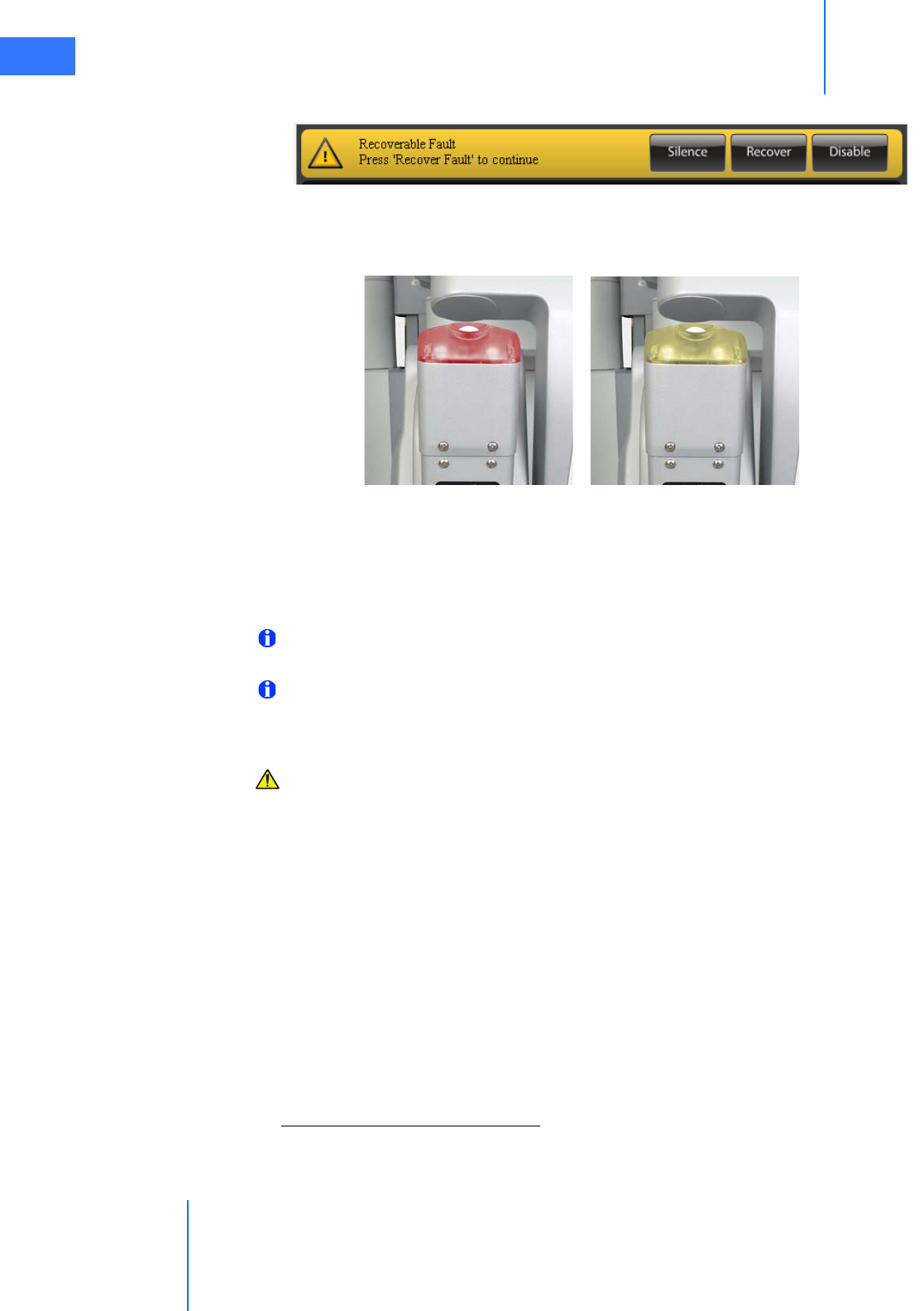
Appendix A: Error Handling
da Vinci® Si™
A-2
DRAFT/PRE-RELEASE/CONFIDENTIAL
10/9/14
• Displays a text message on the monitors to describe the error.
Figure A.1 Fault message on touchpad
• If the fault is arm-specific, the system displays an error icon and lights the arm LED yellow
or red. If the fault is not arm-specific, all arm LEDs light yellow or red.
Figure A.2 Arm LEDs in fault states
Recoverable Faults
If the fault is recoverable, you can override it by touching Recover on the touchpad or
touchscreen, which enables the system to continue. Touching Recover also silences the alarm
if no one has yet touched Silence.
Note: After a recoverable fault, the system does not recover until two seconds elapse
after you touch Recover.
Note: Using Recover does not diminish the system’s fault detection capability in any
way. Thus, if the fault condition remains, the system immediately faults again. If the
fault condition is removed, then the system is fully functional.
CAUTION: The Recover button should be used only with a thorough understanding of
the fault’s cause. Overriding a fault without understanding its cause may result in
uncontrolled movement of the Patient Cart arms up to 2 cm, or uncontrolled motion of
the master controllers up to 5 cm.
Disabling Instrument Arms and Master Controllers
The da Vinci Si System allows users to disable an instrument arm or master controller in the
event of arm-specific error. Intuitive Surgical designed this feature to allow a user to complete a
procedure with the remaining arms.
In the event of an arm-specific error, the system presents the option to disable the arm on the
touchscreen and touchpad. Once the arm has been disabled, it can not be re-enabled until the
next power cycle.
If you question whether or not you should disable an arm, please contact ISI Technical
Support.
After Disabling a Master Controller
You cannot control the camera arm from a Surgeon Console with a disabled master controller.